Hideo Ohashi
********October, 2025********
"From Daily Life" -88: Diagnosis of walking ability

The regular walking event in August was canceled to avoid scorching heat, and instead, a diagnosis of walking ability was held indoors in cooler conditions. For the diagnosis, an application named "Walking Analysis AI Torto" provided by Yamashita, a company that sells and rents nursing care products, is used. The diagnosis starts with test walking on 5 meters distance. The motion is recorded from behind by a smartphone and the video is analyzed by the application for evaluation.
I took the diagnosis together with about 10 walking-mates. Because the test distance was short, the video capture was quick. The next day, I received the analysis and evaluation printed on two A4 pages.
Evaluation is based on two indicators of walking motion: "Speed" and "Rhythm," and two indicators of balance: "Stagger" and "Left-right asymmetry". Each indicator is assigned five points, and the overall rating is reported as a total score out of a maximum of 20.
The picture above shows a snapshot of my walking (left) and the evaluation scores for each indicator (right).
"Speed" is evaluated based on the time taken to walk 5 meters. My time, 3.5 seconds (equivalent to 5.1 km/h), was quite fast, and I received a perfect score of 5. For "Rhythm," the fluctuation in the time it takes to step is evaluated as a percentage of the average. I received an average score of 3, at 10.26%. This may be because I started walking slowly and gradually hurried. "Stagger" is evaluated based on head shaking, and I received a score of 5 for no shaking. "Left-right asymmetry" is evaluated based on the time distribution between right-footed and left-footed steps, and I received a score of 5 by 51%/49%, a small difference between left and right.
My total score is 18, and I am pleased with the overall evaluation that my walking speed is excellent and that the basic muscles necessary for walking are strong. I am advised to increase my walking activity within a reasonable range, while being careful not to fall and keeping exercises to improve "Rhythm."
The evaluation was better than I expected. This diagnostic AI is often used on people who require assistance or care, so I imagine that healthy individuals would receive close to perfect scores. A fall can be serious in one go. I will never forget the advice I received from the diagnosis: "Be careful not to fall", and will make the most of the walking ability I have been given.
"From Daily Life" -87: 80 years after the ceasefire
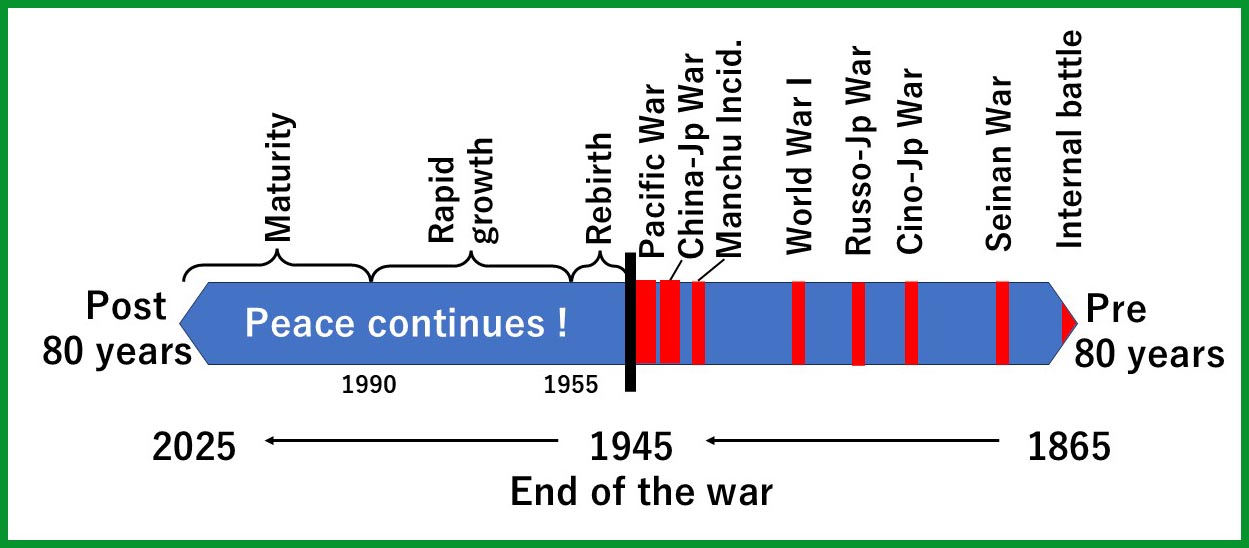
Eighty years have passed since 1945 when Japan defeated in the Pacific War. The decade leading up to 1955 was considered the period of rebirth as Japan emerged from turmoil and established the foundation of a peaceful nation under a constitution that renounced war. In the successive 35 years leading up to 1990, rapid economic growth continued, and Japan was once called "as Number One." However, the economy bubble eventually burst and Japan entered a long period of stagnation. Over the past 35 years, while growth as measured by GDP has been slow, Japan has worked hard to build a prosperous and attractive nation amid an aging population and declining birthrate. While some people refer to these stagnating years as the lost years, I would rather characterize them as the "maturity period."
If we consider that human memories begin to remain after the age of five, the generation with war memories is now 85 years or older. Those who were drafted into the military are now over 99 years old, making them a rare breed. Those enrolled in military training schools, such as the Army Cadet School, the Army Academy, and the Naval Academy, were destined to join the battle if once the allied forces invaded our mainland. Among these people, I was a first-year student at the Tokyo Army Cadet School when Japan accepted the defeat. I was 14 years old at the time and am now 94 years old. I am absolutely the youngest among those who once belonged to military organizations including schools. Wartime experiences, as well as memories, of people are rapidly fading.
The 80 years since the end of the war have been peaceful and free of war, but what about the 80 years before the end of the War? It dates back to 1865, the first year of the Keio era as shown the chart above. This was a time of internal battle leading up to the restoration of imperial rule. Three years later, the Meiji era began, and the great reforms of the Meiji Restoration began. The nation as a whole worked to enrich the country and strengthen its military in order to compete with the Western powers. After overcoming the internal Seinan War, Japan continued to win the Sino-Japanese War, the Russo-Japanese War, and World War I, before moving on to the Manchurian Incident, the Second Sino-Japanese War, and the Pacific War. The era of war came to an end in 1945, with over 3 million military and civilian casualties. Eighty years of fighting continued as our society was modernized from feudal to democratic.
Take a look at the chart above. The 80 years of peace since the ceasefire shine like a miracle in history.
We cannot maintain peace if we forget the preciousness of peace. Humanity cannot be said to have progressed unless we put aside wars that show no regard for the dignity of the individuals. I have witnessed many advances in human knowledge, from DNA and the Big Bang to AI, but we are still far from the wisdom to put an end to war. I long for the day when war is eradicated.
"From Daily Life" -86: Digital records of life

As we get older, the records of the past just keep piling up. I started using a Nolty Planner to write down my schedule and notes in 1960, and since then I have 65 of them lined up on my shelves. I also have a considerable amount of records of my life that I wrote myself, such as diaries and travelogues. I also have certificates from various occasions of my life, such as graduation certificates, degree diplomas, awards, and orders of appointment. In terms of volume, the largest amount of space is taken up by offprints of papers I have published in academic journals. All of these are physical, paper-based records. If they burn, nothing will remain.
In the 1980s, personal computer use began to grow rapidly. It was around that time that the habit of keeping records as digital files began. In the 1990s, software that is convenient for creating databases became rapidly popular, and the digitization of life records became firmly established. Below, I would like to introduce how I have made the best of digital records.
I use the database software Access for most of my digital records, but when I need to do a lot of calculations between items, such as financial records, I use the spreadsheet software Excel.
***
1. Personal data (Access): In addition to an address book to keep addresses and phone numbers, I record the following items for each person with whom I have had contact or corresponded; classification code, birthday, family composition, education/work background, New Year's card exchange history, special notes (memos, etc.). Classification codes are related to the sending of New Year's cards, such as 0 for deceased, 1 for sending before year-end, 2 for receiving and replying, 3 for no exchange, and f for sending jointly to the recipient's spouse. The New Year's card exchange history records all sending and receiving since 1974. Currently, there are about 1,300 Japanese and 110 foreigners registered. This is the data base I use most frequently.
2. Papers and career data (Access): This is my professional activity history, and includes the following
data.
・Publications (list of titles and journal names of over 800 published papers, editorials,
commentaries, essays, etc.)
・Lectures (list of titles, dates, and locations of approximately 200 lectures)
・Appointments (list of approximately 400 appointments issued by government agencies,
universities, public corporations, academic societies, etc.)
・Academic society activities (list of assignment and award records of 20 academic societies (14 domestic,
6 foreign))
3. Student guidance data (Access): A list of the names, years, and thesis titles of students who completed their bachelor's, master's, or doctoral theses in my laboratory. 280 students from the University of Tokyo and 180 from Kogakuin University are recorded. Doctoral theses include those that were written without completing a graduate school course.
4. Business card data (Access): A list of the names, affiliations, and positions of business
cards received since 1970. 5,300 Japanese and 550 foreigners are recorded.
This is extremely useful when searching for old business cards.
5. Financial Data (Excel): Bank deposits, the assessed value of investment trusts, etc.,
and total financial assets are listed at the end of each month. In addition,
income such as salary, miscellaneous income, and pension, as well as income
tax and resident tax, are listed at the end of each year to overview the
annual trends.
6. Medical Examination Data (Excel): Health examination results, mainly blood test results, are listed by items. Fluctuations in test values from 140 examinations from 1994 to the present can be seen. Test items include standard ones such as blood cell count, cholesterol, triglyceride, protein, and blood sugar, as well as test values under observation such as PSA (prostate-specific antigen) and NT-pro BNP (heart failure assessment).
***
These digital records have been accumulated over nearly 50 years, so I don't feel like I have spent much time on them. But looking back, I am impressed by the perseverance I have shown in updating my records. If we upload files to the cloud, we can check our past anytime, anywhere on the smartphone. We live now in an age where such a miracle is the real. What I introduced here is just an example in the digital age.
The total recording capacity of these text-based data is less than 40 MB (megabytes). It easily fits on one USB memory. The USB memory shown in the photo above, a small lump of plastic weighing 7 grams, is a can of life records.
The digital records introduced this time do not contain a huge amount of image data. The total storage capacity of image data reaches TB (terabytes), which is incomparable to text-based records.
When humans die, they leave behind personal belongings. The left family members have done their best to decide the fate, memento or discard. From now on, in addition to physical visible belongings, there will also be invisible belongings stored in storage media. How should we deal with the latter? This is a problem that humanity has never faced before. The left family members will surely be bewildered.
"From Daily Life" -85: Photo-Haiku 4
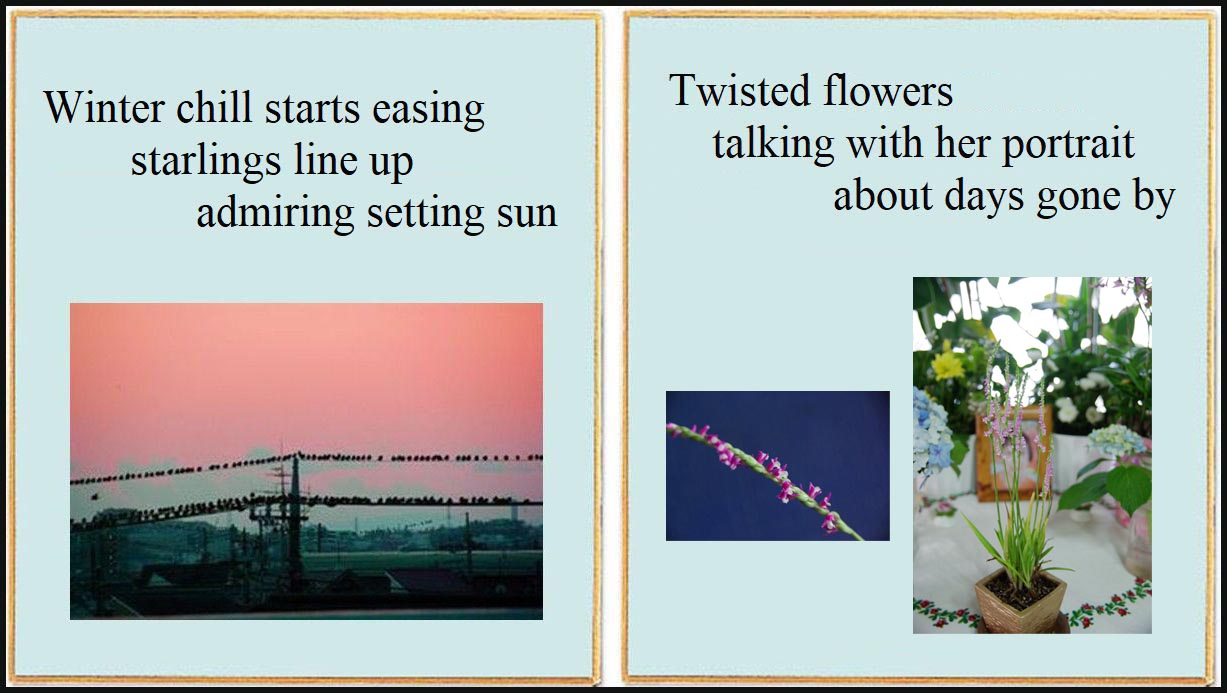
It has been almost three years since I started writing Haiku, inspired by watching a TV program called Play-Buttle. Though my progress seems slow and stagnant, I still continue because Haiku gives me great fun. The habit of carefully selecting words for composing Haiku has a positive effect on writing in general. I have chosen two scenes from my daily life that I would like to share with you as Photo-Haiku.
***
The Haiku on the left above: Diamond Fuji can be seen from my house on the evening of the third of February. Around that day, the crimson sky spreads behind Mount Fuji at the center, and it is the most beautiful time of year for sunsets. As the day approaches, a strange phenomenon occurs. As the sun sets, a large flock of starlings appears, lined up shoulder to shoulder on the electric wires, as shown in the photo. They seem to be watching the silhouette of Mount Fuji under the crimson sky. As dusk approaches, the birds fly off en masse to their roosts. It is a scene that makes us believe that starlings also have an instinct to love beauty. Then the following Hauku came to mind: <Winter chill starts easing, starlings line up, admiring setting sun>.
This phenomenon disappears after the vernal equinox, when the chill leaves. Observing closely up, we find that not all the starlings face the sunset, making it difficult to believe that they all are admiring the beautiful scene. Though I know the explanation that the birds have a habit to warm themselves up before heading to roost, I rather believe that starlings love beauty.
***
The Kaiku on the right above: There is a large planter on the balcony of my house, and I allow weeds to grow in it. Most of them are unknown plants that fly in, but sometimes, plants such as muscari, daffodils, and twisted grass, which I transplanted by myself, bloom in each season. The twisted grass produces flowers that are too pretty and delicate to be called a weed. It gets its name from the small pink flowers that bloom in a spiral line. There are only a limited number of places where twisted grass can be found. I have found several densely populated areas on the banks of the Tama River, in Nogawa Park, and in a corner of a nearby housing complex.
When June arrived, I thought it was about time to check the planter on the balcony, and there it was. Pink twisted flowers were blooming at the ends of several tall stems. I was so fond of the obedient flowers blooming without forgetting, and immediately began humming next Haiku. <Twisted flowers bloom, without forgetting, how dear they are>
My late wife loved these delicate flowers so much. This year again, I collected several twisted flowers from the field and placed them in front of her portrait to let her know the season had arrived. I have endless memories of the days we spent together, going out in search of twisted flowers and finding lovely ones among the weeds. <Twisted flowers, talking with her portrait, about days gone by>.
"From Daily Life" -84: Hearing aid renewal
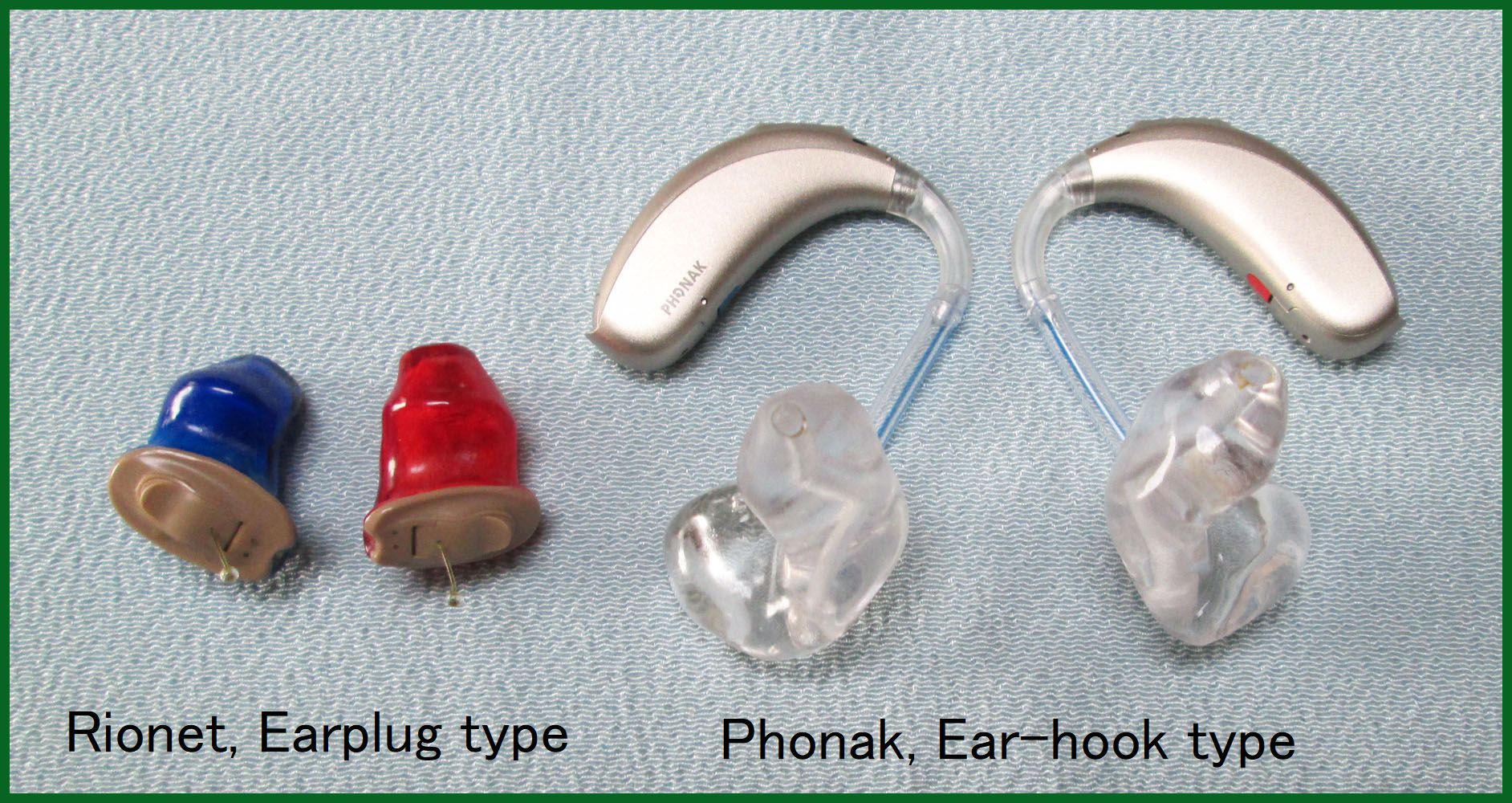
I bought my first hearing aid 8 years ago when I was 86 years old. I have already introduced in this column the story leading up to the purchase. When I wore the hearing aid, I could hear well, but the background noise was often too loud and unbearable. So, I decided to wear the aid only when I needed help.
When I became 90 years old, I started to suffer from serious listening
difficulty in recognizing spoken words. I reported in this column the diagnosis on my hearing impairment given by a nearby university-attached hospital. The doctor's advice was
that the only way to prevent further deterioration was to wear the hearing
aid at all times and continue to make effort to listen. Since then, I have
always worn the hearing aid except during sleeping in bed, and have been
struggling to listen words.
The lifespan of hearing aid seems to be 4 to 5 years. My regular hearing aid shop told me that it is a luck to have an aid working for 8 years without any problems. I felt that it was a proper time to replace. I was recommended to try out the latest model, so I used it for about two weeks. I had been using a domestic Rionet hearing aid of earplug type (upper left), but the trial model was a Swiss-brand Phonak of ear-hook type (upper right). Before trying it out, I compared the results of my hearing test with those of new and old hearing aids. As far as the ability to distinguish single syllables, I found no tangible difference, so I had little expectation at the time. However, when I actually used it for trial, I could realize that my ability to recognize words had improved to some extent. This may be mainly due to the enhanced function for background noise suppression.
In the earplug type, a microphone, speaker, electronic circuitry, and battery are packed into a small earplug. In the ear-hook type, all components are installed in the external ear-hook, and the earplug only transmits sound. The ear-hook type, which has no size restrictions, also has a high degree of freedom in adding functions. One of these is the incorporation of Bluetooth, which connects wirelessly to external devices. If we connect aid to a smartphone, we can adjust the volume of the aid and make hands-free calls. If we connect aid to a TV, we can hear the sound directly. The battery is also larger, and its lifespan has increased to more than a week. The custom-made plugs of both ears are made by taking a mold, and are connected to the ear hooks by thin vinyl tubes.
After trying the new model, I decided to buy it. The price is 660 k\, a significant increase from 350 k\ I paid for the old one, but I decided to accept it as a necessary expenditure to maintain my quality of life for the years to come. The dream hearing aid that significantly improves word recognition does not yet seem to exist in the world. The only way to slow the further deterioration of listening ability is to continue listening. I will continue to struggle with this new hearing aid.
"From Daily Life" -83: Tunnel ventilation
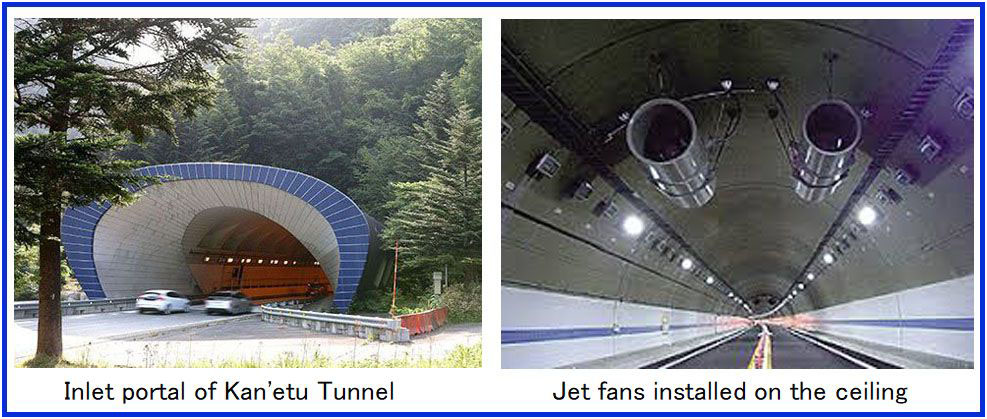
During traveling by train or car, we often pass through tunnels. Unless
the tunnel is very long, we pass through it almost unconsciously. My longtime
friend, Mr. N, founded a company specialized in ventilation and safety equipment for automobile
tunnels and celebrated its 25th anniversary this year. I was invited to the anniversary
event to give a congratulatory speech, and it reminded me of my 40 years
of commitment to the planning of major automobile tunnels in Japan. On
this occasion, I introduce herewith briefly what tunnel ventilation is.
With the advancement of railway electrification, railway tunnels with ventilation equipment are rare, except for subways. In the case of the longest railway tunnel in Japan, Seikan Tunnel (54 km), fresh air is supplied from two inclined shafts to its center to regulate the internal temperature and allow safe evacuation in the event of a fire. This is a special case because of its length and undersea condition.
In automobile tunnels, ventilation must always be considered because it is necessary to dilute the pollutants emitted by engines (harmful gases such as carbon monoxide and nitrogen oxides and diesel soot) under the permissible limit. Harmful gases are toxic to the health of pedestrians through breathing, and diesel soot poses a risk to drivers by reducing visibility.
Pollutants emitted inside a tunnel are carried to the outside by natural wind due to the difference in atmospheric pressure between the portals, traffic wind pushed by running automobiles, and diffusion caused by strong air turbulence generated by cars passing by. If these effects are strong enough, mechanical ventilation is not necessary. Most of short tunnels under 500 meters fall into this category.
When a construction plan for an automobile tunnel over 500 meters is decided, the need for ventilation and safety equipment is determined, taking into account the traffic volume, one- or two-way, terrain conditions, and environmental regulations near the portals.
In the past, automobiles were a major source of public nuisance. However, due to successive tightening of exhaust gas regulations, the emission of pollutants from both gasoline and diesel vehicles has decreased dramatically in recent years. As electric vehicles become more widespread, the emission of pollutants will decrease even further. For this reason, tunnel ventilation facilities are often installed not for diluting pollutants but to ensure the airflow necessary for safe evacuation in the event of a fire. Recently, we see many tunnels with jet fans installed on the ceiling (photo upper right), but it is rare to see fans that are in operation.
Ventilation fans are regularly in operation in long tunnels such as Kan'etsu Tunnel (11 km, photo upper left), Enasan Tunnel (7 km), and Tokyo Bay Aqua Tunnel (10 km). In the past, long tunnels were mostly mountain tunnels. However, as construction of underground expressways in urban areas progresses, they become the record holder of the longest automobile tunnel. Currently, Yamate Tunnel (19 km) on the Metropolitan Expressway holds the record. Automobile tunnels have become more familiar as they feel like subways.
Automobile tunnels have a history of serious accidents that have cost lives, such as the fire at Nihonzaka Tunnel and the ceiling panel collapse at Sasago Tunnel. I hope that the ventilation and safety equipment of automobile tunnels will keep assuring the safety of passersby for years to come.
"From Daily Life" -82: Directories disappear!
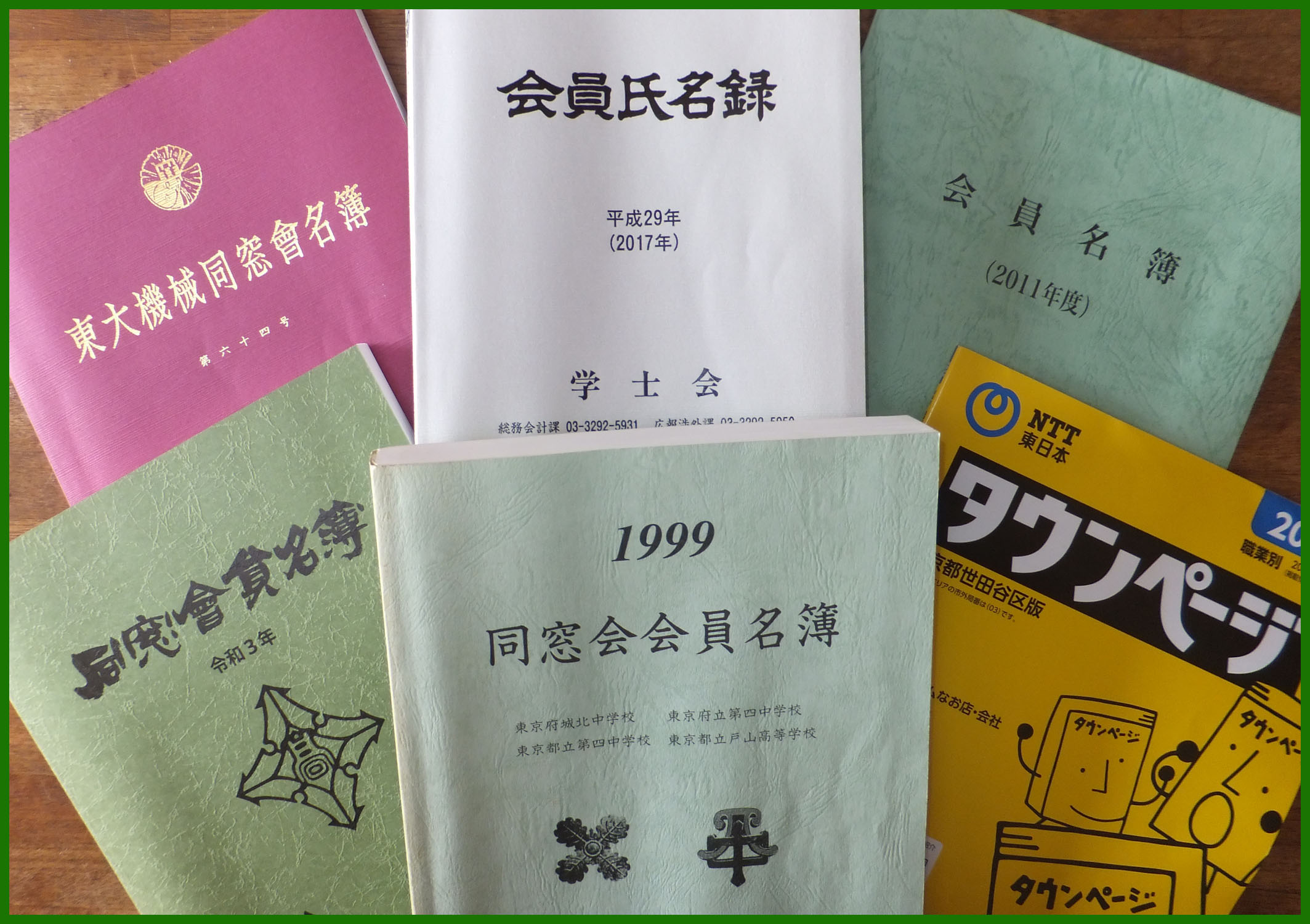
In the past, red telephone directories were kept in homes with telephones. In the case of Tokyo's 23 wards, there was one book for companies and three for individuals, each with several centimeters thickness. We could search for phone numbers and addresses by name, and revised versions were distributed regularly. 40 years go, these directories were replaced by the condensed versions named Town Pages (yellow, companies) and Hello Pages (blue, individuals), but the last remaining Town Pages will be discontinued this year.
There were many other directories at home. The alumni directories of the schools I graduated from, the membership directories of academic societies and organizations I belong to, and even small name lists of class meetings and hobby clubs; the number of directories is enormous.
There are many directories lined up on my bookshelves. However, the replacement of directories with revised versions and the addition of new directories have never happened in the last three years. From now on, it will be impossible to see a new paper-based directory again.
The reason why new directories have disappeared is clear. The decisive factor was the penetration of the law for personal information protection. These directories were treasure troves of personal information, including addresses, names, and phone numbers. Even now, telephone calls from unknown salesmen are common due to the misuse of old directories.
In the case of telephone directories, there is another reason. The spread of telephones has reached its limit, and the number of landline and mobile phone contracts has reached a total of 270 million, more than twice the population. Paper-based searches cannot keep up. It was inevitable that searches would move to the Internet.
Many alumni associations and academic societies now provide member search services online instead of issuing directories. When members log in with their respective passwords and search by name, data that has been approved for disclosure appears. It certainly replaces a part of functions of the directory.
However, it cannot compare to the appeal of a paper-based directory. When we flip through the pages of the directory, nostalgic names pop up, and we recall the persons. It is a memory refresh that goes beyond searching. I expect such a future that an online directory service helps activate the communication and intimacy among members.
"From Daily Life" -81: Motor fan group of local community
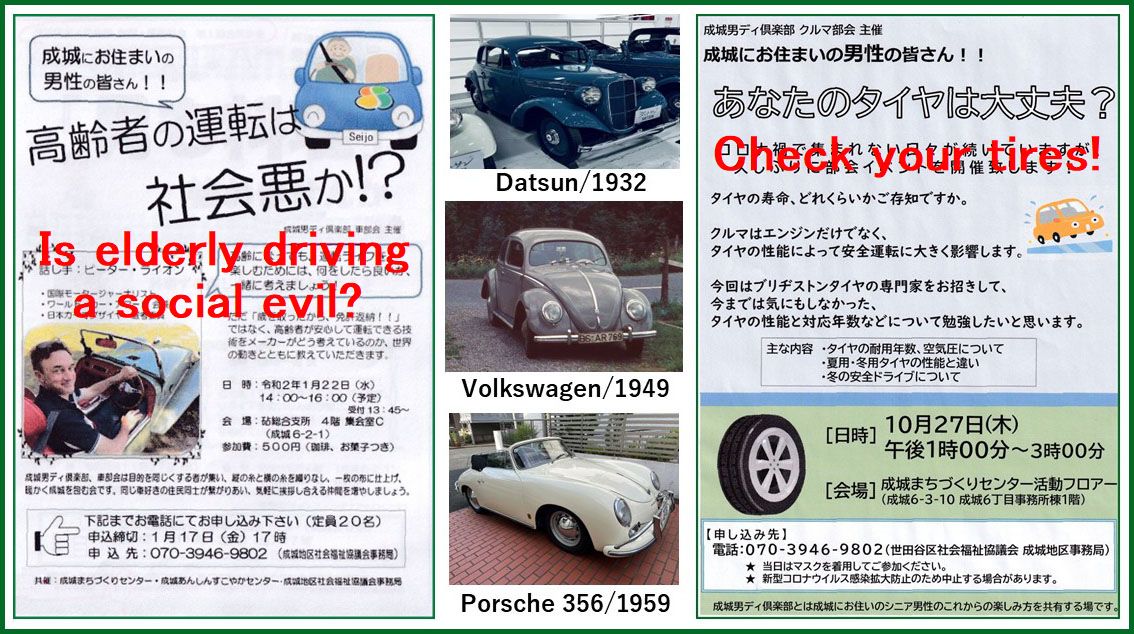
Motor fan group of Seijo Silver Gents Club, a local community of senior
men, has been active since 2019, when motor fans gathered under the leadership
of former F1 driver Mr. H. They have been not driving partners who go on
long trips in a line of cars, but rather study comrades who share their
experiences and absorb knowledge.
I was given the opportunity to talk my experiences and thoughts on two
occasions, under the titles "Stories about old cars" and "Desire
to enjoy driving as long as possible". Mr. U, who has been driving
a Porsche for many years, exhibited his beloved car and spoke passionately
about "the history and characteristics of the Porsche 356". We
exchanged from time to time the information and experience of own cars.
There have been many opportunities to listen to the invited lecturers from outside. International motor journalist Peter Lyon presented the driving environment of the elderly in various countries and imparted suggestions about driving of seniors. Experts invited from Bridgestone Co. introduced new knowledge, mainly about tire life and winter tires. Experts from the JAF and Seijo Fire Department talked about points to keep in mind when driving in abnormal weather and heavy rain. How can we continue to drive safely while aging proceeds? This is a major concern for seniors.
There were also events with excursion. Through Mr. H's introduction, we watched the Media Roadster 4-Hour Endurance Race held at Tsukuba Circuit and observed the race support from the cockpit. We visited the Nissan Heritage Collection in Zama and were deeply moved by the magnificent history that began with the first Datsun. Recently, the leader of our group was handed over from Mr. H to Mr. U.
No one can fight back against aging. But we all want to continue enjoying cars. This conflict is common to all car enthusiasts. One day we will have to put our cars away. I hope that the activity of this group will help everyone end each car journey with a happy ending.
"From Daily Life" -80: Cooking group of local community
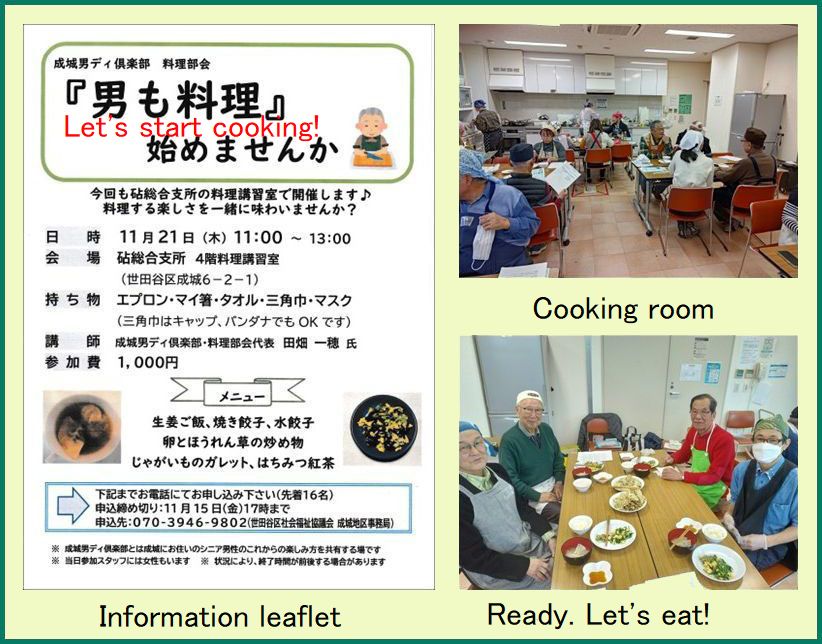
Seijō Silver Gents Club, a local community of senior men in the Seijō area, has four groups: walking, driving, cooking, gardening, and motor fan. Events are planned from time to time under the leadership of each group leader. The walking group, which I already introduced, gathers regularly on the third Wednesday of every month. The cooking group, which I introduce here, holds its gathering twice a year. About 20 seniors share the work of making lunch according to the recipes of the leader, Mr. T, and then eat together. It is a harmonious gathering that lasts about two hours, and is fun to both cook and eat.
Once the recipe and date are decided, an information leaflet like the one shown on the left above is distributed. The venue is a fully equipped cooking class room on the fourth floor of the Kinuta General Branch Office of Setagaya Ward. The participation fee is 1,000 yen, and the cooking ingredients are prepared in advance by Mr. T and the support staff. Participants may join empty-handed, just bringing an apron, a bandana, and a mask. The four of participants make a team and work together surrounding one big table.
The menu of the above leaflet was three dishes: gyoza(dumpling), stir-fried egg and spinach, and ginger rice. The support staff cooked the rice collectively, so each team started making the first two. The main dish, gyoza, was easy to eat but time-consuming to prepare. To make filling, Chinese cabbage, chives, ginger, and mushrooms were chopped finely, and mixed with ground meat. Then, a handful filling was wrapped by a gyoza skin. Chopping and wrapping required skill and we struggled harder than expected. We had even to accept awkward-looking gyoza pieces. Finally, all pieces were fried in a frying pan on the tabletop stove. Dividing up all works among the team, everything was ready in about an hour.
After setting the food, the members said "Itadakimasu" (let's eat) and started eating. The gyoza on the table might be rejected if they sold on the market, but we enjoyed eating them while remembering the laborious cooking process. Everyone finished all the meal while chatting.
I usually cook for myself, so cooking is nothing new to me. However, I had a precious experience to make gyoza by myself. For some participants, they experienced first time to do kitchen work. Events like this, which give senior men an opportunity to pick up a cooking knife, may actually be indispensable.
After the meal, we cleaned up the kitchen together. With full stomach as souvenir, we left the venue in high spirits and dispersed into the afternoon town.
"From Daily Life" -79: The old school system is far away
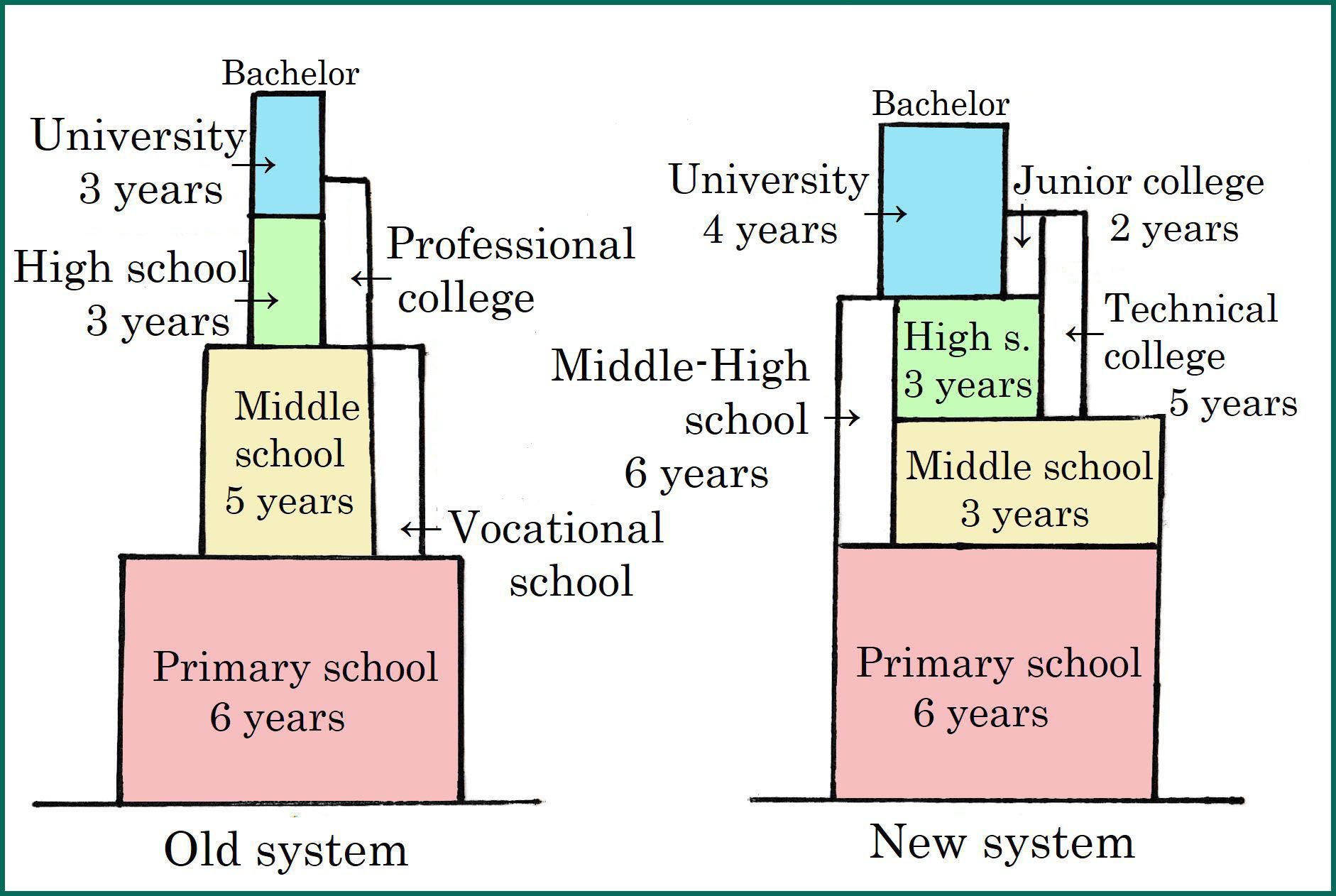
In 1947, shortly after the end of the war, reforms were made to Japanese school system under American occupation. This was made as a part of democratization. The dual-track system of continental Europe was replaced by the American single-track system, with middle school, high school, and university in order. In 1949, universities started the first admission under the new system, and the old school system that had continued since the Meiji era was quickly replaced by the new system. I went from the fourth year of old middle school to the second year of new high school, with the school building and students remaining the same, and two years later I became the second freshman of a new university. I am a member of the generation that experienced the transitional period of the educational reform.
When I graduated from university, the new system was a new face. When I said I graduated from a university, people would ask me if I went to the old system or the new. When I answered that I went to the new system, I was told, "Oh, right," and somehow felt that I was estimated under the old system. The standard number of school years was indeed one year less. That sense of discrimination also disappeared over the years.
Nowadays, those who completed their education under the old system are over 95 years old. It is rare to meet such people. I feel that the old system is a distant memory, so I will summarize the comparison between the old and the new. Hereafter, universities mean undergrduate schools (bachelor programs) unless otherwise noted.
The characteristic of the new system is that it is a single-track system, called the 6334 system, which accumulates six years of primary school, three years of middle school, three years of high school, and four years of university (six years for medicine, dentistry, and pharmacy). Two-year junior colleges and five-year technical colleges that combine high school and junior college have expanded the options as branches of the single track.
Under the old system, the number of years required to graduate from university is 6533. Six years of primary school is the same, and the standard is five years of middle school, three years of high school, and three years of university (four years for medicine), totaling 17 years, one year longer than the new system. However, since one was eligible to take the high school entrance exam after completing four years of middle school, gifted students became bachelors at a younger age.
A characteristic of the old system was that it provided a variety of higher professional education routes. After finishing middle school, those who wished higher education in a specific field could choose one of colleges for teachers, maritime, commerce, industry, agriculture, etc. The graduates were respected by society as those who had completed higher education in that field. In an era when bachelor's degrees were rare, making up only several percentage of the generation, many people, even from economically well-off families, chose this path and entered society.
The late teens are the most important time for personality formation. Under the old system, the quotas for high schools and universities were almost equal, and the barrier to university entrance was much lower. For this reason, the three years of high school were a valuable time to awaken to one's ego and enjoy one's youth without the pressure of entrance exams.
Under the new system, duty education was expanded from six years of primary school to nine years of primary and middle school. This is truly the result of democratization. The disadvantage of the single-track system is that the competition to proceed the upper school continues until university entrance. It has become common for people to go to cram schools from primary school to high school. The reason why people want to study at a combined middle and high school is likely because of the appeal of a calm six-year period without entrance exams. There is an increasing trend of pupils not attending primary and middle schools, which are duty education. There is an increasing demand for education that meets a variety of needs.
Universities have also changed dramatically. The rate of students entering undergraduate programs has exceeded 50%, and bachelor's degrees are no longer a rarity. The number of students entering graduate schools continues to increase. Graduate schools, which were merely a formality under the old system, have now become the core of universities.
Fewer people know about the old system. I would like to take this opportunity to compare the old and new systems.
"From Daily Life" -78: Kunisaki Peninsula tour
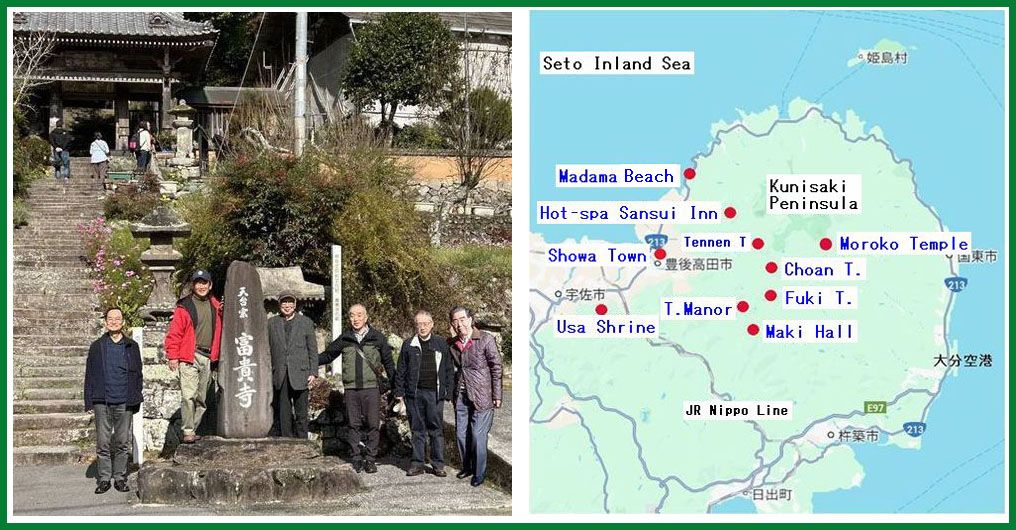
Last year, I enjoyed a three-day, two-night tour to Amakusa Island with five former students who live in Kyushu. Because the tour was so
memorable, we decided to do it again. I left the destination up to them,
and we came up with a plan to visit the temples and shrines of Kunisaki
Peninsula. It was a packed schedule, leaving home at 7 am on November 24th,
staying for two nights, and returning home at 9 pm, but like a senior pilgrimage,
we were able to finish the tour at a leisurely pace, savoring the ancient
cultural artifacts.
The six of us gathered at Fukuoka Airport at 1 pm, and just like last year, we got into a Nissan Serena and set off for Kunisaki Peninsula. It was a cloudy, sunny day. The autumn coloring in Kyushu was late, with no sign of winter in the forests passing by the car window.
The first place we stopped was Usa Shrine (see the map above). As we got closer, we noticed signs that read USA, and I was a bit taken aback, wondering where we were. There were many shrines lined up within the vast grounds. This is the head shrine of the nearly 40,000 Hachiman shrines across the country, and was founded in 712 as a hall to worship Hachiman, who protects the creation of the country in this area. Incarnations of Hachiman also built many temples on the Kunisaki Peninsula. The fusion of Shintoism and Buddhism has been deeply rooted in this area.
After worshiping, we headed straight to Madama Beach, a famous sunset spot. Last year, we watched the sun sink into the Amakusa Sea, but this time we continued to gaze the sun sinking into North-kyushu across the calm Seto Inland Sea. We stayed at a hot spa inn called Sansuiso, and immediately took a bath to relieve our fatigue, then enjoyed dinner. We had a great time talking about old times.
The Kunisaki Peninsula is a volcanic lava plateau, but the bedrock is soft, so it is subject to severe erosion by rain. The highest mountain is just over 700m high, and the hilly area is lined with strangely shaped rocks that have been left after erosion. There, many temples stand quietly, as if clinging to the mountains.
On the second day, starting in the morning, we visited Tennen Temple, Maki Hall, Fuki Temple, Moroko Temple, and Choan Temple (shown on the map above) in the orde. All of these temples were built in the early 8th century. The Main Hall of Fuki Temple is designated as a National Treasure, and each temple has Buddha statues designated as a National Important Cultural Property. I felt keenly the long cultural history and advanced nature of this region. It was truly a compressed pilgrimage.
Around noon, we stopped off at Tashibu Manor, the site of an ancient manor, designated as a Globally Important Agricultural Heritage site. The neatly lined terraced rice fields between the mountains, framed by autumn leaves, looked like utopia. Before returning to the inn, we stopped off at Showa Town in Bungo-takada City. There was a row of shopping streets that still retained a strong Showa-era atmosphere. We strolled around here, took a break at a sweets shop, and then returned to the inn. The night passed taking hot spa, enjoying dinner, and talking old stories.
On our final day, it had been raining since the morning, and on the way back to Fukuoka Airport we visited Ao Cave and Deep-Yabakei. I got to see with my own eyes the places I had often heard about. Yabakei was in the height of autumn foliage, but the towering, oddly shaped rocks were hazy in the rain, giving it the elegance of a Nanga-style ink painting.
We arrived at Fukuoka Airport before 3 pm, had a farewell party at Tully's coffee shop before disbanding. I returned home safely just before 9 pm. For those living alone with no one to talk to like me, the past three days were so dense, that I felt I had exchanged a year's worth of conversation.
"From Daily Life" -77: Ohyama Afri Shrine
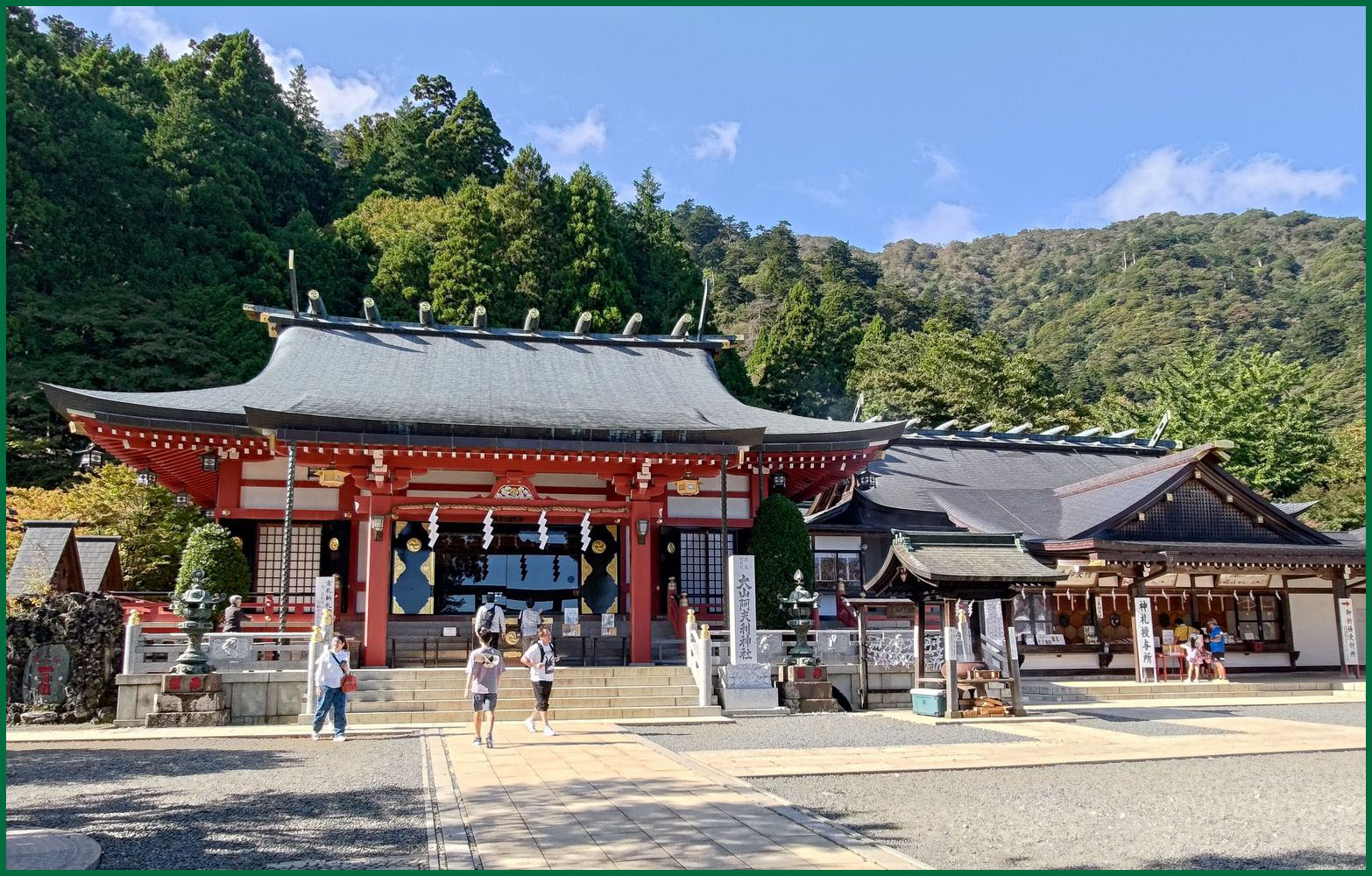
The Tanzawa mountain range, with Mt. Fuji in the background and blocking the west of the capital,
is a familiar sight for Tokyo residents. Ohyama Afuri Shrine is located
on the middle slope of Ohyama (1,252 m above sea level), which is the southernmost
tip of the range. Afuri originates from "amefuri" (rain fall)
and has been rooted in this area since ancient times as a shrine for praying
for rain and bountiful harvests. Its origins are said to date back 2,200
years, an age of mythology. As the social system was established, the shrine's
status increased, and it eventually became the center of faith as the general
guardian deity of the Kanto region. It seems that visiting Ohyama was one
of the pleasures for the common people during Edo period.
I first visited the shrine for the New Year’s prayer five years ago. As the autumn winds began to blow, I suddenly wanted to visit again. I decided to act quickly, so I immediately got on the Odakyu Line. I got off at Isehara Station and took the bus to Ohyama. I arrived at the terminal in less than 30 minutes. The sign said it would take 20 minutes on foot from the bus stop to the cable car station, but it was a tricky climb with continuous staircase. On both sides of the slope, there were souvenir shops, inns serving popular tofu dishes, and rest areas. I had a pretty hard time climbing the 90 m difference in altitude. As I climbed, I realized that my physical strength had considerably deteriorated over the past five years. I got on the cable car, which took me all the way up to the base of the shrine at an altitude of 700 m.
The shrine stood quietly with the green mountains behind it. There were few worshipers there on a weekday. Here too, I prayed for world peace. War blows away all the modest wishes of individuals. Then, I enjoyed the view from the bottom of my heart. To be precise, this is the lower shrine. I saw some worshipers hiking to the main shrine at the top of the mountain, but most of the visitors select here as the final destination of their pilgrimage to Mt. Ohyama.
The view from here was spectacular. Villages and towns shone in the autumn light on the Shonan Plain below. Beyond that, the Pacific Ocean spreads out with white clouds rolling in the sky. Enoshima Island stands alone in the sea, looking adorable. Visitors have surely cheered with joy at the same view for over thousands of years. I took a break and ate some soba noodles at a tea shop below the shrine before heading home.
When I got home, I suddenly felt deep fatigue. People in the past walked that entire path on foot. They must have felt a great sense of accomplishment. A new day has been added to my list of memorable days.
"From Daily Life" -76: Photo-Haiku 3
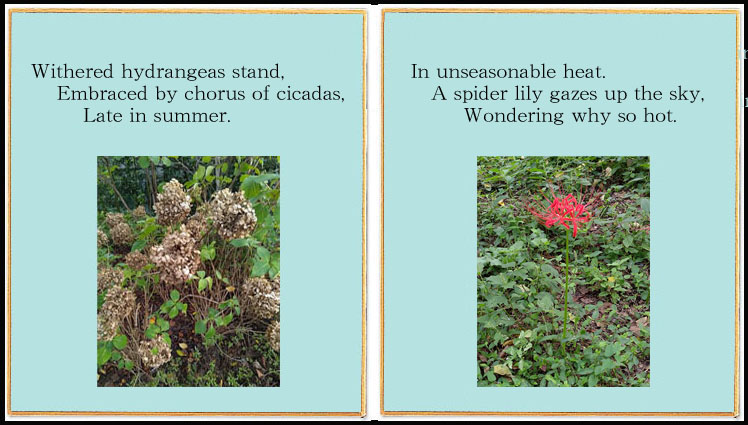
This summer was a record heat. In Tokyo, the last day of extreme heat over 35° C was September 20, just before the autumn equinox. My Haiku has been stagnating due to the heat, but I would like to introduce two Photo-Haiku related to summer to remind me of the heat.
The Haiku on the left above was composed in a park during the intense heat of late summer. <Withered hydrangeas stand, Embraced by chorus of cicadas, Late in summer.>
The hydrangea, which decorated the early summer with its fresh and vivid colors, gradually faded and eventually withered. In well-maintained gardens, the withered hydrangeas are pruned and disappear, but in a small park nearby, they remain withered for a long time. As late summer twilight approached, the hydrangea, which had finished its work, was embraced by the chorus of cicadas, as if to praise it.
The Haiku on the right above was composed as the autumn equinox approached. <In unseasonable heat, A spider lily gazes up the sky, Wondering why so hot.>
Speaking of the autumn equinox, one is reminded of the red spider lilies, which are in full bloom around this time. At the top of a long slender stem, a large flower with thin crimson petals blooms. There are many famous spots for red spider lilies all over the country, where they cover the entire area to create a red carpet, or grow densely along the edges of rice paddies to create red belts.
Due to the heavy summer heat of this year, the peak season is about 10 days later than normal. But still, lively early-blooming flowers began to bloom here and there before the equinox. Three days before the equinox, it was also a day of extreme heat. I found a single red spider lily that had begun to bloom before the others. It looked as if it was gazing up the sky, wondering at the unseasonable heat. The blazing sun was looking down on it.
I am a self-taught Haiku lover and am still at beginner level. My Haiku often includes too mulch explanation, and the choice of seasonal words is too ordinary. I keep composing, probably only because it's fun.
"From Daily Life" -75: Sudoku (Number Place)
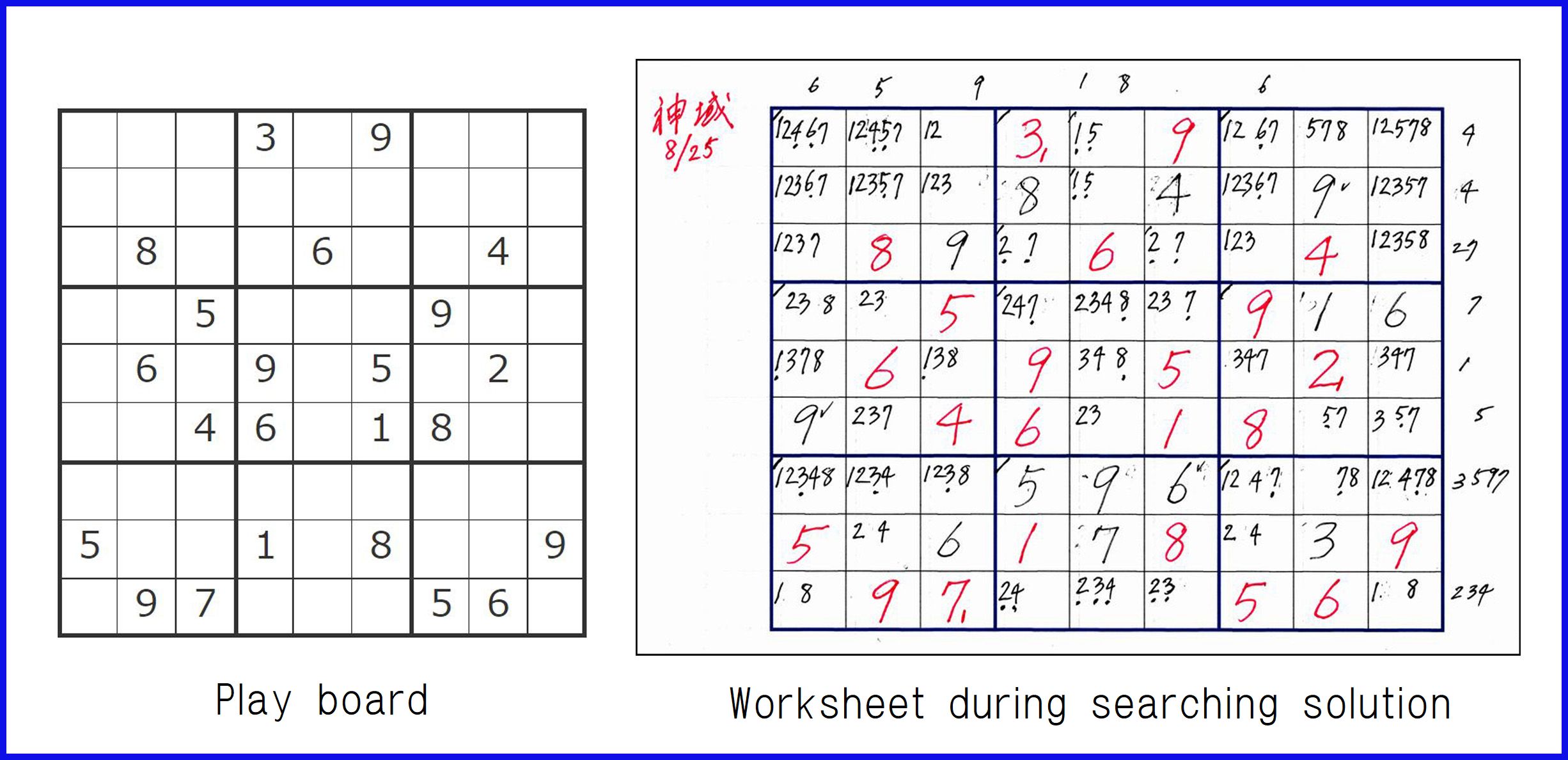
This summer was a succession of extremely hot days, no less than last year. To prevent heatstroke, warnings were issued every day for the elderly to refrain from going outside. In addition to spending long hours at home keeping daily household, watching TV, reading newspaper and books, it is essential to have time to do something engrossing and forget about the heat. I have been playing Sudoku puzzles for a long time. This year, I found a website on the Internet that introduced highly difficult Sudoku questioning that is named as divine realm. Since then, Sudoku's presence as a way to kill time has increased dramatically. It has become a must-have item in the height of summer. I would like to introduce it while the heat is still on.
Sudoku was born in the United States in 1979 as Number Place. Its play rules were later improved in Japan, and the puzzle became quite popular as Sudoku since 1984. After the UK's Times introduced it as "Sudoku" in 2004, it has spread rapidly around the world.
As shown in the left picture above, the play board has 9x9 squares, which are subdivided into nine 3x3 blocks. The units used to search for matching numerals are the horizontal rows of 9 squares, the vertical columns of 9 squares, and the 3x3 blocks.
The game begins when a limited number of squares are assigned by given numerals, as shown in the picture. The task is to fill numerals in the blank squares so that the numerals 1 to 9 are included without any duplication in any row, column, or block. The game ends when all the blanks are filled with numerals without any contradictions.
The initially given numerals are designed such that there is always a
correct answer. The difficulty of the game varies greatly depending on
the number of given numerals at the beginning. The website "Sudoku 7", which I visit frequently, classifies the games into seven levels: newcomer,
beginner, intermediate, advanced, difficult, extremely difficult, and divine
realm.
There are standard tactics for finding the correct numerals matching to the given numerals, and there are many articles explaining these tactics. In the challenge to the highest level, divine realm, we must apply several kinds of tactics to arrive at the correct answer. It takes me at least 30 minutes to find the right answer, and sometimes I spend an hour searching for a clue leading to applicable tactics. It's a great way to kill time. If I can't find any clue after thinking for an hour, I shout "surrender" and bow my head.
The aforementioned website offers a service called "Let AI solve it." If I bow to the AI, it will instantly show me the path to the right answer. In most cases, it makes me realize that I have overlooked applicable tactics. Very occasionally, the answer cannot be reached using the tactics alone, and we must assume a numeral at a blank square and try to see if that leads to the final answer. As a person who has struggled long time with logic alone, this can only be considered a poor problem setting.
The right picture above shows the worksheet I specially made. On a pre-printed A4 sheet of paper, I write the given numerals in red. Then, in the blank squares, I write candidate numerals in black. The picture shows how the worksheet looks like halfway through. The numerals are written with an erasable ballpoint pen, so I can erase the candidate numerals one by one. The finished worksheets can be used several times again, since the written numerals disappear instantly when they are heated by holding over a gas stove.
As I introduced on this homepage, I have been playing “FreeCell” on PC as a part of my wake-up exercise. In addition to this, the brain exercise "Sudoku" to kill time
has now become a part of my life. I am not sure how much such a brain exercise
helps maintain my cognitive function. However, having a few means to be
deeply involved is an essential lubricant for living alone in old age.
"From Daily Life" -74: Family funeral

Before the Bon (Ancestor festival of Buddhism in mid-August), let's take on a subject of funerals. I often find myself wondering how my old friends, my seniors who helped me, and my coworkers who shared good and bad times, are doing. Suddenly one day, I find that one of them has passed away. After a family funeral with only close relatives has been conducted, I receive a shocking sad notice from the bereaved family or from the office of my former workplaces. I can no longer attend the funeral, pray for the repose of the soul, or say my last farewell. Writing a letter of condolence to the bereaved family and sending flowers is the only way left to express gratitude and condolence. In the case of celebrities, a farewell party may be held after the family funeral, but this is rather rare.
It used to be very different. When I worked at a university, I often had the opportunity to attend funerals and say goodbye to the deceased, such as senior professors, colleagues, and friends. When I lost a particularly close friend, I attended the cremation, collect the bones, and say my final farewell. Gradually, such opportunities became rarer.
The trend of having a family funeral appears to be particularly prevalent in large cities where local ties are weak. I think the biggest reason for this change is aging. If a 100-year-old man dies, his friends have already passed away, and because he has been out of active duty for so long, most of the people who worked together with him have also passed away. The only people who know the deceased well are their family members. Family funerals are considered the norm. For the chief host of a funeral, there is no need to deal with unknown mourners, and his psychological burden is much less. This is why funerals with only family members are preferred.
How would I like to be done? My sons may wish to know. In a file I gave to my eldest son labeled "Emergency", there is the following sentence: "I would like the funeral to be religion-free, just like the case of my late wife. Since I have been out of active duty for a long time, a peaceful family funeral is appropriate." I have attached a list of individuals and organizations who should be notified of my death. I cannot attend my funeral myself and express my gratitude. I would like it to be a funeral that those left behind may remember as a happy farewell.
"From Daily Life" -73: Metropolitan Nogawa Park

As the sunshine gets stronger, I wish to walk in the cool shade of the
trees. Kinuta Park has many walking paths through the forest, but Nogawa Park, which I will
introduce next, is less crowded and offers a quieter stroll. Nogawa Park
is about 8 kilometers upstream of the No-River that flows near my house.
The park area is outlined by a red frame in the aerial photo above. The
No-River runs through the north edge of the park. Beyond the north gate,
another metropolitan park, Musashino Park, extends further. The Tohati
Boulevard, which connects downtown Tokyo with Hachioji, divides the park
into northern and southern parts, but three overbridges crossing the road
allow free movement. It is located between International Christian University
and Tama Cemetery.
At first glance, it is obvious that this is the site of a former golf course. Dense trees grow around the fairways of the former course, and we feel like we are wandering through a forest. If I drive about 30 minutes from my house and leave my car in the parking lot, I find myself in a pedestrian paradise. Except for the cherry blossom season and holidays, there are few people around. It's quiet enough that we'll only encounter a few people even if we walk for an hour. We can really enjoy the sense of unity with nature.
The north side of the No-River is an observation park, where the nature of Musashino has been left untouched. I usually enjoy a walk around the southern part of the road, taking about 3,000 steps, but depending on my mood, I also go to the northern part or even further into Musashino Park. If we go to the very back of Musashino Park, we'll have walked nearly 10,000 steps.
Apart from the rows of cherry trees, the rest of the park is more like a natural forest. Magnolias, mountain dogwoods, chestnuts, Japanese snowbells, etc. bloom successively, and it is fun to look for the star trees of the season. The autumn coloring and the naked forest in winter also have their own beauty. The greatest attraction of this park is the ability to quietly enjoy the change of the seasons as I walk step by step. There is a shop near the main gate. Before leaving the park, I used to take a break there and enjoy a cup of green-tee ice cream. It is a moment of assuring the happiness of being alive.
"From Daily Life" -72: Bedside jym
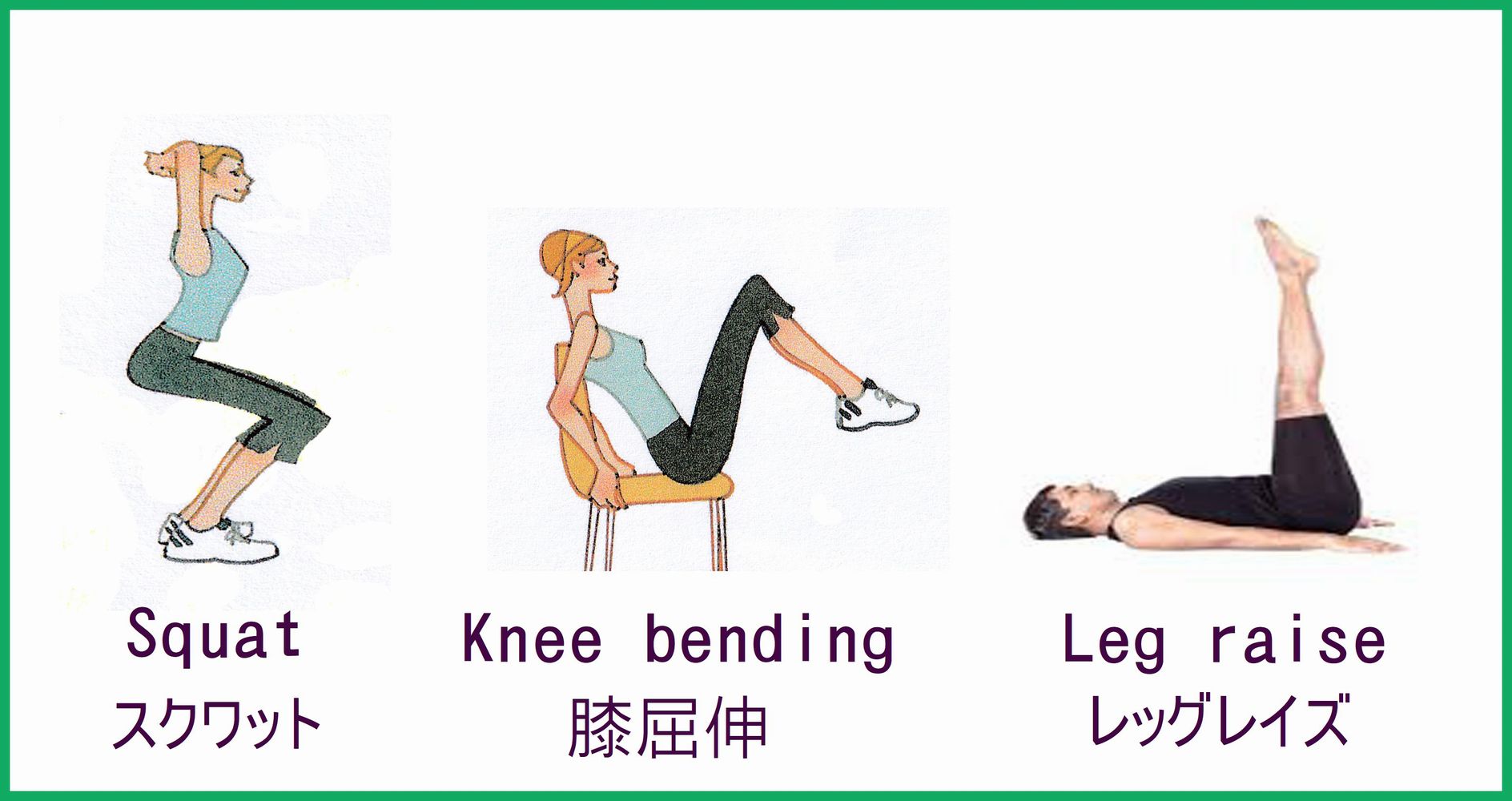
Two years ago, I introduced in this column a topic titled “Wake-up exercise” that I practice every morning before breakfast. It even includes playing
FreeCell (game on PC) as brain training. There was a time when I used to go to a sports gym for muscle training, but because of the coronavirus pandemic, I switched to doing it at home. Let me introduce how I practice the training. I continue this exercise because I believe that maintaining muscle strength is essential for living independently.
It is around 9 o'clock when I finish breakfast while reading the newspaper, clean up dishes and finish making my bed. The bed is the stage for muscle training, so I call it bedside gym. My routine is as follows:
1. Foot Massage: Sit on the edge of the bed and apply acupressure to the soles of feet with my right thumb. Press 50 times on each foot, focusing on the arch. If there are any areas where I feel pain, apply acupressure to those areas carefully. Feel good!
2. Knee bending (middle picture above): Sit on the edge of the bed and stretch both legs
horizontally. While keeping my feet in the air, I bend and extend my knees
40 times. It is important to repeat slowly without adding momentum.
3. Squat (left pictured above): Stand upright off the bed and perform 40 repetitions
of squats by bending and stretching my knees. Do this slowly too.
4. Ankle flexion: Stand upright with both hands on the wall and stand on my toes and then heels 20 times. Next, arch my hip while pushing one ankle far back. Push out the ankle so hard that my calf muscle pains. Repeat this twice for both foot.
5. Arm training: Stand upright with a 3kg dumbbell in each hand, hold it in front of me
for 10 seconds with my palms facing down, then swing it out to the side
and hold for 10 seconds. Repeat the same action with my palms facing upward.
Perform this set twice.
6. Leg raise (right picture above): Lie on my back on the bed, stretch legs, raise
legs 90 degrees upward, and slowly lower them down. Repeat this 40 times.
7. Ankle rotation: Lie on my back on the bed, stretch legs, and rotate my toes in a circular motion around my ankles. Move my left and right toes symmetrically and repeat 25 times inward and 25 times outward.
8. Hip joint motion: Lie on my back on the bed and bend my knees. Fully open the knees and
then close to activate the hip joints. Repeat this 20 times.
9. Abdominal and buttocks training: Sit on the edge of the bed. Continue to tighten my lower abdomen and
squeeze my buttocks for about 10 seconds. Repeat this 5 times.
10. Electric foot massage: Place a large electric massager (the kind used by barbers to massage shoulders.) upside down on the floor, with the vibrating pad facing up. Sit on the bed, place both feet on the pad, and massage evenly, focusing on the arches of my feet. I started using it to relieve numbness in my feet, but its effectiveness is unknown. But it feels good.
At first, the training items were far simpler. Because I have been adding muscle training that seemed to be suitable for me from those introduced in newspapers, magazines, TV, etc., the number of items has increased considerably. But it only takes about 10 minutes to finish. It is much shorter than the time required to visit a local sports gym. I am sure that the effect of the training is worth the time and effort I invest. There are likely individual differences in effective muscle training. My practice is just an example.
"From Daily Life" -71: Support scam abusing Trojan Horse

When I was facing my computer screen, I suddenly heard a beeping sound, and the screen suddenly changed as shown above. The speaker then began to announce, “This is a warning from Windows Defender. Your computer has been blocked by Trojan spyware. To unblock it, please call Microsoft Support Center and follow the instructions”. I was surprised and tried operating the keyboard and mouse, but the screen did not respond at all. As I was getting more and more panicked, the announcement continued saying "Hurry! Please call the support center immediately before all your data are frozen". (The screen above is a sample I found later on the internet and is close to what I remember. Only the phone number is actual.)
I pushed the long phone number with the utmost care not to make a mistake. The connection was quick. I heard the response “This is Microsoft's support center. First, please talk to me about the situation”. I said “It looks like I've been blocked by a Trojan horse. I'd like to receive the support I need to unblock it''. The person on the phone said “Please follow my instructions to unblock. First of all, I would like to explain the necessary money to get the support''. When I asked "How much does it cost?", he immediately replied, "It will cost 50,000 yen". At this moment I felt my first suspicion because the suppor process started with a busness negotiation.
I said “Okay, please give me instructions”. He started to give me instructions, but I couldn't catch them because of my poor hearing ability. When he asked me if I understood, I replied that I didn't because I had some hearing loss. He kindly repeated the instructions. Through these exchanges, I became convinced that his Japanese talk was not by an authentic Japanese. Suspicion became stronger! I became cool and kept saying I didn't understand. After a few minutes of conversation, he asked me “How old are you?''. I somehow exaggerated and answered “I'm 95 years old''. A moment later, he hung up the phone by himself.
The frozen screen of my computer returned to normal without any problems after I turned it off and restarted. Even after a complete scan of the computer's internal files, no viruses were found. After searching the internet, I quickly discovered that this was a scam abusing the notorious power of Trojan horse. I couldn't find how the scam got in, but it seems like it was hidden inside advertising screens I saw. The instructions that I failed to catch seemed to be that I should go to a convenience store and send 50,000 yen in electronic money, then install software with a real virus embedded in it to take over my account. Even with my hearing loss, I heard the word “convenience store” several times, so the person on the phone must have been trying desperately to convey the message.
The long phone number indicates an international call to Hawaii. Money transfer scams have become a business with international role sharing. Up until now, I had been thinking about why people could easily fall for money transfer scams, as if it were someone else's problem. However, a strong threat can surely lead people to panic and blow all doubts away! I am grateful to heaven that my hearing loss, which I usually struggle with, served as a talisman this time.
"From Daily Life" -70: Photo-Haiku 2
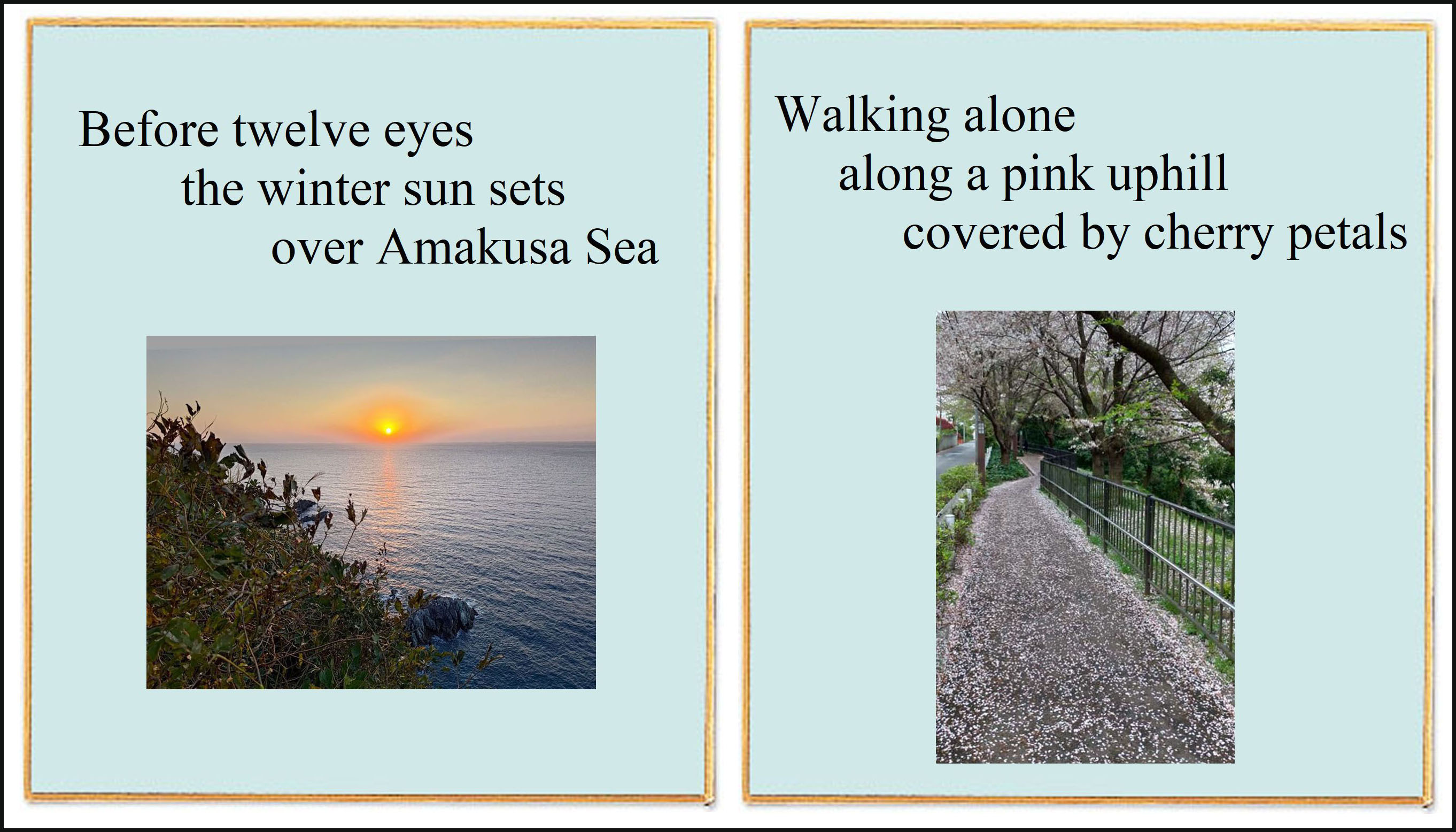
Everyone has a moment of deep emotion. Haiku is the way to describe this
moment just with 17 syllables, and photograph is the way to convey it in
the form of images. As a beginner in haiku, I feel a desire to use photograph
to assist transmitting the background that cannot be implied in haiku.
So, about a year ago, I introduced two examples under the title “Haiku with photograph”. Later, I learned that this is a genre called “Photo-Haiku”. From now
on, I would like to introduce my Photo-Haiku from time to time.
The work on the left of the above was created when I visited Amakusa Island of Kyusyu last year with five former students (64 to 82 years old) whom I taught when I was young. We watched the magnificent sunset over the Amakusa Sea at 13 Buddha Park, a famous sunset spot. Everyone held their breath and continued to stare. Even though the twelve eyes of the six were looking at the same scene, their thoughts were surely diverse.
The Chinese continent stretches out beyond the sea where the sun sets. Western people and culture also came from there. The people of Amakusa had lived with the destiny of being the first to contact with foreign countries. One such encounter was with Christianity. The people of this island must have continued to imagine what lies ahead while watching the sunset on the horizon. With these thoughts in mind, I witnessed the moment the sun faded out from the dark red sky.
The work on the right was created while following my usual walking route. The Kokubunji Cliff Line runs along the left bank of the Nogawa River, and the difference in height is nearly 20 meters. Since my home is located on upland, there is always a slope on the way leading to Nogawa. The slope shown in the photo is one of them and is called Beer Slope. Until about 30 years ago, there was a sports facility run by Sapporo Beer Company on the left bank of the Nogawa, but now it has been turned into a cluster of condominiums. The name of the slope retains the past.
During the cherry season, the riverside area is full of cherry blossoms. There are also cherry trees lined along Beer Slope. As the flower approaches its end, the bottom is covered with fallen petals. The uphill climb back from the walk is tough, but the slope looks like inviting me with a pink flower carpet. It's like a road leading to heaven.
My self-taught haiku will hardly progress. When I write an article, I always pay attention so that readers may understand my intentions with the least effort. In haiku, where allusion is the innermost secret, such attention works rather negative. But it's fun to make haiku. Let's keep going.
"From Daily Life" -69: Kitami Community Square
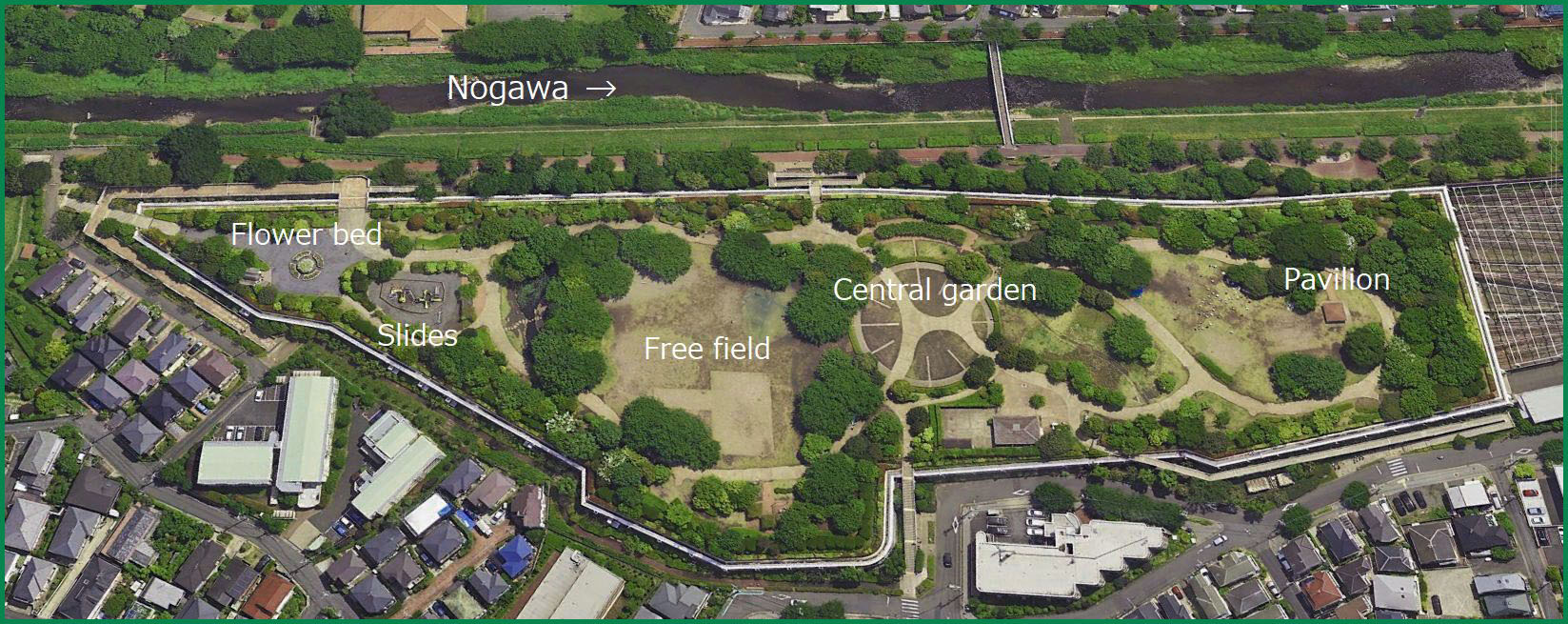
Walks have become almost a daily routine. Occasionally, I drive to places like Jindai Botanical Garden or Kinuta Park and take a stroll through the large gardens. However, the basics are walks around the area. My home in Seijo is sandwiched between two rivers, Nokawa and Sengawa. The promenade along the rivers has become a standard walking route.
The Nogawa originates from Kokubunji, flows down for about 20 kilometers
along the Kokubunji cliff line, and joins the Tama River at Futakotamagawa.
There are many cherry trees along the riverbank. Five years ago, I introduced
a travelogue entitled “Welcomed by cherry blossom” when I walked upstream during the cherry blossom season.
When I don't have a particular desire, my feet naturally head towards the Nogawa. After walking about 600 meters, I reach the riverbank. My routine is to walk along the riverside promenade for a while and take a break at Kitami Community Square. There, I look at the seasonal trees and flowers, observe children playing on the lawn, and then head back home. It's an hour-and-a-half-long walk with about 6,000 steps.
This time, let's introduce the Kitami Community Square. The area is outlined with a white line in the photo above and is maintained by Setagaya Ward. The square borders the right bank of the Nogawa and stretches approximately 300 meters in length and 100 meters in width. With trees growing thickly and play fields scattered throughout, it is more apt to be called a park. This square, which looks natural at first glance, is actually a man-made piece of land created on the roof of the Odakyu Railway depot. The railroad tracks visible at the right end of the square convey its true identity.
Now, 30 years after its opening, the sides of the 10-meter-high depot building are almost shielded by trees. People would easily believe that the square was on a natural hill. The thickness of the mound on the roof is 1.2 m, and there are small hills here and there. The transplanted young zelkova and cherry have grown into giant trees with roots spreading in the thin soil layer. Looking at the photo above, the trees in the square look completely comparable to the natural trees that line the river. Trees have amazing adaptability and vitality.
Flowering trees change with the seasons, from cherry blossoms in spring to camellias in winter, and the garden's flower beds are filled always with colorful flowers. Ever since I started composing Haiku, I have tried to come up with a new Haiku whenever I am struck by beautiful scenery. I’m sorry, however, to end up with a similar mediocre Haiku. Few people visit on weekdays, but in the afternoon there are quite a lot of parents and small children enjoying playtime. Observing children running around is also soothing.
The community square is well maintained. I spend some time there and then start returning. It is a place that I am grateful for because it gives me a sense of vitality and peace throughout the four seasons.
"From Daily Life" -68: Hand craft as a hobby

As a full-time housekeeper, I have plenty of freedom after finishing all the housework I have to do. Except for days when I have commitments, my days go by like reading newspapers or books, watching TV, checking emails and browsing social media on my computer, shopping daily needs, going for walking or driving, etc.
However, there are times when I get carried away. It's time to make something by hand. When it comes to DIY, it is normal to make something useful such as furniture, but the things I make are completely useless. Making plastic models falls into this category, but I get soon bored with assembling intricate parts in a package. Instead, it's much more fulfilling to make something by hand from scratch using raw materials such as paper and wood. One of my nieces, M, who sometimes comes over to my house and cooks dinner for me, also likes to do crafts with me. Many of the works I will introduce here are collaborative results with M.
The four wooden works shown in the photo above are called Tensegrity, a compound word for tension and integrity, which utilizes thread tension to create a mysterious structure that appears to float in the air. Works 1, 2, and 3 have the same principle. Both the upper and lower deck have a vertical support arm. The tip of the upper support arm hangs from the tip of the lower support arm by a thin thread. The tension of the thread supports the weight of the upper part. However, if this continues, the upper part will lose its balance and become inverted. To prevent this, at least three thin threads are used to pull the upper and lower decks and keep parallel. The secret is that when we put an object on the upper deck, it appears to float in the air.
In case 4, a horizontal L-shaped object appears to be floating in the air due to the tension of the threads. If we use a transparent fishing line as the thread, the mysterious feeling will be even greater. The unique feature of Tensegrity is that it uses only the tension of threads to unite two objects while appearing to be separated.
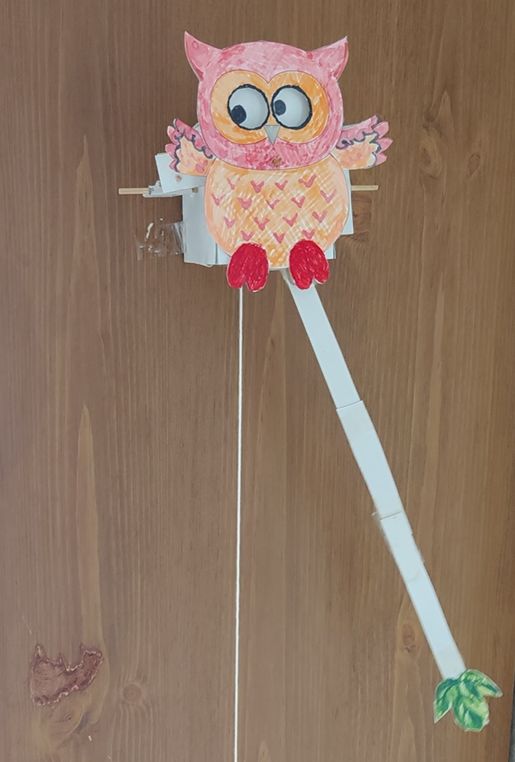 The next is the case of moving work as shown in the right picture. Please look video by clicking here. A “Look around owl” was made from paper, bamboo strips, and thread. Similar to the principle of old weight pendulum clocks, an escapement is used to swing the pendulum. One AA battery is attached to the back of the tip of the pendulum, and one AAA battery is attached as a weight under the string that turns the escapement. I had a hard time adjusting the escapement, but if things went well, the shake would continue as seen in the video. The owl's eyes would move around, much to the amusement of my grandchildren. Once the thread is wound up, the swings last for more than a minute.
The next is the case of moving work as shown in the right picture. Please look video by clicking here. A “Look around owl” was made from paper, bamboo strips, and thread. Similar to the principle of old weight pendulum clocks, an escapement is used to swing the pendulum. One AA battery is attached to the back of the tip of the pendulum, and one AAA battery is attached as a weight under the string that turns the escapement. I had a hard time adjusting the escapement, but if things went well, the shake would continue as seen in the video. The owl's eyes would move around, much to the amusement of my grandchildren. Once the thread is wound up, the swings last for more than a minute.
Works like the above are scattered around in my house. Although they are useless, handmade items are somehow hard to throw away.
"From Daily Life" -67: Amakusa tour
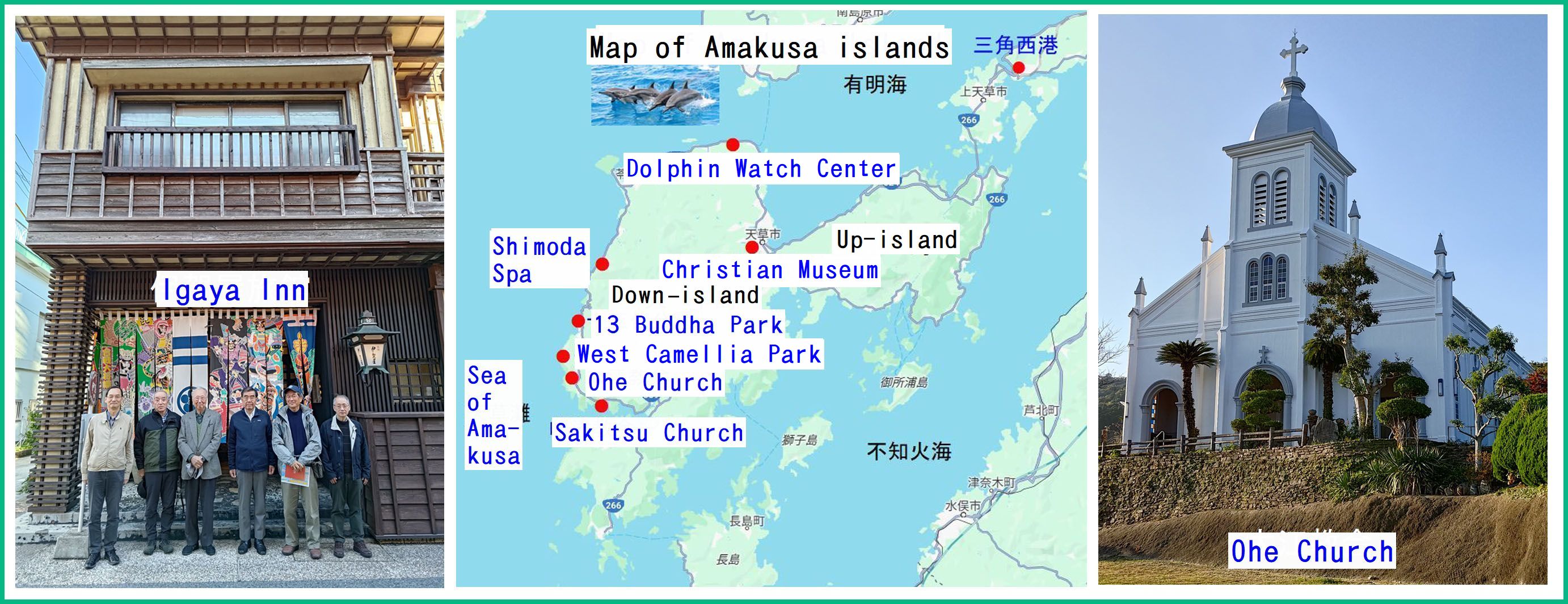
In response to the invitation of former students living in Kyushu, I enjoyed a two-night, three-day trip around Amakusa, a small island of Kusyu. It's been about 10 years since I last travelled by plane, so this is my first big trip in a while. My five companions were former students whom I taught at the University of Tokyo at a younger age, and we travelled together as a group of six seniors, ranging in age from 64 to 92 and feeling more like brothers than teacher and students.
The invitation to travel to Kyushu has been around since before the invasion of Coronavirus, but the opportunity has suddenly become ripe since the danger of Coronavirus was downgraded to Category 5. When asked where I wanted to go, I couldn't help but say Amakusa. I've visited most of the famous spots in Kyushu, and Amakusa, a remote island with a history of Christian suffering, appealed to me as a pilgrim.
On the afternoon of November 18th, I left home and flew to Fukuoka on ANA, and in the evening I met up with grandson K, who was undergoing training at Fukuoka Central Police Station, and celebrated our reunion at a yakitori restaurant in Nakasu. I stayed overnight at a hotel near the airport and prepared for early departure the next morning.
At 9 am on the 19th, I met up with five members, T, T, T, K, and N, at the airport. We got into a rental car <Nissan Serena> and set off towards Amakusa. On the first day, we only visited Kumamoto Castle, which had undergone major repairs after a big earthquake, and then continued driving through the Uto Peninsula, passing through Oyano Island and Amakusa Up-island, to our destination, Amakusa Down-island. Just before the sun was setting, we arrived at Igaya Inn, the hotel in Shimoda Spa on the west coast. After taking a bath, we started a nostalgic dinner party while enjoying local fish.
On the 20th, we toured Down-island, first stopping at Amakusa Dolphin Watch Center and boarding a sightseeing boat. The dolphin habitat is the sea area between the island and Shimabara Peninsula on the opposite shore. Shortly after leaving port, we encountered a group of dolphins that occasionally appeared on the surface of the sea for spouting. At first, we cheered very much, but it seemed like it was a lucky day, as we encountered pods of dolphins one after another every few minutes. If we're unlucky, there are days when we can't find dolphins even after running around for an hour. Then, we visited Amakusa Christian Museum and World Heritage Sites like Sakitsu Church and Ohe Church, and watched the magnificent sunset over the Sea of Amakusa at 13 Buddha Park, a famous sunset spot.
Amakusa Down-island is full of historical heritage and nature. I truly felt like a pilgrim. The night was filled with excitement once again at the final dinner party.
On the 21st, we received power from the giant trees and boulders at West Camellia Park and left the island. On the way, we stopped at Misumi West Port, a heritage site of the industrial revolution, and then drove straight to Fukuoka Airport. After 5 o'clock, I said goodbye to the five members who had been waving at me at the airport departure gate and headed to the boarding gate. I got home after 9 o'clock and was relieved that the long trip had ended safely.
We were blessed with good weather, everything went smoothly, and we had a lot to talk about. The five members also seemed to be really enjoying the trip. It was an unforgettable trip that made me feel happy to be alive.
"From Daily Life" -66: Moving of home computer
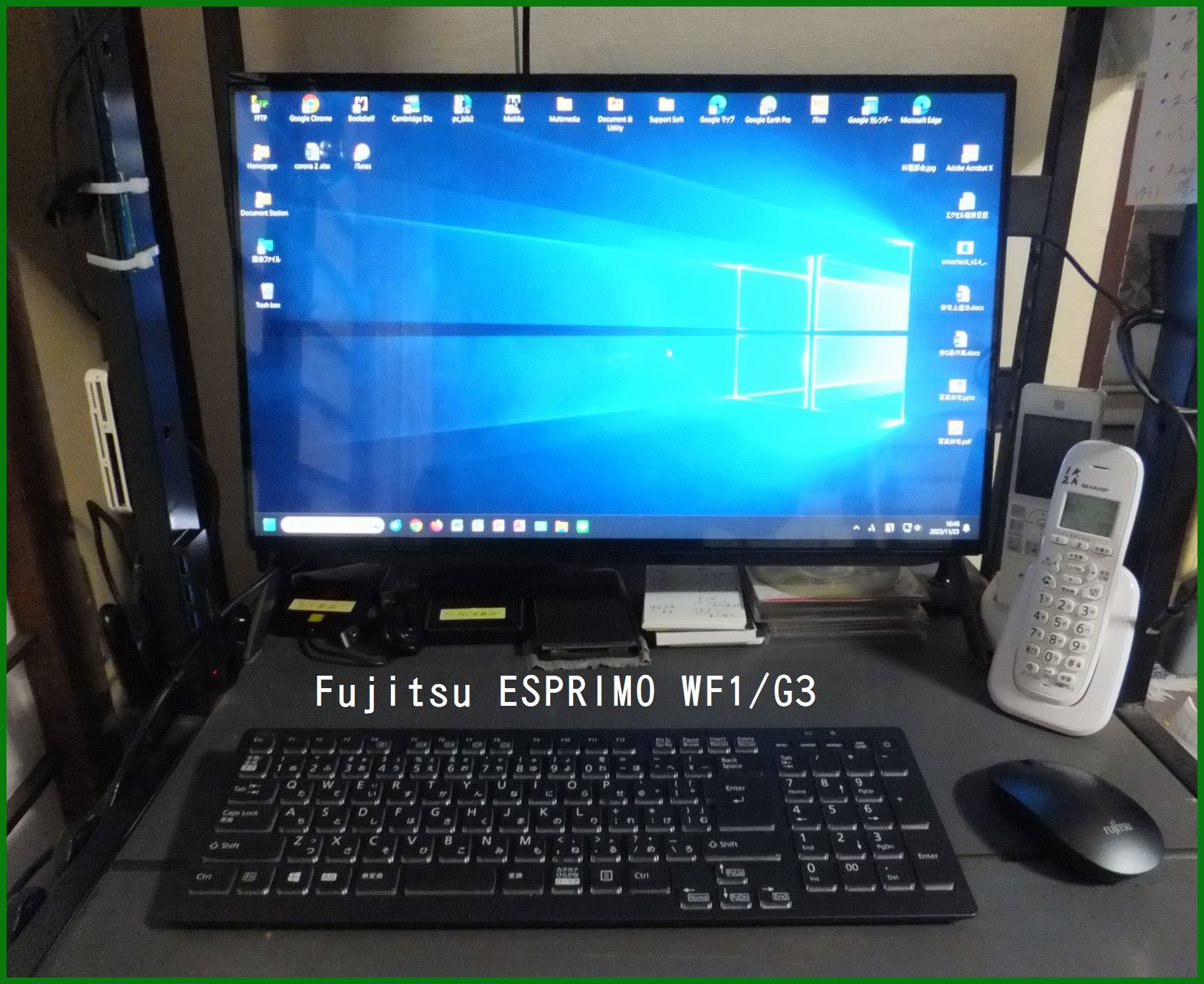
For the desktop computer I keep at home, I've been using Fujitsu's ESPRIMO, which allows me to customize major specifications to fit my own needs. The model (FH90/DN) purchased 12 years ago has been operating smoothly without any troubles. Four years ago, I replaced the hard disk with an SSD, so I had no complaints about the speed. It was still usable enough. However, the system conditions were insufficient to switch the OS to Windows 11, so I stayed with Windows 10. If I search on the internet, I find that the average lifespan of a computer is 5 years. With this, it wouldn't be surprising if the present machine went down at any time. So, I decided to take the plunge and buy a new one to avoid the risk of sudden death.
The new machine will most certainly be my last computer. Therefore, I selected the highest specifications allowed and took care to ensure that it could be used for a long time. I chose a compact all-in-one model (WF1/G3) with a 24-inch monitor so that it fits neatly on my PC stand, as shown in the above photo. The CPU is Intel Corei7, the memory is 16 GB, and the storage is a combination of 1 TB SSD (PCIe) and 2 TB HDD. The keyboard and mouse are wireless and the OS is Windows 11 Home. The price was about 200 k\.
The problem was moving the applications I was using. For this purpose, I used SourceNext's ”Automatic Moving'' software, which connects the old and new computers with a LAN cable and transfers data. It took a full day to migrate applications, image data, etc., but the move was completed almost perfectly. The environment that I was used to was transferred from the old to the new. Office (Word, Excel, etc.) and some major software asked me to input their registration number, but fortunately, I could find these records, so I was able to clear it all. When I started the new machine up, the screen and usability were almost the same as the familiar old machine.
The new computer gives me a sense of technological progress. It starts
up quickly and I haven't had any problems so far. There are probably many
new features that I haven't used yet. From now on, I will be living with
this computer for the time being. I did everything by myself, including
selecting the model, installing it, and moving applications and data. I
have hoped to do it before my willingness and skill decline. I'm glad I
have timely done it! This year has been a fruitful year for me as I have
moved both my smartphone and computer.
"From Daily Life" -65: Hinata Temple of Yakushi
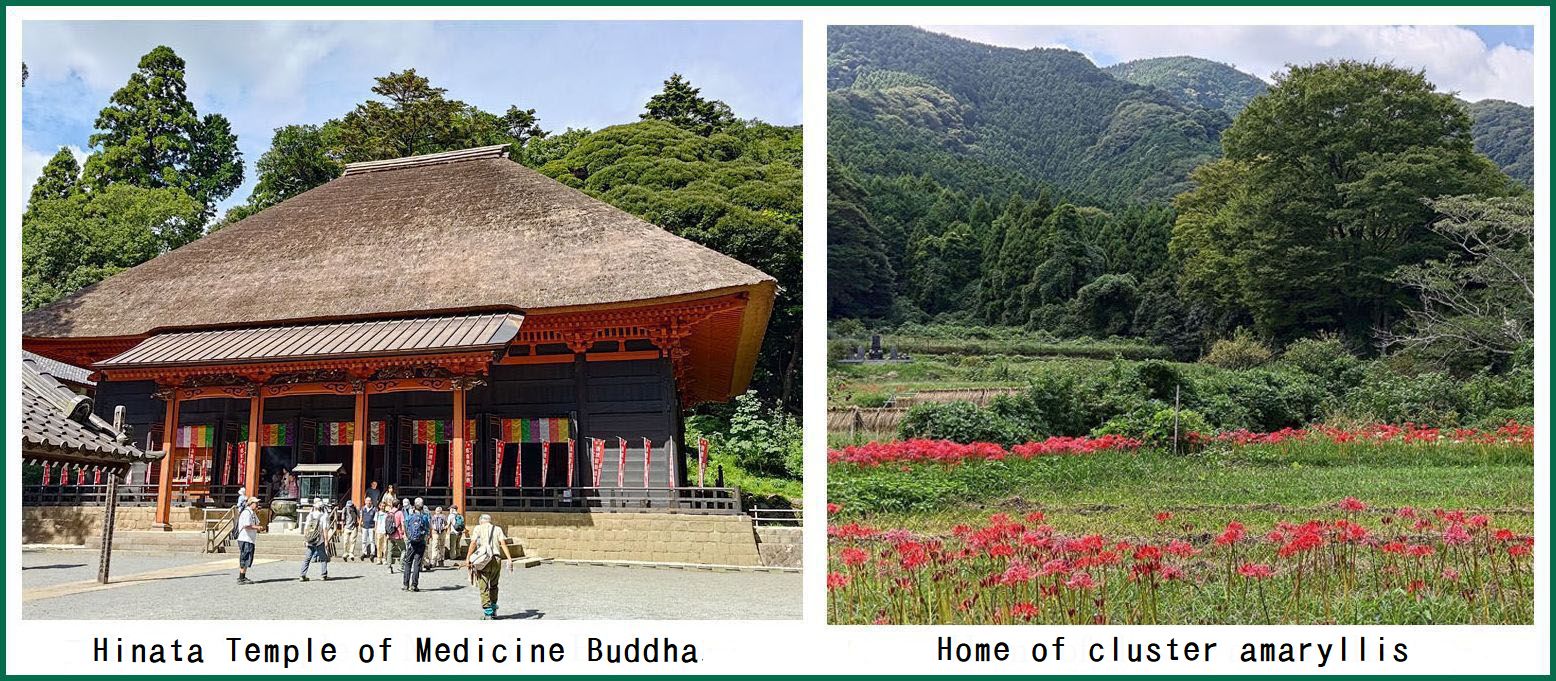
Tanzawa is a mountain range to the west of Tokyo, and Mt. Fuji can be seen beyond the ridgeline. It is the most familiar
mountain for Tokyo residents. At its southern end near the sea, a peak
called Ohyama towers with an altitude of 1,252 meters. On its southern
slope at about 400 m altitude, Hinata Temple of Yakushi(Medicine Buddha)
is located. It is an ancient temple founded in 716 AD and has a history
of 1,300 years. The Temple has prospered as a base for doctrine training
in mountains. In addition to the Temple, there is a treasure hall in which
many Buddhist statues and cultural assets are displayed for visitors. Yakushi
is worshipped as a Buddha who protects the health of mind and body. There
is Nanasawa hot spa nearby, and a popular hiking course connects these
spots.
I have visited Hinata Temple many times. Most of these were in the autumn
equinox season. The hilly country area that spreads out at the foot of
the Temple is known as the “Home of cluster amaryllis”. The scenery is
so impressive t hat I wish to come back again.
hat I wish to come back again.
The cluster amaryllis, which blooms in deep red flowers and grows in clusters, is at its best during two or three weeks around the autumn equinox, and there are many public gardens famous for the flower.
The roots of this flower are poisonous and are said to be useful in controlling
pests such as moles. For this reason, farmers of mountain villages used
to plant the flower along the ridges of rice fields for protection. This
custom has been passed down through generations. In the terraced rice fields
spread out in the hilly countryside, the flower grows along the ridges
after harvesting, giving the appearance of red picture frames scattered
over the fields. This is a scene that symbolizes autumn in Japan's mountain
villages. Walking along the ridges guided by the deep red flowers, we feel
as if we have wandered into paradise.
The new Tomei Expressway recently opened, and an interchange called Isehara Oyama became available. If we drive about 4km from the interchange, we will reach the Home of cluster amaryllis. The historical base for training in mountains has become drastically convenient to reach. However, I hope the secluded atmosphere will remain forever.
"From Daily Life" -64: Turbo

The root of the word ‘turbo’ is a snail-like shell called turbo. From its spiral outlook, it came to mean whirl, and eventually rotate.
Nowadays we see a lot of words that start with ‘turbo'. Examples are: turbojet and turboprop for airplanes; turbocharger and Turbopower for engine and electric cars; Turbo Pascal and Turbo C for computers; Turbographics for gaming machines; Turbo as the name of pop and heavy-metallic music groups, and so on. In the photo above, examples of turbo family are shown.
Of the examples listed above, the first three (bold character) are indeed rotating, but anything below Turbopower (battery quick charger)
has nothing to do with rotation. However, the followers have made the most
of the images established by their predecessors, such as high-speed, dynamic,
and high-power. Its use in the field of computers and music has given rise
to new images of ‘smart’ and ‘leading edge’. Turbo has now become a prefix
that mediates images of speed, power, and sharp smartness. Its use is likely
to increase in the future.
The other day, Turbomachinery Society of Japan, of which I served as president about 30 years ago, celebrated its 50th anniversary. Turbomachinery has been developing since it was born 250 years ago, but few people know what turbomachinery actually is. The first three examples marked bold consist of turbomachinery. Taking the most familiar example of a turbocharger, it has two turbo machines, a compressor and a turbine, at both ends of a single shaft.
The definition of a turbomachine is; a machine that exchanges fluid energy and shaft power using the lift force acting on the moving blades as a medium. Since blades are fixed to the shaft, it is necessarily a rotating machine. Water turbines, windmills, and gas/steam turbines extract power from fluids, while pumps, fans, blowers, and compressors transmit shaft power to fluids.
My commitment to turbomachinery started when I worked on graduation thesis as a student and continued to my retirement. Turbomachines have a long history with the traditional image of ‘rotational’. Times have changed. People now image them as speedy, powerful, and even smart machines. That's a blessing change! Turbomachinery needs to modernize itself to cope with the new images.
"From Daily Life" -63: FreeCell
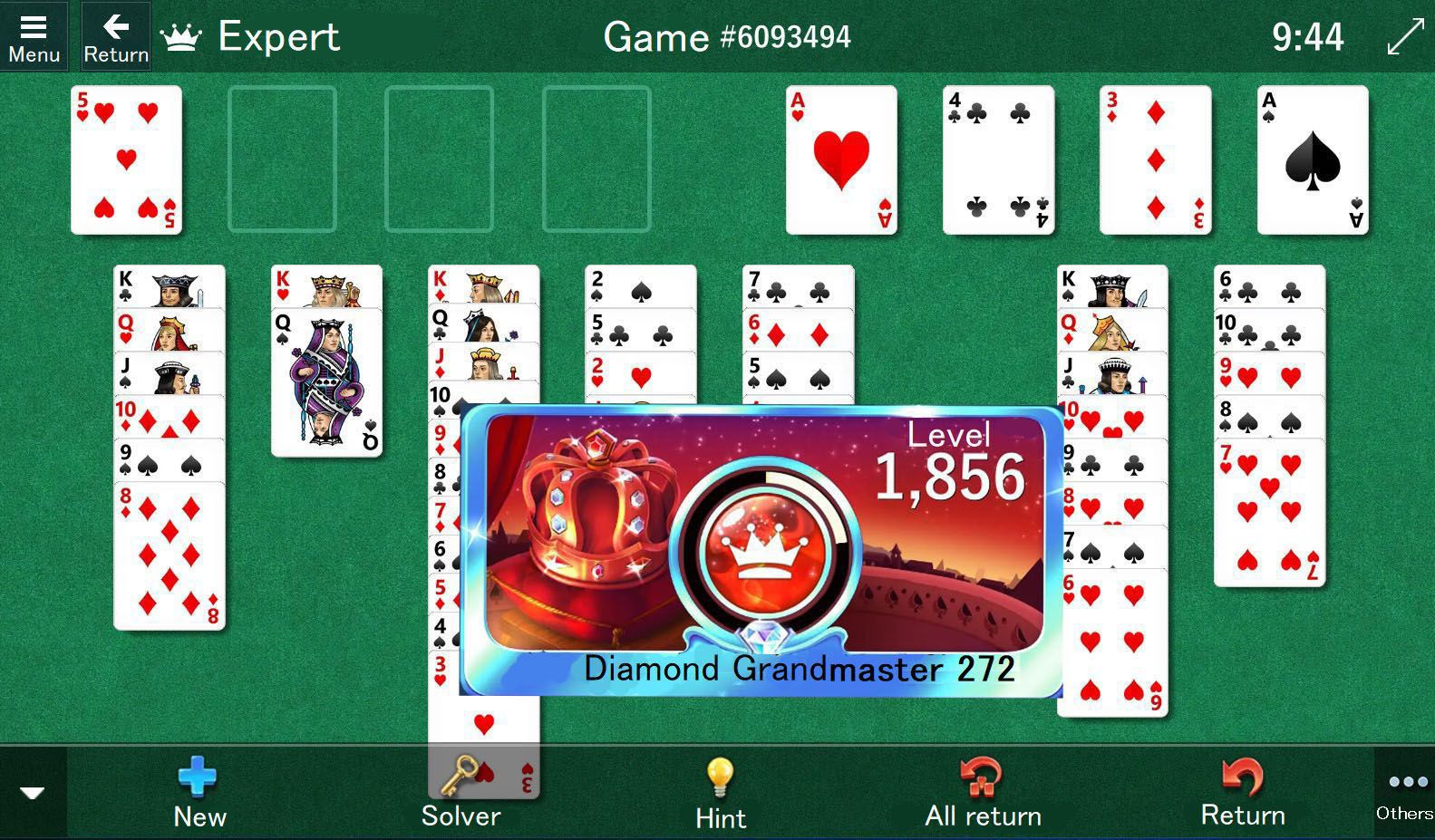
In our daily lives, there are certain routines that we repeat. In my case,
I wake up at 7:30, send good morning stamps to my two sons via LINE, change
clothes and start wake-up exercises, have a leisurely breakfast while reading
the newspaper, finish bed making, and do muscle training on the bed for
10 minutes. All will be over by 9:30. In the evening, I start cooking dinner
at 6:00 and finish eating by the time the TV news starts at 7:00, take
a bath after 10:00, send goodnight stamps to my sons, and go to bed. A
hot bath induces a quick falling asleep. The morning and night LINE messages
are essential for my survival confirmation.
As I already introduced on this top page, I practice wake-up exercises on the balcony except when it's raining.
It feels especially good on days when I can see Mt. Fuji. Exercises include
both for muscles and for brain. All steps are fixed. FreeCell is a brain
teaser game for PC.
There are a lot of games that can be played alone on the screens of PCs, tablets, and smartphones. I had tried various games such as mahjong and various card games, but the one that remained in the end was FreeCell. It is a kind of card game where players win when they finish arranging the cards in the correct order. Games are so arranged that players have always the possibility to win but the class of difficulty can be selected by players. I'm used to choose the highest class called Expert. The picture above is a screen during play. My morning routine is to clean up two games within 15 minutes on average. When a very difficult problem takes too long, I interrupt and retry at my leisure time. Sometimes I just can't win and give up.
I am using FreeCell in the free game Solitaire provided by Microsoft. The game may record the number of plays so far, the number of plays won, the winning percentage, the best time, and the average time. My past data shows 99% winning rate after playing 24,546 times, best time of 1 minute 25 seconds, and average time of 7 minutes 40 seconds. The total playing time is surprisingly 130 days. I can't believe it myself.
I'm not sure how long I played FreeCell as a daily routine. Assuming 25 years since I'm sure I started before I retired, I should have played 20 minutes a day. Data testifies that FreeCell has been an important part of my daily life.
As I continue to play and win more games, my acknowledged level will gradually increase. Accordingly, the given title name will also vary. It took me a long time to get the title of Grandmaster at level 100 five years ago. Since becoming living alone, I have been steadily promoted, going through Bronze, Silver, and Gold Grandmaster, to Diamond Grandmaster 272 at level 1856. I've searched online but can't find any higher title name for winners. It seems that the only number behind the title increases as winning proceeds.
There must be someone with a higher level than me. Though there are numerous FreeCell maniacs, title holders of Diamond Grandmaster may be quite limited. I have received medals and rewards from the country so far, but in terms of rarity value, Diamond Grandmaster is probably the highest honor for me.
I don't know how to verify the positive effect of my brain exercise by FreeCell. Since I'm sure that I haven't reached MCI (mild cognitive impairment) yet, it doesn't seem to cause any harm. I confess here that FreeCell has been an intimate partner throughout my elderly life.
"From Daily Life" -62: Setagaya Art Museum
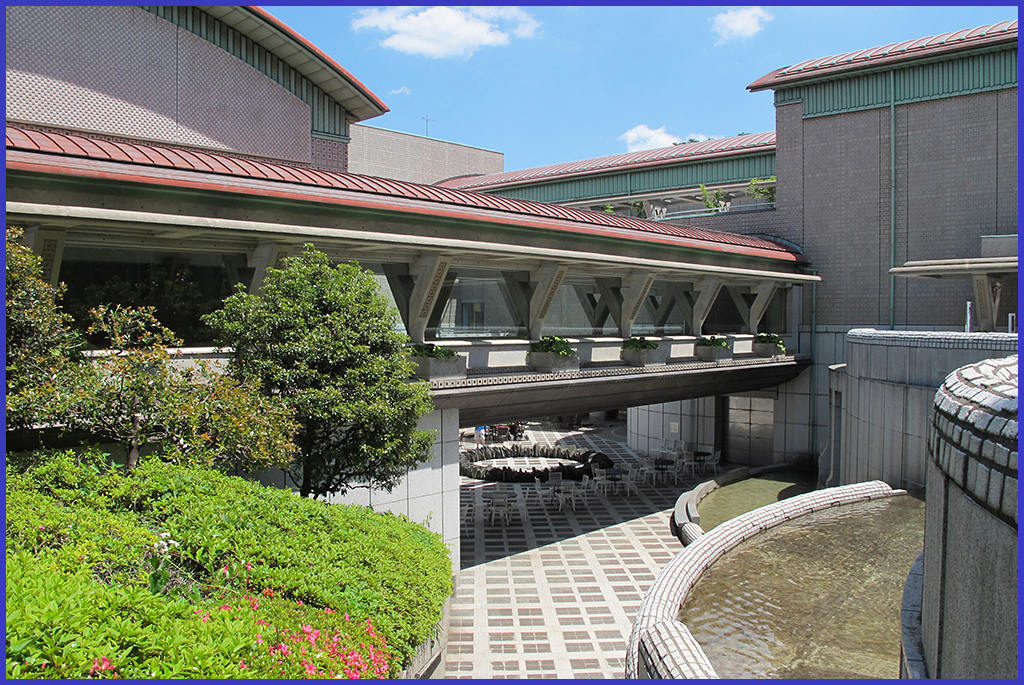
The vast Metropolitan Kinuta Park is about 15 minutes away by car from my house. Setagaya Art Museum is located at the navel of the park. I have already introduced Kinuta Park on this top page, which I frequently visit for a walk. This time, let's focus on Setagaya Art Museum.
Capital Tokyo has the Tokyo Metropolitan Art Museum in Ueno, along with art museums specializing in photography, gardens and contemporary art. On the other hand, art museums named after Meguro Ward, Nerima Ward, Itabashi Ward, and Setagaya Ward are well-known as museums founded and operated by the ward. I have visited all of them, but Setagaya Art Museum stands out due to its lush green location and the scale of buildings and facilities.
Setagaya Art Museum was founded in 1986 and is rather a newcomer since it is only 37 years old. Because it is located in the center of a park that residents of the ward visit with their families as a place for relaxation and sports, the museum bears the mission to connect the lives of the residents with art. The Latin inscription on the wall of the entrance hall says “Art and nature secretly work together to lead humans to health'', which speaks to the purpose of the museum. In addition to exhibition rooms, the museum contains also a restaurant, cafe, gift shop, library, creative room, and resident gallery, and plays a big role as a place for residents to interact.
There are special exhibitions and permanent exhibitions. Like the Chagall exhibition that is currently running, there are about six special exhibitions a year that focus on an artist or a theme. I used to visit each time when a new special exhibition starts. While taking a walk, I stop by the permanent exhibition from time to time.
Recently, I became a member of the Friends Association of the museum. With a sign-up fee of 1,000 yen and an annual membership fee of 4,000 yen, admission to all special exhibitions, permanent exhibitions, and three annexes of the museum in the ward (Mukai Junkichi Atelier, Kiyokawa Taiji Memorial Gallery, Miyamoto Saburo Memorial Museum) is free. As a bonus, I may use the museum's private parking lot free of charge.
Take a walk in the greenery, stop by an art museum, and relax at a café. A moment of bliss awaits always. Commuting to Kinuta Park is fun in all four seasons. The visits to the museum would become more frequent than ever.
"From Daily Life" -61: History of private cars
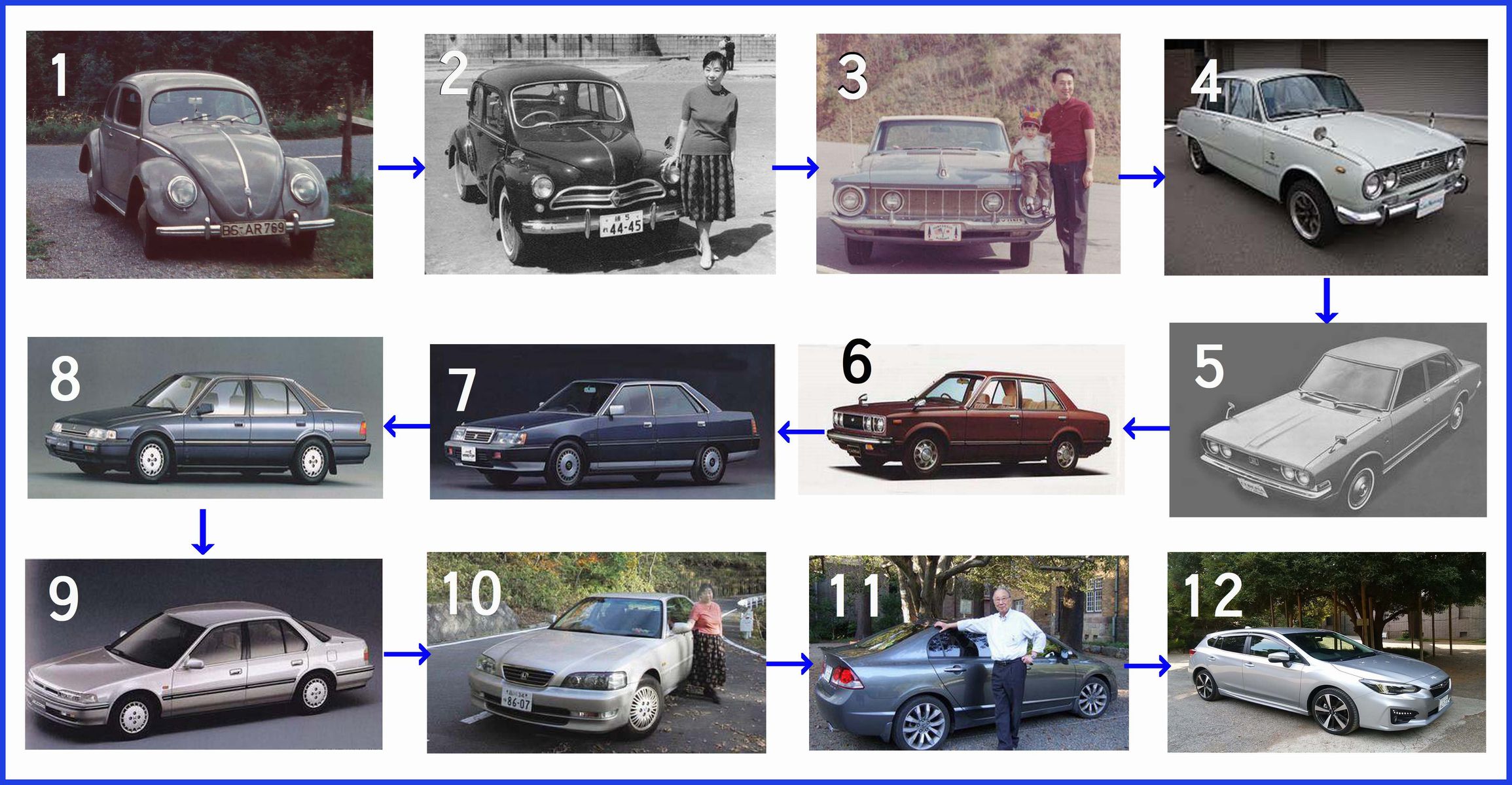
While I am fully aware that my ageing progresses steadily, I renewed the mandatory vehicle inspection of my beloved Subaru Impreza. This car has entered its sixth year, but as the last car of my life, let's enjoy it for a while longer. Counting from the first Volkswagen I drove 66 years ago, the Impreza is the 12th generation. On this occasion, let me summarize and introduce the history of what kind of cars I have ridden so far. I have described the 12 vehicles as shown in the table below.
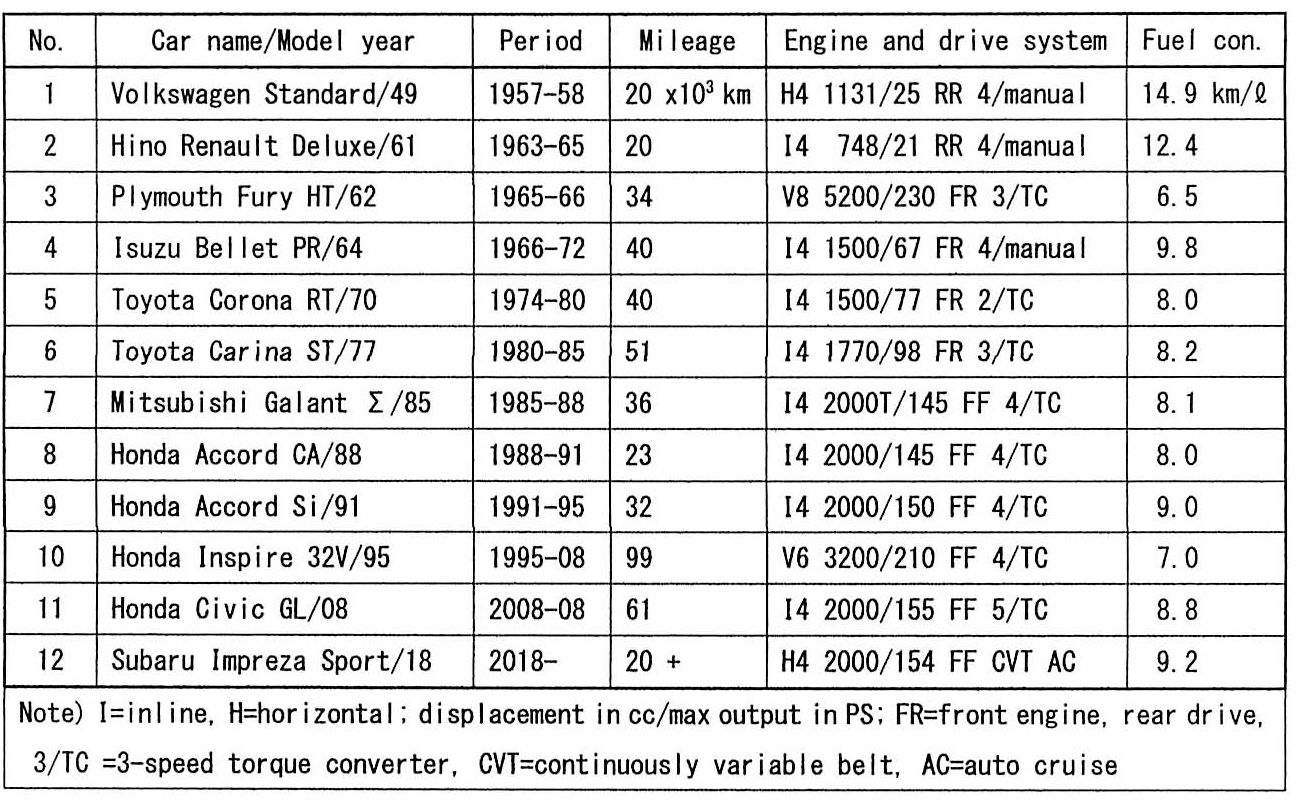
In generation order, the car name and model year, period of use, mileage, engine and drive system (cylinder arrangement, total displacement, maximum output, drive train, transmission) and average fuel consumption are shown. The average fuel consumption has a surprisingly small variation, probably because of the similar riding style. The total mileage is 476,000 km. Over the past 66 years, I have travelled 12 times around the earth with 12 cars. I recall them all with nostalgia.
From the 1st generation to the 6th, they were all used cars. I was finally possible to buy a new car after passing the mid-50s. However, I have never encountered any trouble because it is second-hand. I'm a machinist who majored in mechanical engineering, so I guess it's because I didn't skimp on maintenance according to the condition of the car.
I have been lucky not to have suffered a personal injury as well as a serious accident. However, there were quite a few traffic violations, including license suspension. There were two speeding violations and others such as a stop sign violation.
The first Volkswagen had a taste of the prototype of automobiles, such as non-synchronized manual transmission and wire brakes. Cars have evolved since then tremendously. Recent cars are clever enough with countless CPUs. The current Impreza's automatic tracking operation (auto-cruise) is so good that it seems to be one step away from automatic driving. The cars of the future will be one step closer to self-driving.
From the 4th generation onwards, all cars are made in Japan. Many of the students I taught are working hard to make cars at automobile companies, so it was my dream to drive cars made by all domestic companies (excluding light vehicles). However, this was not achieved. I took a big detour with my wife who loved Honda, and rode four cars of the same make successively. It's a pity that I lost the chance to steer a Nissan or Mazda car.
The transition to electric vehicles is hitting an avalanche. I feel that reciprocating engines have advanced to their ultimate limit. I have been able to enjoy the era when the engine shines overcoming environmental problems.
There is no space to talk about all. On this top page, I have already
covered the topic of cars such as The first own car, My Car No. 3, The second last car, and 3 years with Subaru. Every other car is also filled with family history and memories.
This time, I won't go into details, and I'll just give you an overview of my car history. In addition, I arranged the photo above in which all the nostalgic cars are lined up in generation order. Although the cars were a member of my family, I was disappointed to find that there were surprisingly few photos showing perfect figures of cars.
"From Daily Life" -60: Moving to 5G smartphone

Four years ago, I reported the reason why I switched from Fujitsu's Arrows
to ASUS's Zenfone 5 on this top page under the title of Moving from old to new smartphone. ASUS was the first Taiwanese manufacturer, so I was a little anxious
at first, but after using it, my confidence increased a lot. I've dropped
it twice carelessly on a hard floor but it survived unscathed and without
any trouble. The battery lasted well and degraded only little. The camera
performance was also so-so, and it was very satisfying for a mid-range
Android model that cost 50,000 yen.
The Zenfone series undergoes minor changes every year, and now Zenfone 9 is the latest model. The major changes include 5G mobile network, faster CPU, improved camera performance, and expanded memory. Although I wasn't particularly dissatisfied with the current performance, I gave in to my desire to use 5G and decided to switch.
I purchased it SIM-free from the IIJ online site. I generously chose the highest memory capacity; 16GB for RAM and 256GB for storage, so the price jumped to about 110,000 yen, more than double the price of the previous model.
If I buy a SIM-free smartphone, I have first to replace the SIM and transfer settings, accounts, applications, etc. from the old to the new. This is a nervous process. Luckily, I switched to the same model, so I just put the old and new smartphones on top of each other, and the attached application almost automatically transferred the data. Only moving LINE data had to be done separately. I was relieved that the move was completed in one shot and I could start using it without any discomfort.
What I expected most from the new smartphone was the application that converts voice inputs to text display with little delay. The case of "Japanese speech → Japanese text display" is most important for me with hearing impairment. The case of "Japanese speech → English text display", or vice versa, is like hiring a personal interpreter in hand. Thanks to the high-speed CPU and 16GB RAM, I confirmed that the action was quick and stress-free.
It’s easy to use and fits comfortably in one hand. Battery capacity is sufficient. The camera has a powerful image stabilization system, so it's especially good for shooting videos while walking. Let's make full use of these functions.
Smartphones have now become a necessity in life. As a reliable partner, let's live together for the time being.
"From Daily Life" -59: Haiku with photograph
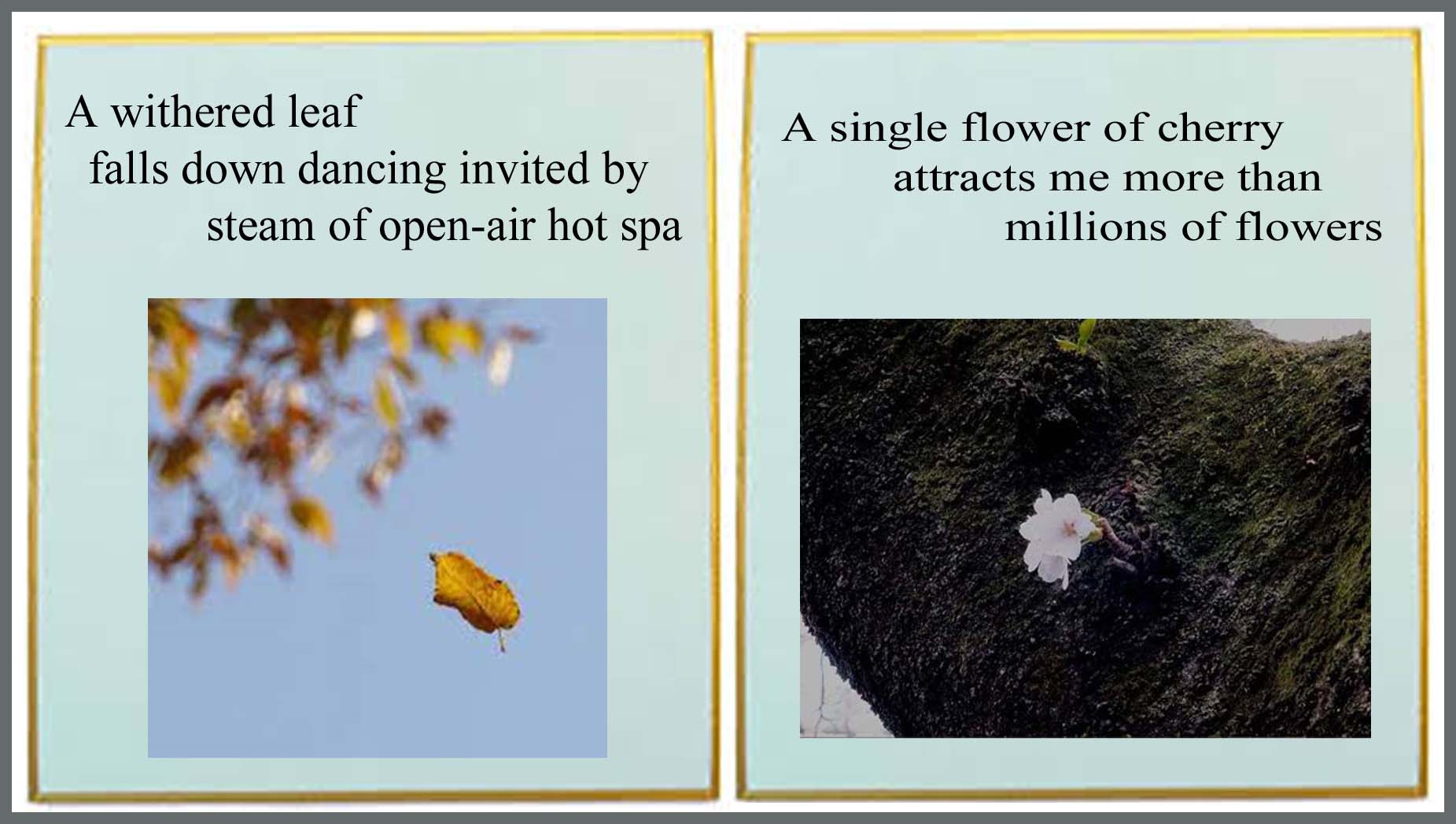
Around autumn last year, I began to enjoy Haiku. I have been completely self-taught and on my own way. Since I started composing Haiku, my walk has changed drastically. Before, I walked around observing the changes in nature with no specific interest. But after, I walked always looking for a moving scene that deserved a Haiku. The subject of works was mostly the beauty of nature, such as trees and flowers.
As this situation continues, my Haiku has become gradually banal and monotonous. Most of the works are too much expository about the beauty of plants, and may be evaluated as mediocre. In order to get out of this state, I have to expand the range of subjects from natural beauty to our lives general.
The feature of Haiku is that it describes a moving scene with 17 carefully selected syllables, leaving the background to the reader's imagination. Well known works achieve this admirably, but a beginner like me with a poor vocabulary falls far short of that realm. I'm always frustrated that I want to explain more about the background that I can't convey in the work. In order to relieve my frustration, I would like to choose two of my works and give full explanation assisted by a photo and unlimited words.
In the left half of the above picture, a Haiku;
"A withered leaf / falls down dancing invited by / steam of open-air hot spa"
is shown with a matching photo.
It was a late autumn afternoon when I was soaking in an open-air bath at a hot spa in Okutama. The ridge line that separated the autumn sky run in front of me. The leaves of the trees were turning red and yellow, and the surface of the mountain looked spotted.
A dead leaf suddenly falls in front of me. It must have dropped from a tree surrounding the open-air bath. Carefully looking, leaves occasionally fall down nearby. Each one falls in a different way of dancing. During 10 seconds or so, during a leaf leaves the branch and reaches the ground, it seems to be dancing with its own design. 10 seconds and my life are almost the same instant in terms of the eternal flow of time in the universe. Am I about to fall to the ground after dancing like a leaf?
Despite such an elegy, my heart stayed quite calm, may be because the hot spa healed my mind and body.
The right half of the above picture is for another Haiku;
"A single flower of cherry / attracts me more than / millions of flowers"
The cold weather has passed and the cherry blossoms are in full bloom. When it comes to famous cherry blossom spots, there are place like Yoshino Thousand Cherry that is overwhelming in number, and place like Thousand Year Old Cherry that is single but unbelievably gigantic. In any case, number of cherry flowers in sight is millions or numerous.
While I enjoyed cherry blossom viewing, I stopped in front of an old tree covered by full of light pink blossoms. I found a single cherry flower blooming directly from a crack in the rough black bark in front of me. Cute! Looks so independent! I couldn't take my eyes off it. I love watching children walking around, and never get tired of watching them. In particular, the appearance of small children toddling on their short legs is adorable. The cherry flower blooming on the bark reminded me of such a child. I kept looking at that flower, as if I enjoyed observing my grandchildren.
After explainning a lot using photo and words, my frustration has been quite relieved. Than you!
"From Daily Life" -58: Shinjuku Station
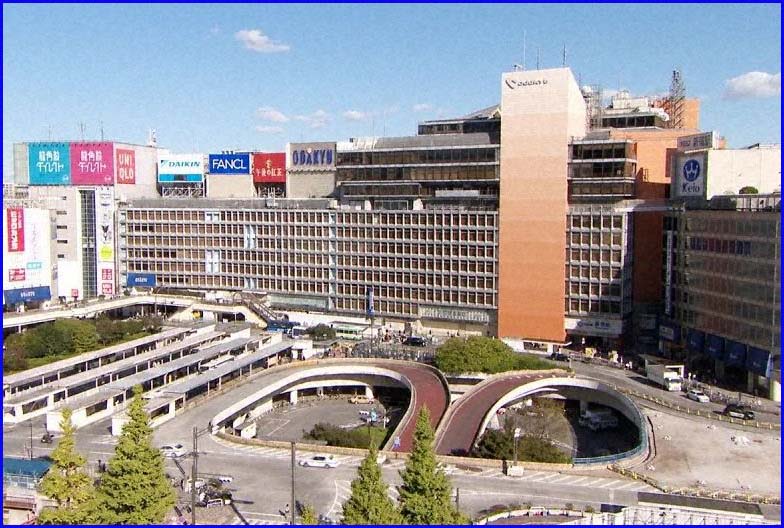
Shinjuku Station in Tokyo is a gigantic railway station where over three million passengers of JR, private railways and subways are crossing every day, and is recognized by the Guinness Book of World Records for having the largest number of passengers in the world. It is common that when there is big news, the screen of interviewing passers-by at Shinjuku Station appears on TV. It is also a station that has a deep connection with me.
I moved to Ichigaya, Shinjuku-ward of Tokyo, right after I got married, so I registered that place as my permanent address on my new family register. Nowadays, I can get a copy of my family register at a convenience store, but in the past, I had to go to the Shinjuku Ward Office, which is just a few minutes away from Shinjuku Station, to receive it. In retrospect, my relationship with Shinjuku Station dates back to when I was a child. Below, let's look back on the relationship with Shinjuku Station so far.
Until my first year of junior high school, I lived near Koenji Station on Chuo Line. My father, who was a military officer, was stationed in China, and my mother and four children always lived at home. At that time, our greatest pleasure was going to Shinjuku taken by my mother. Our usual course was to eat curry at Nakamuraya restaurant, watch a newsreel at Musashino movie theater, and then shop at Isetan department store. Nakamurayaya restaurant still has a menu from that time called Showa Curry. When I feel nostalgic for the old days, I go out to eat curry in Shinjuku. At that time, the east side of Shinjuku Station was a downtown area on par with Ginza.
Compared to the east side, the west side was deserted like a different
world. Beyond the current Keio Plaza Hotel was the vast Yodobashi Water
Purification Plant. Up to that point, the buildings were sparse, and the
rest was a field with large clay pipes scattered about. Just before the
War ended, when I was a first-year student at the Tokyo Military Junior
High School, I was stranded at Shinjuku Station due to an air raid and
spent the night in a clay pipe with my mother and older sister. Those memories
were introduced on this top page with the title "August 15, my memorial day".
I have lived in Seijo for 46 years. To commute to the University of Tokyo in Hongo, I first took Odakyu Line to Shinjuku, then changed to Chuo Line and went to Ochanomizu. However, in about two years, Chiyoda Subway Line opened, allowing direct access to Nezu via Yoyogi-Uehara. It became convenient, but the connection with Shinjuku Station was cut off.
After retiring from the University of Tokyo at the age of 60, I started working at Kogakuin University, a five-minute walk from the west exit of Shinjuku Station. For nearly 20 years, I continued to travel back and forth between Seijo and Shinjuku on Odakyu Line. Beyond the west exit of Shinjuku Station, a field that was once littered with clay pipes has transformed into a city of skyscrapers. Kogakuin University also changed from a three-story old school building to a 28-story skyscraper. From that building, I could observe Shinjuku Station right below.
I can't believe that Shinjuku Station when I was a child and the present one are the same station. The photo above shows the west exit of the station, which is integrated with Odakyu department store. On this side, skyscrapers are lined up, represented by Tokyo Metropolitan Government Building. Beyond the east exit on the other side is the most popular downtown area. The station has grown in size over the years. Recently, a big construction project has begun to renovate Odakyu department building to a skyscraper. From now on, Shinjuku Station will continue to change like a living creature.
"From Daily Life" -57: Hearing impairment
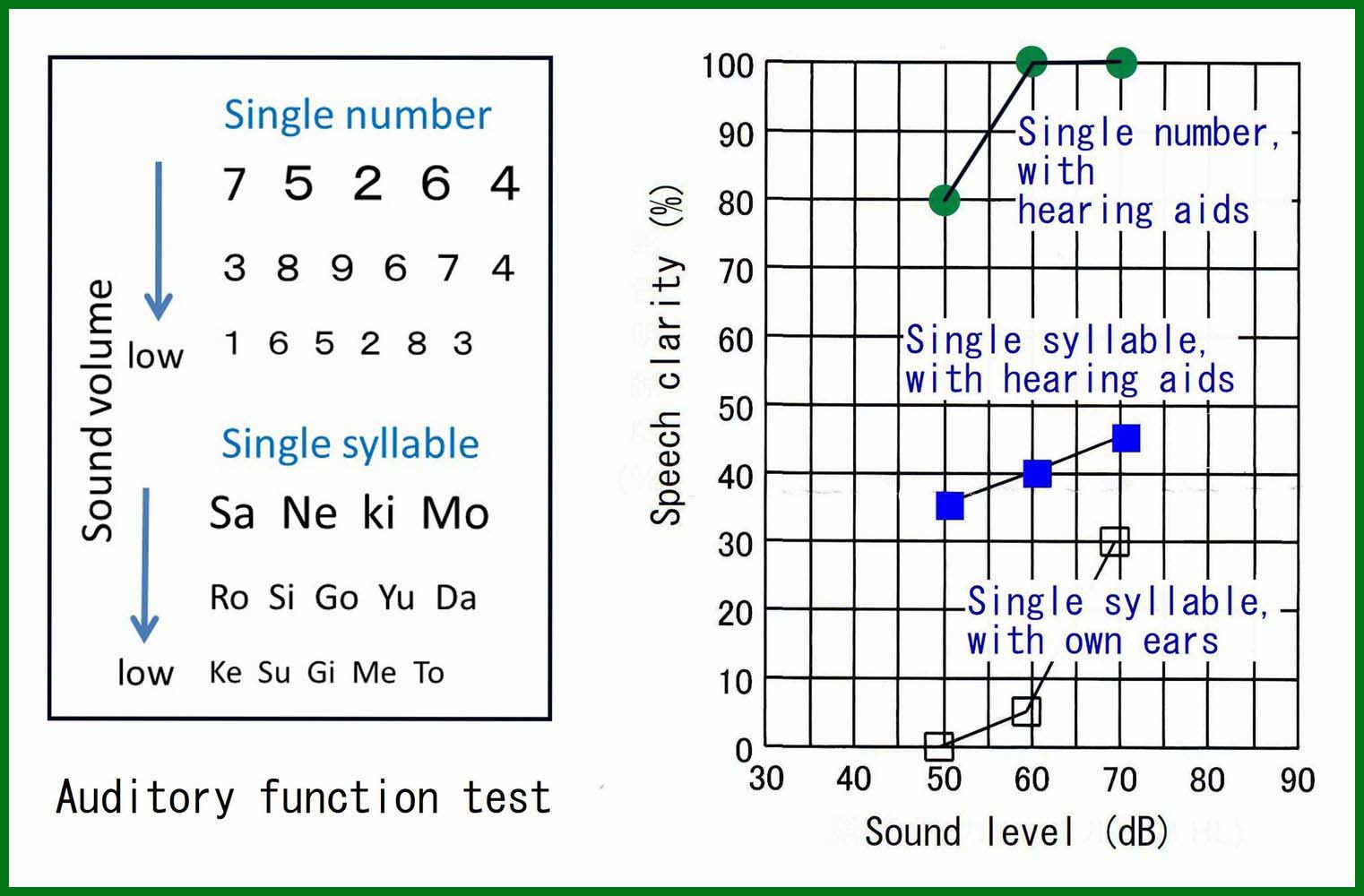
As age proceeds, our senses of vision, hearing, and smell decline. In
my case, my vision remains luckily almost unchanged, but my sense of smell
has decreased considerably, and my hearing has deteriorated most seriously.
When I turned 80, my hearing had started to decline so that the volume
of TV sounds became louder. In those days, when my children visited my
home, they used to turn the TV volume down first. It was around the age
of 86 when I consulted a nearby ear doctor and began wearing hearing aids.
For the next three years or so, I wore them only when I met someone else.
Otherwise, I avoided to wear because the noise around me was so amplified
that it bothered me. The details up to this point were reported three years
ago on this top page with the title “Hearing aid”.
After reaching the age of 90, full-fledged hearing impairment, that is, hearing sounds but not being able to understand them as words, began to progress. As a countermeasure, it is necessary to wear hearing aids except during sleeping to increase opportunities to hear sounds and understand them as words. I did that first. But the hearing loss continued. When I was 91 years old, I talked about my symptoms to the home doctor, and he wrote me a letter of introduction to the ear/nose/throat department of the nearby Jikei Medical University. So, I visited the hospital and finished the examination and diagnosis within a month. Let me introduce the results.
There were no abnormalities in the ear or eardrum itself. The sensitivity test for listening to a pure tone, beep-beep, showed the decline of usual ageing. The problem was an auditory function test that distinguishes words. This is a test in which I hear and write down a single number and single syllable (a, ki, so, etc.) while gradually decreasing the volume from sufficiently loud as shown in the figure above-left. The result will come out as a correct rate of the answer.
The results are shown in the figure above-right. The horizontal axis indicates the sound volume in decibels, and the vertical axis the speech clarity (correct rate) in %. Three lines in the figure indicates the results for three cases, that is, for single number with hearing aids, for single syllable with hearing aids, and for single syllable with own ears.
I was shocked when I saw the results. Since there are only limited kinds of single numbers, I was able to distinguish them 100% if the volume was sufficient. However, for single syllables, I got only 30% correct recognition with own ears and 45% with the fitted hearing aids. Until now, I have been guessing words while I may distinguish less than half of the spoken syllables. With this, it is not surprising that I miss catching many words during conversation and hearing.
It seems impossible to improve this symptom with treatment. The female doctor T who consulted me gave only one piece of advice. I should increase the chance of listening to the voice of announcers who speak clearly, and continue training to improve if possible, or at least to prevent further deterioration. My ears need training too as my muscles do!
If I search YouTube, I can find many story-telling videos that are mainly aimed at inducing sleep. They cover all the works of Kenji Miyazawa like "Gauche the Cellist", and many others. Recently, when I have free time, I search YouTube and listen to one of such stories. I hope it is not an illusion that I feel like my listening ability has improved a little bit.
It all started when I consulted my home doctor, and I'm glad I took action. Let's listen to a lot of stories as if I were a child again, and carefully protect my ageing hearing ability.
"From Daily Life" -56: Battlefield rations in the 6th year

From time to time, I've introduced on this top page what I'm cooking and
eating three meals a day. The first time was about a year after I started
living alone, and I introduced breakfast and dinner with the title of Battlefield rations. The second time, a year and a half after that, when I started to cut corners and followed a one-dish principle, I introduced two examples of dinner with the title of Battlefield rations in the sequel. The reason why I named my meals battlefield rations is that the meals may be prepared in as short a time as possible while considering only well-balanced supply of nutrition. As to lunch, it has been long my custom to have a light one such as coffee and biscuits.
I've been living alone for six years now, and cooking meals has completely become a part of my life. I don't think I've gotten any better at cooking. I only know two recipes: boil and stir-fry. From the beginning, I avoided Tempura and fried foods that use cooking oil. What has progressed is further cutting corners.
For dinner, the principle changed from one-dish to two-dish, and the first dish is limited to supply protein sources only. The ingredients are meat or fish with the weight of poultry 3, pork 2, beef 1, and fish 2. I choose one of them every day depending on my mood and bake or stir-fry with broccoli as garnish.
The second dish is dedicated to vegetables and prepared more systematically. I make a large pot of simmered vegetables, mainly root vegetables such as carrots, and store them in a large Tupperware container. Similarly, I stir-fry cabbage, bean sprouts, green peppers, mushrooms, etc. in a large frying pan and store in another container. These two stocks are always on standby and used after reheating by microwave.
Furthermore, I cut cucumbers, turnips, and eggplants, and put them in a container and add salt-malted rice to them. Finally, they turn to moderately salty pickles.
To prepare right amount of meals for a single person is almost impossible, mostly too much. The elderly like me don't want to leave food behind, resulting in eating too much. To prevent this, it is more rational to make a large amount at once and take out the required portion. Once made, it lasts for about a week. There are four servings of rice in one batch. If I utilize such stocked foods and instant soups, dinner will be ready in 15 minutes.
The photo above shows an example of a breakfast that never changes and an example of a more streamlined dinner. Even with this, I don't feel miserable and eat it up with a cup of wine. I feel that my relatively good health condition owes much to this diet. My meals deserve truly to be called battlefield rations. At year-end and mid-summer, some of my former students kindly send me foods that seem convenient for living alone. I use them occasionally to introduce a variety to my monotonous meals.
Cooking and shopping are inseparable. To avoid the situation where I find something missing while cooking, I have to be planning conscious while shopping. Cooking and shopping are now not only indispensable but also an enjoyable part of my life.
"From Daily Life" -55: Three years with COVID-19

Three years have passed since the spread of the coronavirus (COVID-19) began. We are just about to head towards the peak of the 8th wave, but let's follow the progress so far. The figure above is a plot of the number of infected people per day announced by the Ministry of Health, Labor and Welfare. The red line in the upper half is a real number display showing the number as it is, and the maximum is approaching 300,000. However, the peak of the first and second waves, which were still around 1,000 people, cannot be recognized.
The blue line in the lower half is plotted by taking the logarithm of the real number. Logarithmically, 10 is 1, 100 is 2, and so. Every 10 times it increases by 1 so that 5 corresponds to 100,000. Logarithms are effective in recognizing the relative change of magnitude. The number of reported infection cases hits the minimum on Monday and falls to less than half the maximum reported later in the week. This is probably due to the low number of reports on Sundays. For this reason, as in the case of 2022, when the infection spreads, the fluctuation range is large, and it looks like a thick red line. But if you look at this on a logarithmic scale, the amplitude is the same everywhere. The relative value of fluctuation is the same regardless the infection level is high or low. When viewed on a logarithmic scale, all small waves invisible in real numbers are clearly discernible.
The peak of the first wave in April 2020 was 644 people. Still, people reacted sensitively to the declaration of a state of emergency that was issued for the first time, and I have vivid memories of the urban streets where people completely disappeared. Basic measures such as wearing a mask and avoiding the three Cs (Closed space with no ventilation, Crowded place and Close contact) spread through this opportunity. In 2021, a state of emergency was declared three times before the opening of the Olympics 2020, but the memory of that is rather faint. The Olympics, which were held one year later without spectators, are vivid in our memory.
The number of infected people in 2022 has increased dramatically by an order of magnitude compared to the first two years. This is largely related to the fact that the main infection has been replaced by a new mutant strain, the Omicron strain. The Omicron strain is extremely infectious, and many breakthrough infections escaped vaccination. On the other hand, it is less toxic and less severe. It is getting close to a seasonal flu virus.
We are currently on the uphill slope to the peak of the 8th wave, but the rate of increase in infections is milder than that of the 7th wave. The fact that five rounds of vaccination were widely spread may also help strengthen the resistance as a whole. The goal for 2023 has changed from eradication of corona to symbiosis. As the second flu, it will be with us for a long time.
"From Daily Life" -54: Haiku; Metasequoia
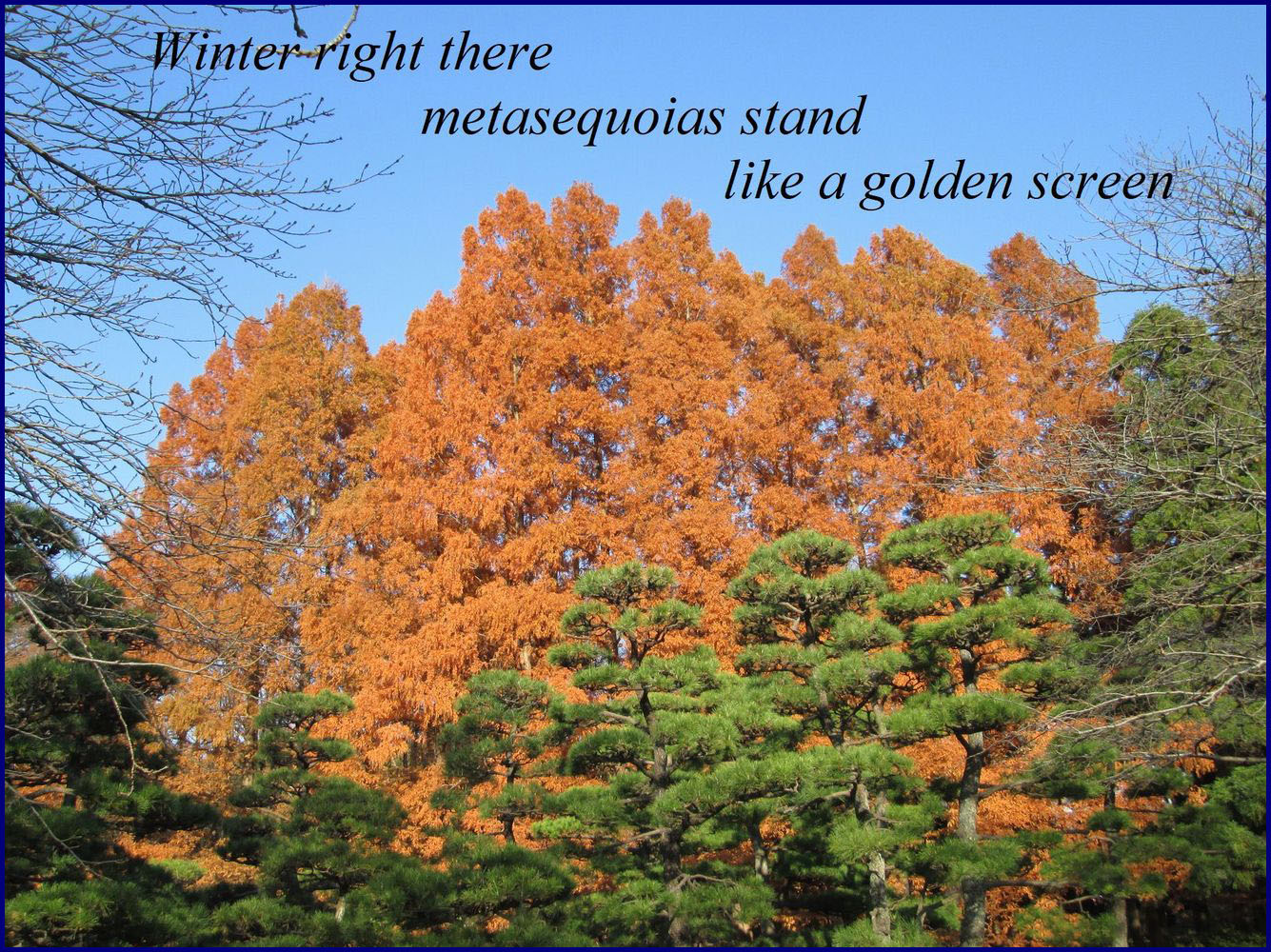
Haiku is a short poem unique to Japan. The poem consists of 3 lines, each containing 5, 7, and 5 syllables. It is also a rule that Haiku includes a phrase that implies one of four seasons; spring, summer, autumn, or winter. The feature of Haiku is to express an impressive scene with the least words of 17 syllables. Haiku has a long tradition and many famous works are engraved in the minds of the people. Since it is short, even a beginner can easily compose a work. Recently, I have been composing Haiku from time to time, so I would like to introduce one of them.
Haiku is originally written in Japanese. However, the movement to express it in English is spreading worldwide. The rule (three short lines with a seasonal phrase) is the same as in Japanese. Of course, I will introduce here the English version.
Jindai Botanical Park is my favorite destination, as already mentioned on this top page. Each season has its original beauty in Japan. To confirm this fact, I go first to a definite place every time I visit the park. That is the shoreside of a small pond, with giant metasequoia trees lined up in front. Trees with naked branches in winter, sprout in spring, leaves changing color from fresh to deep green in summer, yellowing as autumn deepens, eventually shining golden, and finally dropping reddish-brown leaves. That is surely a barometer for four seasons.
I am most fascinated when the metasequoias shine golden with a blue sky in background. The best timing continues only for several days at the end of November. Please imagine the view from the photo above. It's good to look up close, and also good to look from afar. The sight of the golden screen towering to the autumn sky is impressive. Here's the Haiku that came up:
“Winter right there
metasequoias stand
like a golden screen”
I am just a Haiku beginner and know the above work would receive many suggestions to improve if I have a teacher. However, I dare to introduce it for showing my starting point when I only thought to express my impression as it was.
As the topics on this top page, I wish to take up Haiku occasionally, hopefully showing the readers my progress in Haiku.
"From Daily Life" -53: Shirakaba Art Meseum of Kiyobaru
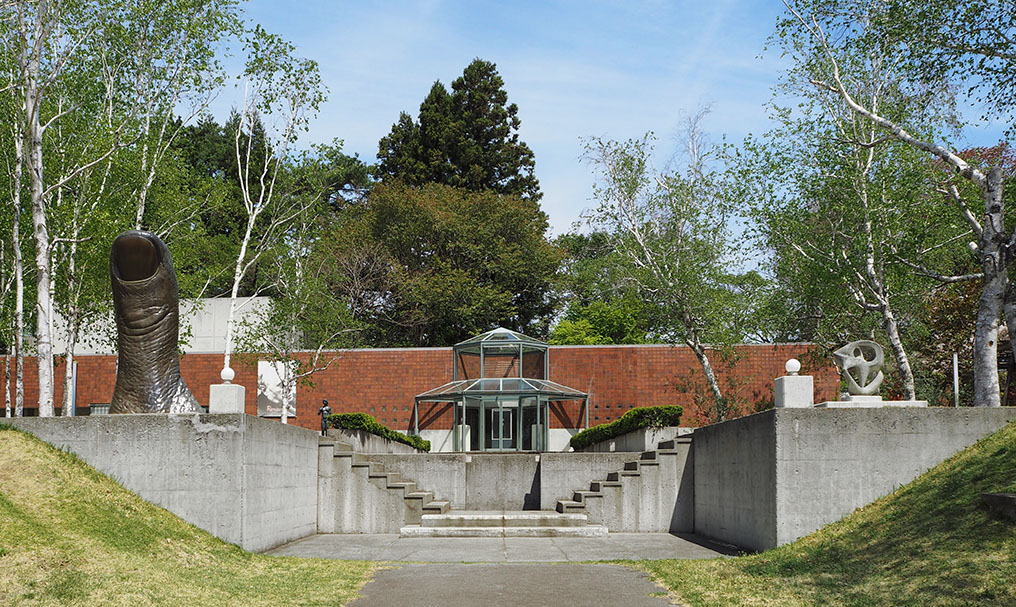
Shirakaba Art Museum of Kiyoharu is located in the northwestern part of Yamanashi Prefecture, on a plateau looking up Mt. Eight-peaks to the north and Mt. Kai-koma to the south. The museum is indeed surrounded by white birch (shirakaba in Japanese) groves as shown in the photo above, but its name comes from Shirakaba-school, an art group in the Meiji period. The school, represented by leading writers such as S. Mushanokoji and N. Shiga, had been wishing to establish its own art museum, but the dream had never come true. Mr Ryozo Yoshii, the owner of Yoshii Gallery and an enthusiastic Shirakaba-school admirer, has made this dream a reality by pouring his passion and fund.
Utilizing the site of the abandoned Kiyoharu Elementary School, Mr Yoshii proceeded with the construction of an art museum, library, atelier, etc. on the site, naming the entire zone Kiyoharu Art Colony and turning it into a base camp for artistic activities. The art museum opened in 1983 and has been maturing for 40 years. The large lawn that used to be the school ground is surrounded by giant cherry trees, and the cherry festival held in mid-April attracts many visitors, including locals.
My late wife Motoko’s father, Kikuo Kojima, was a member of Shirakaba-school, and her brother-in-law, Fukumatsu Miwa, served as the director of the museum. So, we have had frequent opportunities to visit there since its opening.
Kikuo was a professor who taught western art history at the University of Tokyo, but was also a professional painter. His solo exhibition was once held here. When he studied abroad, he copied a part of "St. Anne and the Virgin and Child" by Leonardo da Vinci, attending the Louvre Museum for a year.
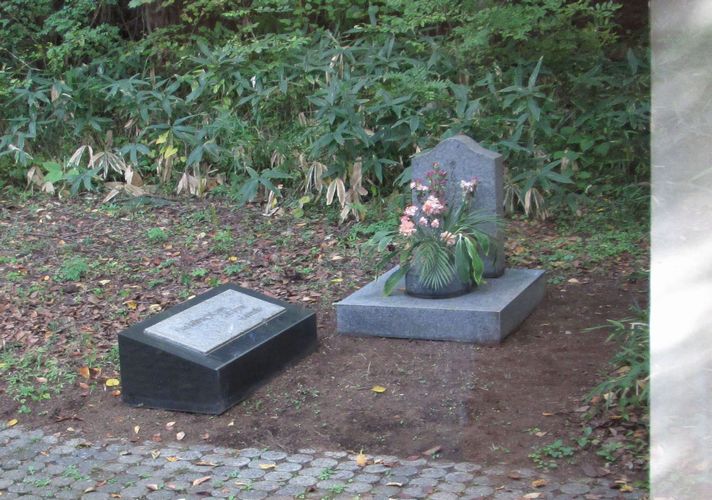 The copy painting is now on permanent display in one room of the museum.
If we stand in front of the painting and look outside, we can see the courtyard
through the large glass, and find in one corner the tombstone of Motoko’s
parents and a stone monument engraved with the words of da Vinci. See the
photo on right. The words in Italian mean "A mortal thing is transient,
but not if it is a work of art.
The copy painting is now on permanent display in one room of the museum.
If we stand in front of the painting and look outside, we can see the courtyard
through the large glass, and find in one corner the tombstone of Motoko’s
parents and a stone monument engraved with the words of da Vinci. See the
photo on right. The words in Italian mean "A mortal thing is transient,
but not if it is a work of art.
The tombstone and the stone monument were designed by Yoshiro Taniguchi,
an architect and recipient of the Order of Cultural Merit. Two blocks of
stone, which were destined to be disposed of after the original grave in Tokyo was closed, do exist here as art. I couldn't be happier with the ending.
The fact is just as da Vinci's epitaph declares.
In addition to the art museum and the library, Kiyoharu Art Colony has many attractions such as a collective atelier called La Rouche, Rouault's Chapel, Ryuzaburo
Umehara's atelier, Museum of the Light, and tree-top tea room. Together
with the surrounding nature, I would like to recommend it as a place to
put yourself in the essence of beauty for a moment.
"From Daily Life" -52: Metropolitan Kinuta Park
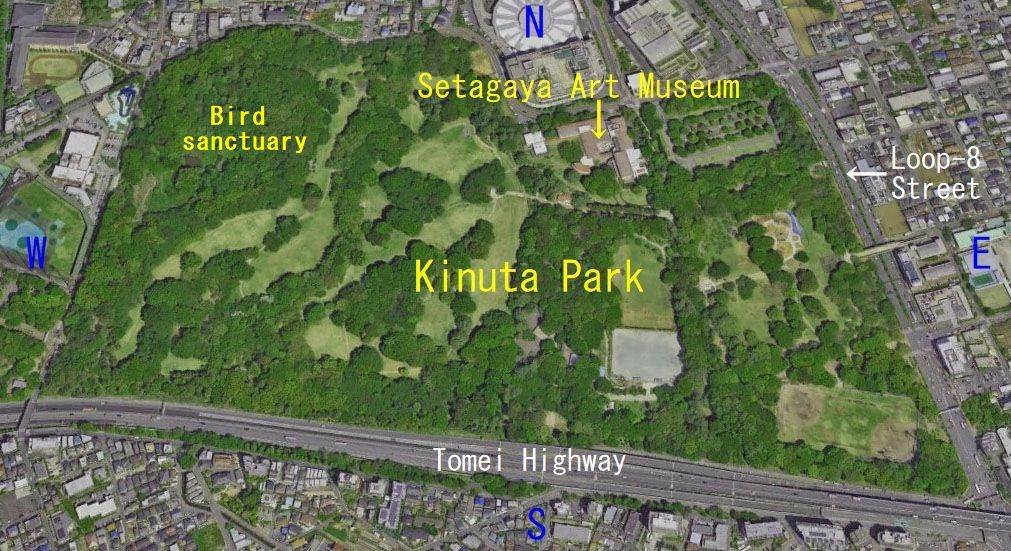
When I want to take a walk in the green, I often go to Kinuta Park, which is about 15 minutes away by car. As you can see in the photo above, it is located adjacent to Loop-8 Street eastward and to Tomei Expressway southward. On the ground of 0.4 square kilometers (900m east-west, 450m north-south), dense forests surround the scattered facilities and lawns. Children's playgrounds and sports grounds are gathering in the eastern area, and the Setagaya Art Museum is located near the center of the northern border. We can walk along the trails in the woods or rest on the lawn. There is also a cycling road that goes around the periphery of the park. This is a paradise for joggers and cyclists.
The most beautiful season of the year would be early spring when the cherry blossoms are in full bloom. We won't notice cherry trees when they turn green, but there are many giant cherry trees surrounding the lawn. We may walk through many pink tunnels in the high season.
On holidays, the park is quite lively with families, and many groups are occupying their seats here and there on the lawn. On weekdays, regular walkers, joggers, and cyclists; visitors to the museum, and parents who let small children play come there. Since the park is large enough, the population is rather scarce. I visit only on weekdays.
When I visit the park, I decide the plan for the day after parking in the attached parking lot. Whenever the exhibition at Setagaya Art Museum renews, I prefer appreciation of arts to walking. After viewing the exhibition, I take a break at the Setabi Cafe in the basement of the museum and enjoy the afterglow of arts with cake and coffee. After that, I walked through the woods for about 30 minutes before heading home.
On days when I don't visit the museum, I start walking for about an hour and a half around the park. There are many spots to drop in for watching birds in the sanctuary, looking flower beds, etc. along the way, and they give variations to the walking from time to time. Feeling pleasantly tired, I head home.
The park is well-maintained and has clean restrooms scattered about. Living in the middle of an urban area, I am very blessed to have a place nearby where I can immediately blend in with nature. Along with Jindai Botanical Park and Fuchu Forest Park already introduced on this top page, it is my favorite destination for
a mini-hiking.
"From Daily Life" -51: Knee of the elderly
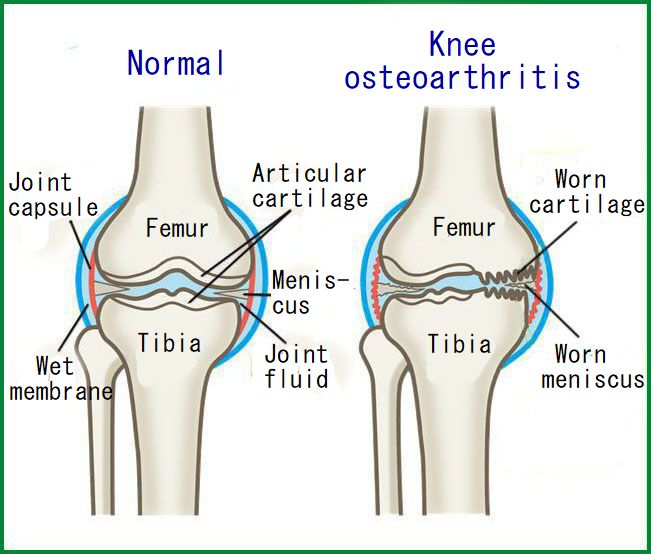
As for the prescription, first, the injection needle was inserted through the joint capsule, and the joint fluid was extracted by about half of the medium-size syringe. It pained almost intolerably!
Next, hyaluronic acid was injected into the knee, and the knee was massaged with electrical pulses for 15 minutes. I felt relieved just by draining the liquid from the knee. From then on, I received a hyaluronic acid injection and electric massage once a week. Dr. S declared that the standard treatment would be over after repeating the treatment four times in a row.
My pain in the knee was especially severe when I stood upright after not moving for a while, and the pain associated with walking was rather little. As the days went on, the pain gradually faded away, and by the end of the standard treatment, it became almost unnoticeable. Luckily past painful days are completely over!
Advertisement of supplements for knee, lower back and shoulder pain is flooding TV and newspapers every day. That is proof that many elderly people are suffering from joint pain. When I asked Dr. S about the medical effect of these supplements, he replied “Although I don’t tell you to stop using it, I would not recommend it”. Around the time my pain started, my daughter-in-law M suggested taking MSM (methyl sulfonyl methane, a cartilage material) based on her own experience. So, I ordered it and started taking it every day. My pain is gone for good, but I can't prove that MSM actually worked. Let's continue for a while thinking that it's a charm.
I'm grateful that no matter where I move my body, I don't feel any pain. I can realize the blessing of having no pain only after experiencing the suffering by myself.
"From Daily Life" -50: Such a life
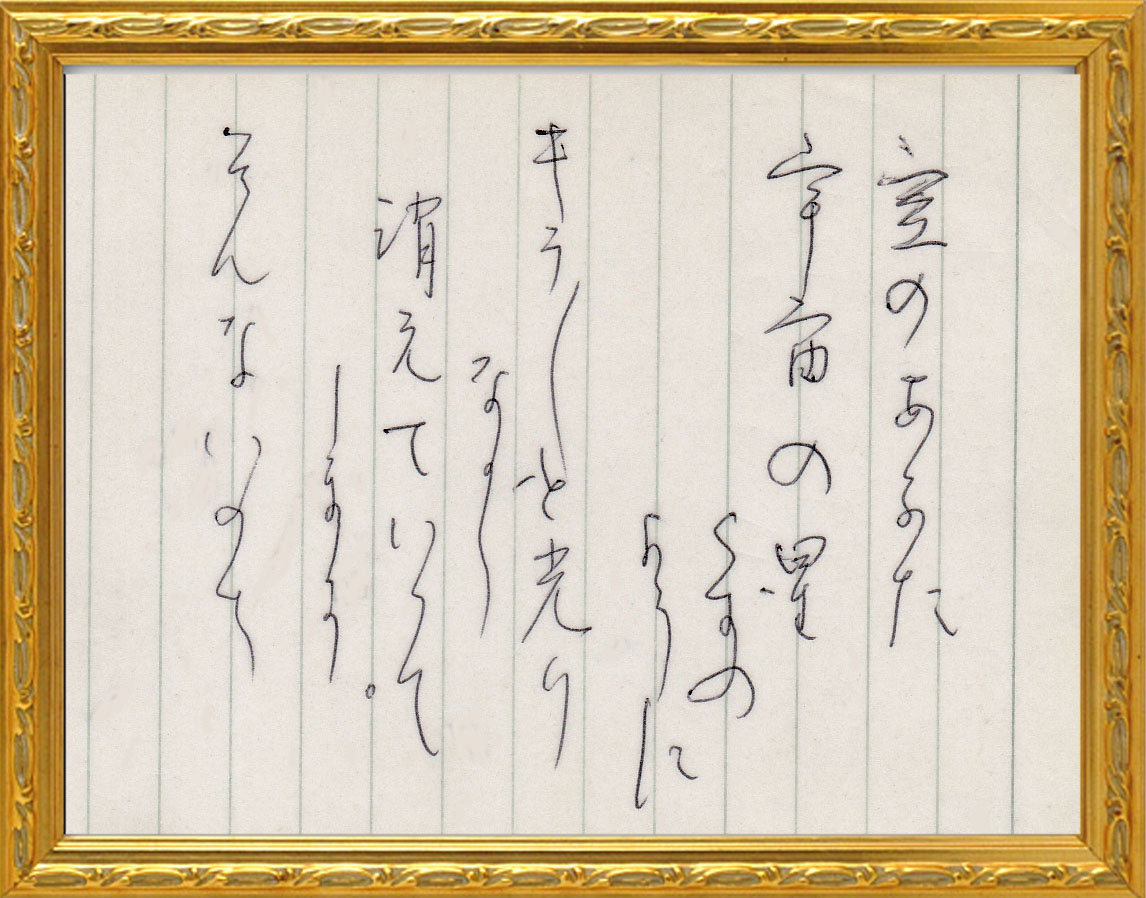
My eldest sister, who was like a lump of energy until the age of 98, passed away in a flush and impressed on me how fragile life is. At the same time, I remembered a short phrase like a moan that my late wife Motoko wrote down and left in a corner of her notebook. In the year of 2008, Motoko lost her younger sister, elder brother, and sister successively and sank to the bottom of the loneliness of being left alone. She probably wrote the phrase at that time.
I copied the phrase from her notebook and put it in a picture frame as shown on the top.
The phrase is hand-written in Japanese characters and means as follows.
"Far in the sky
a stardust from the universe disappears
after sparking as a bright line.
Such a life"
At a point in this vast universe, life is allowed to exist for a moment in the endless flow of time. Everyone disappears, leaving only a trace of existence like stardust. Motoko disappeared in the same way and I would be the same sooner or later.
Neither Motoko nor I am religious. Death is a complete extinction. All that remains is in the memory of a living person. A fleeting but rare life. Such a life is precious and irreplaceable.
Now, look at the world! Every day we see news that many victims are killed by wars and crimes before the flames of their life burn out naturally. The first target of human society should be to eradicate death by evil will.
"From Daily Life" -49: Home altar
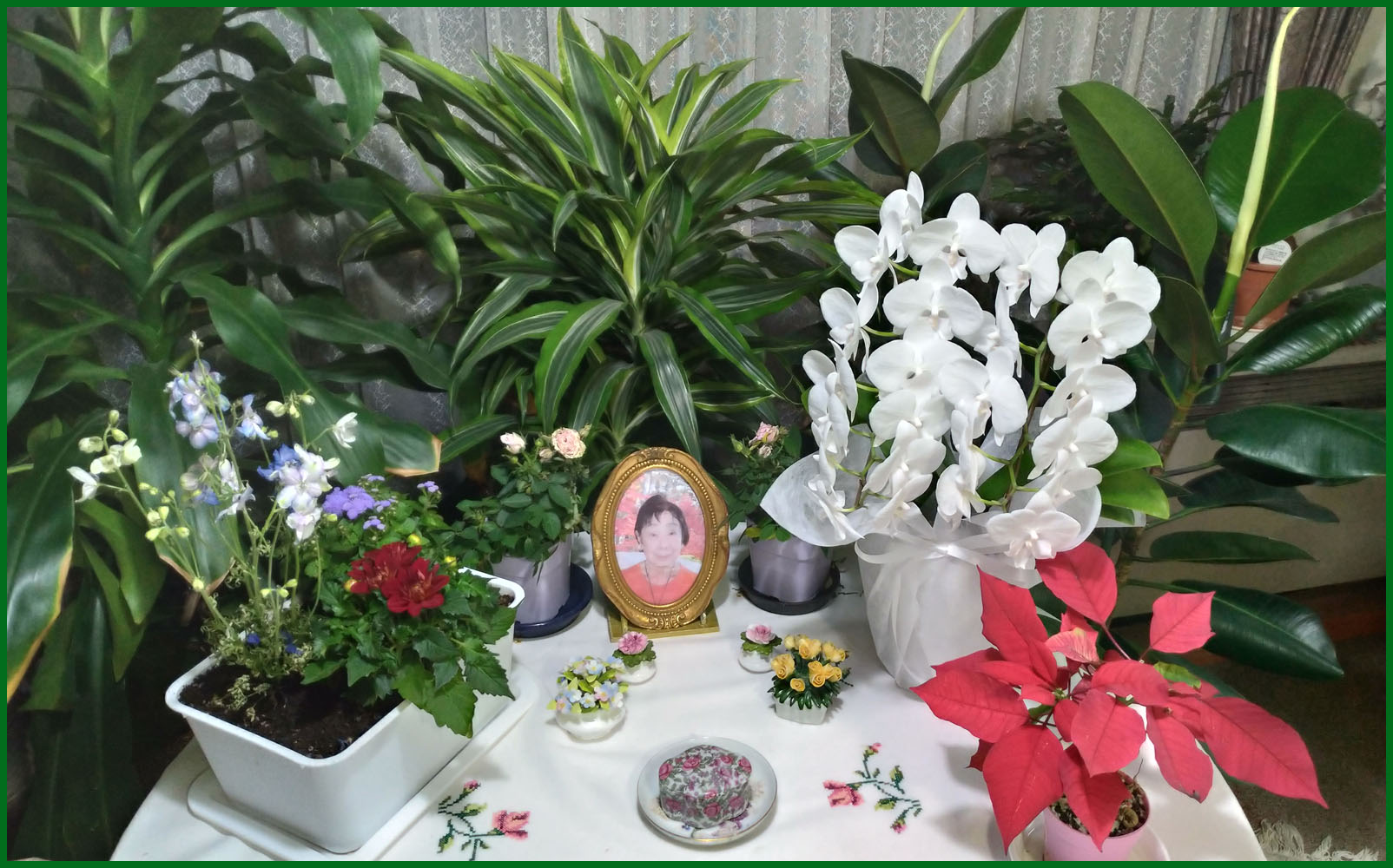
It has been a custom to have a Buddhist altar in traditional Japanese houses. Large houses used to have a special room for an altar, and even in a small house, there found an altar somewhere. Apart from that, it was not uncommon to see a small Shinto altar on lintels of rooms.
Because I have had little religious mind and lived in a western-style condominium since I got married, I have had no Buddhist altar at home. Tens of years ago, my wife Motoko started to use one level of the bookshelf for albums as a memorial corner, where the portraits of her and my deceased parents were lined up, along with many memorable items in the front. Now, the portrait of Motoko is added there. It looks completely different from a Buddhist altar, but it is certainly a place to remember the deceased parents.
Apart from this place, there is another place that should be called the altar of my home. Several weeks after the funeral of Motoko 5 years ago, her cinerary urn was kept home till it was moved to her grave. At that time, the urn was laid on a round table near the south-facing window of the sunny guest room. I arranged the table so that the urn and portrait were surrounded by flowers and foliage plants. It was a Motoko’s favorite place to enjoy viewing Mt. Fuji from the outside of the window. After the urn was moved to the grave, her portrait remained on the round table, and the custom of decorating the surroundings with flowers of the season continued till today.
The photo above shows an example. In this case, the white orchid presented by former student S is the main, along with the mini roses of May and seasonal flowers. Poinsettia, which decorated Christmas season, is still working well, so I put it near the white orchid to give a clear contrast of red and white.
Even if I visit Motoko’s grave, the place only feels like storage of the remains. The round table at home makes me feel the late wife more closely. The place is just right to call a home altar. It will last as long as I stay alive.
"From Daily Life" -48: How-to books for the elderly
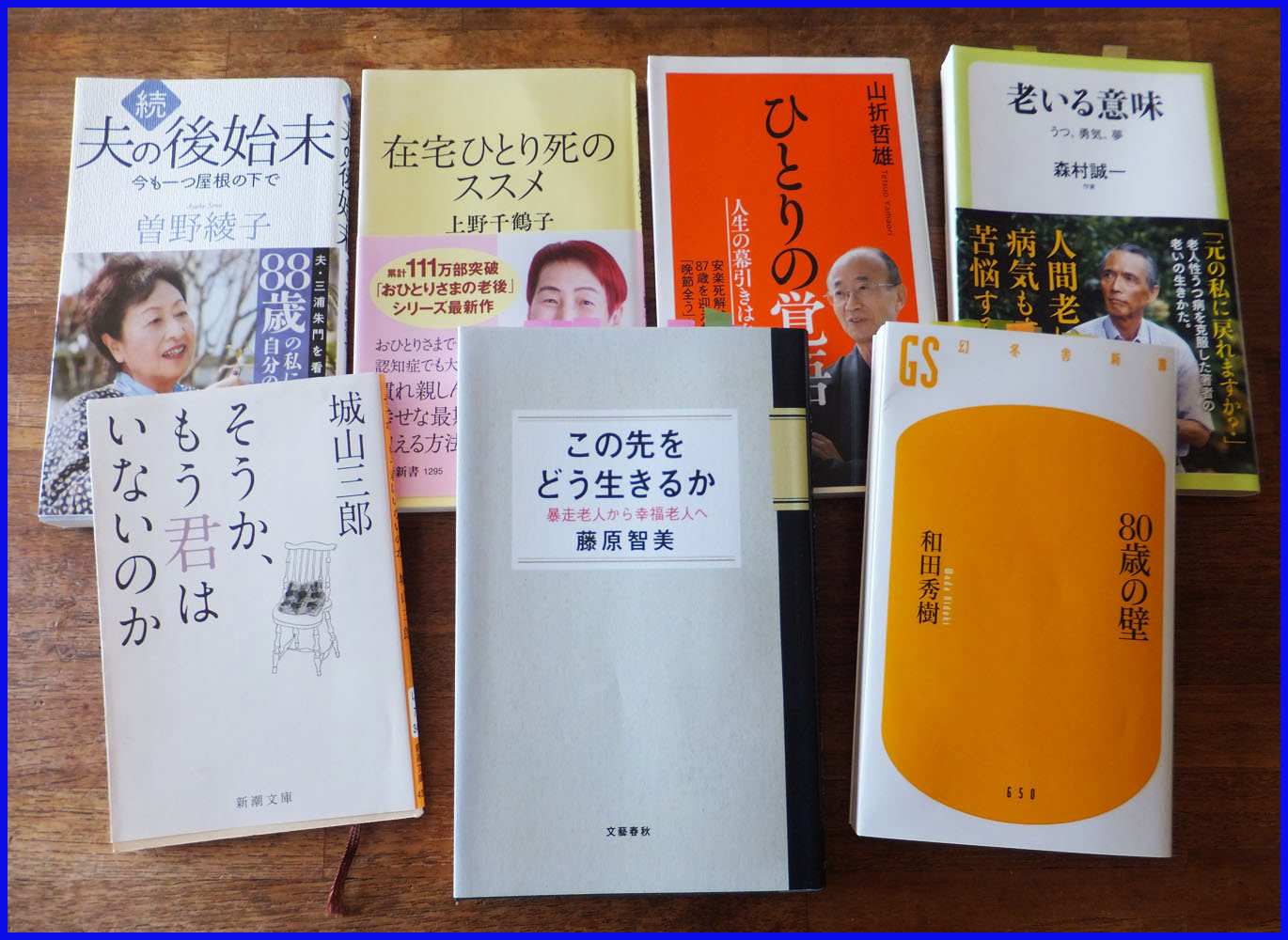
One day after another I live on while climbing the stairs of ageing step by step. Especially because I live in the loneliness of having no one to talk to, I have to decide for myself how to spend the coming 24 hours every day. Physical health is the first premise for continuing to live independently. Fortunately, I am quite blessed in this regard. But mental health is also significant. To maintain the motivation to live on, the mind must be also healthy.
Just as there are undulations in the physical condition, there are also in the mental condition. When the mind is depressed and trapped in a feeling of helplessness, the desire to learn from the wisdom of our predecessors becomes stronger. Therefore, "how-to books for the elderly” are indispensable.
When I stop by a bookstore, I find quite a variety of how-to books for the elderly among the books piled up in the store. The baby boomer generation is joining the ranks of the elderly, and their needs are surely increasing.
It can be said that 80% of the authors of such books are prominent novelists. Ayako Sono, Hiroyuki Itsuki, Shizuka Ijuin, Saburo Shiroyama, Seiichi Morimura, etc. are the representatives. They convey various know-how and wise sayings for the elderly while describing the days of ageing life like a collection of essays. Perhaps because of the good reputation for such books, each novelist has published nearly 10 books in a series.
I read some of them, but they didn't quite fit me. All of them were written by professional writers who are always busy finishing manuscripts on time. Their target of interest is rather out of mine mainly because I have abundant time without being chased by anything.
There are many works by other authors who belong to the category of critics. I read books in his category such as "Determination to be alone (Tetsuo Yamaori)", "Recommendation for dying alone at home (Chizuko Ueno)", "How to live years to come (Tomomi Fujiwara)", and "The wall of 80 years old (Hideki Wada)".
After reading a dozen of books, it became clearer what kind of words I was looking for. Throughout my long career, I have found value and joy in achieving the given object (target of a challenge) most efficiently. I have been completely imbued with a sense of object-rationality. After my full retirement, however, the given object becomes none unless I make it myself. Besides, I have no one who relies on me. The sense of object-rationality has lost its place and I had to ridicule my life as useless. Under such circumstances, I wanted to know how to keep my positive motivation in daily life.
As I read these books one after another, the answer gradually became solid. The object is merely a landmark. The way to get there is the substance of the deed and the source of value and joy.
I finally realized that the process leading up to the end is more important than the object itself. For me, who ends up with death, every day until then is an entity of being alive. With this attitude, even if I go for a walk, the current one step is more important than reaching the destination. When I walk with that in mind, I find discoveries that I haven't noticed before.
Since I started thinking like this, my mood has become much easier. The most influential book to my mind reform was Tomomi Fujiwara's "How to live years to come ". Even if I feel depressed occasionally, reading this book again will restore my mind as medicine. Elderly people are recommended to select a book from "how-to books for the elderly" that heals each one most effectively.
"From Daily Life" -47: Walking group of local community

About three years ago I joined a community club called SSCC (Seijo Second
Community Club), a gathering of senior men living in Seijo. I reported
once my activity in this club on this top page (Bonds with local community).
For the past two years or so, the chance of gathering has decreased dramatically responding to the countermeasures against COVID-19. There are four groups in the club for walking, driving, cooking, and gardening. I participate in all groups except gardening.
Among these groups, only walking group has continued its activity on a regular basis except for the period when government regulation such as declaration of emergency or special alert to infection has been issued.
On the 3rd Wednesday of every month, the participants gather at Seijo Station at 10 o'clock and start walking mainly inside the town for about 2 hours. Occasionally, we walk to destinations out of town such as Jindai Temple, Gohtoku Temple, Kinuta Park, etc. In such cases, we use public transportation on the way back home.
Around 10 members participate each time. The leader S and a few women who support seniors are standing members, and the rest is free participation. The eldest participant is 94 years old, but he never walked behind the group. All participants still keep decent physical fitness to enjoy walking. Those who have lived in Seijo for a long time are a kind of teacher of local history and we learn a lot from them. My participation in the walking is about once every two.
At the end of March every year, when the cherry trees are in full bloom, an extra event is added to walk up the shore along the Nogawa River to Jindai Temple. I participated this year again. There are promenades on both banks of the river, so we can walk comfortably without worrying about traffic. As shown in the photo above, half of the way is lined with cherry trees and it is rather rare to see no cherry blossoms in the sight during the high season. After walking upstream about two hours, we leave the river and walk a while to Jindai Temple. After praying for the world peace, we all enjoy lunch of the famous Jindaiji soba noodles. It's an annual event that we won't get tired of even if we repeat it.
Being able to walk is a premise to continue independent life while aging proceeds. I would like to participate in this activity as much as possible and keep joining the group of lively seniors.
"From Daily Life" -46: Grave closing
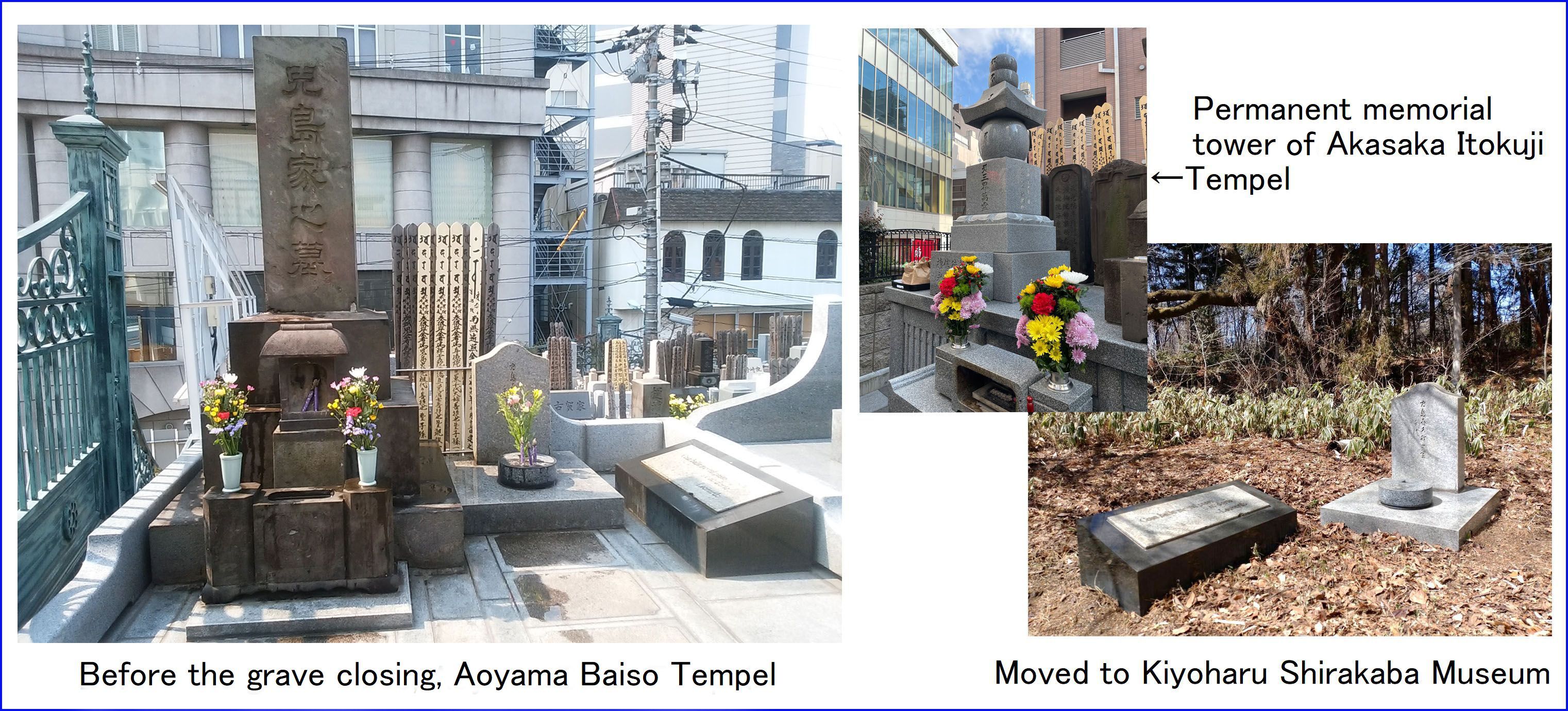
The parents’ family of my late wife Motoko, Kojima family, has lost its male descendants, and there remains no one to maintain the family grave. The graveyard is located in Aoyama Baiso Tempel, a prime location in the center of Tokyo, and its annual maintenance fee is about 80,000 yen. Therefore, my eldest son A has undertaken the responsibility of the maintenance on behalf of the Kojima family, and collected necessary funds from the relatives, mostly grandchildren. Recently A judged that it would be impossible to continue for a long time as it is, and decided to close the grave with the agreement of the relatives concerned.
In the graveyard, as shown on the left in the photo above, in addition
to a tall ancestral tomb, a tombstone of Mr and Mrs Kikuo Kojima (center,
Motoko's parents) and a stone monument with the words of Leonardo da Vinci
(right) are placed. Kikuo was a member of the Shirakaba-group and worked
as a professor of western art history at the University of Tokyo. The tombstone
and monument were designed by his friend, architect Yoshiro Taniguchi.
The stone monument is engraved with the Italian words meaning "Beautiful
things will perish, but not in the case of art." The place was once
included in the grave tour in Tokyo.
Closing the grave is more laborious and expensive than expected. There are tasks such as official reburial procedures, arranging the bones for reburial, switching to a permanent memorial service, and returning the graveyard to a vacant lot, so there is no choice but to ask a trader who is specified in this business. The total cost was about 1.3 million Yen. We decided to share this cost with the relatives concerned.
All the bones were carried to Akasaka Itokuji Temple and placed in the permanent memorial tower (center photo above). We paid all the donations for the eternal memorial service, so we may visit the place whenever we wish. Along with the reburial, all the tombstones were crushed and discarded, and the graveyard became a vacant lot.
Fortunately, the Kiyoharu Shirakaba Museum kindly accepted the tombstone of the Kikuo couple and the stone monument of Leonardo, and relocated them in the premises. Yoshiro Taniguchi's son, Yoshio Taniguchi is also an architect and designed the Shirakaba Museum. "St. Anne and the Virgin and Child (part)" copied by Kikuo is exhibited in one of the exhibition rooms. The Museum placed the tombstone and the stone monument in the open air, which can be seen through the window (right photo above). Such an ideal solution can be materialized only by the multiple human bonds in the past.
We could finish the grave closing this time quite satisfactorily. A has organized the total process perfectly. The gratitude of the grandchildren to their grandmother has turned into a big power that pushed everything forward and made this possible.
"From Daily Life" -45: Fuchu Forest Park
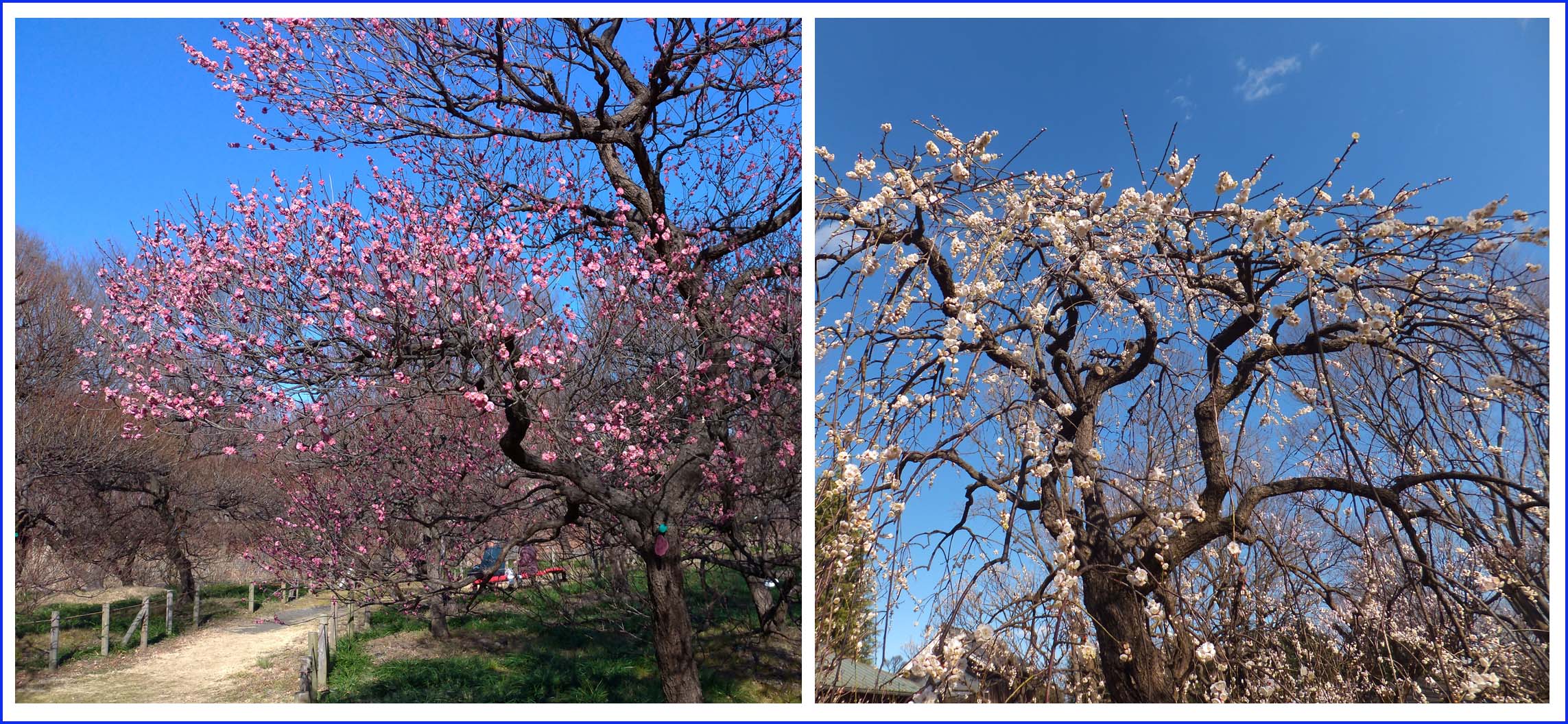
After I stay home alone and repeat daily routine with little change for
a while, I feel a strong temptation to go out and refresh my mind and body.
The destination in such cases, I call it my favorite spot, must meet such
requisites that moderate combination of walking and driving, little boredom
after repeated visits, and location within 30 minutes drive. So far I have
three favorite spots, that is, Jindai Botanical Park, Fuchu Forest Park,
and Kinuta Park. The first one was already introduced on this top page, and the second one comes hereafter.
The city of Fuchu has vast recreation zone spreading along the Tama River. In about a half of the zone, there spread various facilities for baseball, football, tennis, swimming, etc. for citizens. The rest is called Forest Park that requests 300 Yen for the admission.
In the Park, there are the main building with a local history museum and a planetarium, and the preservation area where historic buildings such as farmhouse, post office, elementary school, etc. are scattered in a zelkova forest. The rest of the Park is a plum grove as far as the eye can reach. There is a water mill running beside a stream crossing the Park. The nature and life of Musashino (local name of the area) are richly preserved there.
It takes about 30 minutes by car from my house, but most of the roads are along the bank of the Tama River, so I can reach there while enjoying the views. There is a large free parking lot for visitors, an attractive benefit for me.
There are seasonal flowers such as hydrangea and cluster amaryllis and they attract visitors all year round, but the plum trees that begin blooming before spring are the main characters. In late January, the yellow Japanese allspice comes out in full bloom, and it brilliantly implies the arrival of spring in the harsh cold air.
Early-blooming plum trees start blooming in early February and mid-blooming trees follow throughout February. Late-blooming trees close the season around mid-March as the final player. There are various types of plums such as red, white, single, double, and dripping. In the above, pictures of red and white plums blooming in the Park are shown.
When I get tired of walking in the plum grove, my routine is to take a rest at the café terrace in the grove and to eat skewer dumplings. When I feel fun, I get green tee service in a traditional Japanese tee-house built in the preservation area.
Occasionally, I enjoy looking starry sky at the planetarium. In the past, the planetarium was a place to hear explanations for constellations, but it turned recently to a theater that shows a mini-drama with stars as the main characters. The target of customers has surely shifted from adults to young boys and girls.
Not only in early spring, but whenever I visit Forest Park, I feel healed and refreshed. I am happy to have such a favorite spot!
"From Daily Life" -44: Implant
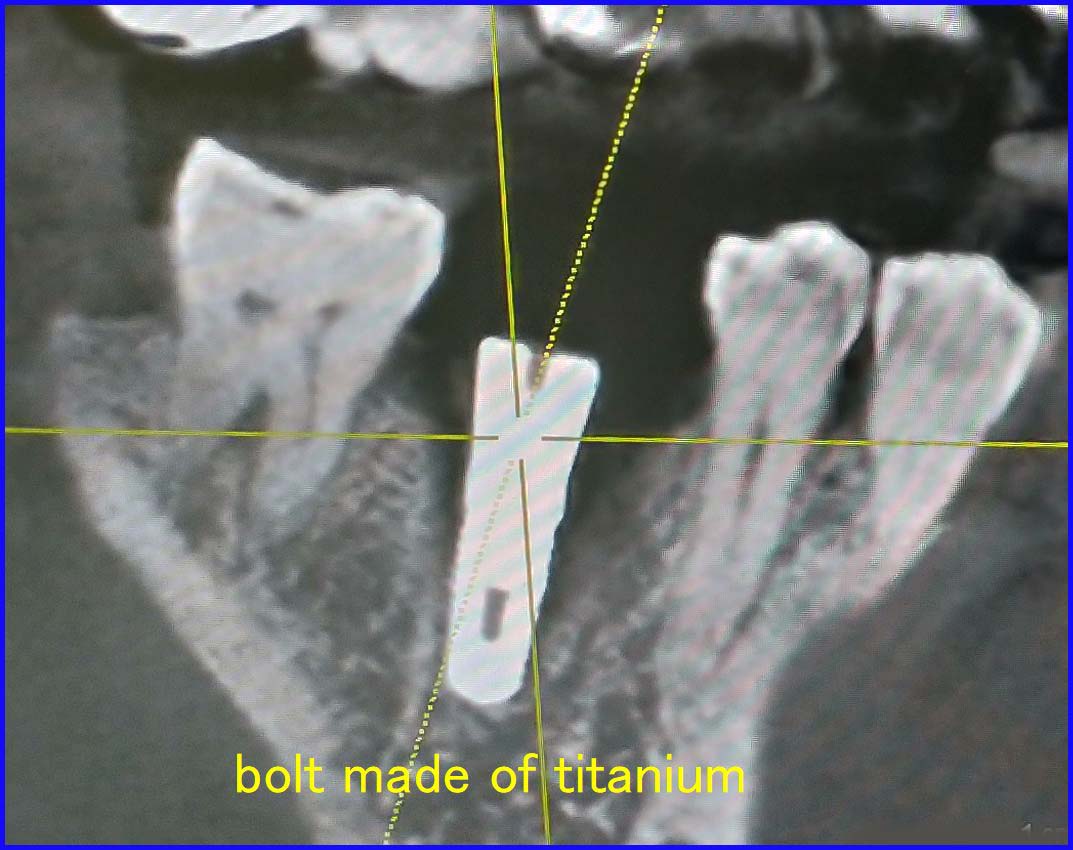
It was January last year when the root of the second molar from the lower right end was found to be cracked, and one year has passed since then. Before extracting the tooth and replacing it with an implant, the dentist asked my family doctor M whether there was any problem with the surgery. Then M decided that the first thing to do was to check the chest discomfort I occasionally felt and recommended me a close examination of the heart.
As a result of the examination at Kanto Central Hospital, stenosis was
found in my coronary artery. So I was hospitalized in March and underwent
surgery to insert stents in two places. This story was already reported on this top page. After the treatment, the discomfort in my chest disappeared completely,
and I am grateful for the luck that was initiated as a by-product of my
tooth trouble.
The cracked tooth was extracted in August. After I waited till my jawbone had been regenerated, I got the operation to implant a small bolt made of titanium in November. The X-ray photograph immediately after the operation is shown in the above. The position and angle at which the bolt is to be implanted should be carefully designed in advance, and the hole should be drilled accurately using a jig, so that the bolt is firmly screwed into the planned position. The other day about two months after the operation, the adhesion between the bolt and the jawbone was checked and proved to be in order. I have to wait another one or two months till a ceramic tooth is fitted to the top of the bolt and a fully artificial tooth becomes complete.
Implant, if successful, makes it possible to obtain the sense of biting that is as natural as of the sound own teeth. Such natural sense may be difficult to obtain by dentures. Even with a metallic tooth roots, there is a risk of periodontal disease if brushing is not properly done. Implanted tooth needs to be brushed like a natural one.
I put the implant in one upper right molar and then two lower left molars,
so this is my fourth one. If I have sound teeth, eating is always fun.
It's one of the requirements to stay healthy. Implant is not covered by
insurance, and it costs hundreds of thousands of Yen for one case. I dare
bear the cost because keeping the joy of eating seems more precious.
"From Daily Life" -43: New Year's greeting card
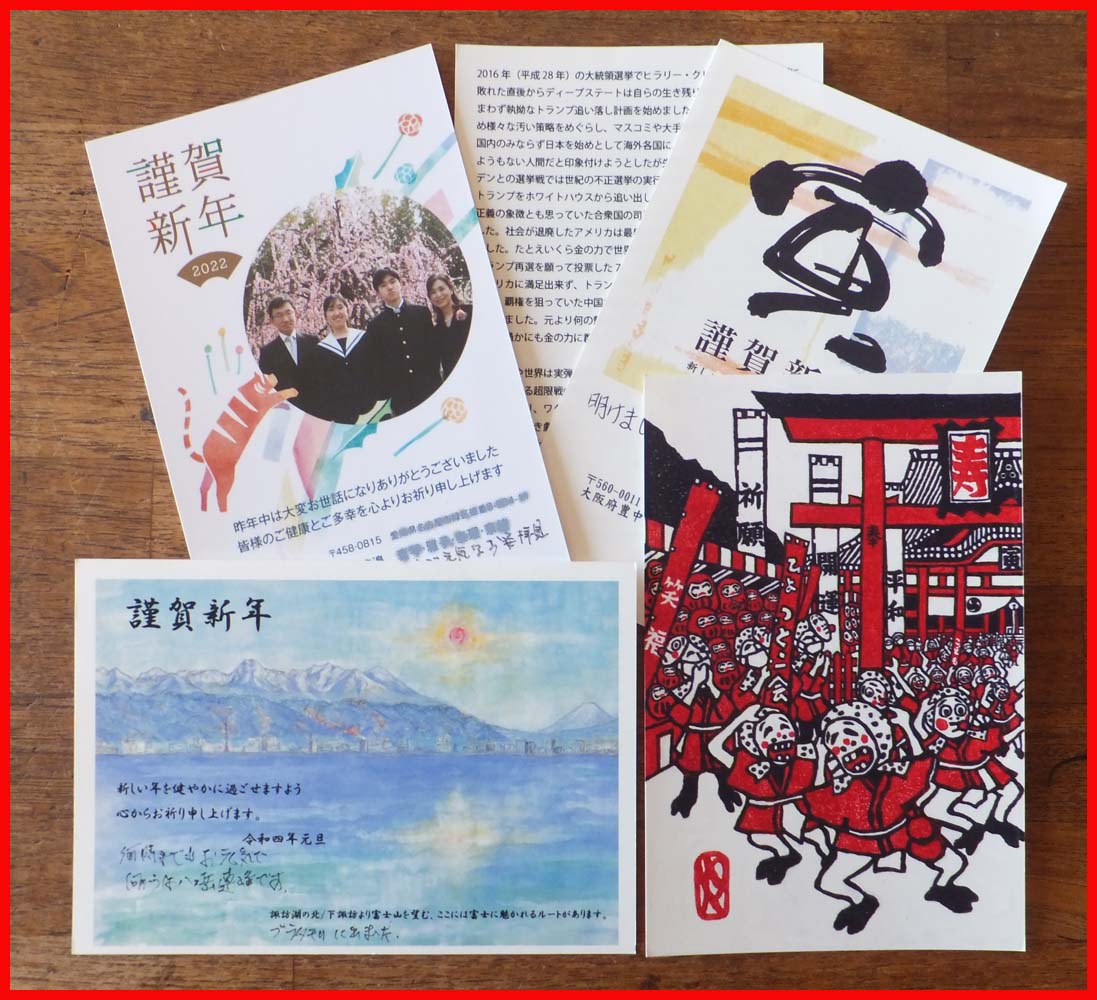
Speaking of the big job during the year-end and New Year holidays, it is probably the exchange of New Year's greeting cards. As for the cards, I use only New Year’s postcards with gifts by lottery bought at the post office. In my case, the number of necessary cards started to increase with age. The number peaked in my late sixties and reached about 800 when I worked as the president of Kogakuin University along with a lot of extra activities outside. After that, it began to decrease gradually, and by the time I retired from the full-time job at the age of 80, it had nearly halved. Now I’m 90. I bought about 250 cards this time.
There are two cases of greeting exchange, one that I post cards before the year-end so that they arrive just on the New Year's Day, and the other that I receive cards after New Year's Day and send replies. This year, I sent about 60 cards before year-end mainly to the relatives and those who have continued to exchange for long years. For the greeting cards received from former students and others, I send reply cards with a handwritten short message to each. After I posted nearly 200 cards, I felt like I had accomplished my first job of this year.
It's big fun to view New Year's postcards I receive. Some of them are filled with letters, while others use their own paintings and woodblock prints every year. As you can see in the picture above, there are many different designs. After many years of exchange, some of them can tell the sender at a glance.
It's easy to start exchanging greeting cards, but it's harder to stop. If I reply punctually, the receiver may feel the pressure of sending next year again. As for my business relationship, I try to declare an end when I judge that the relation has been estranged. The greeting cards from former students who have sent every year since their graduation are very precious. I may not stop exchanging with them even if I have never seen them for decades, since I play the role of a bond that connects them with their alma mater.
The exchange of New Year's cards will decrease year by year. But as long as I can manage it myself, I wish to continue and enjoy it.
"From Daily Life" -42: Okutama spa tour
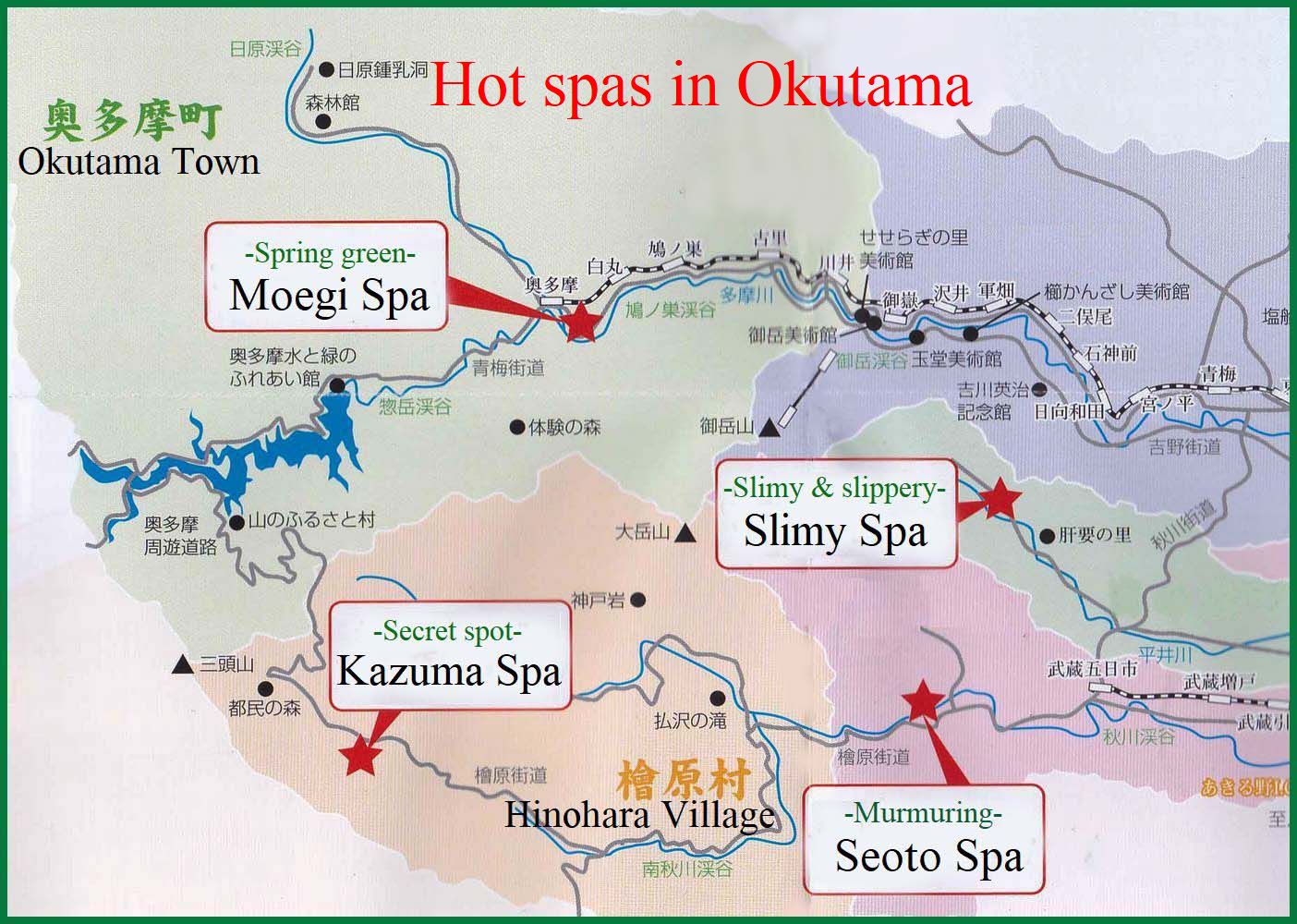
Tokyo prefecture is long and narrow from east to west. The lowlands bordering Tokyo Bay spread in the east, but the mountains rise in the west. Okutama Town and Hinohara Village, which are located at the westernmost border, are called Okutama including their surroundings. It is an area with mountains, valleys, rivers, and lakes. The highest mountain, Mt. Kumotori, is over 2,000 m high. We can’t believe this is a part of metropolitan Tokyo. For the citizens of Tokyo, it is a place of relaxation in the bosom of nature, and an attractive place for camping and mountain walking.
I love the nature of Okutama and often go for a drive, about 160 km round trip during the daytime. Besides the scenery of the four seasons, there is a special fun. It is to heal the mind and body with a hot spring on the way.
All the hot springs in Okutama are mineral spas and have a common feature. When we soak in hot water and stroke our skin, it feels slimy and slippery, which makes our skin feel rejuvenated. It seems to be a physical characteristic of the water rather than the effect of the chemical components contained. There is also a theory that water that has been trapped in the old strata of Okutama for millions of years becomes clustered and slimier. Once we experience, we will be addicted to it.
We don't need to stay in hot spa for a long time, just round up in about an hour and hold again the steering wheel in a refreshed mood that makes the drive even more enjoyable.
There are four hot spas in Okutama. They are "Moegi Spa" in the upper reach of the Tama River, "Seoto Spa" and "Kazuma Spa" along the Akigawa River, and "Slimy Spa" in the upper reach of the Hirai River. All have a rest area serving simple meals and drinks. They are town- or village-run businesses, and the bathing fee is quite moderate, 900 Yen or less.
After warming the body in the indoor bath, let’s take an open-air bath. The feeling of looking up at the blue sky over the green ridgeline from there is just exhilarating. I rarely visit bustling famous hot spring towns, but the quiet hot springs in the mountains are perfect for relaxing.
"From Daily Life" -41: Reunion of university classmates

The above is a commemorative photo taken in March 1954 on the occasion of graduation from the Department of Mechanical Engineering, Faculty of Engineering, the University of Tokyo. The venue was in front of the entrance of Engineering Building No. 2 next to Yasuda Auditorium. This building No. 2 was rebuilt 20 years ago, leaving only the entrance porch with a distinctive arch. We were the second graduates after the university system had changed from old to new.
Professors are in the front row, and 51 graduates are in the back. Of these classmates, only six are in suits with ties and others in student uniforms with stuffed collars. I am the second one from the left in the second row from the front. Nostalgic faces are lined up.
We graduated in 1954, one year after the end of the Korean War and one year before the 1955 government system started, which accelerated a rapid recovery of industries. As far as recruitment was concerned, the competition was almost none. Major companies requested our department head to recommend a certain number of students to be employed. After the department head collected these requests, he coordinated the wish of students and assigned each one to an appropriate company. Getting a recommendation from the department head almost meant that the employment was promised.
The field that enjoyed a booming economy after the end of the war was first so-called Three-White industry such as sugar refining, flour milling and yarn spinning companies. By the time we graduated, the heavy industries, which were revived again by the special demand of the Korean War, began to gain popularity backed by their past fame and tradition. In fact, 7 classmates were employed by Mitsubishi Heavy Industries (3 companies at that time), 6 by Hitachi, 4 by Toshiba, 3 by Fuji Heavy Industries (currently Subaru), and 3 by Ishikawajima Heavy Industries (currently IHI). They alone account for about half of the whole employment of our mates. It should be noted that only two had advanced to the master's program of the graduate school. At present, over 90% of undergraduate students proceed to graduate school, a big change has happened in between.
Immediately after graduation, there were many movements and relocations among classmates, and we lost the opportunity to get together. Since 1961, seven years after the graduation, the regular reunion has been held once a year. The first Tokyo Olympics were over and it was in the midst of the high growth economy. Only two worked in academia, and others in companies as the leaders of production and development. In the 1990s we gradually reached retirement age and entered the second stage of life. When we reached 88 years old, we decided to have our last reunion after we witnessed the 2020 Tokyo Olympics. Since the Olympics were postponed by one year, the last reunion took place at the end of September this year after enjoining the Olympics and Paralympics.
Seven classmates, including myself, gathered. From the regular participants, those who passed, who could not walk due to health conditions, who could not go out for taking care of their wife, etc. dropped out one after another. But all the attendees were fine and there was nobody to put on a cane. The chat was lively, and when the closing time was approaching, our mood changed from closing reunion to continuing further. Finally, we decided to keep our reunion until the participant becomes single.
In order to reduce the burden on the class secretary, we decided to meet in the Graduates Club at noon on the fourth Thursday of May every year without advance notice of the event. I realized that those who enjoy their longevity have an optimistic and positive temperament.
Currently, 31 out of 51 classmates have passed away. Only God knows how many mates may reunite next year. So I just pray that the reunion will last for a long time.
"From Daily Life" -40: Home Museum of Aunt Zschäbitz
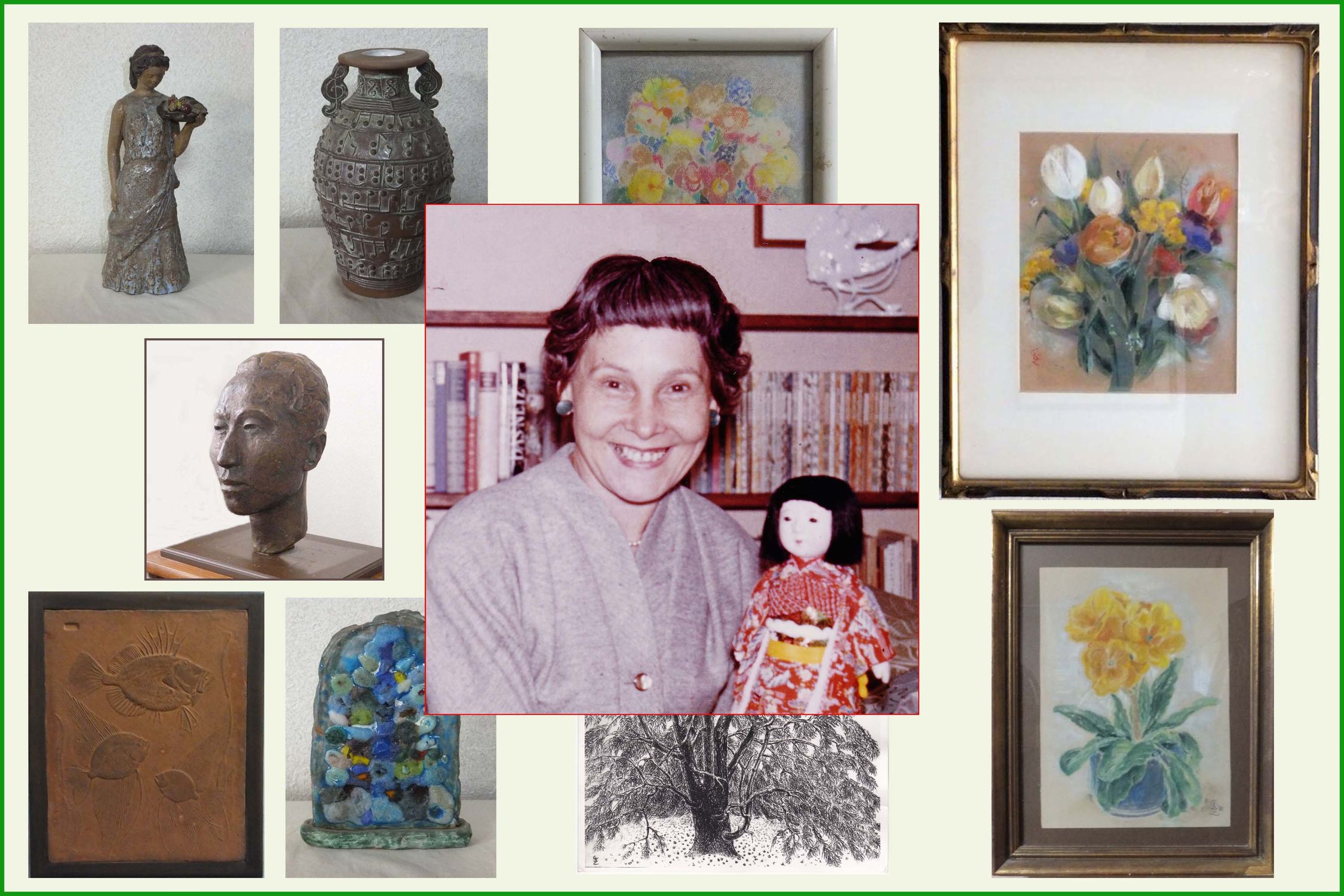
In 1956 at the age of 25, I left Japan for the first time in my life and started research life in Braunschweig of West Germany. Braunschweig was an ancient city with a population of 200 thousand, located 150 kilometers south of Hamburg, and was a university town known as the birthplace of Gauss, a great mathematician. Ms T. Tanaka, my private German teacher until departure, thought that my stay in a city with no Japanese would be too lonely, and kindly introduced me to one of her elementary school classmates, Mrs Grete Krämer-Zschäbitz (hereafter Z) living in Braunschweig.
I visited Z shortly after my arrival. She was a petite, kind-looking widow about the same age as my mother, had no children, and lived with her single sister in an apartment next to a vast city park. She was an artist who was both a painter and a sculptor, and she had many bronze figures she created in the parks of the city. She was loved by the citizens.
We were just like a relation of mother and child. She cooked meals and welcomed me every time I visited. Her potato salad was outstanding and tasted better than any fine dining restaurant. As my two-year stay approached the end, she said she wanted to make a bronze figure of my head. I sat still for a couple of days as a model until the clay model was completed. Her work was sent to Japan after being exhibited in an exhibition entitled "A youth of the East".
After my return home, our friendship continued till her eternal sleep in 2000 at the age of 96. During the long days of mutual correspondence, she occasionally, mostly on the birthday of my wife and mine, sent us her works as a present. Her presents were mostly pastel paintings and lithographs but also many others such as reliefs, mosaics, potteries and figures. My home is full of her works. That is why I call my house “Home Museum of Aunt Zschäbitz”.
In the above picture, some of her works at home are scattered around her photo. It is filled with memories of the nostalgic days abroad and the long friendship that followed. Her warmth and sympathy live still in my house.
"From Daily Life" -39: Caspian Sea yogurt

It's been over 20 years since I started eating Caspian Sea yogurt every day, initially recommended by a former student, Dr. F. The motive is to ensure regular bowel movements. Yogurt has the effect of increasing the number of good bacteria in the large intestine and improving the intestinal environment. F told me about his experience that the effect of Caspian Sea yogurt is the most outstanding among numerous kinds of similar products. When I tried it on that story, the effect was doubtlessly clear.
Caspian Sea yogurt is one of various yogurts, and is produced from raw milk by fermentation using lactic acid bacteria called Cremoris FC strains that are indigenous to the Caspian Sea area. It is pure white, almost tasteless, and slightly sticky. As for the commercial product (left of the above photo), cups containing 400 grams are lined up in the dairy section of supermarkets. If you eat it every day, it is more economical to make it with your own hand.
It's easy to make. Everything necessary for fermentation is sold on the market. A fermenter, two containers, inoculum (seed bacteria) and raw milk, that’s all. First, put about 800cc of raw milk in the fermentation container (right of the photo), then add a dose of inoculum to it, and stir well. Set the container in the fermenter (center of the photo) and leave it for about a day. The fermenter is equipped with an electric heater that keeps the container at an appropriate temperature of 27°C. After confirming that the fermentation is finished and the product has hardened properly, remove the container and store it in the refrigerator. Every time I eat, I take out a proper amount from the container.
Use two containers to recycle the fermentation. When you finish eating one container in about ten days, wash it and start the next fermentation. At that time, take out one large spoonful of yogurt from the container to be eaten next and use it as an inoculum for the next fermentation. Even when refrigerated, the bacteria are still alive. If you repeat this recycling process over 10 times, the texture of the yogurt could start changing. That is the evidence that impure bacteria have begun to increase. When that happens, stop the recycling and use the purchased inoculum to reset the fermentation. The price of a commercial product is almost four times the cost of raw milk. Though the cost of inoculum is additive, the merit of self-made is worth the effort.
After breakfast, eating a small glass of yogurt has been going on for a long time. Occasionally, it is mixed with blueberry jam to give variety. It has become a must-have item in the morning.
With growing age, regular bowel movements every morning become increasingly difficult. In my case, the effect of yogurt became insufficient meanwhile, so I started 3 years ago taking magnesium oxide tablets (2x250mg) every day before going to bed. Fortunately, it's going fine so far.
This time I chose a topic that is too delicate to open, but I dare confess frankly as it is.
"From Daily Life" -38: 45 years living in Seijo
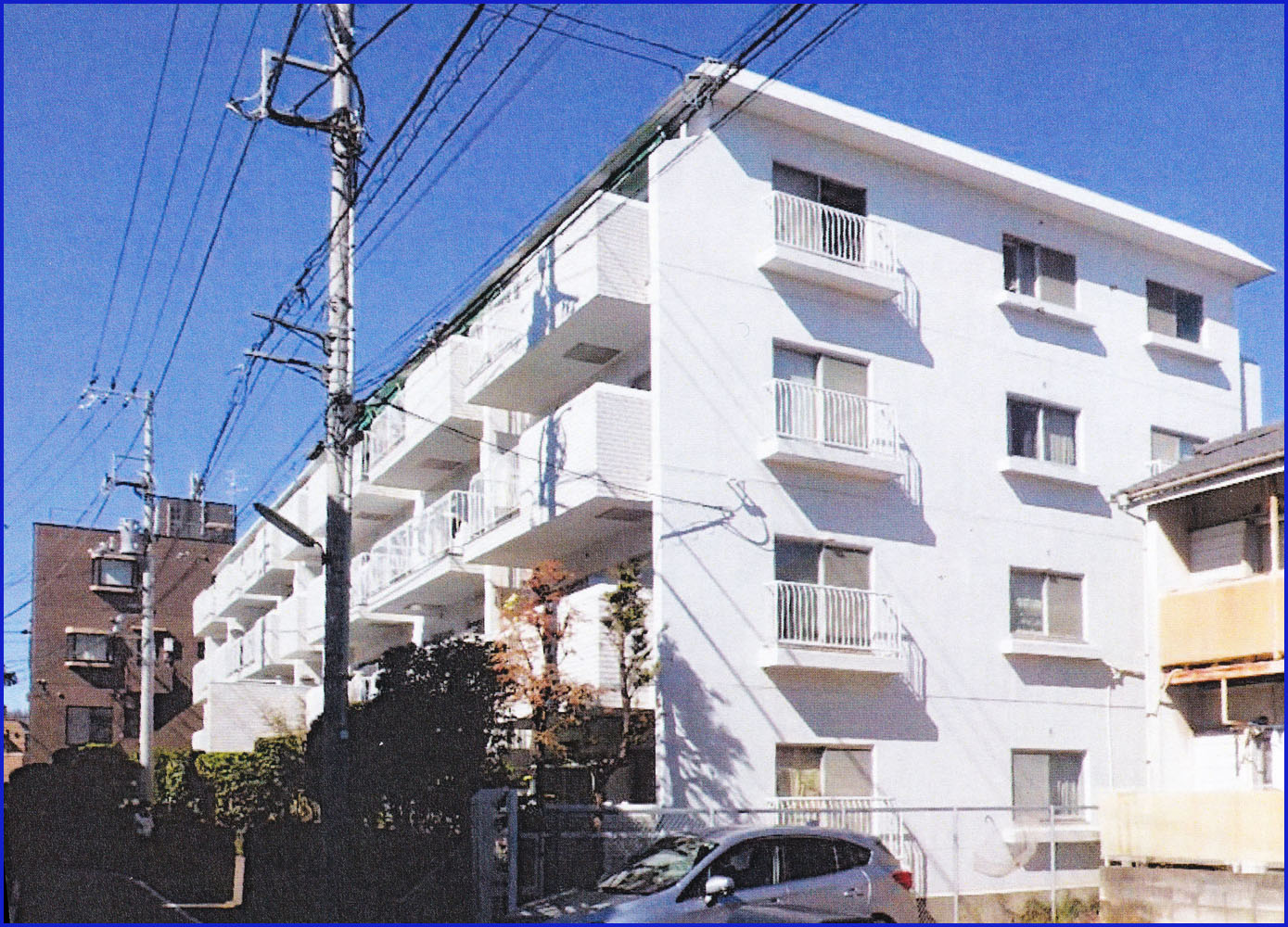
Forty-five years since I moved to a suburban town named Seijo; I have lived here half my life. Before that, I lived in a condominium in downtown Tokyo overlooking Ichigaya railway station. The motivation for moving was that the second son was born and we needed more rooms and that living in suburbs might be safer in case of big earthquakes. We started to look for a condo with a sufficient space in suburbs and selected finally the present one.
The condo is located about 1 km from Seijo station of Odakyu line. Though it is within walking distance, public bus services are also available. As shown in the photo above, it is rather a small 4-stories building with an elevator. We purchased 2 adjacent units of the 4th floor and used a total of 130 m² as a custom-made unit. Most of Seijo's residential blocks have a height limit of 10 meters. Since the condo is located outside the restricted blocks, we can look the green-rich residential area below and Mt. Fuji over Tanzawa ridges far to the west from the veranda.
When we moved, the first son was a 3rd-grade middle-schooler, the second son a kindergartener, and I was in the prime of life just after becoming a professor. Since then, I have been raising two sons here and have reached the two successive retirement ages of the University of Tokyo and Kogakuin University. One by one, two sons became independent and left the home. After full retirement 10 years ago, the days spent together with my wife continued till her eternal sleep. I've been living alone for three years, and now I believe I would live in this home, which is full of family history, as long as possible. This will be my final home.
Town Seijo has also changed significantly. The small wooden station has been transformed into a big station mall, and a small fruit and vegetable store in front of the station is now open nationwide under the name of Super Seijo-Ishii. The vast mansion is divided every time the generation changes, and it is reborn as several built-for-sale houses. But overall, it still retains the atmosphere of a traditional residential area. From two years ago, I started to participate in the gathering of seniors who lived a second life here, and the ties with the community began to increase.
The condo has also aged during the years. We have repeated large-scale repairs every 15 years, waterproofing the rooftop, painting the exterior walls, and repairing the elevator. The third major repair will soon begin, so it will look like it was when it was newly built.
Our house unit is too large to live alone, but I think maintaining it so that it doesn't look unsightly is an essential part of life. There is a round table with the photo of my wife by the sunniest window. That is the altar of my home. Let's continue to spin the history of my family here as long as I stay independent, while keeping flowers around the altar.
"From Daily Life" -37: 3 years with Subaru
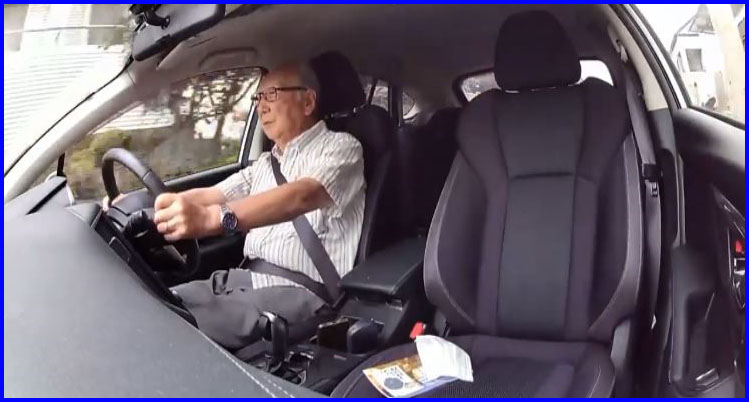
Honda Civic, which I thought once was the last car of my life, ran briskly
for 10 years without any accidents and troubles. Meanwhile, the traffic
accidents caused by elderly drivers had been increasing, and the public's
eyes on them became stricter and colder. Therefore, I wanted to drive a
car equipped with the best available preventive safety devices. So, I switched
to the second last car, Subaru Impreza Sport three years ago. Recently the first mandatory vehicle inspection of the
car was completed without problems. Let's take this opportunity to talk
about my experiences over the last three years.
The mileage for three years was 13,000 kilometers, with an annual average of just over 4,000 kilometers. Since I drive mostly in the near field, annual mileage is relatively low. The average fuel consumption is 9.2 kilometer/liter, and it extends to about 14 when I go out for distant places driving mostly on highways. It was the best fuel consumption for 2-liter engine cars I've ever driven.
I have little interest in the maximum performance that matters only in extreme conditions. All I expected are comfortable seat, good driving view, and help to prevent accidents. Subaru was the car that fully met my demands.
I especially liked the cruise control with all-speed tracking function, which automatically operates the accelerator and brake to keep the distance from the preceding vehicle constant. The driver may concentrate on handling of steering wheel. This function seems to be primarily intended to ease long hours of driving on highways, but it is also very convenient to use in the city. I used to set the auto-cruise on busy streets to focus my attention on the pedestrians and cars nearby. But I have to be careful at intersections with traffic lights. Even if the traffic light turns yellow or red, the car under control follows faithfully the car in front. I have to brake myself. Once I get used to it, it's very easy and convenient.
In the past, I've had two experiences that my car passed a pedestrian critically close at very low speed. I think the focus of accident prevention is on humans rather than cars. At intersections and pedestrian crossings, I pay always special attention not to overlook humans.
I'm not sure how long I can continue to drive, but I wish to keep riding until the day when I tell the car “You are really my happy ending car. Thank you!”.
"From Daily Life" -36: 90 years old supported by meication

90 years old, I recently entered into the decade of nineties. Fortunately, I am still able to manage my daily life independently by myself, and I feel this fact is the greatest blessing I may hope for. There is no pain in my joints, I hold a good posture, walk briskly, and even drive; I have to thank for my relatively sounder physical condition.
As to the ageing of physical ability, hearting is the worst in my case. Even with hearing aids, my ability to hear and understand words has sadly deteriorated. Further, I can't remind what I intended to do just before, I can’t retrieve names of people and places I know well, and I can’t write the correct spelling of Chinese characters; they are all the sign of declining memory.
Although my ageing is steadily progressing, I admit that I am fine for my age on the whole. However, the amount of medication I take is unusual. The figure above shows the medications I take every day. It looks like I am a sick person. Surely I am sick in a sense but have succeeded to suppress the outbreak. I stay healthy with the help of the medication.
The medications taken after breakfast are a tablet that lowers blood pressure, two tablets that improve blood flow, a tablet that lowers cholesterol, a tablet that prevents stomach upset caused by aspirin, and a tablet that suppresses prostatic hyperplasia; a total of 6 tablets. Two tablets of vitamin C and multivitamins are added to this as a supplement. Some people take the medication three times a day, morning, noon and night, but I take it mainly in the morning, so it's less annoying.
Before going to bed, I take 2 tablets of magnesium oxide to keep regular bowel movement and 2 tablets of vitamin B12 that activates peripheral nerves as a measure against numbness in the toes, together with a glass of water.
I visit my family doctor every month to check for any changes in physical condition and get a prescription of medications. As for medical expenses, unless I am hospitalized, the cost of medications is higher than the expenses for medical examination. I always participate in the regular medical examinations for the elderly conducted by the local government.
To maintain good health, I receive various public support including medical treatment. Close communication with my family is also a great help for keeping physical and mental well-being. I am deeply grateful for the blessed situation and environment in which I am placed.
Living alone is lonely, but the freedom is unlimited. Thinking of each coming day in my 90s as a precious gift from heaven, let's concentrate on living through the time called today.
"From Daily Life" -35: Ashikaga Flower Park
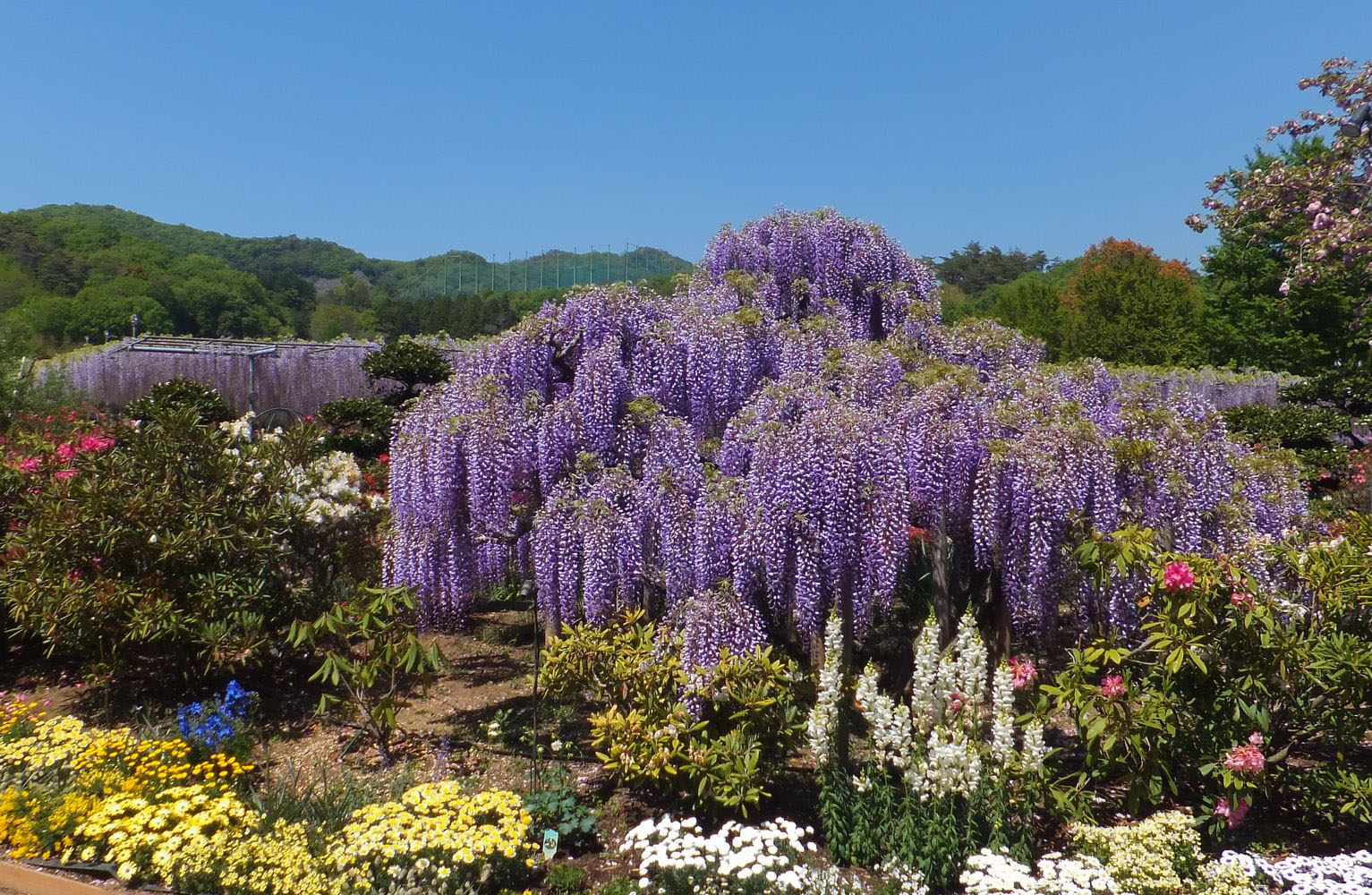
I have been wishing to visit Ashikaga Flower Park, which is often introduced on TV as a tourist spot for enjoying wisteria in full blossom. One day in late April of dazzling fresh green, I was stimulated by fine weather to drive to the Park together with M, daughter-in-law. I got off Tohoku Expressway at Sano/Fujioka Interchange and ran about 10 km west to the Park, a garden of 25 acres covered with flowering trees and grasses. Wisteria was in full blossom, but the Park was moderately crowded because it was a weekday.
It is more accurate to call this place a wisteria park rather than a flower park since wisteria is the dominant player. The admission fee for adults is 1900 yen during the peak season, but it goes down up to 400 yen in the off-season.
Wisteria is usually grown to a horizontal overhead shelf from which bunches of flower hang down. As shown on the left in the figure below, it is certainly spectacular to see countless blooming bunches hanging down long from the shelf that is formed by the branches of a giant wisteria tree. In addition to that, three are independent wisteria trees like the one shown in the above figure. Each one boasts its unique appearance by changing shape and color. As shown on the right in the figure below, there is also a vertical trellis that stands like a huge wall.
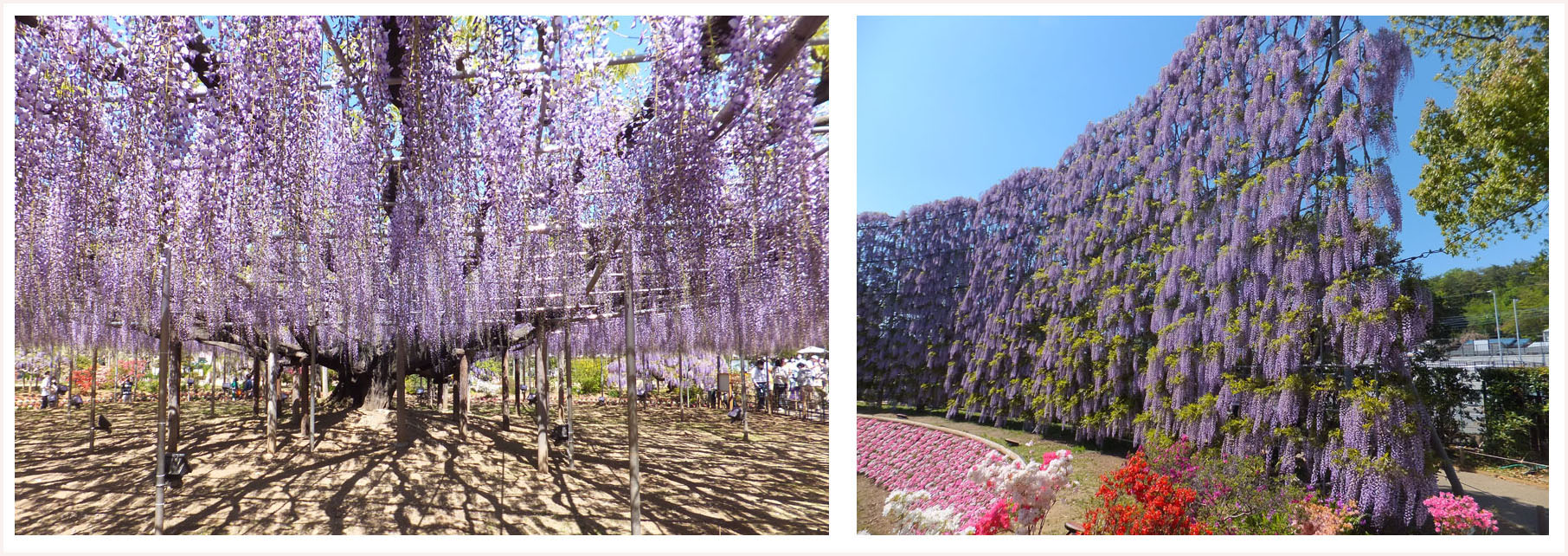
The variation of color is also wide. The main color, mauve, has a considerable difference in shade, and there are also pink, white, and even yellow. There is double-flowered wisteria, though the number is limited. Late-blooming double-flowered cherry and full-blooming white and pink dogwoods are scattered and play supporting role to wisteria. When we shift our sight to the ground, we find various kinds of colorful flowers like tulip and snapdragon. M is familiar with the names of such flowers, but I can't remember.
We enjoyed appreciating trees and flowers for about two hours, and felt overwhelmed by the vigor of wisteria and got comfortably tired. The spring day became so long that I returned home fully satisfied while it was still bright.
"From Daily Life" -34: PCI to prevent heart infarction
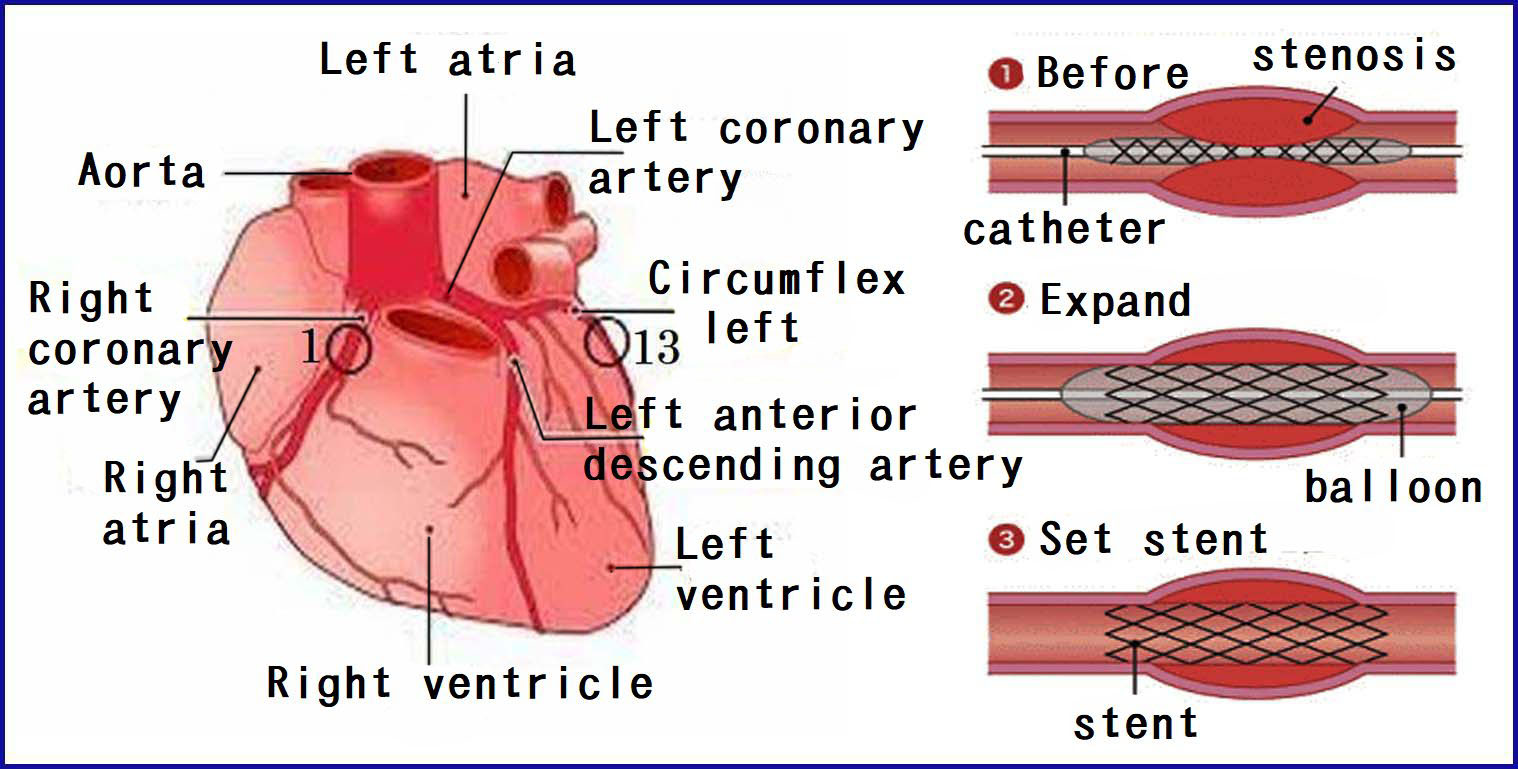
Twenty years ago, I had a cerebral infarction in the early morning and was taken to Kanto Central Hospital by ambulance. Fortunately, the injury was so mild that I could leave the hospital in ten days without noticeable sequelae. I have been taking blood pressure-lowering and blood smoothing (antiplatelet) medications ever since. Since about half a year ago, I sometimes felt a slight oppressive feeling on my chest when I started walking in a hurry or woke up on a cold morning.
Visiting a dentist was the trigger of this story. Before replacing my molar with an implant, the dentist inquired of my family doctor about the suitability of the surgery. The family doctor arranged for a detailed examination at Kanto Central Hospital because of my occasional oppressive feeling and slight changes in the electrocardiogram. The contrast-enhanced CT examination of my heart at the hospital found stenosis in two coronary arteries. Then I was recommended to check further the condition by catheterization.
It was all over with hospitalization for 3 nights and 4 days. In the afternoon of the second day, a treatment called PCI (Percutaneous Coronary Intervention) was performed for 2 hours.
PCI has been well-developed and advanced to extremely safe treatment. Catheters were inserted through the wrist artery, and three coronary arteries were thoroughly explored with echo and pressure measuring probes. As a result, the two locations predicted by CT were diagnosed as 99% stenosis, and a drug-eluting stent was placed at each location (see on the right of the above figure). Since I had only local anesthesia, I was able to follow all the movements of the X-ray equipment and the voices exchanged. At the start, I felt a tingling sensation in my wrist, and there was no pain or discomfort during the treatment.
After the treatment, a full day's rest was required only for confirming the blood pressure and electrocardiogram, and for ensuring hemostasis from a small scar on the wrist opened for catheter insertion. From the moment I left the hospital, I returned to my normal daily routine without any restrictions.
The postoperative explanation made me possible to understand the location
of the inserted stents. As shown on the left of the above figure, the coronary
arteries that drive the heart are divided into three. The main locations
are numbered, and doctors can pinpoint the place only by indicated number.
My locations were number 1 and 13, one on the front and the other on the
backside. There were other suspicious locations, but they were judged to
be far from stenosis. A 99% stenosis means that the passage is narrowed
to one-hundredth of a healthy artery. I am amazed at the adaptability of
the body that the oppression is felt only occasionally under such condition.
About a week after the treatment, the scar on the wrist and the discoloration due to internal bleeding disappeared almost unnoticed. The progress of medical technology is far beyond expectations. Periodical checking of my heart will continue, but the risk of having a stroke of myocardial infarction has diminished. I am deeply grateful for the good luck that I discovered early and dealt with early. Thank you to all the doctors and the staff who helped me with this good luck.
"From Daily Life" -33: Cognitive ability test
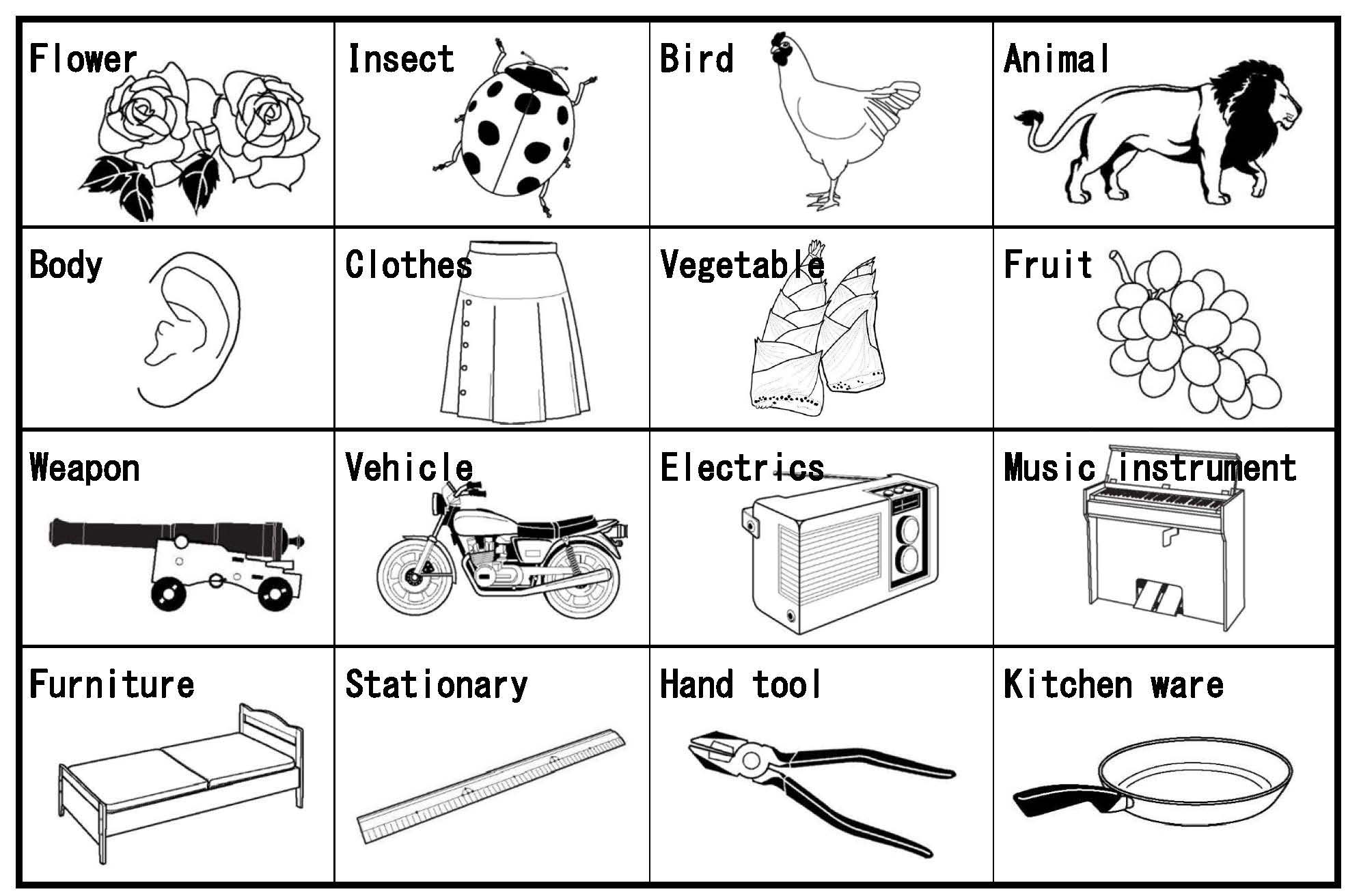
Elderly people over 75 are requested to take a cognitive ability test and a special lesson for the elderly each time they renew their driver's license. Depending on the result of the test, they are classified into one of three groups, that is, no problem in memory and judgment, slightly deteriorated, and deteriorated. The first and second groups are allowed to renew their license after taking 2 or 3 hours of driving lesson, but the third group must be diagnosed by psychiatric doctors and the renewal will be judged according to the result.
The cognitive ability test takes about 30 minutes and covers three different aspects, that is, orientation ability, clock description ability and short-time memory ability.
Orientation ability is checked by answering calendar year, month, day, day of the week, and time of the present moment. In clock description test, we, examinees, must first draw a clock face by hand and set long and short hands at the right position for the indicated time. These two tests seem relatively easy compared to the last one.
What is worrisome to me is short-term memory test. In this test, for example, a rose shown at the upper left of the above figure is projected on a screen, and we are requested to speak “This is a rose, a kind of flower.” In this case, the name of illustration is rose, and the category is flower. This action continues until a total of 16 illustrations shown in the above picture are projected. Once this is done, a nasty task that has nothing to do with scoring is waiting. We are given an answer sheet on which irregular numbers are printed, and requested to mark 1 and 4, for example, with diagonal lines. After completing this task, we realize that recent memory has faded.
First, we write down on a blank answer sheet the names of the illustration still in memory. After a while, we are instructed to look at the next answer sheet on which 16 categories are printed as a clue for memory retrieval. 2 points are given for a correct name without a clue, but only one point with a clue.
As soon as the test is over, the result is immediately scored and graded while waiting. The scoring is distributed with a weight of 17% for orientation, 21% for clock description, and 62% for sort-time memory, and 100 points will be given if all answers are correct. Those who get 76 points or more are judged as “no problem”, 75 to 49 points as “slightly deteriorated” and less than 49 points as “deteriorated”.
The details of the cognitive ability test are opened on the National Police Agency's website. All relevant information from illustrations to scoring methods can be found there. It seems that there has been no change of contents for many years. By the way, there are four illustration patterns, A, B, C, D, and the above figure shows the case of A pattern. 16 categories are common for all patterns and there is a total of 4x16 = 64 illustrations. Which pattern will be chosen in the test? We cannot predict.
I have undergone cognitive ability tests 5 times so far, and have scored 100 points in a row. It's just because I studied for the test in advance and memorized all 64 illustrations. Society's eyes on elderly drivers are becoming more severe. Someday I have to think about returning my license, but I wish now to continue driving for reasonable years to come.
"From Daily Life" -32: Final report on drive monitoring
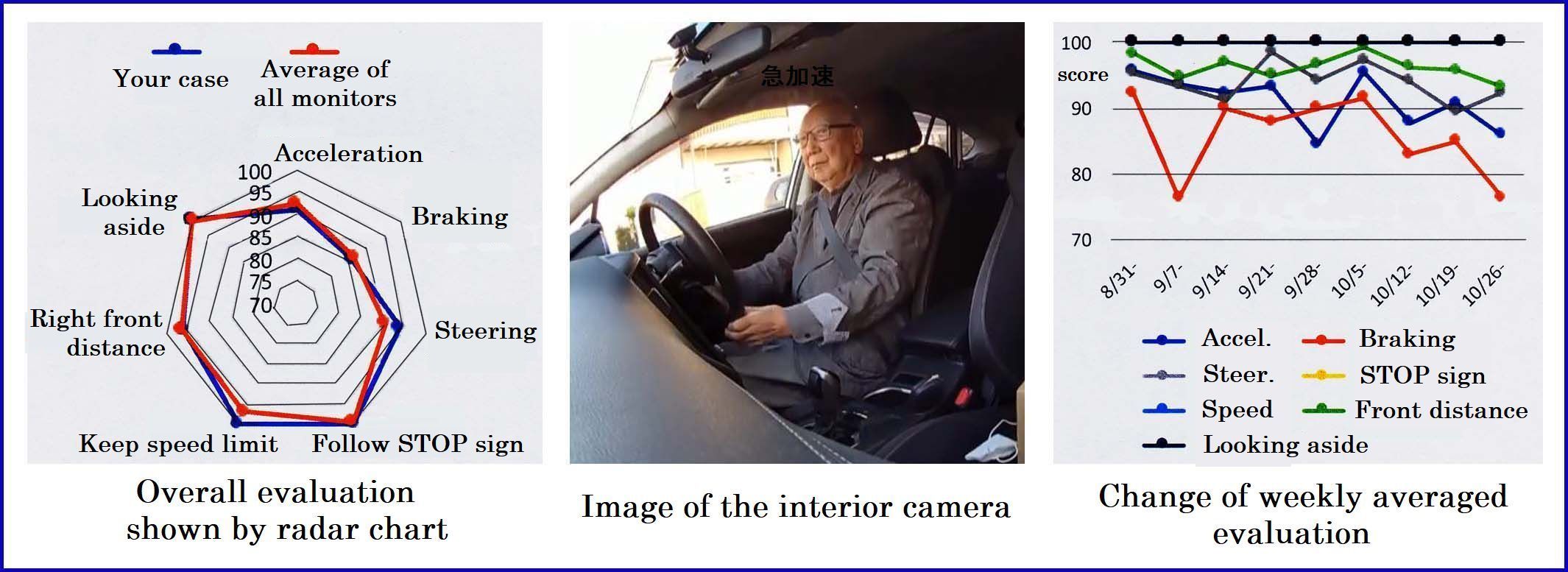
For elderly people aged 65 or over, AI analyzes and diagnoses their driving records and gives them the advice to improve the safety of their driving practice. This project was initiated and funded by the Tokyo Metropolitan Government to reduce accidents caused by elderly drivers and was commissioned by Mobility Technologies Co., Ltd., a subsidiary of DeNA.
The story of how I applied for this project and was selected as one of
the 50 monitors was reported on this top page as "Quick report on drive monitoring” five months ago. How drive recorders and interior camera were installed,
and the diagnosis for the first month were explained there in detail. The
monitoring period, which lasted more than four months, had ended at the
end of last year, and the final report was sent shortly after. Below, AI's
cool diagnosis and scoring of my driving practice were summarized.
Monitoring was carried out for 136 days from July 14th to November 26th, of which 101 days I held the steering and moved the car. I drove five days a week on average. The mileage during the period was about 1500 km, and the average daily mileage was 15 km, which showed that there were overwhelmingly short trips in the nearby area. Long-distance drives over 100 km were so rare as to be counted with fingers.
The daily driving results were released on the site the next day in a drive chart. If a scene judged to be high risk is found, it is pointed out as risky driving, and the scene can be confirmed in the video. In addition, scoring results were shown for eight diagnostic items such as quick acceleration and heavy braking.
The risky driving pointed out during the period was once for violation of STOP sign, once for short front distance, 4 times for quick steering, 4 times for overspeed, and 37 times for heavy braking. I was impressed that AI was watching closely when he found that I had neglected to make a complete stop at a T-junction with STOP sign. Both quick steering and overspeed were far from risky. 80% of the heavy braking judged as risky happened when traffic light turned yellow, and the rest was due to braking at intersections without traffic lights and before a pedestrian crossing. There was never a stop with a jerk, but the AI judgment was extremely strict.
The final report I received showed the overall evaluation of my driving practice in two numerical graphs as shown above and gave me the following comments.
"You are facing forward firmly, ensuring appropriate speed control and the required front distance, but there is a tendency that heavy braking is frequently detected. The detected cases are mostly due to the yellow light signal. It is also a necessary stop to give priority to pedestrians on a crossing without traffic signal, and you are very good in such a situation. However, there is a risk of being hit if a following vehicle is approaching. So, by predicting a signal change, try to reduce heavy braking. "
I applied for the monitor because I was hoping that I could find some bad driving habits that I didn't notice. I also wanted to try out the cleverness of AI. Looking back on the driving in a past day, I remind high-risk scenes such as I should have taken a longer distance when overtaking the bicycle, or I should have noticed the car coming out of a T-junction earlier. However this time, AI has never pointed out such a risky scene. AI had an extremely high ability to analyze numerical data such as acceleration, but I felt that AI still lacked the ability to find possible risks hidden in the continuously changing scenes.
With this participation, my driving has certainly become more cautious. I will never forget this experience and wish to continue driving for reasonable years to come.
"From Daily Life" -31: Topics of eye

Keeping sound eyesight is a grateful privilege in daily life. I had a visual acuity of 2.0 all the time when I was young. After around the age of 50, I started to recognize various symptoms. The first change I noticed was that focusing became slow. When I had a meeting in a big room, I shifted my viewpoint from the materials at hand to the projected figures far away. It took an instant to get focusing. It could be caused by a weakening of the eye muscles. Then, presbyopia, which makes it difficult to see nearby, began, and astigmatism added to it. I started wearing glasses on a daily basis from around the age of 60. The glasses have also changed from simple ones to advanced ones that correct lens power and astigmatism for three targets in far, middle and near distance. Currently, I regularly use glasses that emphasize middle and near sight, and use for driving glasses that emphasize distant and middle sight.
Corrected visual acuity is maintained at 1.0 to 1.2, but the glasses last for more than 10 years, probably because the eye condition has settled down. Cataracts are slightly cloudy in the right eye, but far from the surgical treatment. There are other eye weaknesses. Elderly people are required to inspect their field of vision and light-dark adaptation speed when they renew their driver's license. I have no problem with the inspection, and I don't feel tired even when I drive long at night. I am very grateful for keeping sound eyes for my age. I don't hear much about the training that strengthens eyes like muscle training. I brush my teeth every day but have never taken care of my eyes.
Last year I visited an eye doctor almost every 3 months. Occasionally I feel discomfort at the outer corner of the left eye like a small particle gets in, and it does not disappear even after washing the eye. After the first diagnosis, the doctor said that it was caused by reverse eyelashes. After pulling off several thin eyelashes, the discomfort instantly disappeared. It must be also an ageing phenomenon, but the female doctor complimented me as "It's because you're young and energetic." I wish neither getting irregular eyelashes nor getting so weak that even eyelashes stop to grow. This is likely to continue for a while.
Something interesting has happened recently. When I was looking at the sky, I found a small cloud like a panda's face. As I watched, I noticed that the panda was winking. Cloud would never wink! I carefully investigated the phenomenon and found that it was synchronized with my pulse and occurred only in the left eye. I went to the eye doctor and explained my symptoms, thinking that something was wrong with my retina. After taking and examining photographs of the fundus and tomographic images of the retina, the doctor found no particular abnormality in the retina. After about a week, the small pulsating region in the sight became much smaller. Now I cannot notice it unless I observe very carefully. It was a happening that made me realize the retina was alive.
My generation lived without looking at television and displays. Children these days seem to work their eyes too heavily. I hope that eye training would spread in the same way as muscle training.
"From Daily Life" -30: 2020, a historic year
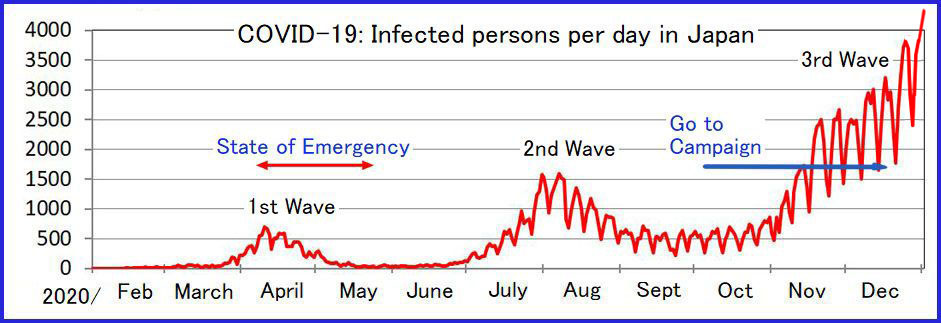
If we read a book of world history in several decades, the year 2020 will be noted as a year when Coronavirus induced a pandemic over the world. The pest plague, which struck Europe in the 14th century and killed nearly one-third of the population, and the Spanish cold, which spread around the world in the early 20th century and killed more than 2% of the population, are handed down as representatives of past pandemics. Compared to the past cases, medical and life sciences have made remarkable progress, such as the success of the complete sequencing of human-genome and the spread of gene-editing technology. This time, the pandemic will be described in history as the first one in which humans fought the virus with all their might in science.
In Japan, infected people became tangible from the middle of March, and increased rapidly to the peak of the first wave in a single month. At that time, the only preventive measures were to wear a mask, gargle, and wash hands, and the government issued a state of emergency to forcibly suppress contact between people. I still remember the strange scenery of streets where the traffic of humans and cars were almost cut off. Starting with the granting of special benefit of 100,000 yen per person, the government provided drastic financial support and worked hard to protect people's lives from the decline in economic activity.
The convergence of the first wave was so drastic that people became optimistic and thought the evil would soon disappear. The government's interest has shifted since then to balancing infection control and economic revitalization, and the slogan has changed from restrictions on going out to three principles to avoid dense contact, that is, to avoid tightness, crowding, and closeness. Along with this policy, the number of people on streets began to increase gradually.
As summer approached and people became more active, the number of infected people began to increase again, and the second peak arrived at the beginning of August. The peak was twice as high as the first, and the decline was rather slow. The number of newly infected kept so high as the first peak level. In October, the government started GoTo campaign for economic promotion, and the number of tourists began to increase rapidly. Our warry became a reality. In November, the number of infected people began to surge toward the peak of the third wave. The cold weather surely promotes dense contact of people indoors. With the bustle of the year-end and New Year holidays ahead, coming December is likely the crucial moment for the battle against Coronavirus.
Elderly people are at greater risk of becoming serious symptoms when infected, so I must be more careful not to get infected. Retired elderly people living alone like me have the advantage of less contact with people. I refrain from going to the sports gym, so I only get close contact with strangers when I go out shopping or I get on a bus or train. I have installed the contact confirmation application COCOA on my smartphone, but of course there has been no contact notification. The likelihood of close contact may be higher for relatives such as children and grandchildren.
I have not yet realized the benefits of advances in medicine and life sciences for preventing infection. The anti-infection measures have not much changed from the days of the Spanish cold. Vaccine development is progressing at a rapid pace, and there is a possibility of vaccination next year. The results of scientific advances in the fight between humans and viruses can now only be felt as speeding up of vaccine development. In the battle of human corps against Corona corps, humans are now fighting independently in each nation, and there is no commander who makes global strategy and integrates whole the human power. Every time a pandemic assaults us, it reminds us of the vulnerabilities of humans, the rulers of Planet Earth. (written on 2020/11/30, only the graph atop is renewed till the year end.)
"From Daily Life" -29: Jindai Botanical Park
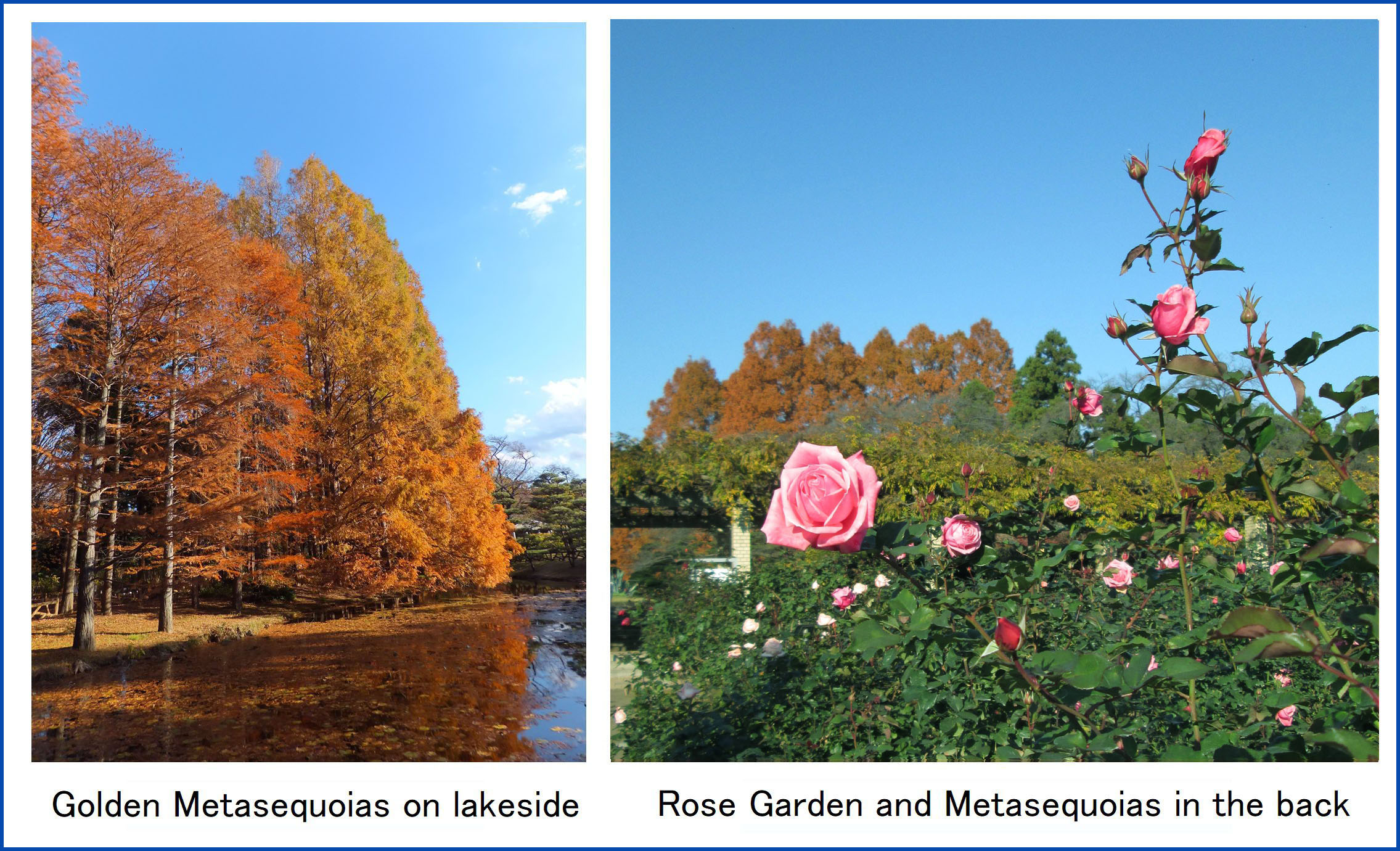
Jindai Botanical Park, located at the northern end of Chofu City, is relatively close to my house and has been visited by whole the family for more than 30 years. There is a well-known temple, Jindaiji, adjacent to the south of the park, and sometimes we visited the park as temple pilgrims. The entrance fee for seniors is 250 yen, and we can enjoy seasonal trees and flowers while walking as we like, so it is a perfect destination for an afternoon walk.
The vast park, which is nearly 1 km east-west and 500 meters north-south, is rich in variety; with a pond, a large lawn, a rose garden, a large greenhouse, and finally with woods that retain the remnants of a primeval forest. The most favorite target for me is the giant Metasequoia trees that stand on the edge of the pond. They sparkle in gold in late autumn and the scene is the most moving of the year. The photo above shows their near view and distant view over the rose garden. The rose garden has two high seasons in spring and autumn, but flowers rarely disappear throughout the year. Even now when I live alone, this park comes first to my mind when I think about going out somewhere.
Because I visit the park so often, my trail there follows almost a fixed pattern. From the parking lot, I walk to the main gate and enter in the park. I first walk through the rhododendron forest and reach the shore of the pond. There I look for flowers of water lilies that cover the surface of the pond. Then I look up at the Metasequoia trees. From the appearance of dropping leaves and standing naked, to the magnificent appearance dressed with fresh green, dark green, and golden clothes, it is a barometer of the season.
From there I go around the pond to the rose garden. While enjoying the blooming seasonal roses, I proceed directly to the garden shop and order a cup of green-tea soft-serve ice cream. Sitting on a bench overlooking the rose garden, I enjoy licking the ice cream and whisper “it’s better than roses”.
From there it's up to circumstances. In early spring I can visit the plum garden, and in autumn I may lie down on the lawn and look up at the blue sky while looking sideways at giant white spikes of pampas grass. When it is cold, I can enjoy tropical plants and orchids in the large greenhouse. Before leaving the park, I used to drop in at a shop where pots of flowers and rare plants are lined up. If I find something special I like, I buy and bring it home and put it beside the photo of Motoko who also loved the park. I wander for about 2 hours at the longest and get home with a refreshed mood.
I usually go there on a weekday, and visitors are so sparse that I see mostly seniors and mothers with children. Walking around surrounded by trees and flowers is the best way to heal the mind. Recently I purchased an annual entrance pass for 1250 yen, so I will surely be a frequent visitor.
"From Daily Life" -28: Hearing aid
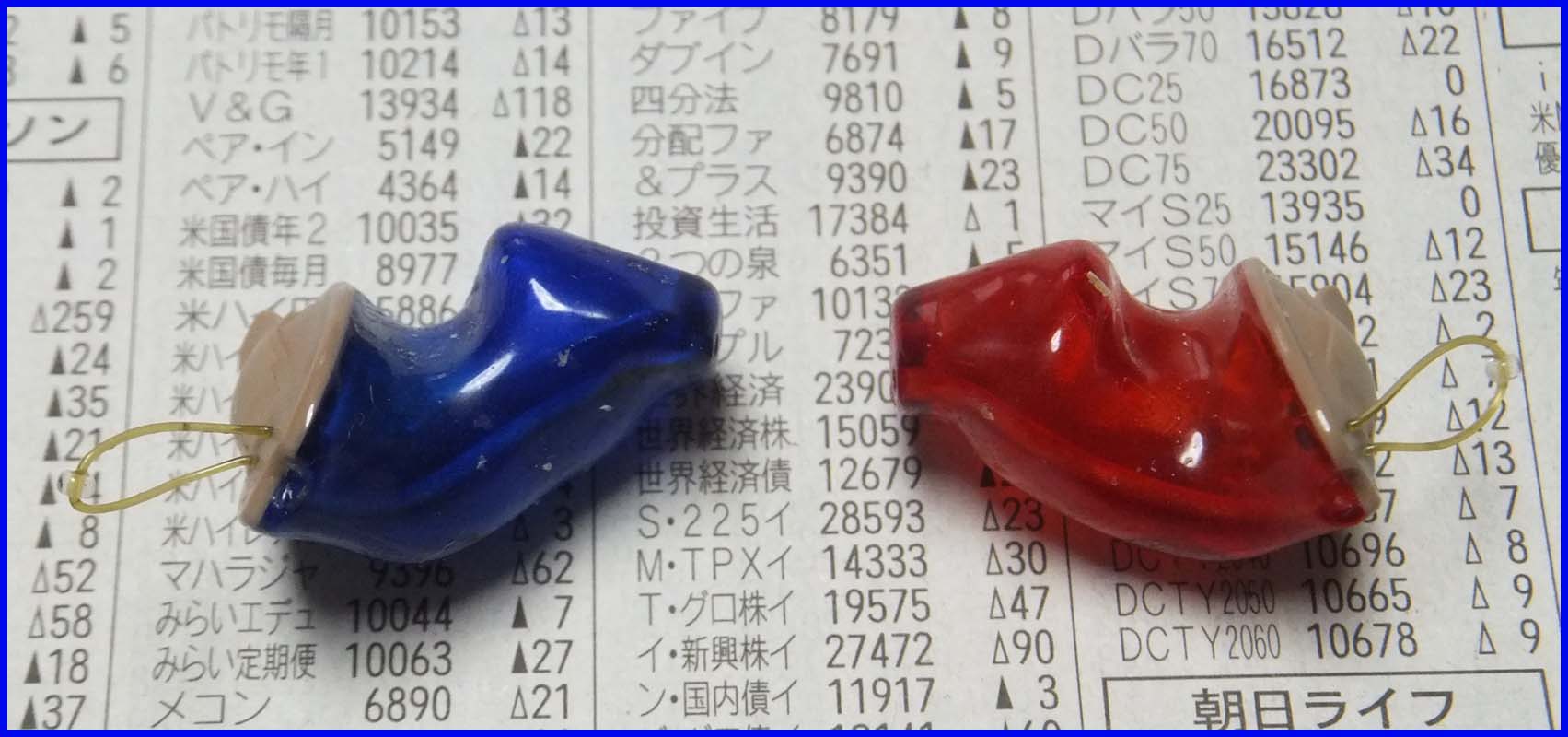
We can't beat the waves of ageing. The rough waves come one after another. Poor memory of immediate past, slow motion and reaction, etc.; there are countless waves to mention. The worst wave for me at present is the deterioration in hearing ability. The symptom began to progress after I passed 80 years old, and three years ago when I was 86, I started using hearing aid.
The first symptom I noticed was that it became difficult to hear small sounds. The sound volume of TV was set so loud that it seemed too noisy for ordinary people. Then, the ability to catch words and understand began to decline. When TV talents talked fast on a comedy show, the audience frequently laughed, but I could not respond at all. Raising the volume had little effect.
This was the serious beginning of auditory disorder. The symptom was caused because the hearing in high-frequency range deteriorated and consonants became difficult to be distinguished. Older people often hear back. This is not because they can't hear voices, but because they can't catch words..
About half a year before I bought a hearing aid, I visited the hearing service of a hospital for getting advice. After various tests, I was recommended to try a hearing aid and borrowed it for two weeks. When I used the gadget, I was rather annoyed by surrounding noise that was as loud as the voice I wanted to hear. I felt that such a noisy world was beyond my patience, and returned the hearing aid.
The moment of purchase came soon. When I attended a meeting in a large room after a long time. I couldn't understand what people in the distance talked at all, and I realized that the use of hearing aid became indispensable. I immediately visited Rion's service center near the station and consulted. The price of hearing aids ranges from tens of thousands to over a million yen, and the choice is so wide. According to the shopkeeper's recommendation, I bought a custom-made product for 350 thousand yen, which was made to fit both ear holes. Of course, the sound gain was adjusted according to my measured sensitivity curve. The hearing aid looks like as shown in the photo above. It fits comfortably in the ear canal and is hardly noticed.
Three years have passed since then. I don't usually wear hearing aid at home. When someone comes in, I put it on and reduce the sound volume of TV to less than half. I always carry it when I go out to meet people and wear it in advance. A small piece of paper with the illustration of an ear is pasted on the inner side of the entrance door of my home. This is to remind me to carry hearing aid when going out.
Always when I wear hearing aid, I am surprised at how noisy the world is. The annoyance due to surrounding noisy sound is still large, but I have to be patient. I believe now it is an indispensable aid to maintain listening ability, I wish to use it wisely in accordance with TPO.
"From Daily Life" -27: Quick report on drive monitoring

Metropolitan Tokyo has started “AI-assisted drive recorder monitoring project”. This project aims to evaluate the driving behavior of elderly people over 65 and to give them proper advice for safer driving. One day I found an open call for the project in the newspaper and immediately applied. I was luckily selected as one of 50 participants screened from 200 applicants by lottery.
First I went to a designated place and had a drive recorder for the front and an interior camera observing the driver installed in my car. The image and sensor data are continuously sent to the project center. AI then analyzes the data and extracts high-risk driving behaviors if any. During the monitoring period of 3 months, I have to run always under surveillance. I try to drive more cautiously than usual so that AI would give me favorable scores.
One month has passed since the monitoring started. I drive almost every day, mostly in nearby areas, and am enjoying the drive scores that will be disclosed on the following day.
The above photo is a drive chart showing the scores of August 19, 2020. All past scores can be also retrieved. The left side shows the achievement of the present target (complete stop at STOP sign). It shows the target is achieved on the day, and also on 22 consecutive days from the beginning.
On the upper part of the right side is the column of “Risky driving”. If a risky driving behavior is found such as sudden stop or overspeed, corresponding map and video showing the scene will be attached. In the lower column of “Scores in detail”, driving time and mileage are indicated. Then, scores for each of the seven diagnostic items are shown. Items include “Avoid rapid acceleration”, “Avoid rapid braking”, “Avoid rapid handling”, “Keep speed limit”, “Keep front distance”, and ”Looking aside while driving?”. Scores are given to each item.
On the right of each item, a + mark is found. If + mark of “Avoid rapid acceleration” is clicked, value distribution of acceleration during driving is shown. The corresponding score is determined after comparing with the model distribution.
On top of the right side, there are also tabs for Score charts, Video list, and Comments. If the tab for Score charts is clicked, the transition of daily scores, weekly averaged scores and monthly averaged scores are shown in charts.
In addition to the recorded images, driving analysis seems to be performed using the longitudinal acceleration, lateral acceleration, and average speed using GPS data. I have almost understood AI's scoring habits. If I speed up a bit on an empty highway, AI will never consider the traffic condition and gives severe negative score! I will continue the driver as an examinee for another two months and wish to relieve the public prejudice that elderly drivers are inherently risky.
"From Daily Life" -26: Ambulance

Every time I hear an ambulance beeping, it suddenly reminds me of the
tense situation when I called 119 (911 in the USA). Then I always hope
that the case would not be so serious though it matters only to someone
unknown.
The first experience happened in the USA. My 3-year-old son cut his lower lip with scissors. I looked at the phone book in a hurry and called an ambulance. The car arrived immediately and took us to the hospital. My son was enjoying his first ride in an ambulance. Because lips seemed to heal without sewing, the treatment was quickly over. Ambulance service was provided by private companies in the USA, and I received a proper bill later. This is an old story 55 years ago.
In Japan, I have been transported by an ambulance only once, but my wife four times. The first case was in 2002 when I had a cerebral infarction at dawn. My wife called 119 at that time. Since the wound was fortunately small, I was able to leave the hospital without noticeable after-effects in 10 days.
On the other hand, my wife was urgently transported to the hospital due to atrial fibrillation in 2012, parasympathetic ataxia in 2014, pneumonia in January 2016, and ruptured abdominal aortic aneurysm successively in March. In the first case, she was soon allowed to go home without being hospitalized, so the next day we visited the fire department in the district and thanked the staff for their help, along with some sweets as a token of appreciation. They were rather surprised because they experienced such direct personal appreciation for the first time.
Her last case was the most serious. During transportation to the hospital, her blood pressure dropped below the measurable limit and urgent treatment needed within minutes. She could survive miraculously, thanks to the emergency operation by Doctor K who is said to have God’s hand! She was able to return home in about two weeks. However, during the final check at that time, traces of cancer were found in her lung. She passed away after fighting against nearly for two years always at home.
Since my second son started working as a medical doctor in 2008, I have had the advantage to get his advice every time before I called 119. I first explained the symptoms of my wife to him and asked for his judgment. This is not the case for everybody. In an urgent situation, you would wonder what to do, especially if this is the first experience. You cannot afford to get lost for a long time. You should call 119 without hesitation. Don't be upset, you must calm down first so you can tell the situation accurately. Then, while you wait for the car, be prepared to carry all your essentials such as health insurance certificate, patient registration card, medicine notebooks, cash, and credit cards. Then follow the instructions of the ambulance staff.
I am ashamed of thanking ambulance staff afterwards only once although I owe them so many times. I was so grateful that I would put hands together for appreciation each time. Dear ambulance staff, thank you so much!
"From Daily Life" -25: Seven tools for brushing teeth
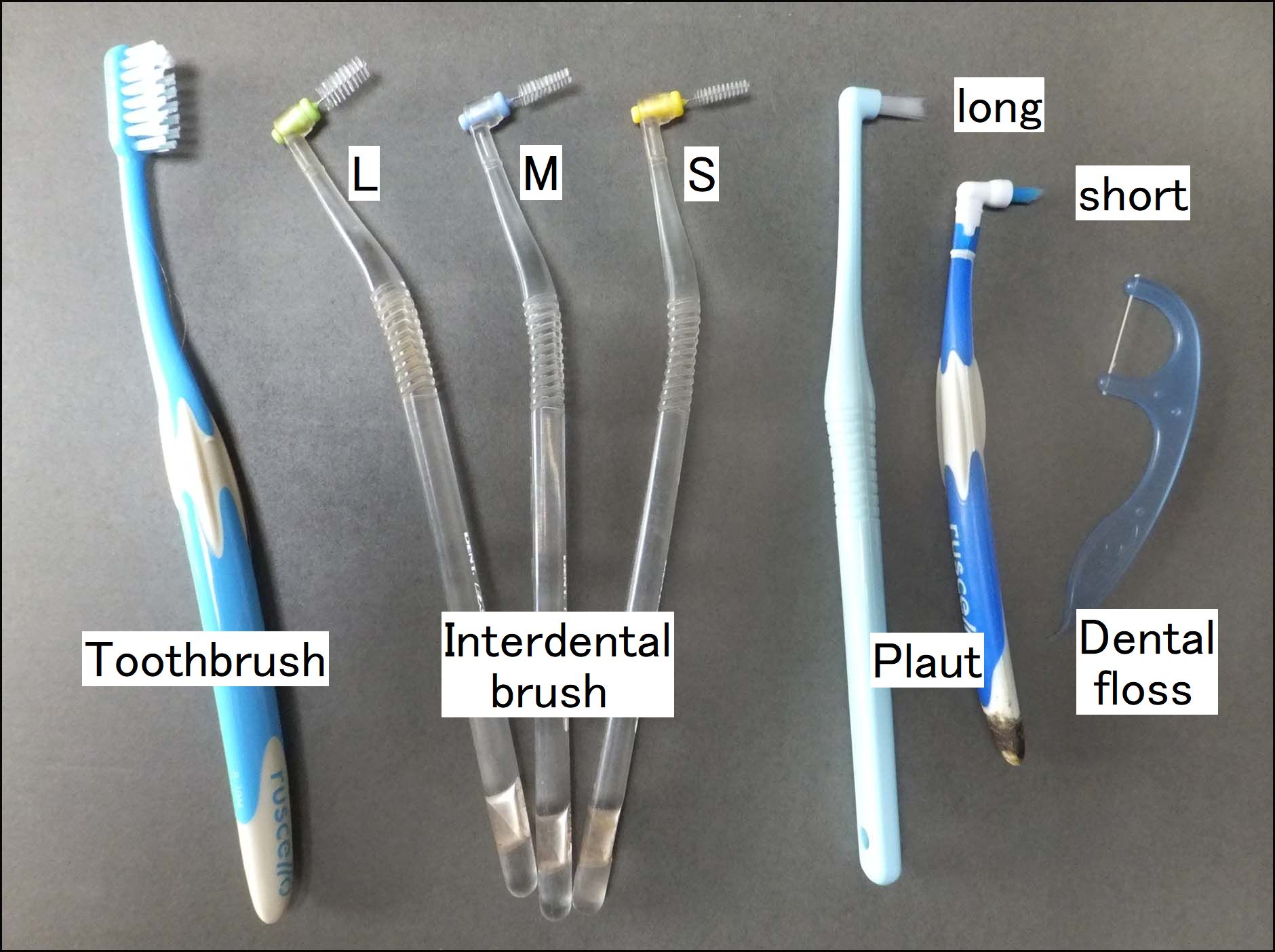
Do you remember “8020 campaign”? This was a health promotion activity initiated by the Ministry of Health in 1989, and its goal of "Keep 20 or more teeth at 80 years old" was expressed simply as 8020. We have 28 permanent teeth if all remain, so we may lose up to 8 teeth till age 80. I am now 89 years old and have 3 implanted cheek teeth and 2 bridged front teeth. So, my case is 8923, and the goal is easily cleared.
When I was about 65 years old, some while after I started working at Kogakuin University in Shinjuku, I decided to receive dental treatment at S Dental Clinic in the building next door. Ms. Dr. K, the director of the clinic, was not only a dentist with superb skills but also a demon coach of a training gym for teeth brushing. Her principle was that how to keep teeth sound is the main battle, and dental treatment is a cleanup operation after defeat. Until then, I used only a toothbrush with toothpaste applied to it. Now I use seven tools as shown in the picture above.
All are tools to keep the interface between teeth and gums healthy. Target is to prevent periodontal disease. You will notice that there is no toothpaste in the tools. Toothpaste contains abrasives, bleaching agents, fragrances, etc. If we apply paste while brushing, teeth are covered by foam and become invisible. I have been so instructed that I use only water for brushing because I can better observe my mouth condition with own eyes. Polishing and bleaching may be done as needed during regular inspections.
Hereafter are my steps to brush teeth. First, using an interdental brush, I clean out all the gaps between teeth. Almost L size fits in, but M or S size is used for gaps that are too narrow. I remove plaque in 13 gaps of each the upper and lower teeth from the front and backside. It will take some time to get used to.
The cavity between a tooth and surrounding gum is called a pocket. If its depth is less than 2 mm, the condition is sound. If the depth exceeds 3 mm, the danger increases that bacteria of periodontal disease starts propagating in the pocket. The depth of my pockets has been measured periodically about once every half a year. I now have one 4mm deep pocket. Since a normal toothbrush is insufficient for cleaning deep pockets, a special brash with a single tuft, called plaut, is used for pinpoint brushing. I use the ones shown in the picture above, and wash gently the target pocket. The dental floss at the right of the above picture is to clean the boundaries between two teeth in close contact. I use this only occasionally whenever I feel necessary.
The final step is brushing teeth using a toothbrush. I gently move it along the boundary between tooth and gum so that all pockets are cleaned and gums are properly massaged. Excessive force on the brush is rather negative since it prevents brush hair from reaching pockets and damages even gums. The point is not to brush teeth in the same way, but to keep in mind what kind of brushing is needed for an individual tooth, one after another. Since the backside of teeth is hard to observe, it is not easy to move the brush properly. The solution is only to get used to, by practice. It will take about 7 minutes to finish all the steps explained in detail.
It is said that one should brush teeth three times a day after eating. However, it seems difficult to repeat the careful brushing as described above three times a day. I brush my teeth only with a toothbrush in the morning and at noon. The full-course brushing is done only once while I take a bath at night. Brushing teeth in a relaxed mood in the bathtub became my long-standing habit.
Even now, I go to S Dental Clinic once every two months for regular inspections. I must be alert always because results come out as soon as I cut out. Whenever I eat hard rice crackers crunchily, I appreciate my sound teeth. As long as I am fine, I will continue to brush my teeth with the style that has become my routine.
"From Daily Life" -24: Digital photo album

Before digital camera became popular, pictures were exposed to a film in camera. We first brought the film to a nearby DPE shop that developed it and printed on photo paper as large as the film itself (contact print). The younger generations don’t know even contact print nowadays. Then we checked small pictures on the contact print and selected frames that were enlarged to the desired size.
This process is basically the same for black-and-white and color print. When color printing was expensive, we carefully selected frames to be printed. As the film era approached the end, and color printing became inexpensive, we received directly all prints in L size skipping the process of contact print. Only when we needed larger prints, we asked again DPE shop to enlarge them to the desired size.
In the days when photo prints were expensive, album making was also popular. There are about 120 albums left in my house because my late wife was enthusiastic about making albums. One bookcase is occupied by these albums. Every album is filled with memories. The newest album of them is labeled as the year 2007. More than ten years have passed since then.
The blank period coincides with the years in which digital cameras have become widespread and color printers for home use have satisfactorily advanced. The amount of photos printed has far increased than before. Even my wife, who had a hobby of making albums, could not catch up with the flood of photos. Photos were simply stored in a box. After my wife passed, about 1200 photos were left behind.
Amidst the refraining from going out due to the emergency declaration against Corona virus, I thought of turning the remaining photos to digital albums, reading them by a scanner, and adding a table of contents. There is various album making software, but I made a digital album in PDF file format, focusing only on saving and organizing a large number of photos. I added a bookmark to selected photos so that I could quickly jump to a specific photo from the table of contents. The file size is about 40 Megabytes per 100 photos. All the photos were put together in five digital albums named family, grandchild's growth, alumni association, friends, and flowers. The last one has a collection of 120 photos of flowers which my wife loved especially. The picture above is a screenshot when Flowers-Album is opened.
In fact, not only the printed photos but about 1200 postcards bought at travel destinations and museums we visited were left. Taking advantage of the momentum, they were also digitized and were put together in three albums named foreign travel, domestic travel, and masterpieces. The last album includes 500 postcards of foreign painters and 400 of Japanese painters with a table of contents.
A large number of photos and picture postcards have been changed to PDF files of about 1.1 Gigabytes in total. They will not bother my children if I leave them after I die. Photographs and picture postcards were all discarded by making the heart a demon in order not to transfer the pain to the children.
"From Daily Life" -23: Wake-up exercise
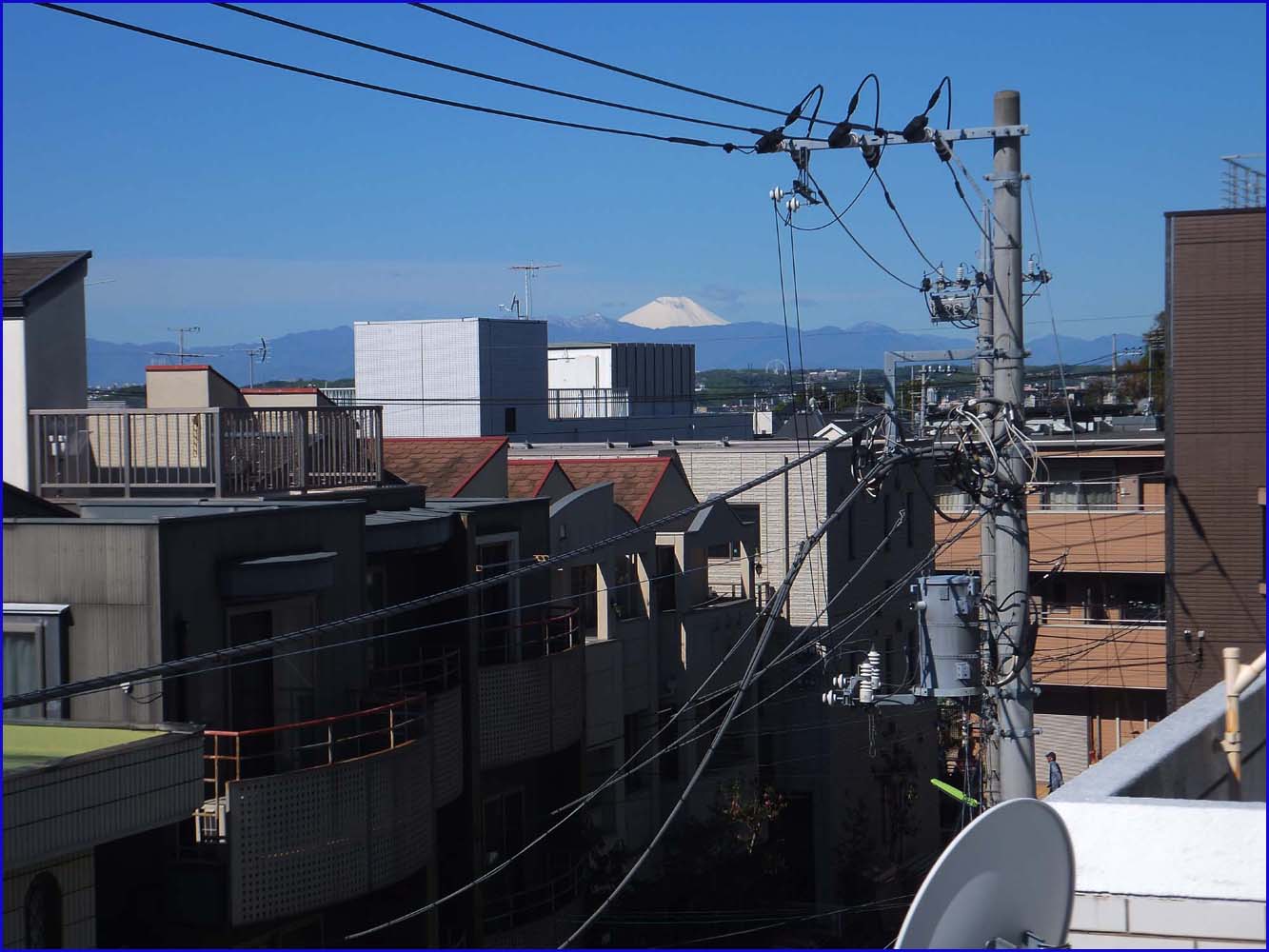
Two weeks have passed since the declaration of emergency was issued to prevent the spreading of Coronavirus, but the fear of rapid expansion has not yet disappeared. Since I've been living like a social withdrawal at home, it’s hard to find report-worthy topics. So let me introduce a part of my daily life.
I wake up around 7:30 in the morning. After changing clothes my morning starts with “Wake-up exercise”. Unless it rains, I go out on the balcony. On clear days, Mt. Fuji welcomes me over the ridge of Tanzawa Mountains in the west. In the snow-capped season, I stare at the refreshing appearance of Fuji as in the picture above, and it definitely wakens up my sleepy eyes. I start exercise facing Fuji. I bend my upper body front- and backward, then left- and rightward, and twist left and right, repeated four times each. In succession, I tilt and rotate my neck 10 times left- and rightward, and repeat shoulder rotation 10 times front- and backward. Finally, I bend and stretch my knees 50 times while swinging hands strongly. This body exercise has been going on for more than 20 years, so my body moves naturally like a reflex movement.
Then I check my eyes without glass. I have several checkpoints for testing, such as a remote Ferris wheel in an amusement park and a high-rise building in Yokohama. If they can be clearly seen, my sight condition is all right. When the sky is perfectly clear, I further check my color recognition. I look up at the sky by a single eye at a time and compare the colors of both eyes. Compared to deep blue by the left eye, the sky looks slightly whitish by the right eye. Eye lens becomes impure as age proceeds. Although the operation for cataract is not yet necessary for me, I can check the progress of the symptom.
Wake-up exercise is over, but there is an extension. I have to wake up my brain as well as my body. So I sit down in front of my computer. After checking emails, I start playing games. My routine game is FreeCell, and I quickly clear up two games each time. Although the play is just gymnastics for the brain, it has been repeated for so many years, and the number of games done has exceeded 10 thousand. I recently received the title of Bronze Grand Master of the game. It may correspond to a bronze medal, but the goal of a gold medal seems so far. After completing this series of routines, I can awake myself both physically and mentally.
Next, I finish shaving and washing and prepare breakfast; just fried egg, bread, and coffee. Watching TV and reading newspaper, I take breakfast with a slow and relaxed tempo, Morning dessert is a piece of fruits and 3 tablets of medicine. To the last, I clean up dishes and finish bed making. At about 9 o’clock all of my morning routine comes to the end. From then on, I have to decide what to do every day. A long day begins.
"From Daily Life" -22: Visit to Kobayashi Residence

Hinohara Village, located on the western edge of Tokyo, is the only village in Tokyo except for islands. It is occupied only by a mountainous area that is headwaters of the Akigawa River. Small communities are scattering along the main and branch rivers and convey culture and tradition from the old days. It is just a convenient place where people can enjoy hiking, fishing, and camping in nature. Once a major road was running through the village and traces of old days remain in local names taken from historical persons. Although it was a deserted village where people supported their life by charcoal making and silkworm culture, it has been totally modernized to a recreation base for Tokyo residents, with fine roads, kind information signs, clean public toilettes, etc.
When we drive along the rivers there, we find occasionally houses far upward in the middle of steep mountain slopes. I used to wonder what would be a life in such a remote place. One day, I learned that there is an Important Cultural Property called Kobayashi Residence located far upstream of a branch river. On a warm day at the end of February, I started to explore the place.
I used public transportation throughout the trip. At 7 a.m. I left home and got on a train. I arrived at Musashi-Itsukaichi Station via Noborito and Tachikawa. From there I called the Administration Office of Kobayashi Residence and made a reservation for a monorail. It took 50 minutes by bus to reach the end stop and walked further half an hour for the monorail station. There I was welcomed by Mr. T, the manager of the office. He drove the monorail and lifted me, only one visitor of the day, to the upper station at 750m height in 15 minutes. The monorail was equipped with support wheels and kept balance quite well. It climbed the track built in forests with a maximum slope of 40 degrees (see upper left photo).
There was a small flat ground in the middle of a ridge. Several very old zelkova trees, supposedly over 600 years old, stood at the edge of the ground. The network of their strong roots acted like a dam that stopped the outflow of sediment and formed a narrow flatland. Kobayashi Residence with a traditional thatched roof as shown in the above middle photo was built there originally 250 years ago. It was fully restored after it was designated by nation as an Important Cultural Property in 1973. As shown in the upper left photo, a relatively gentle ridgeline can be seen in front of the house. In the old days, there was a major road along the ridge and many travelers and horses were coming and going. Roads along river and ravine were rather dangerous, and gentle ridge lines seemed more suitable for safer traffic.
Family Kobayashi started to live there to produce hard charcoal. Restored Kobayashi Residence is now a heritage that preserves the lifestyle and culture in mountain areas. With the advantage of the land relatively close to Edo (old Tokyo), the production of hard charcoal was thriving in nearby districts. Bales of charcoal were transported on the back of horses along the ridge down to the collection market far below. On the way back, horses carried daily necessities that couldn't be obtained in a mountain. Such a lifestyle had continued until the Meiji Era. At the foot of the house, a monument remains at the site of an abandoned elementary school opened in 1873. It is now a depopulated area, but a lot of children lived there in the old days.
As a sole visitor of the day I heard from Mr. T a long lecture on the history and lifestyle of this area. The slope behind the house is covered by several tens of azalea trees. It seems to be quite busy during the azalea festival in May. In this house, the family spent daily life; children fetched water from a nearby stream, and parents cut woods and burnt charcoal. Whole member of the family assisted here with each other. It was an inconvenient life incomparable to the present, but the family worked hard and spent harsh but peaceful days. It was a precious day for me to compare life in old and modern days, and I regretted that modern people have been spoiled by convenience too much.
On the way back, I walked down to the bus stop. Along the way, I stopped at the monument of abundant elementary school and bowed deeply at Kasuga Shrine, a guardian shrine. I returned home at 7 p.m. tracing a completely reverse course. It was an unforgettable 12 hours to visit a mysterious place in Tokyo.
"From Daily Life" -21: Granddaughter has come !

On February 1, my first granddaughter was born. The girl joined the family of my second son K following two brothers. I have two sons, and two grandsons each. I almost believed that my DNA excludes females♀. However, an unexpected miracle happened. She got the name “Hiyori” that implies the wishes of parents that she may be a being like sunshine. I sincerely hope she grows up sound and bright!
It is unusual to be blessed with grandchildren for the elderly after 88. I am unconditionally happy with the arrival of the granddaughter. Whenever I saw a scene where a grandfather was walking holding the hand of his granddaughter, I dreamed to do the same. The chance has become finally realistic! But, if I fall down together with my granddaughter, it’s a tragedy. At my age, I have sufficient incentive to train my muscles.
The mother, K’s wife, is a vegetarian by nature but produced a perfectly grown large baby of 3580 grams. Please look at the bay in the pictures above. Her brothers are also happy by the arrival of a new sister. Both my second son K and the new baby were born after their mothers exceeded 40 years old. The age limit of birth is expanding as medical support advances. I have to thank K’s wife for her positive decision to create a new life. The future of human society is entrusted only to newborn babies.
"From Daily Life" -20: Battlefield rations in the sequel

Living alone has entered its third year. Meals continue to be self-catered three times a day. Though I sometimes attend meetings with dinner or occasionally eat out, I don't feel like I've met especially delicious food. I wonder whether I usually eat quite decent dishes or I’m just insensitive to taste; probably the latter.
When living alone has entered the tenth month, I posted an article entitled
"Battlefield rations" on this top page. At that time my self-cooking method was almost solidified, so I wished
to introduce examples of my meals with photos.
Especially as to dinner, I explained all my cooking practice, such as making a design sketch before starting cooking. If I reread that article now, I realize I was quite an earnest beginner. When I heard the reputation of readers that my dishes looked more gorgeous than theirs, I was a little embarrassed. I named my meals as battlefield rations because they were prepared with minimal time and effort.
The basics have not changed. There is no problem with nutritional balance. The volume of food has been kept conservative for weight control. I enjoy an active life for my age. My meal management could have contributed to keeping my health in good condition.
Breakfast and lunch have always been the same. In the morning, a fried egg, bread, coffee and yoghurt are standard items. Lunch is quite light, for example, tea and something like banana or donut, and is taken just to keep the rhythm of life. What has changed at dinner is that it has become more and more simple. I don't need to care about the balance of protein, starch and vegetables every day. The ancient humans had eaten a full stomach when they came to their prey but had survived only with water during the rest of the time. We must have inherited that DNA. It is much easier to think about nutritional balance on a monthly basis.
In olden days, a cup of miso soup and a dish besides rice were common as a dinner. We don't have to worry about main and side dishes always. We can put everything into one dish. I show you two examples of recent dinners in the picture above. I often bring all foodstuff into a pot or a pan and boil or stir-fry together with seasonings. The dining table has become much simpler, but alcoholic drinks are still indispensable. I start eating after I feel tipsy with alcohol, so I become quite generous in taste. My willingness to improve cooking skills has completely disappeared.
My battlefield rations are feeding me well in the sequel as reported above.
"From Daily Life" -19: Braking by left foot

If once accelerating instead of braking by mistake takes place during driving, it causes a severe runaway accident and could injure innocent pedestrians even fatally. We witness such tragic accidents occasionally on news. When a driver wants to stop without noticing that his right foot is on the accelerator pedal, he pushes harder and harder thinking "Doesn’t stop, let's stop." Upset paralyzes entire judgement. It's like being trapped by a demon and can't get out.
When I was about 50 years old, I switched to use right foot only for accelerating and left foot for braking. At that time runaway accident due to mistake has not yet become social news, but because I decided not to own cars with manual transmission anymore, I wanted to make use of my left foot that had lost its role for clutch control. I thought the change would make driving much easier. The advantage to prevent eventual runaway accident followed consequently.
The role sharing that right foot for accelerating or braking and left foot for clutching has become an internationally established driving technique since the days when automobiles were equipped only with manual transmission. Later automobiles with automatic (clutch-less) transmission appeared and became gradually popular. Nowadays cars with manual transmission are sold only for enthusiastic drivers. Left foot has lost any driving role and keeps rest for the majority of drivers.
When I wanted to switch, there was no one to teach me how to exercise the technique. Fortunately it doesn't seem to violate the traffic law, so I had to do it myself. I tried my first braking by left foot on a road with few traffic. Car stopped too quickly. It was a natural consequence because I stepped on the brake pedal as if I did on clutch pedal. Clutch pedal requires quick push but controlled return. Brake pedal requires, on the contrary, controlled push but quick return. Left food should learn first controlled push motion. If car happened to stop too quickly during exercise, the result would be rather harmless compared to the case of too quick acceleration. I was also worried whether I could respond to an emergency braking properly. However, if the brake pedal is pushed by right foot as my conditional reflection reacts, it does not matter.
I consciously applied braking with left foot for about a week, and it gradually became commonplace. In a month my left foot started to move naturally. After all, getting accustomed is essential.
I have been driving with left foot braking for almost 40 years. Fortunately I have experienced no accident so far, though I have payed occasionally fines for stop sign violation, etc. Elderly drivers who have not returned their licenses, are receiving severe eyes from society, but driving is one of few funs still remain. I would like to continue driving for a while, of course, under such precondition of healthy state of mind and body, use of advanced preventive safety devices, and strong sense of safety.
"From Daily Life" -18: Reunion of alumni and classmates
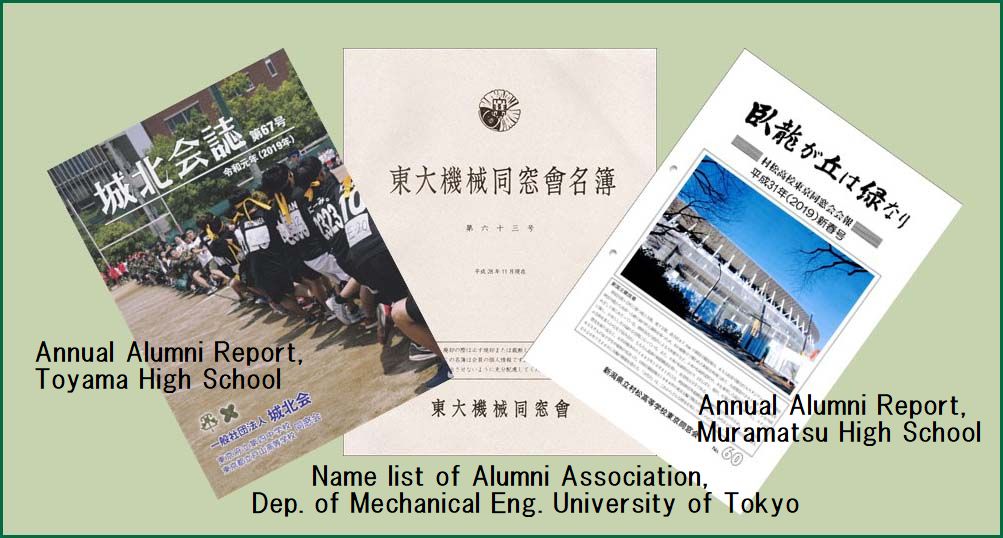
School life continues from kindergarten to university. Graduates from the same school are called alumni and those who studied in the same grade or class are called classmates. Everybody has opportunities of attending reunions of past alumni and classmates. With the passing of years after graduation, the opportunites vanishes one after one, and only a few remain when one reaches the age like me, 88.
In my case I lost all opportunity to join the reunion of primary school. I entered No. 4 Municipal Middle School (of old school system, presently Toyama Municipal High School) and stayed only one year till I transferred to Tokyo Army Cadet School in 1945, the year of surrender,
Though my enrollment in the Middle School was so short, the Alumni Association of the school was so generous to put my name on the list of alumni. Though I have attended rarely the alumni reunion, I enjoyed every year gathering of my mates in the same class during the first grade. The gathering ended last year since the participants reduced to three among initial 50 members.
I had no opportunity to attend Army Cadet School that was forced to abolish after the end of war.
I graduated from Muramatsu High School in Niigata Prefecture north of Tokyo. Since its alumni reunion is held at local town far from Tokyo, I used to attend the reunion of Tokyo branch and enjoyed chatting about memories of young days.
My last school, University of Tokyo, is too large so that alumni activity as a whole is rather low. I attend almost every year the alumni reunion of the Department of Mechanical Engineering. Besides it, I also enjoy gathering of classmates (graduates of 1954). The starting members were 50, but about the half passed away and the half of the rest were unable to go out without help. This year ten members gathered and decided to meet next year as the last reunion. Classmates reunion is destined to disappear someday.
As age advances, the opportunity of attending reunion of school alumni and classmates fades out. It is a lonesome consequence.
"From Daily Life" -17: Pilgrimage to Mt. Tsukuba

What is the most popular mountain visible from downtown Tokyo? The answer is surely Mt. Fuji, the highest (3,776m) in Japan. What is the second? Most people would mention the name of Mt. Tsukuba that is about 880 m high and located 70 km apart north-eastward. The mountain is rather low but easily recognizable because it is an isolated peak on open plains and has a characteristic twin-summit shape as seen in the above picture.
Mt. Tsukuba has long history as the object of faith. In the oldest written history of Japan (Kojiki) edited in 712 AD, we can find following mythology: God Izanagi and Goddess Izanami were sent from heaven down to chaotic muddy land. The two gods married and produced eight solid islands, the land of Japan, and then bore ancestors of present Emperor Family. Tsukuba was one of borne islands.
Mt. Tsukuba has been a sacred mountain. Atop the left summit there is a shrine of God Izanagi, and likely, atop the right Goddess Izanami. These two gods are believed to help people wish especially happy marriage and sound birth. There is also Worship Hall of Tsukuba Shrine half-way up the mountain, where pilgrims pray to whole the gods. Whenever I saw Mt. Tsukuba, I wished long once to stand on the mountain.
The opportunity became reality in the beginning of this October. I chose Mr. D, one of my former students living at nearby Tsukuba City, as my travel partner and met him at Tsukuba railway station at 10 am on the first day. The weather was fine and stable.
We took a shuttle bus for the station of ropeway that carried us closely below Goddess Summit. After we bowed and thanked for producing our land at the Goddess Shrine, we enjoyed panoramic view extending far to metropolitan Tokyo. Then we walked down along moderate slope for Holy Visit Col where rest shops and cable car station were located. We took there lunch and rest before we attacked final climb to God Summit.
Though the height difference was merely 70 m, the climb was quite tough
against expectation because the steep trail was slippery and blocked by
larg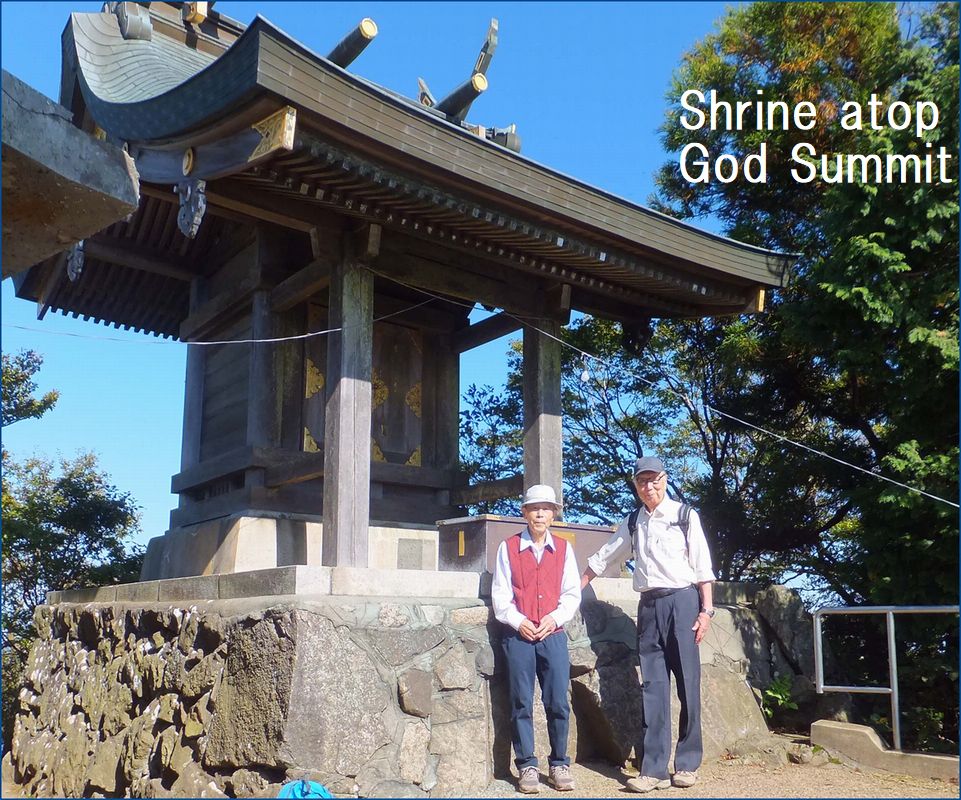 e rocks one after another. When Mr. D almost exhausted and stalled midway,
maybe because of his heavy backpack, a young man appeared who just came
down from the summit. He kindly offered to carry D’s backpack and guided
us to the summit. He took the photo shown right and went down again with
smile. We thought the God sent him to help us. We both bowed deeply in
front of the God Shrine and thanked for his Creation and kindness. We were
especially cautious not to slip and tumble down during descending.
e rocks one after another. When Mr. D almost exhausted and stalled midway,
maybe because of his heavy backpack, a young man appeared who just came
down from the summit. He kindly offered to carry D’s backpack and guided
us to the summit. He took the photo shown right and went down again with
smile. We thought the God sent him to help us. We both bowed deeply in
front of the God Shrine and thanked for his Creation and kindness. We were
especially cautious not to slip and tumble down during descending.
We returned to Holy Visit Col without trouble and took a cable car downward to the terminal station near Worship Hall of Tsukuba Shrine. The pilgrim route branches here into two trails, one to God and the other to Goddess Summit. Pilgrims in old times had no way but to climb on foot. How lazy are instant pilgrims today like us!
The Worship Hall is surrounded by many hotels that offer rest, meal and overnight for pilgrims. We checked in at a hotel of the longest standing and healed tired body in hot-spring before dinner. We two slept next to each other fully satisfied with the happenings of the first day.
Next morning we started walking down to foot of the mountain along old narrow pilgrim route, witnessing ruins of past guest houses, stone monuments engraving poems on the mountain, and so on. It took about two hours to reach the bus stop where we caught a bus to railway station. We took lunch at a coffee shop near the station and thanked each other for sharing unforgettable experience. I returned home before evening with a lot of pleasant memories and deep sense of accomplishment.
"From Daily Life" -16: Annual report of athletic gym
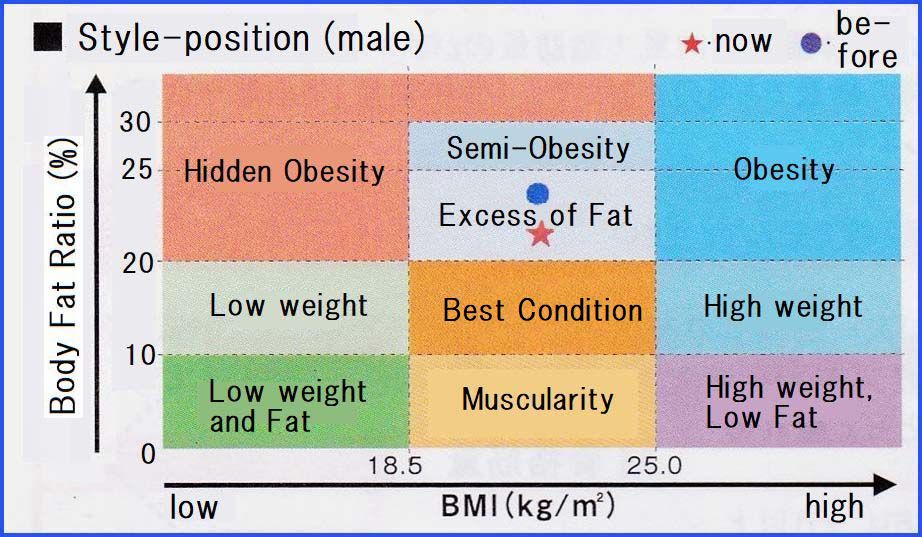
One year has passed since I started regular exercise at the nearby athletic gym in September last year. With firm object of reducing metabolism and enhancing muscular power, I have been repeating exercise for about an hour three times a week. When I recall the days just after the beginning, I was so optimistic that the effect of the exercise would become tangible in shorter time. However, I had experienced only disappointment for three months because follow-up check list disclosed successively negative effects like increased body fat and decreased muscle. That was a critical period with strong temptation to quit. At the end of the year I could receive a pleasant Christmas gift, check list that first proved the long waited positive effect; reduced fat and increased muscle! Following is the report on the change of my body based on measured physical data.
The instructor of the gym prescribed the instruction for my exercise based on my style-position. As seen in the picture above, style-position is a point on the coordinates that have BMI (degree of obesity) as the horizontal axis and Body Fat Ratio as the vertical axis. Though my BMI is quite adequate, my Body Fat Ratio exceeds always 20 %. So, my style-position is located in the region labeled as “Excess of Fat”. In order to move to “Best Condition” region, reducing body fat is the ultimate target.
Instruction for my exercise was written on this fact. My exercise has changed little meanwhile and is composed of following parts. 10 minutes quick walk for warming up (at 5.5 km/h), muscular training by machines for abdomen, back, body twist, arms and legs, and finally 20 minutes aero-bike (120 kcal). It takes about an hour.
The change of my Body Fat Ratio over the past 12 months is shown in the figure down left. It repeated up and down and could not go down below 20 %. What have I sweated for? It is quite a frustrating result.
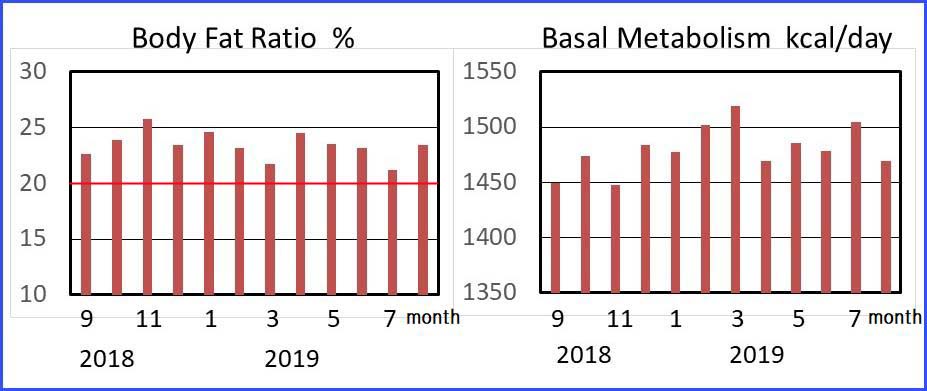
Though the measured data are so disappointing, I have sure awareness that my body has changed. There must be positive effects that can’t be measured by numerical data. I feel for sure that my body trunk is getting tougher with less tottering and my stuck-out belly is shrinking. The fact that I have never fallen down in the past year, could be a gift from the gym.
When muscles increase and the body becomes robust, basal metabolism (basic calorie consumption a day) increases, thus moving away from obesity. The figure above right shows the change of my basal metabolism over the past year. It looks like also going up and down and shows no rewarding evidence. I am sorry to conclude my report with little success, as far as measured data are concerned.
At first I was pretty nervous about the measured data, but now I don't care much. This is because I realized the effect of going to the gym in another aspect that was never expected. Now I understand in such way that I take a part-time job three times a week in the morning. The job forces me to go out regularly and induces a rhythm in my life. It also increases the opportunity to interact with many people. I truly believe that this is a job that is worth paying money. Patience proved to be the final winner.
"From Daily Life" -15: About my homepage
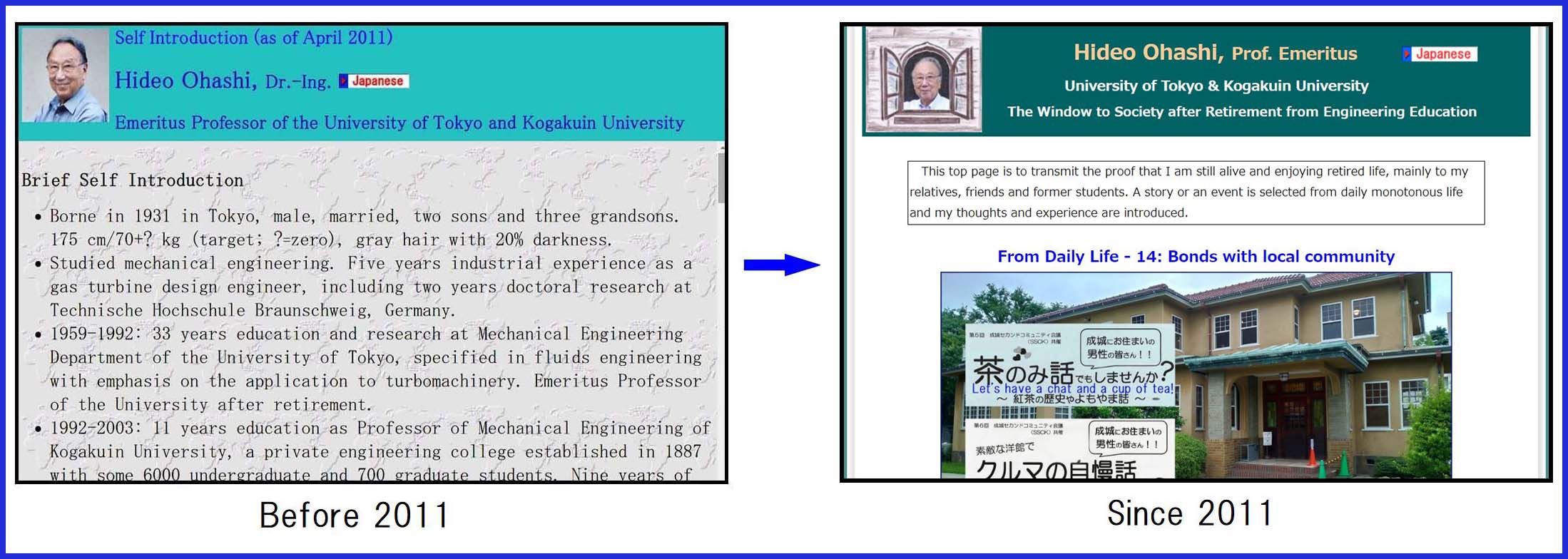
It was around the beginning of 1990s when the browsing of web site became possible and started proliferating. After I retired from the University of Tokyo and transferred to Kogakuin University in 1992, I wished to open my web site (home page) on the server of new laboratory. I wrote contents of the site in three languages, Japanese, English and German, mainly to introduce my career, research and publications. The contents were almost fixed with rare need to update. The German version however disappeared sometime and only Japanese and English versions remained.
From 1994 I served as the president and the chairman of the University successively for 17 years. My commitment to research gradually faded out meanwhile. So I decided around 2000 to move my home page from the laboratory server to a commercial server provided by Nifty (now Coocan). The contents remained as before with little information on private matter.
The turning point came in 2011 when I resigned from the chairman of Kogakuin University and became perfectly free, shortly before I became 80 years old. If one leaves all jobs and stays at home, one’s connection to external world gradually fades out. I wanted to have something like a window through which I can transmit my existence to my acquaintances, friends and many former students. I decided to make a new homepage that fits this purpose.
First I bought a software, Homepage Builder, to design and write new homepage, but avoided an eye-catching design seen in many commercial sites. I adopted the principle; seen simply but deep and honest in contents. In the heading of the top page, I inserted a window through which my face looked outside. “Window to society” was the new mission of my homepage.
The major change was in the role of top page. Top page contained only short self-introduction before and was almost fixed. New top page introduces a selected theme with related picture and article and is renewed fundamentally every month. In addition, I created a new column called “Events” to report events and happenings in daily life with photos if any. This column could prove that I am still alive and active. Also, a new column called “Essays” was set up so that readers could find my rather private articles that were not included in my academic publications.
The English version has a top page with the same purpose, and the contents on research and publications were basically the same as the Japanese version. However, the Events and Essays columns are only in Japanese.
The new homepage has been going on for almost 10 years. It seems that there are many readers who visit my site time to time. Whenever I hear response of readers, I am so glad. I am sure that my homepage is fulfilling its purpose, Window to society, satisfactorily.
The current homepage is unilateral information disclosure and does not accept readers' reactions at all. I hear the opinion that readers want a “Like” button as Facebook does. However, I am still hesitating because the button has both advantages and disadvantages. The English version seems to be read scarcely, but I continue it by all means.
Whenever the end of month approaches, I receive pressure to select a theme and renew the top page, and feel like being chased by deadline. Some reader calls me asking “how are you?” when update of Events column is delayed too much. For me with abundant free time, updating the homepage gives my life tension and rhythm in a good sense and also prevents brain aging. I will continue to keep my homepage as long as possible. I appreciate your interest!
"From Daily Life" -14: Bonds with local community
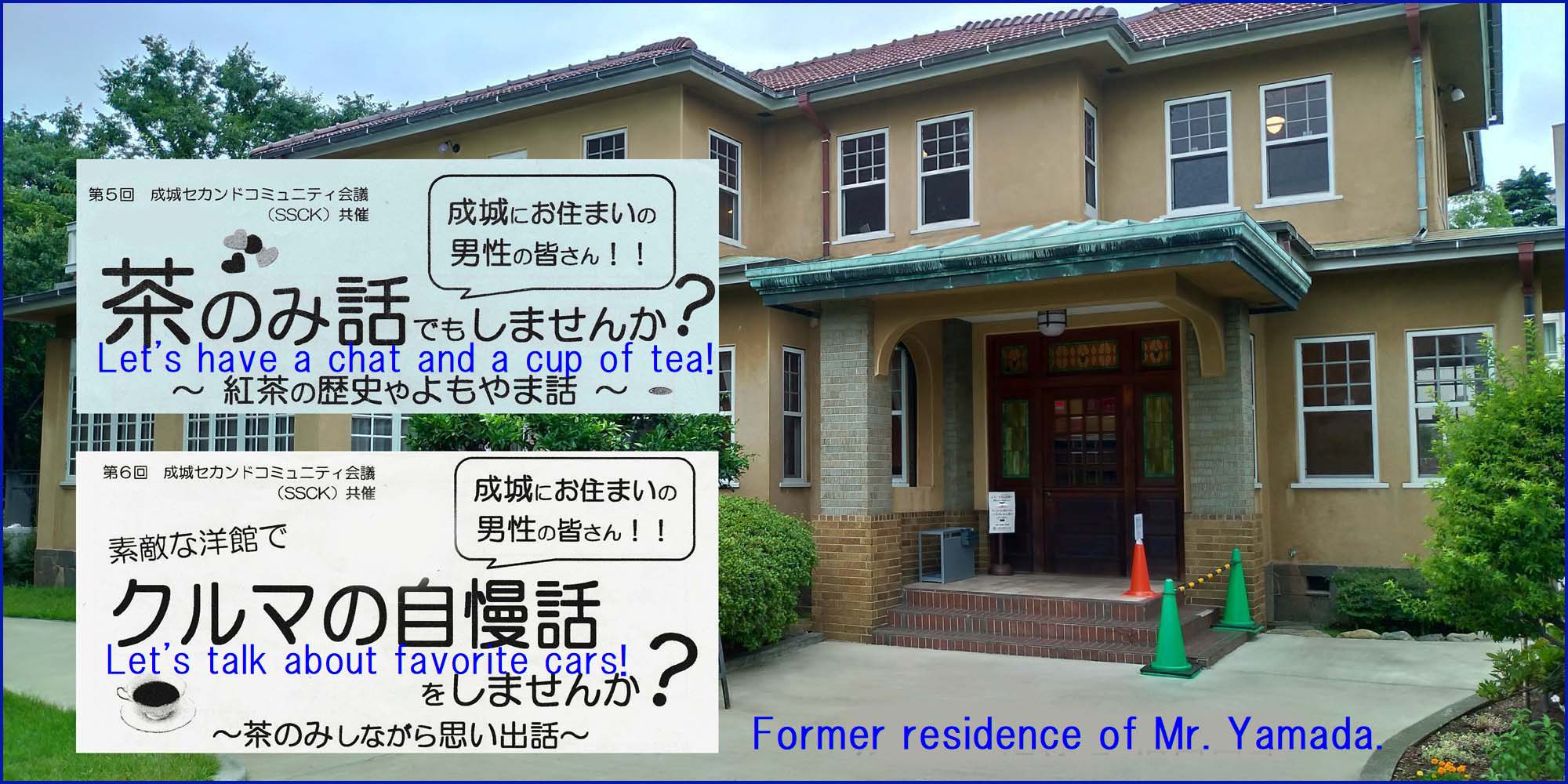
Last September, Ms. N of Seijo Senior Health Center (a branch of local government) visited my home. The purpose was to check living environment of the elderly and to consult on supports as needed. Though 10 months passed since I started single life, I had few local acquaintances besides residents of the condominium where I lived for more than 40 years. In order to avoid social withdrawal (hikikomori), Ms. N introduced several gatherings and events in the local society and advised me to join such occasion to enhance the bonds with local community. She promised me to send necessary information.
Her first advice was not to accept, sorry, because of my schedule, but the next one seemed quite attractive. The gathering organized by SSCK (Seijo Second Community Conference) was held in February this year. The topic was” talk of black tea”, and the venue was a retro-Western-style building, the former residence of Mr. Yamada (bequeathed to Seijo City for community use). The speaker, Mr. H, lived for years in UK and had splendid knowledge and skill to serve authentic black tea. All participants enjoyed the talk and the real taste of tea. It was a small gathering of about 20 persons, but was quite pleasant with free talk within small groups. That was my debut to local community!
SSCK is a group of retired men who live in Seijo. Under the support of Urban Planning Center, Senior Health Center, and Social Welfare Council of Seijo City, the group has been continuing activities to strengthen ties and communication in the community. Although I was a new participant, I was asked to join the SSCK's planning committee. Now, I used to attend the committee meeting almost every month. Certainly, Ms. N’s advice resulted in strong bonds with local community!
Mr. HH, former car racer, is a member of the planning committee. As the next gathering, the committee designed a party for car lovers, putting Mr. HH as the main speaker. When I muttered "My first car was a 1949-model Volkswagen", it called an unexpected response. Many people wanted to hear also the story of super old car.
The gathering was held in July as the sixth SSCK. The venue was the same old residence, where about 20 car lovers gathered. After Mr. HH talked about his hot experience of car racing for about an hour, I had opportunity to talk for 15 minute using Power Point projected on a large TV. I introduced my car history started with Volkswagen, then Renault 4CV and Plymouth Fury, all more than half a century ago. These old cars took a tremendous work for maintenance, but that was the very reason why we feel special affection to them. Listeners shared the same memory. The party was filled with excitement, including mutual introduction of participant's favorite car history.
This was my first appearance at a community gathering, and I had a wonderful opportunity to talk to many car lovers. In this way I would like to deepen bonds with local community from now on.
"From Daily Life" -13: Chichibu Pilgrimage
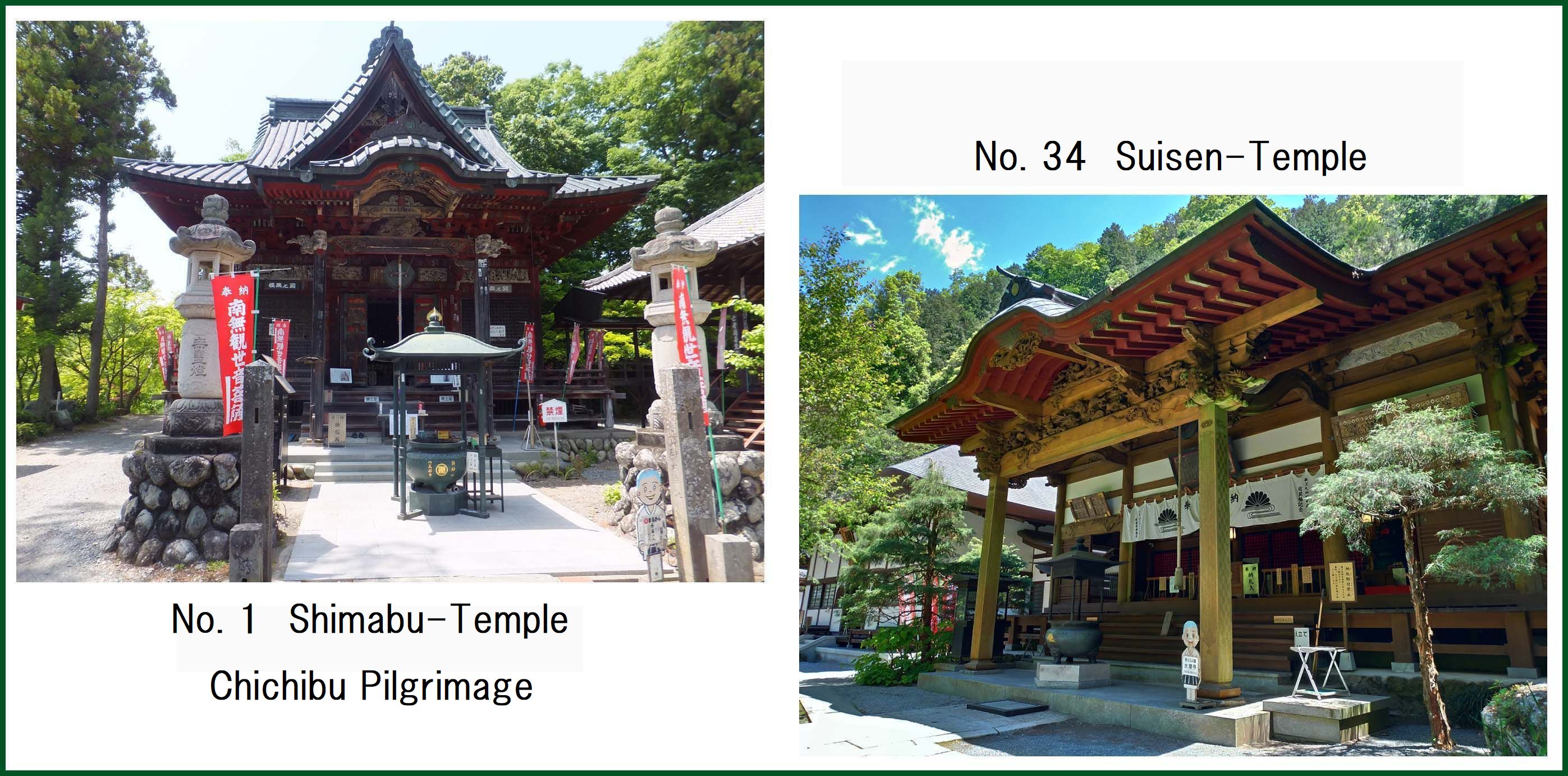
Since last spring, when I became pretty accustomed to live alone, I began to face the problem how to spend abundant time without being bound by anyone. Though I am far from religious, my first idea was to join Pilgrimage to Shikoku Island. However, the Pilgrimage requires more than 40 days on foot and 10 days by car, if one wishes to visit all 88 temples in the island. This idea was unrealistic, and I thought another idea of pilgrimage to temples in Chichibu Basin that is far easy to access.
Chichibu Basin, which can be reached from Tokyo in about 3 hours by car, is a small world that conveys a unique culture. Many people visit there for river boating along Nagatoro Line or for joining in local festivals. In addition, there are 34 Kannon temples scattered over the small basin, and praying in these temples is well known as Chichibu Pilgrimage since long ago. Let’s start pilgrimage from Chichibu, I got into my car last May bound for the basin covered by fresh green everywhere.
Pilgrimage temples are numbered from No.1 through No.34 successively. After I arrived in the basin, I started with praying in No.1 Shimabu-Temple and then succeeded one after another to No.5 Goka-Temple, not on foot but by car, sorry! I overnighted in a pilgrim hotel and eased myself in hot spa. Next day, I visited No.29 and then No.23 Ongaku(music)-Temple where I rang the big bell for farewell before I got back home.
The second visit to the basin took place again in May this year. This
time I decided to visit temples near the end of the series. After overnighting
in a hotel in the city I first went to No.31 Kannnon-Temple, which was
located at the middle of a mountain and could be reached after climbing
up 296 steep stone stairs called Amulet Steps. Then I proceeded to No.33
and finally to No.34 Suisen-Temple, the last petition temple located also
at the middle of another mountain.
Although the location of temples till No.29 is concentrated in the urban area of Chichibu Basin, all subsequent temples are located scattering in the mountain area far from urban area. If I visited above three temples on foot as all pilgrims in earlier time did, it might take at least two full days.
I was happy to realize my dream of Chichibu Pilgrimage, though it was done by using car and in-between temples were skipped. I hung my head deep at temples I stopped by, and prayed for peace of the world, though I have little religious mind or faith. What was the motivation that led me to such behavior?
When I go around temples one after another, my thought goes back to ancient
days when people had to walk on own foot. All our ancestors had strong
determination and faith to overcome every difficulty encountered during
pilgrimage. In old days people had no way but to pray to Gods or Buddha
for the relief from illness and for happier life.
Frankly speaking, I understand that prayer disperses in the sky in vain. However, I understand also from the bottom of my heart how deep the faith in the mind of our ancestors was. I live in the culture and heritages that have been transmitted over generations by our ancestors. Those to whom I pray are not goods or Buddha but our ancestors. I hung my head to dedicate my thanks and respects to them, ancestors of all humankind. I would like to continue my visit to shrines and temples, and even to churches and mosques, in this way.
"From Daily Life" -12: Tama River Walk
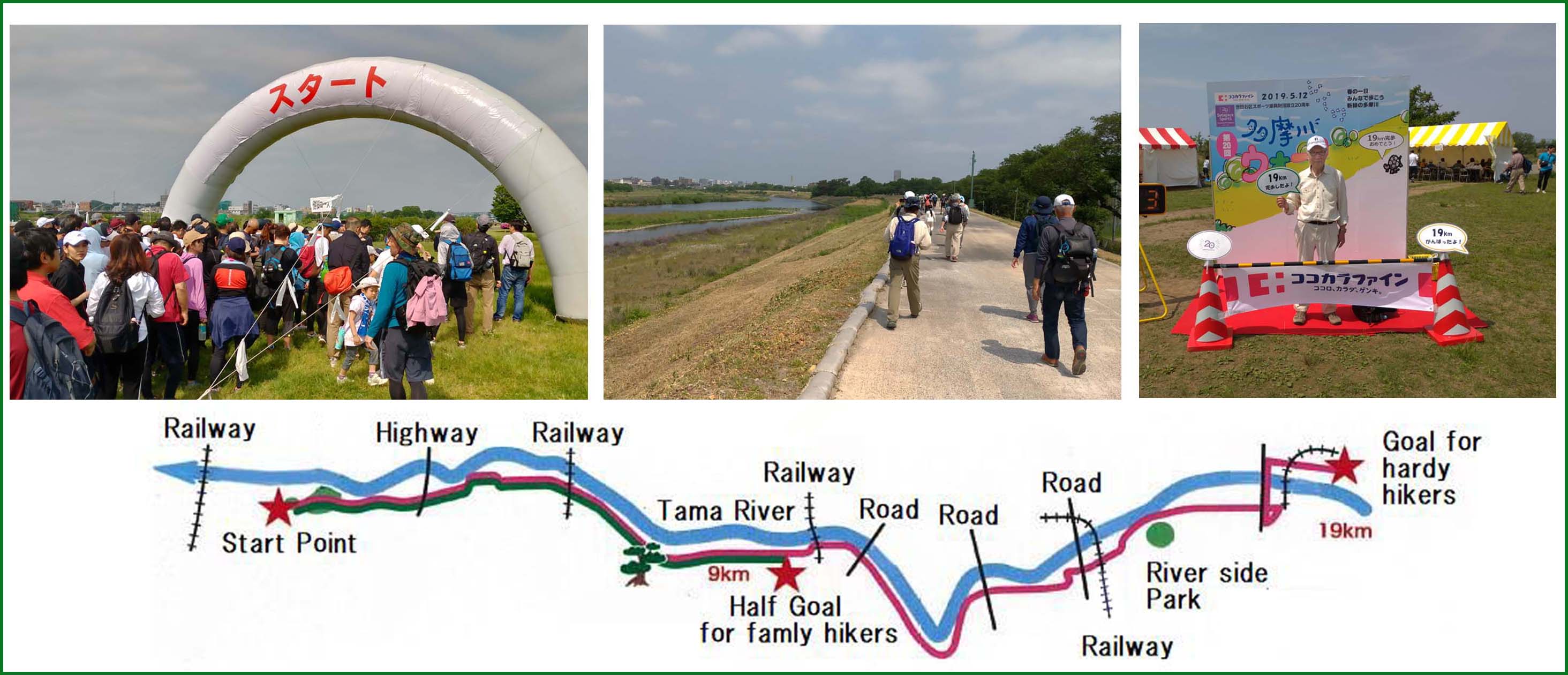
One day in April, one month before my birth day of 88 years old (celebrated as Rice Age), a flyer in newspaper caught my attention, on which large letters “Let’s join Tama River walk” were eye-catchingly printed. I instantly decided to join and registered via internet.
I became 70 years old (celebrated as Rare-old Age) when I was the president
of Kogakuin University. As the memory of reaching the age, I joined “Let’s
Walk Festival” organized by student unions. Then I walked 42.9 km distance
from Hachioji to Shinjuku within 7 hours 20 minutes. I reported the experience once in my past top pages. The experience triggered my willingness to challenge another walking
for the memory of Rice Age.
“Tama River Walk” is an annual event organized by Setagaya Ward where I live. The walk starts from a shore of Tama River near Futago-tamagawa railway station. The trail continues towards upstream through green shores or on the bank of the river. Goal point is set either on 9 km post for family hikers or on 19 km for hardy hikers. I chose, of course, the latter.
On 12th of May, Sunday, two days after I reached Rice Age, 900 participants, old and young men and women, gathered at the start point and waited for the signal gun at 9 am. The weather was a little cloudy. The green shores were scattered with colorful field flowers. Many family groups including boys and girls looked like in a picnic mood.
Since I could find no acquaintance I started walking alone with white sun cap on head and light bag on back. It took some while till I found the best combination of breathing and stepping. During four steps of 1, 2, 3, 4, I took two breath-ins while stepping 1 and 2, and two breath-outs while 3 and 4. After I adopted this double-breathing method I could keep a moderate walking speed with the least effort.
Clouds disappeared gradually. Strong sun light and heat consumed stamina. I took a lot of water, three small bottles, during walking to avoid heat stroke. After 3 hours walk I took ten minutes rest at a river side park and recharged energy by eating chocolate plates.
Shortly before the goal we crossed the river on a long bridge to the opposite side and proceeded to a park, the destination. In the early stage of the walk participants lined up in droves but they spread out gradually and I could see few walkers before and after me near the goal. After I passed the goal gate, I was welcome by event staff with big applause. Photo taking, conferment of Goal-finish Certificate, presentation of a red carnation and memorial gifts waited for me. I was quite satisfactory with all those things.
The Certificate indicated that I took 4 hours 6 minutes to the goal. If I reduce 10 minutes rest time from the record, I kept 5 km/h walking speed for 4 hours. When I was 70 years old, I kept 6 km/h speed for 7 hours. 18 years passed since then. My walking speed deteriorated accordingly but I am quite thankful for the gift that I still keep waking ability pretty well.
I returned home using train and bus. At home I realized I had pretty exhausted. The Sunday was Mother’s day. I presented the red carnation to late wife instead of her sons. Tama River Walk became an unforgettable memory of my Rice Age.
The pictures atop indicate from left to right scenes of start point, middle point and at the goal. The sketch of the course is seen under photos.
"From Daily Life" -11: Eden of peach blossom
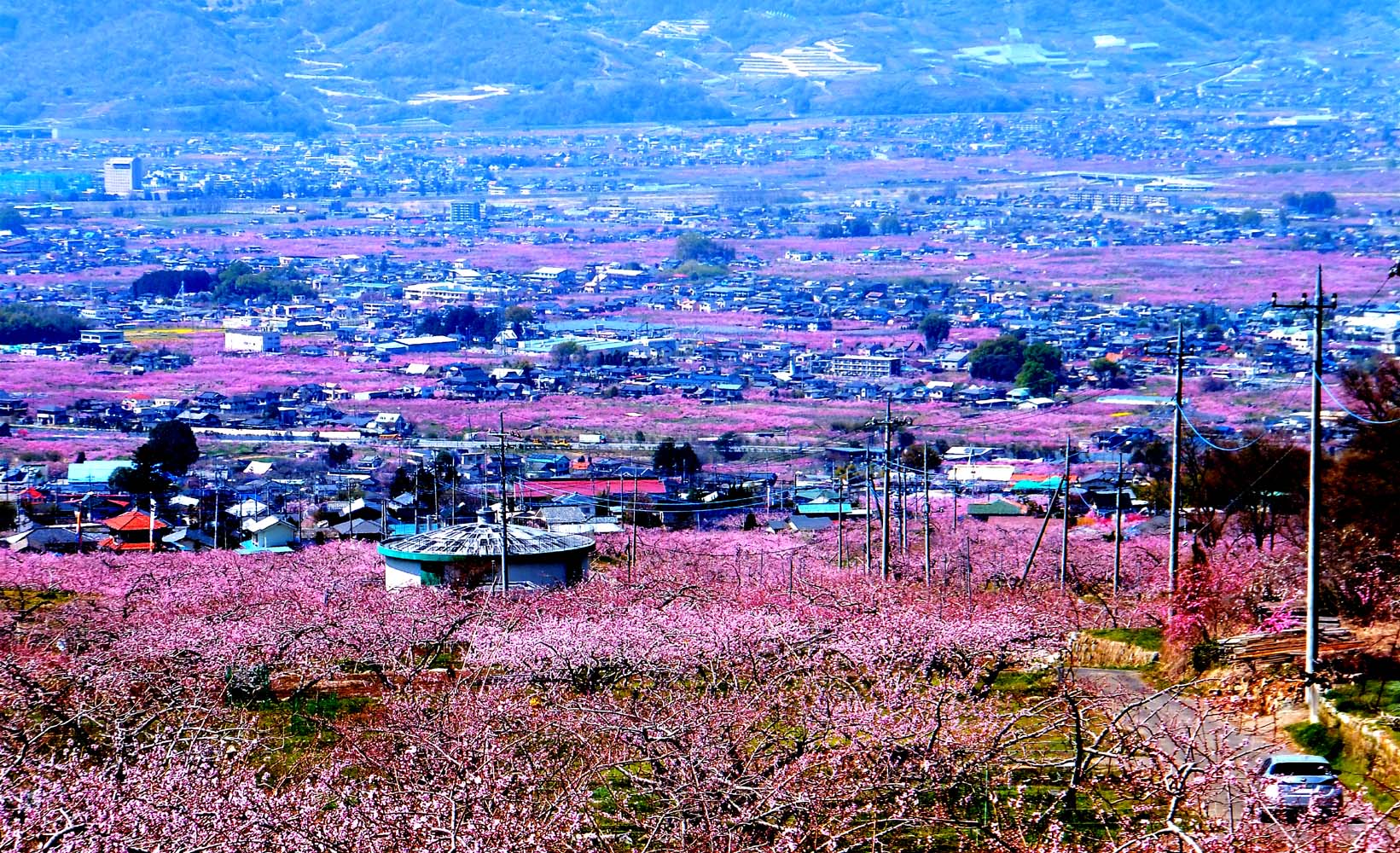
Whenever season of cherry blossom approaches to the finale, I recall the scene of peach orchard scattered around Kofu Basin some 100km west of Tokyo. Plum, peach and cherry are three flowering trees that tell us in turn “spring is approaching”.
Spring comes later in Kofu Basin than in Tokyo. When people of Tokyo enjoy full blossom of cherry at the beginning of April, people of Kofu Basin enjoy blooming peach trees. In that season Kofu Basin looks like a carpet with scattered pink patches as seen in the picture atop. This scenery extends to the foot of mountain ranges that enclose the Basin from all directions. It is indeed a moving view!
Among surrounding mountains the most impressive and even holy-looking ones are the South Alps that block the Basin at the western end. Snow-capped peaks of 3000m-class mountains, including Mt. Kita highest next to Mt. Fuji, give a strong contrast to the mild and colorful scenery of peach orchard as seen in the picture below. The Basin turns to Eden of peach blossom filled with vital power and peacefulness. Everybody wants to stay there forever.
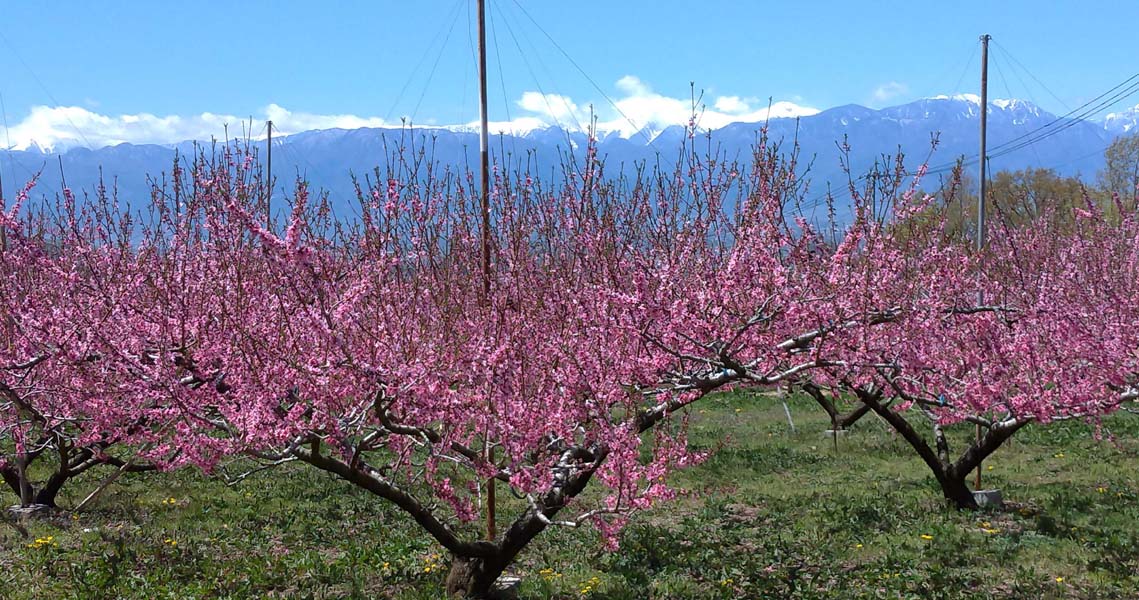
Where I visit almost every year in the peach season is Fuefuki-City that locates in southern part of the Basin. There are many visit-worthy places except peach orchards such as historical shrines and pilgrimage temples. If we cross the mountain behind to the south through a tunnel, there waits us another world where Mt. Fuji plays the leading actor. Early April is the best season to visit there with peaches in full blossom and cherries starting to bloom. I repeatedly visited there with my late wife. My treasure place of memories.
"From Daily Life" -10: Welcomed by cherry blossom
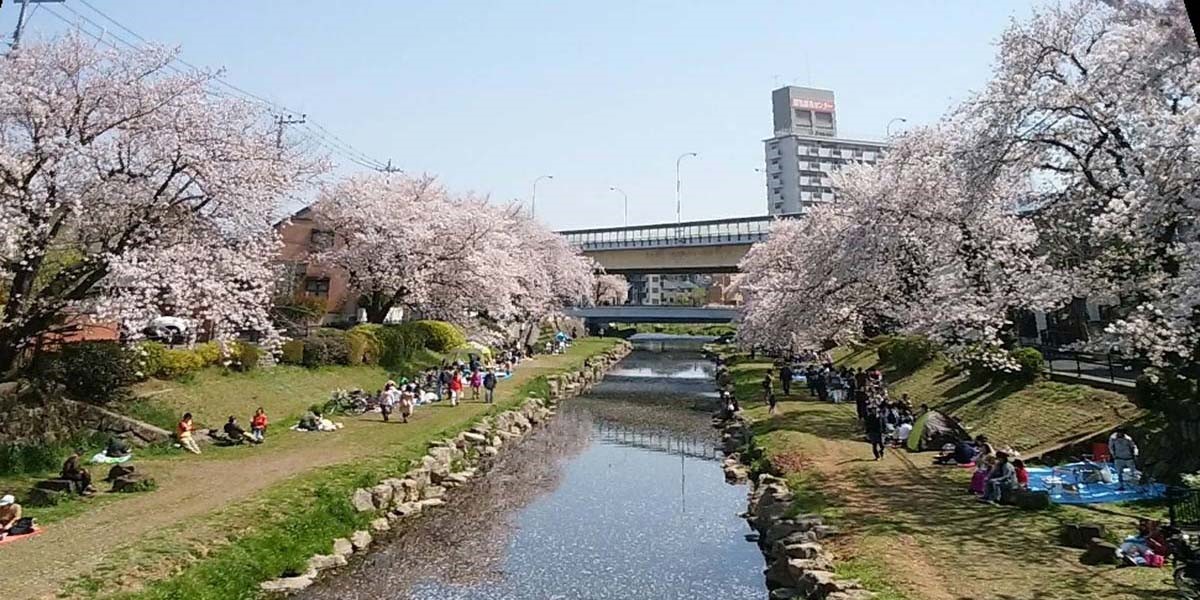
The Tamagawa is the longest river in western part of Tokyo Metropolis.
The river has its origin in west-most mountain region of Tokyo and flows
down 138km toward Tokyo Bay. The Nogawa is a small tributary of the Tamagawa.
Its source is a spring in Kokubunji-City and flows some 20 km in urban
area for the merge point to the Tamagawa. There is a clear river terrace
on the left side. We can find many remains of ancient villages scattered
along the terrace line. Abundant supply of spring water attracted people
to settle in. Seijo where I live is located on a plateau near the terrace
line.
It was spring last year. I started walking regularly after I finished all sorts of matters related to my wife’s decease. One day I found a row of cherry trees blooming along the bank of the nearby Nogawa. I started walking looking for next blooming cherries upstream and downstream. That was the beginning of this story.
It took two days for enjoying the view of upstream side and one day for downstream. Total length was merely 20 km but the relaxed walking welcomed by cherry blossom was unforgettably pleasant.
There are walk ways on both banks of the river. Carps and small fishes are swimming in the water while ducks and egrets are pecking for food on the shore. Nature, though artificially maintained by local governments, remains pretty well in densely populated urban area. Most gorgeous season is, of course, spring. Chain of blooming cherry trees extends over kilometer and kilometer!
The picture atop is a scene taken on a Saturday during a Cherry-Festival organized by local city. Many family groups were enjoying picnic under blooming cherries.
 On week days we see only few walkers and joggers on riverside. It’s so precious to monopolize the scene as in the right picture. The whole scene was for myself!
On week days we see only few walkers and joggers on riverside. It’s so precious to monopolize the scene as in the right picture. The whole scene was for myself!
The Nogawa is merely a small branch of the Tamagawa. After I had walked the whole range of the river, I found the river bears irreplaceable role as an oasis in urban area and also serves as an emergency drainage channel against heavy rainfall.
"From Daily Life" -9: Living alone in my second year
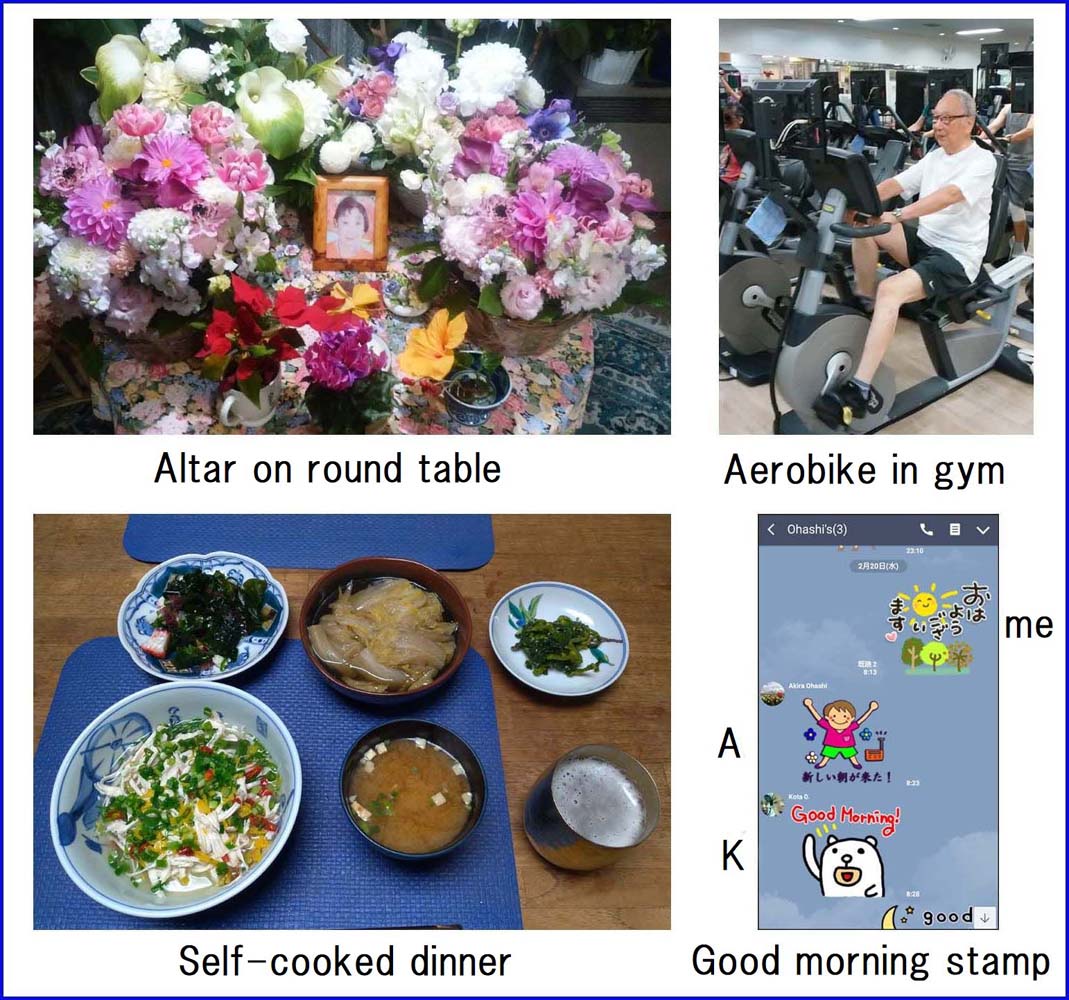
In December two years ago, a round table set near a sunny window of our living room became an instant altar. After I returned home from the funeral of my wife with her cinerary urn, I placed it on the table surrounded by many flower bunches and arrangements given by relatives and friends. Two months later the urn was finally moved to the cemetery near the University of Tokyo. Since then the urn on the table was replaced by wife’s portrait and the table turned to our permanent home altar. Today the portrait is smiling surrounded by several kinds of seasonal flowers bought or raised home.
Since my wife passed away little change has happened in my home. Though the number of beds in the bedroom reduced by one, arrangement of furniture and even setting of picture and photo frames on walls are almost intact. If my wife were back home again, she would hardly notice that she was absent for more than one year.
What has changed most drastically, may be I myself. I used to call good morning to the portrait on the table every morning. If there were a hydrometer to measure my voice, it would clearly point out that my voice has gradually changed from wet to dry tone as time goes on. Time has tremendous healing power! As a cut on skin heals up regardless of one’s wish, pains of mind also ease up as time goes on. Wonderful gift from Heaven!
It was last spring when I became perfectly free after finishing miscellaneous formalities related to the decease of my wife. Then I was confronted for the first time in my life with the problem how to spend superabundant free time restricted by nobody. It’s pitiful that I have no hobby to dedicate. I ridiculed myself by describing my life as days without any purpose and accomplishment. I have been looking for a mental attitude that may accept positively long lasting monotonous days. After reading many books and articles on second life, I have finally reached the following way of thinking.
Cooking three times, washing clothes, cleaning rooms, going to gym, reading books, facing display of computer; there are countless affairs even in a monotonous day. They are the very substance of being alive. All value and joy exist in them. Today exists not to wait for a memorable day but to live today. Be relieved from object-oriented mind! Life has value in itself.
Every morning I exchange “Good morning stamp” with my two sons, A and K, via LINE. Such trivial affair enables us to ascertain we all are alive, and is a source of big joy.
The above attitude for second life eased my self-ridicule and helped me to accept lasting monotonous days with joy and confidence. In my second year of living alone, I will keep my daily life well in order and catch positively opportunities to contact with external world. Health is most essential premise to materialize such life. I am so grateful for the gift that I still keep power and mind to live on independently.
"From Daily Life" -8: Moving from old to new smartphone

It was 7 years ago when I changed my mobile phone from a traditional flip type to a smartphone specified for beginners. The phone named “Easy Sma-pho” was really simple to handle and also firmly protected against misuse and external attack. Only preinstalled and recommended applications were usable in order to enhance security. I could not play Pokemon that was booming at that time. I was gradually frustrated by the strong restriction of the phone.
After using the phone for 4 years, a chance came to move to a new phone. I knew that my son changed his mobile carrier from a major carrier to a MVNO (Mobile Virtual Network Operator), IIJ, and reduced the monthly charge less than half. I followed the same way and bought a new SIM-free smartphone, named Arrows manufactured by Fujitsu. That was a standard Android phone and the installation of applications was fundamentally free. I finally graduated from a beginner and could make the most of convenience offered by network society.
As time proceeded, I became again a little frustrated because performance of the phone was too low, with poor CPU and insufficient internal memory (16GB). Installation of new applications became difficult for lack of memory. End of the last year I decided to buy a new phone as the year-end gift to myself.
I started to look for a new phone that satisfies my present and future needs. There are numerous smartphones with different makes and manufactures on the market. I reduced the candidates by the filter; SIM-free Android phone with 64GB memory. I first wished to choose from domestic manufactures, Sonny, Sharp and Fujitsu, but found they were less competitive in smartphone business. Now Huawei (China) and ASUS (Taiwan) are leading SIM-free phone market. They are offering a variety of makes ranging from top grade with 128GB or more memory to entry grade with 32GB memory. The price spreads from over 100 thousand to less than 20 thousand Yen.
My final choice was ASUS’s Zenfone 5, with 64GB memory, two main cameras, fingerprint authentication and face recognition. I bought the phone from net market with less than 50 thousand Yen, very reasonable!
Immediately after I obtained the phone I started moving. First step was to pull out SIM and microSD from the old phone and to insert them to the new. Then I transplanted all applications and accounts stored in the old into the new, following instruction carefully by myself. Only one mistake I made was the moving of LINE account. My son intervened and found the right way. I could start using the new as if I were using familiar old one.
Quite a lot of personal information are stored in a smartphone. In order to avoid abuse by someone else, every phone is locked while it sleeps. To unlock the phone either input of password, fingerprint authentication or face recognition is required. Most easy way is face recognition, for which we need only to hold the phone in front of face. Though it is not so clear how the recognition can distinguish similar faces, face recognition is surely the most convenient way of personal authentication.
Cashless society is rapidly proliferating. Soon I would have to use electronic payment by phone. Now I am ready to adapt to smartphone society!
"From Daily Life" -7: Lesson in Hiragana writing by brush

I participated in a course of lessons organized by nearby Seijo Community College from last October through December. The selected theme was Hiragana writing by brush (calligraphy of phonetic letters). That was motivated by the fact that the quality of my hand writing has been deteriorating since I have few opportunities to write by hand. I wanted to refurbish my hand as a beginner. The Course consisted of 6 lessons for 80 minutes starting at 6:30 pm. The teacher, Mr. Tsurusaki, taught from fundamentals how to prepare ink, hold brush, move arm and so on.
Hiragana is usually written smoothly and continuously just like a stream flows down. So, I had the prejudice that one should move brush swift and dynamically. That was a total misunderstanding. Calligraphy should be performed not on dynamic balance like aerobics, but on static balance like Tai Chi. Hold brush firmly and move arm slowly tracing images of letters that come one after another! It took some while to master right way of moving brush.
Besides Hiragana we daily use there are a variety of anomalous versions that appear in old documents. At the last stage of the course we challenged to write these unfamiliar letters. Our graduation work was to write a Japanese short poem (Waka). The given example was a masterpiece of Important Cultural Property written by a famous calligrapher. The poem means “A group of cranes is flying in the blue sky, they look like they are wishing happiness in the New Year!”
I bought a Christmas card on which five cranes are flying in front of Mt. Fuji. Then I enlarged the card and wrote the poem by brash on the sheet. The illustration atop is the work. Of course it is no comparison with the given example but I dare show you my work since I tried my best. The final result of joining the course was to ascertain that the way of calligraphy is deep and far!
Be the coming year a happy and brilliant one as the cranes wish!
"From Daily Life" -6: Fuji View Hote
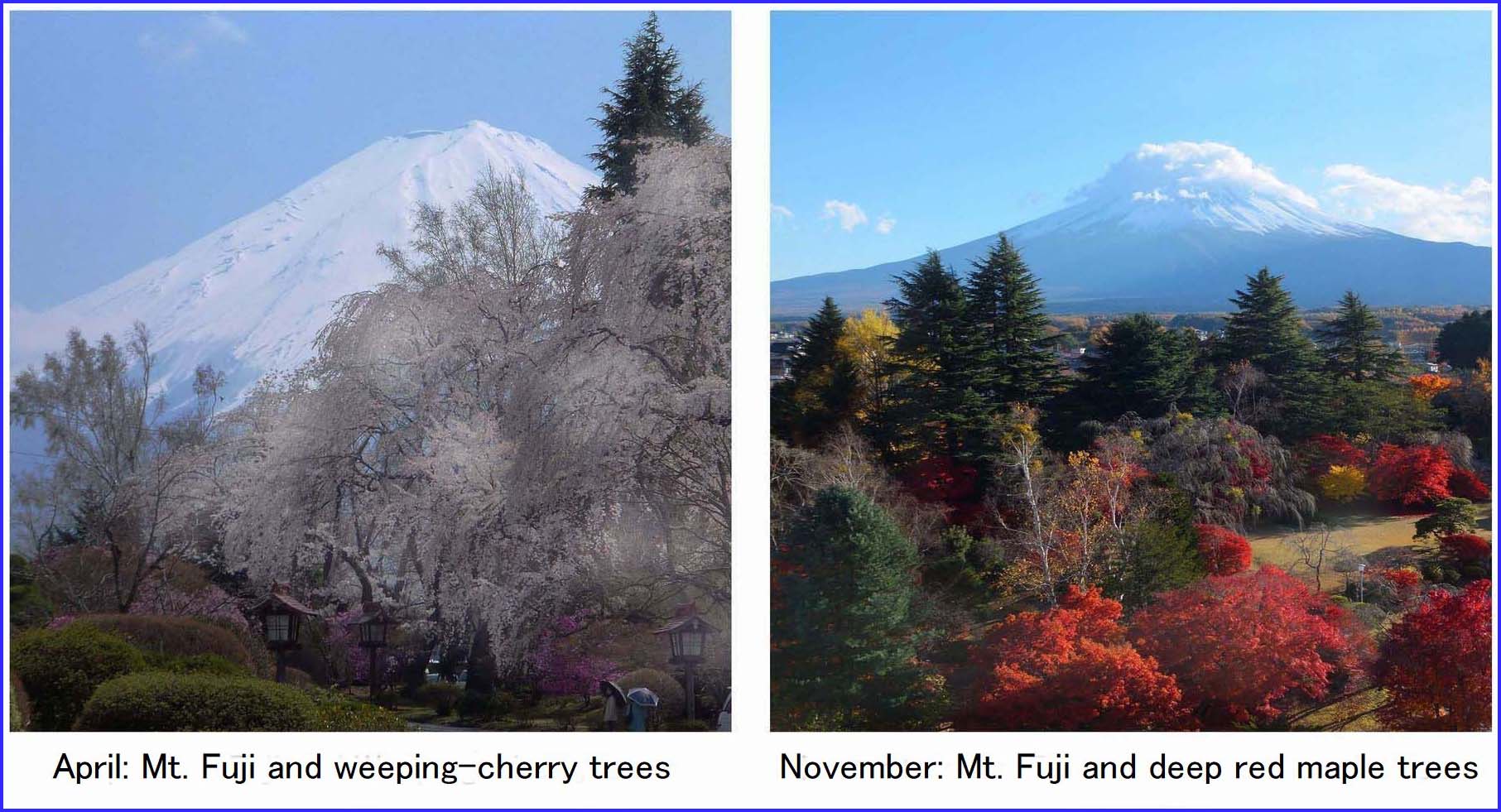
My passed wife loved Mt. Fuji. Whenever she saw beautiful view of Mt. Fiji from the home balcony, she talked to me “Today’s Fuji looks very fine!” When Fuji attracted us too much, we decided on a whim to start up a drive bound for Fuji. That happened a few times a year. The destination was always Fuji View Hotel.
Fuji View Hotel stands by Lake Kawaguchi, facing directly Mt. Fuji backed by the lake. The view of Fuji over front yard of the hotel was spectacular especially in the season of cherry blossom in spring and coloring of maple trees in fall. Co-starring of snow-capped Fuji and trees in high season was beyond the category of beauty and gave us rather feeling of godliness and even aura. Please imagine the scene from the above two pictures taken in Aril and November.
There are two observation rooms atop the roof of 5-story hotel building at both ends. Visitors can enjoy open panoramic view, Fuji in front and the lake in back. Just viewing around, taking photo or sketching; everybody would find the best way to stay there. We visited there every time.
On the first floor of the hotel there is a tea loung e facing large back yard. We used to drop in there and took coffee and
sweets looking outside flowers and trees of the yard. I once introduced
the right picture titled “Last long-distance drive” in the Memorable Scenes
Series 7 of this top page. This picture was taken in this lounge. A young
couple of the neighboring table proposed kindly to push shutter button
of my camera. They caught a wonderful shutter chance. The large portrait
settled on the altar at her funeral was cut out and enlarged from this
picture. After spending some while at the hotel we drove around along the
lakeshore road and returned home.
e facing large back yard. We used to drop in there and took coffee and
sweets looking outside flowers and trees of the yard. I once introduced
the right picture titled “Last long-distance drive” in the Memorable Scenes
Series 7 of this top page. This picture was taken in this lounge. A young
couple of the neighboring table proposed kindly to push shutter button
of my camera. They caught a wonderful shutter chance. The large portrait
settled on the altar at her funeral was cut out and enlarged from this
picture. After spending some while at the hotel we drove around along the
lakeshore road and returned home.
The destination of our honeymoon trip 58 years ago was Fuji-ya Hotel at Miyanoshita, Hakone. Fuji View Hotel, the sister hotel of Fuji-ya, became the destination of the last long-distance drive with my wife. I feel strong affection for this hotel with the memory of trips shared together.

"From Daily Life" -5: Begginer at the gym
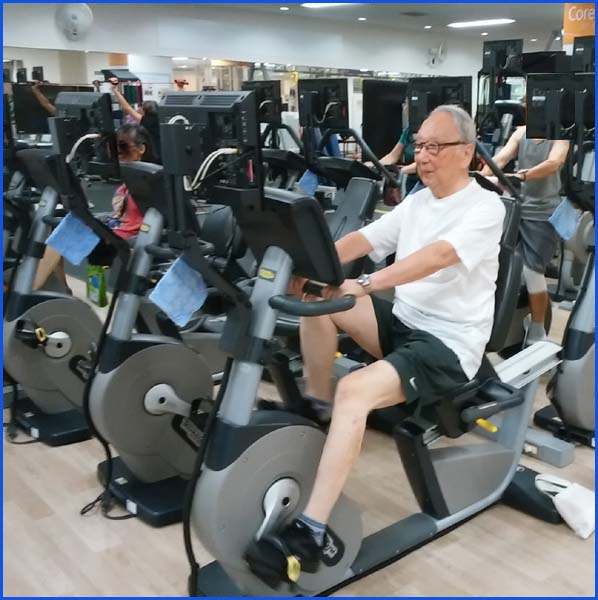
Athletic gyms are popular place for those who wish to keep health by physical exercise. I became member of a gym two months ago at the age of 87. I will tell you my motive and experience so far.
I was pretty busy for 3 or 4 month immediately after my wife passed away last year. There were so many things to finish such as responses to condolence, inheritance procedures, cleaning out of belongings and so on. When such a period was over, I felt needs for moving body regularly. It was just the season of cherry blossom. I started walking looking for beauty spots of flowers day after day. Walking became my main source of exercise. As summer approached, outdoor walking became gradually tough and the danger of heatstroke increased. Then I thought of an alternative, going to a gym.
There is no well-equipped gym in my town, so I visited a gym for reconnaissance near the next train station. The gym was filled mostly with middle aged ladies who sweated out on running machines and muscle-training gadgets. I felt great hesitation to join and retreated away. After a while I met a former student and told the story. He, an enthusiastic gym visitor, suggested me to try once and said there are many ways of utilizing the facilities and one may find most suitable way to fulfill one’s need; walking in swimming pool is also a choice.
At the beginning of September I decided to become the member of the gym I visited once for reconnaissance. On the first day the trainer checked my body and measured the amount of muscle and fat. He diagnosed that the urgent need is to reduce excessive visceral fat. Then he wrote special menu for my exercise, that is, 10 minutes aero-bike for warming up (as seen above), muscle trainings using four kinds of machines (each 20 repetitions) and finally 20 minutes aero-bike. Total consumed energy is about 200 kilocalorie. It takes about one and a half hours including shower and change of clothes. I finish gym visit usually in the morning.
I have visited the gym at least twice a week, three times if possible, and accomplished the menu faithfully, dreaming the day to announce joyfully “Farewell to metabolic syndrome!”
At the middle of October, after one and a half months of exercise, I received a follow-up body check. The result was miserable against my expectation. Muscle lost 1 kg but body fat gained 1 kg. Effort resulted in negative effect. I could not understand why. I never ate too much using the exercise as an excuse. Devils shouted “Stop useless exercise!” but angels persuaded “Patience is the last winner!” I was quite disappointed but decided to continue at least half a year. Positive change would appear hopefully. I would seal off the dream of spectacular change between before and after for the time being.
"From Daily Life" -4: Battlefield rations
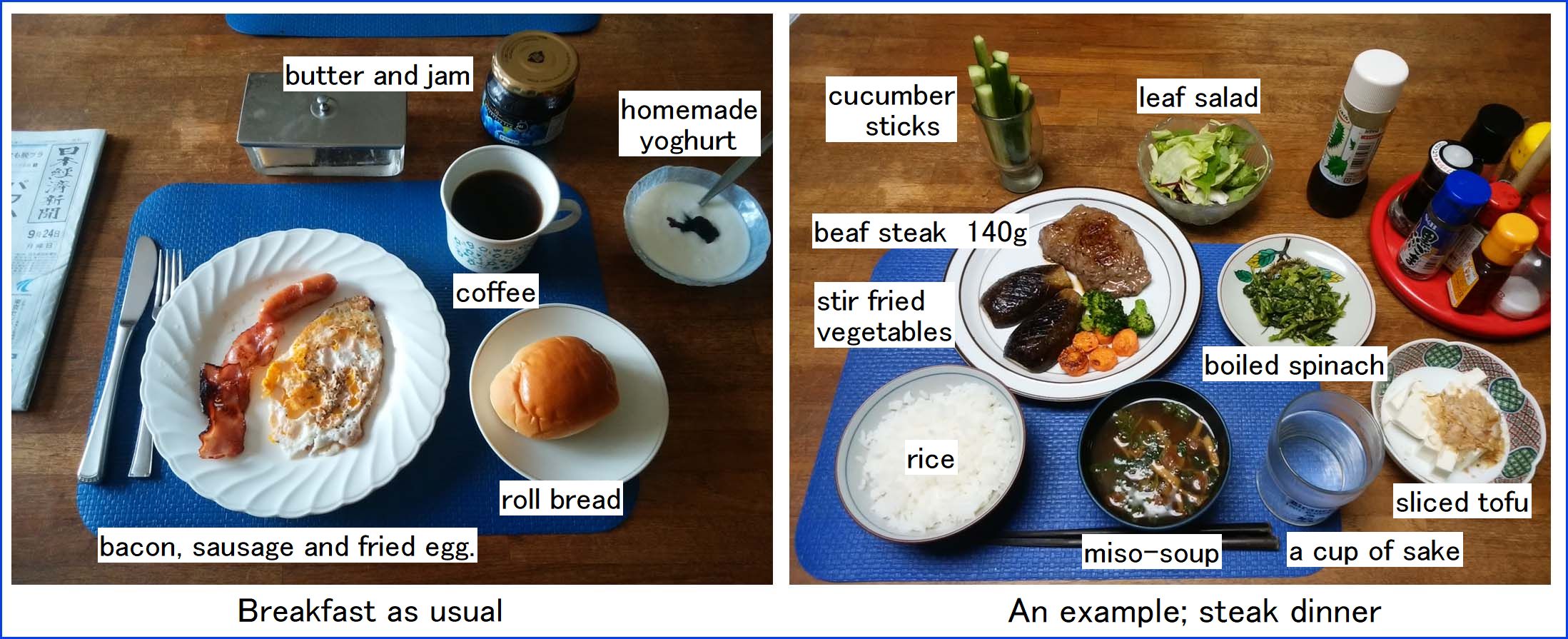
Ten months have passed since I started living alone. Household affairs include cooking, washing, cleaning, etc., etc. but cooking requires the most effort. Many advised me to utilize meal delivery service but I was reluctant. I scarcely go to restaurant by myself or buy lunch box at convenience stores. It became my custom to cook three times a day for myself. That was a natural sequence after I had been taking care of my wife’s meal almost for two years.
Breakfast is quite a stereotype for years. Fried egg with small portion of bacon and sausage, a roll of bread, coffee and homemade Caspian Sea yoghurt, that’s all as you see on the left of the above picture. It takes only five minutes to prepare all the things on the table. I take sufficient time for breakfast while reading newspaper or looking morning show of TV.
Lunch depends on daily mood. When I was on active service, I used to skip lunch to save time and calorie. But after retirement I revived lunch just to keep rhythms of the day. Noodle, steamed bun, donut, banana, cookie and so on; small amount of eatables plus tea or coffee is my instant lunch.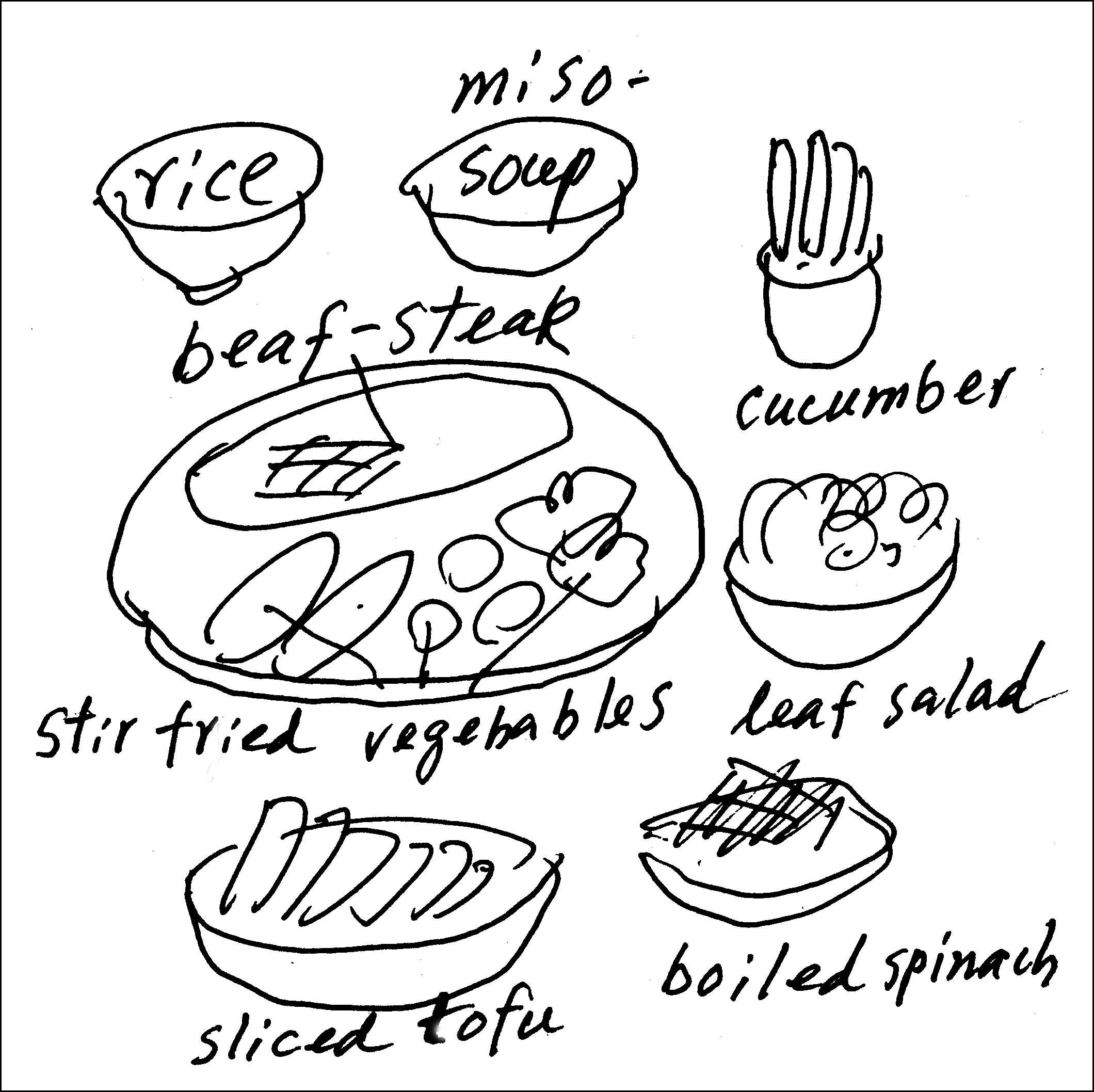
Main meal is, of course, dinner. I start thinking what to eat about 6 pm. On a small sheet of paper, I actualize my idea as a sketch of dishes as shown left. What are stored in the refrigerator and shelves? How is the balance of protein, starch, plant fiber and vitamins? All considerations are condensed on this sheet called dinner design.
Once after the design is fixed, only handwork in the kitchen is left. What I do is just to boil or stir fry for short time because every time and trouble consuming process is avoided in the design. Cooking time never exceeds 15 minutes. The result of the desin is shown on the right of the above picture.
Dinner is accompanied always with a small amount of alcohol; beer, sake, spirit, wine, whisky and whatever stored in shelves. About 6:30 pm I start drinking and eat first main and second dishes with the drink. Rice and miso-soup follow then. When TV starts news program at 7 pm, my dinner is almost over and I feel full and delightfully high. I have never experienced such a situation that my dishes were so bad to eat. My tolerance about food tastes seems very high.
My principle on dinner is the highest consideration to nutrition with the least cook work. I call my dinner battlefield rations. Soldiers on battlefield must ingest maximum energy, but the cooking must be finished within minimum time. The situations are quite similar.
"From Daily Life" -3: August 15, my memorial day
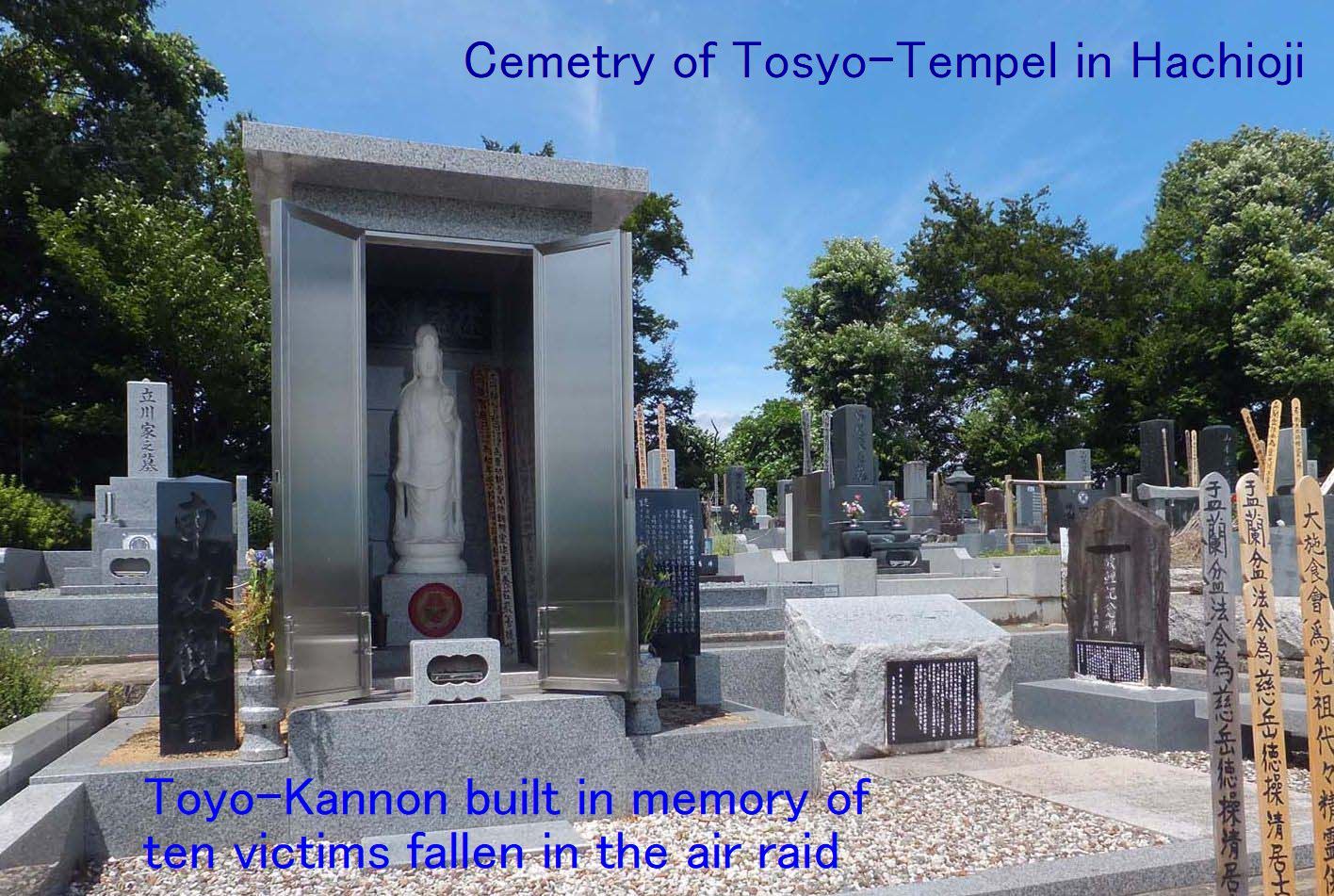
Mid-August is the season of Lantern Festival of Buddhistic tradition. August 15 is the central day of the Festival, and is also my memorial day which I can’t forget forever. I will tell the story which I experienced in the summer of 1945, the year of Japanese surrender in the Pacific War. I was then 13 to 14 years old.
In April of the year I entered Tokyo Army Cadet School after I finished first-grade at Metropolitan No. 4 Middle School. It was thought then that the education starting with Cadet School followed Military Academy and Army War College was the best course for successful career as an Army officer. My father, Lieutenant General, fell in battle in the previous year and I wanted to succeed his career. The Competition to enter Army Cadet Schools was quite severe in the mood of total Militarism at that time, but I was lucky to break through the challenge.
When I entered the school, Philippine islands fell already and large part
of Tokyo was burnt down by air raids. The war situation seemed so critical
but the rookie future-officers were all so in high sprit that they would
rescue the nation. Tokyo Cadet School was located on a hilly land north
of Hachioji City, west of downtown Tokyo. The education was carried for
3-grades with full boarding system. In the morning lessons of all subjects
including foreign language were given, while physical exercise and training
were done in the afternoon. Character building was done in a small group
of pupils sharing the same bed room under the guidance of a tutor (captain-class
officer) and a model 3-grader.
Immediately after my entrance, combat in Okinawa began and the sign of defeat forecast that the next attack would be direct landing to the mainland. Toward the end of July three days special leave was granted to all pupils for saying farewell to their parents before desperate battle expected in near future. My mother together with my two sisters and a brother had evacuated already from Tokyo to a countryside where my father was born, some 250 km apart northward in Niigata Prefecture. I reached there after riding a steam-locomotive train for several hours.
My mother said she would cook whatever I wanted for the farewell dinner. I requested croquette. I ate too much but the consequence was miserable. I got severe diarrhea and could not stand up. My mother sent telegraph to the School and asked the extension of the leave.
About 10 pm on August 1, before the day I planned to return to School,
I found bright red color in the south-western sky. I knew soon that Nagaoka
City some 40 km apart was totally burnt down by air raid, but knew far
later that Hachioji City was almost simultaneously burnt away by 1600 tons
of bombs. My Cadet School was also the target of the raid and turned to
ash by 30 thousand incendiary bombs. Ten school staff and pupils became
the victims of the raid.
Early in the next morning, I left for Tokyo with my mother and eldest sister. After arriving Ueno terminal station, we took electric train for Hachioji but the train stopped at Shinjuku Station because of air raid warning. We three had no choice but to overnight at the station. We saw again red burning sky to the west.
Next day, on the 2nd, I arrived at the School with my mother, but found only ruins. After a while I could find my tutor and classmates in an emergency barrack built in the forest behind. I have no clear memory how we spent time till the day, August 15, came.
Unforgettable day came. Whole member of the School, from the principal to pupils, gathered at a flat field surrounded by remains of burnt buildings and waited the noon, start of radio broadcast of the Emperor’s message. The broadcast was full of noise, but we could understand what happened. Mind became blank.
The principal and tutors kept however admirable coolness. They might be
aware beforehand what would come. They immediately started actions to send
pupils safely back to their parents. In ten days all students left the
School and returned home. Before the farewell they received the last instruction
from their tutors, “Try the best for rebuilding a nation which can boast
her culture!”
I returned to my mother and started new life in the house where my father was born. From September I was accepted as the 2-grader of Muramatsu Middle School, 4 km apart from home. The days started to walk 4 km way morning and evening along a straight road in rice field, under strong sunshine in summer and in snowy storm in winter. I recognized soon that my body started to change. In two or three years I changed from a frail urban boy suffering from dyspepsia to a country boy with robust mind and body. August 15 is my memorial day that triggered my metamorphosis.
If I did not ask my mother to cook croquette, I could be involved in the air raid and became one of victims who are condoled in memory by the Toyo-Kannon shown in the picture atop. I live 73 years long beyond the day guided by mysterious but lucky destiny.
"From Daily Life" -2: The second last car

Ten years ago I bought Honda Civic as the 11th private car. I was then
77 years old and though that the car might be the last car of my life.
I thought further the car should have some similarity to my first car,
Volkswagen bought in Germany in 1957, besides having easy drivability and high reliability. If so, the last
can be connected to the first, a happy return! Volkswagen means car for
people, that is, a robust and substantial car serving for majority. Civic
was finally chosen from domestic car makes based on this viewpoint.
I have taught mechanical engineering in universities for fifty years and quite a number of graduates are working for automobile industries. I once thought that I would like to ride at least one make of all domestic car makers in my life to support and encourage these students. I have appreciated already 9 makes of 5 domestic makers and the coming should be selected from two remaining makers, Mazda and Subaru,
Honda Civic has run quite satisfactorily so far without noticeable accidents
or troubles. I have no complaint at all. Especially since my retirement
7 years ago, I have had countless opportunities to drive and travel with
my wife sitting beside. The car is the canning of memories of my passed
wife. Then, what is the motivation to replace the car?
The reason is the rapid progress of preventive safety devices that reduce careless accidents of aged drivers almost to one-tenth. If I wish to continue driving further for the future, the earlier the switching to a safety car, the lesser the probability of committing serious mistakes.
So, search for a new car has started. I studied makes of Mazda and Subaru first on the net and selected two candidates, CX-3, SUV of Mazda and Impreza SPORT, hatchback of Subaru. The value was laid on compact size, easy drivability and available preventive safety devices. Then I visited two dealers and drove these two makes for test. After driving for short time and distance, I could not find definitive advantage or disadvantage of them, but I finally chose Subaru Impreza.
The ultimate motivation of choosing a car may be not a rational reasoning but something like affinity or connection. My younger brother is riding Subaru and recommended me strongly, mainly because his son is working for Subaru. My university classmate Y, now retired from Subaru, offered his engineering career to develop water-cooled horizontal boxer engine, one of Subaru’s highlights technologies, and gave me a lot of information and advice. My first car Volkswagen was equipped with air-cooled horizontal boxer engine. “Horizontal boxer engine” became the common key word connecting my first and last car. Subaru far exceeded Mazda by the scale of affinity/connection
After waiting half a month the car was delivered. Driving is one of joys that activate monotonous retired life. I hope my 12th car, the second last car, may help me continue the joy so long as I stay healthy and active.
"From Daily Life" -1: Tracing family roots
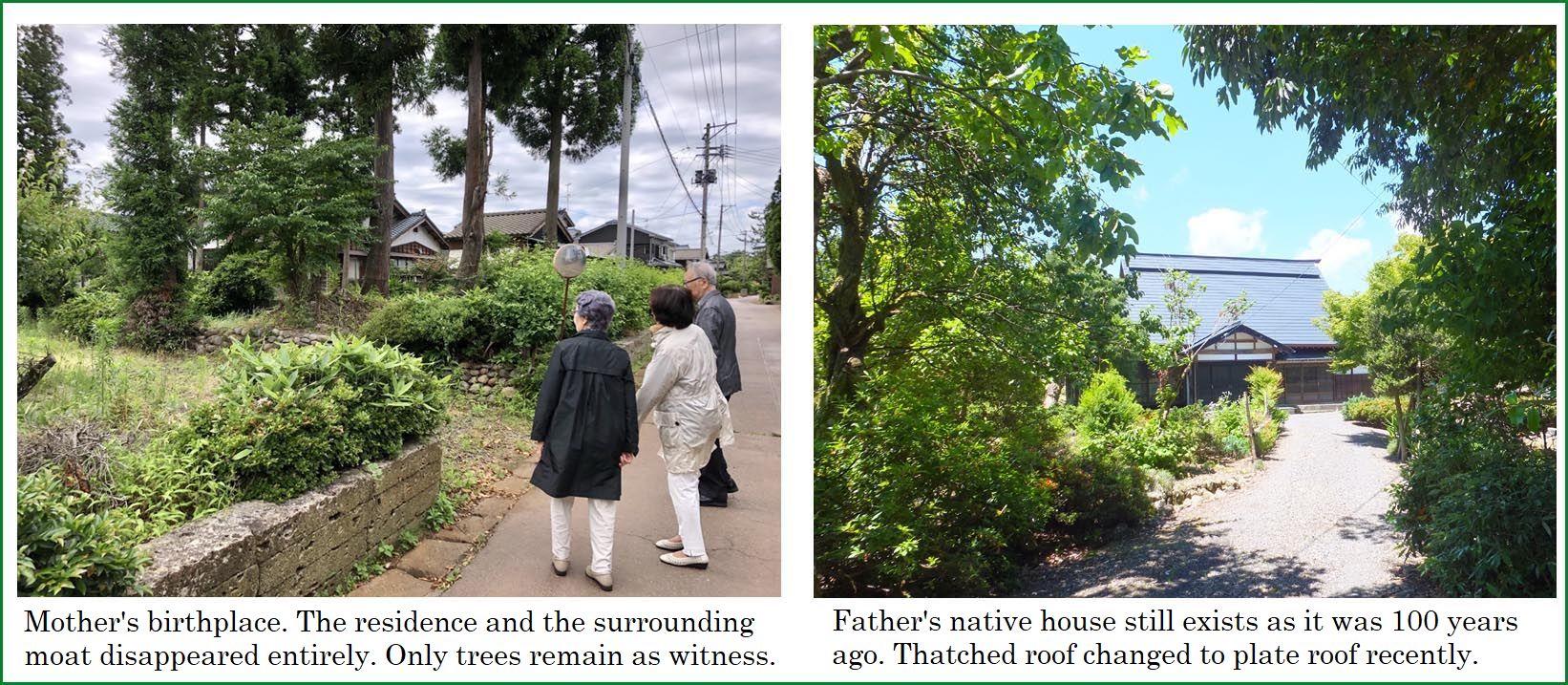
My first son, A, is an enthusiastic collector of family trees. He has edited family trees of many relatives and been maintaining them up-to-date. Everybody has parents. The first step is to complete two family trees of paternal and maternal side. Those who join in a family tree as a spouse, introduce two different trees of their parents. If we search these related trees to the generation of grandparents and great-grandparents, there are uncountable family trees of relatives. It’s impossible to search them all.
Immediately after Meiji Era started, the government laid down a brand-new Family Register Act in 1871. All members of a family tree are theoretically traceable up to that time. Members before the introduction of the Act are traceable only for families with special fame and status. In my case, the paternal side belongs to the former while the maternal to the latter. In the maternal family tree of my wife, many famous politicians of Meiji Era are found like the first Price Minister Mr. H. Ito, the first Foreign Minister Mr. K. Inoue and the first Governor of Yamanashi Pref. Mr. S. Fujimura. Such family tree reminds afresh that blood connection was so influential in old days.
My mother was born as the first daughter of a family that served headman
of former Fukushima-village that located in the midst of rice-producing
Echigo Plain of Niigata Prefecture. Since the first son, the heir, finished
higher education and worked outside the prefecture, the residence and the
moat surrounding the ground disappeared entirely. Only old trees remain
as the witness of the past.
The house where my father was born still remains almost as it was 100 years ago. It is only 25 linear km apart from my mother’s birthplace but can be reached after crossing a mountain pass. He was born as the first son of a farmer family in upland valley but left home since he selected the career as army officer till he fell in 1944 as Lieutenant General. His younger brother inherited the house and the grand-daughter maintains the house at present. Since I lived there for two years when my family was evacuated from Tokyo to avoid air raids around end of the last war, I still keep many memories of the house.
My eldest sister Y, 94 years old, and I planned a tour to visit birthplaces of parents. Y’s daughter and my son A joined the team and all came together at Tsubame-Sanjo Station around the noon of June 16. We rented a car and started the tour from the birthplace of my mother. Then a small shrine standing alone in vast rice field that is said to worship the ancestors. Finally a temple called Chonen-ji where the tomb of ancestors is located.
Next day we crossed the pass and visited father’s birthplace and the tomb
of ancestors. Highlights of the tour may be seen by the selected pictures.
For my son this was the first experience to follow the history of ancestors. He was so inspired that his interest in family trees was amplified further. We, the perishing generation, should try the best to keep attention to family histories among younger generation.
"Memorable Scenes" Series 12: Mt. Fuji
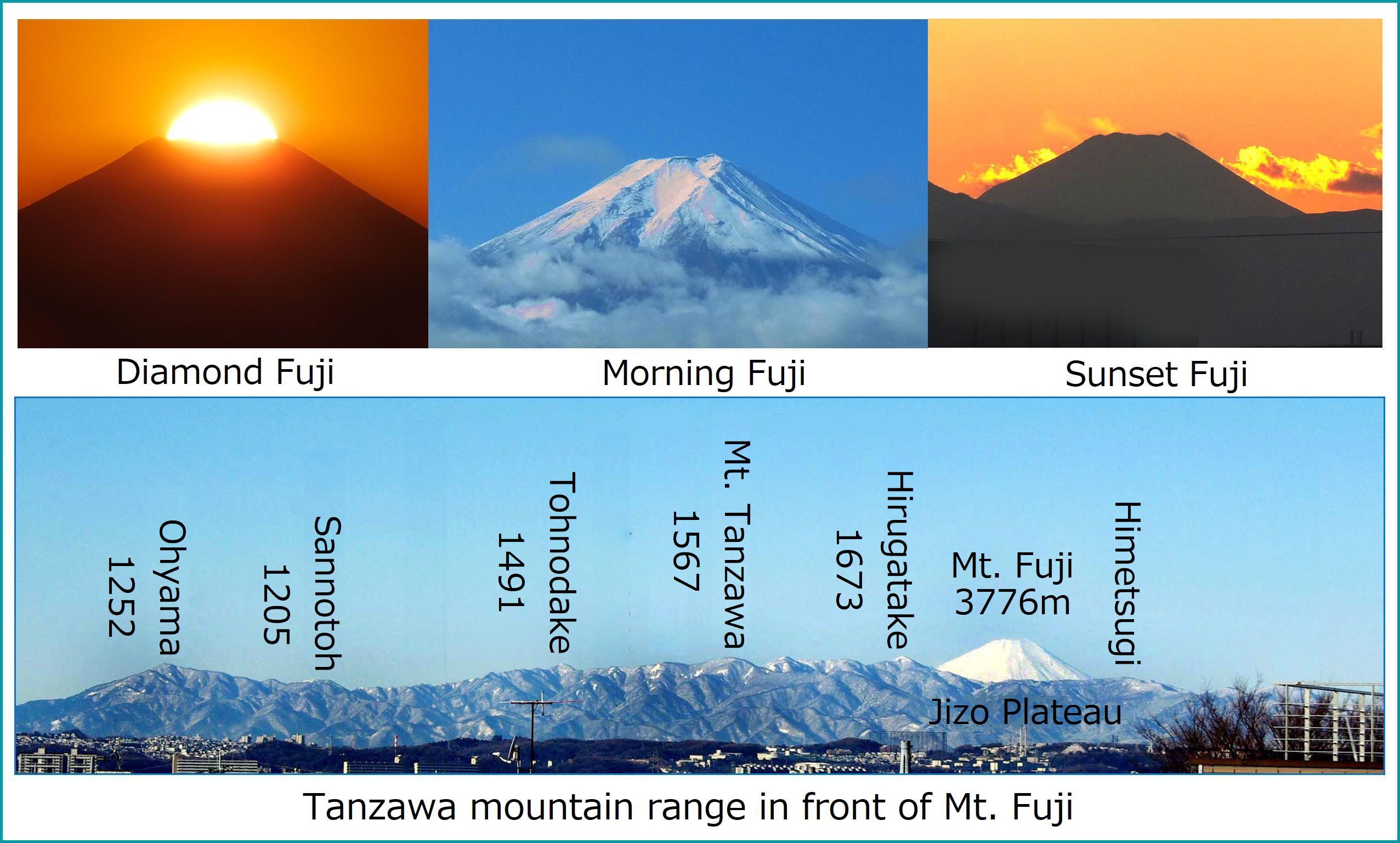
Mt. Fuji, 3776m high, is visible to the west from the balcony of my home. Fuji shows up her upper half behind Tanzawa mountain range as seen in the lower half of the above picture. Her figure gives us occasional pleasure to our daily life morning and evening in every season. Tanzawa range is quite familiar to citizen of Tokyo but few people recognize individual names of summits of the range except Ohyama on the left end. My home is located most favorably for Fuji viewing, since she appears just behind a lower flat ridge, Jizo Plateau.
Fuji looks most magnificent in winter, December through March, when she is capped with shining white snow and the air in between is utmost transparent. Fuji is visible also in summer but her looks are less impressive, sorry. The silhouette of Fuji after sunset is touching throughout the year and gives us always the sign of rest. Morning Fuji facing rising sun transmits surely some holy atmosphere. Countless professional photographers are hunting the best shot of Fuji all the year around.
The moment of sunset when the sun sinks just on the summit plateau of Fuji, is called Diamond Fuji and comes twice a year, February and September. The chance to take the picture is greater in March when the weather is stably fine. Cloudless weather is the first condition to catch the scene. The possibility of success may be once among three. Diamond Fuji shown in the top left picture looks pretty successful, but the last flashing point of the sun, Diamond, comes almost left end of the summit. Only professional photographers can catch the Diamond at the summit center by waiting the chance at the right spot calculated beforehand.
There are so many stories about Mt. Fuji but I have to stop here. This will be the last topics of the present “Memorable Scenes” Series. New Series will start next time. Thank you!.
"Memorable Scenes" Series 11: First encounter with dogwood
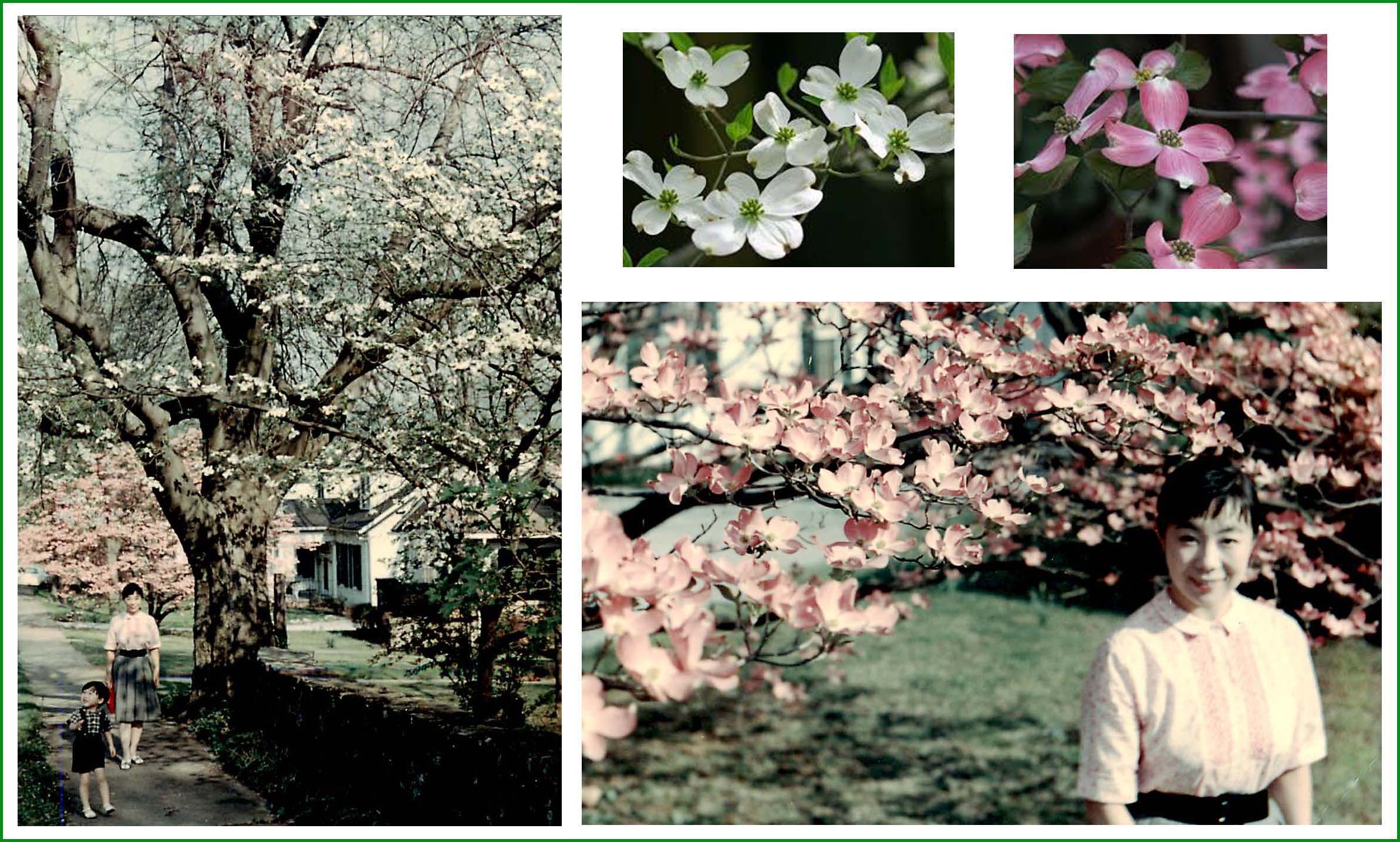
Dogwood trees have become quite popular in Japan. Since dogwoods begin blooming after season of cherry fades out, they have been taking the place of cherry successor as street trees. Country of origin of dogwood is North America and native dogwoods are found in south-eastern States of USA, where the trees are loved as the sign of spring as cherry trees are in Japan.
Dogwoods are rather newcomer in Japan. First dogwoods are said to be imported from the USA as a gift in return for the cherry trees that were presented and planted on the shore of Potomac River in Washington, D.C. by the initiative of Mr. Y. Ozaki, Mayor of Tokyo City, in 1921. Dogwoods grow relatively fast and require less maintenance. That might be the reason why they have proliferated quickly in Japan as street trees.
When I worked for NASA from 1965 through ‘66 as a postdoctoral fellow, we lived in Huntsville, Alabama. The outskirt of the city was emerging residential area boomed by Moon rocket but the down town was kept unchanged keeping traditional southern atmosphere. Almost in every front yard of residence, big and old dogwood trees were found that started blooming around early April. In the high season citizens enjoyed walking through tunnels of white and red flowers and welcomed the arrival of spring. The picture above shows the scenery taken in the downtown.
People’s mood was quite similar to that of our cherry viewing. We became dogwood lover since we first encountered the flower in Huntsville. It is still impossible to find big old dogwood trees in Japan. In several tens of years we may enjoy the same dogwood viewing as that of downtowns in south-eastern US cities. Cherry and dogwood trees are the pioneer of mutual exchange as symbolic flower of two nations.
"Memorable Scenes" Series 10: Safari experience
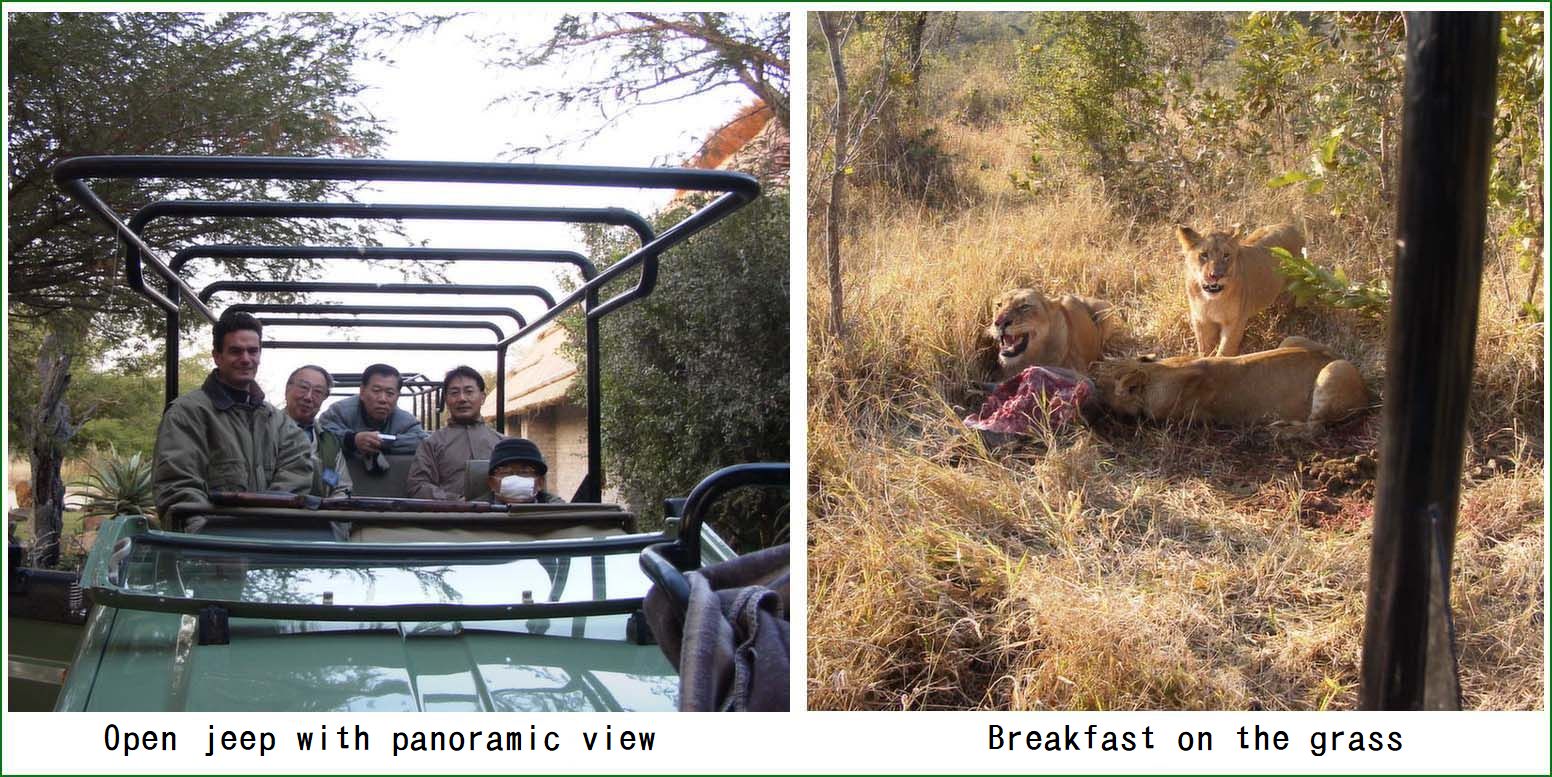
I had travelled abroad countless times, but the majorities were on business to attend academic conferences and symposia. The destinations were therefore rather restricted to large cities in Europe and USA. Later the chance to fly for China and Korea increased remarkably, but I had no opportunity to fly beyond Hong Kong. In 2001 a chance to visit an interesting place came true. A Meeting of Washington Accord (an international agreement for mutual recognition of the quality of engineering education) was decided to be held in Kruger National Park of South Africa, a mecca for safari lovers. JABEE decided to send three delegates including me to bid for membership in Washington Accord.
In June, late autumn, we landed at Johannesburg AP via Hong Kong. After flying on a small prop plane for a local airport in the National Park, a jeep carried us through wilderness to the lodging after 2 hours’ drive. The lodge, a four-star hotel located in a private game reserve, was isolated by electric fences from external world and was a compound of scattered cottages. The meeting was held in another private game reserve, so we enjoyed safari mood during an hour commuting morning and evening.
The life in the lodge was quite comfortable. Out of fences grass land with bushes extended to the horizon where wild beasts were rampant. Every morning at 6 o’clock, a two hours' tour on open jeep was arranged by the hotel for guests. As seen from the above picture left, guests could enjoy panoramic view from rear sheets while a guard holding a rifle sat on the sheet fixed to front hood. The tour guide strictly warned us not to step out of the car. Animals don’t recognize humans as prey so long as they stay in iron box like car.
Shortly after we started driving in the game reserve, we found the scene just on the roadside as shown in the picture right. Three female lions were eating greedily the prey they just hunted. Blood-stained lion heads straightly appealed the law of jungle and showed the extremity of struggle for life
We enjoyed safari life, but worked also hard. The presentation prepared for the admission to the Accord was successful and we could obtain provisional membership, that lead to full membership later on. Most impressive of the travel to South Africa was of course the safari experience that happened once in my life.
"Memorable Scenes" Series 9: Ski camp

After I became the boss of Fluids Engineering Laboratory of the University of Tokyo, ski camp became an annual event of the Laboratory. In academic calendar mid-March is a kind of blank period sandwiched by examination of dissertations and graduation ceremony. I decided to hold a camp of lab-members in this period for summarizing past academic year and encouraging each other. But in reality, the camp was ski enjoying tour and most of lab-members joined including ski beginners. To help lab-OBs join the camp, I occasionally gave the camp a serious name like Tribology Test Meeting, Impact Dynamics Symposium and so on.
The place of camp was first selected in main land like Hakuba and Zaoh, and then moved to Hokkaido where dry powder snow attracted us. We visited often Furano, Tomamu, Rusutsu and Niseko, all representative ski resort of Hokkaido. Though air ticket costed extra, satisfaction of the tour well compensated the burden.
Tradition of ski camp has been continuing even after my retirement in 1992. The picture atop was taken on the slope of Niseko ski resort in 1995 and many lab-members and OBs were gathering including my successors, Prof. YM and SH, and of course myself, HO. The temperature there could decrease to minus 20℃, but the snow had the magic of letting people feel that everybody is expert!
I joined the ski camp every year even after my retirement from the UTokyo and wanted to continue till my physical power expires. However I quitted the participation when I exceeded 77 years old, a Joy Age called in Japan. The reason was that I felt too much guilty to letting my wife alone at home while I enjoy skiing and communication with younger generation. Mid-March; when the season comes around every year, I recall the scenes of ski camps that repeated over 30 years.
"Memorable Scenes" Series 8: My Car No. 3

There are countless memories of my past cars. My Car No.1 was Volkswagen
that I procured in 1957 when I studied in Germany. The car was introduced
already in Nostalgia Series 1 of the present column with the title “The first own car”. Car No.2 was Renault 4CV that I rode for 3 years since 1963 after I came
back home and married. No 3 is Chrysler Plymouth that is to come hereafter.
In 1965, six years after I started my career at the University of Tokyo, I got a post-doctoral fellowship of National Academy of Sciences of USA to conduct research at Marshall Space Flight Center of NASA for one year. The Center located at Huntsville, Alabama bore the central role to develop thruster engines that lift up Saturn Rocket carrying crews to land on the moon. The Center and the whole city were excitingly vivid and active at that time. I started to live in the city with my wife and two and a half years old son.
I looked for a car immediately after I arrived since car was absolutely a necessity to live and work. What I chose was, of course, a used car and the make was Plymouth Fury. The two-tone colored coupe equipped with 5.2 litter 230 HP V8 engine looked quite large and magnificent but was a popular car corresponding to Toyota Corona of Japan. The car became my first car with an automatic transmission. My wife tried successfully to get driver’s license there. By the way, the price was $1,100 equivalent nearly to a monthly salary.
The car was used for commuting and shopping during weekdays but for visiting places of interest around the city during weekends. Long-distance trips across states were arranged during holidays and vacations.
The picture atop was taken at the roadside of Cherokee in Great Smoky Mountains (North Carolina) in mid-October, high season of leaves coloring. As the area was cerebrating Indian Festival, my son sitting on the car front was proud of his Indian hat decorated with colored tail feathers.
Every car must attach a license plate on rear side but there is no obligation on front side in many states, where people may fix a plate of own taste on front side. Because citizens of Huntsville were so proud of rockets, they liked the plate design seen in the picture. In original plate crossing flags of United States and the Confederate were surrounded by two rockets on both sides, and HUNTSVILLE and ALABAMA on top and bottom sides. If you see closely, you will find the Confederate flag is replaced by Japanese flag. That was my originality.
We travelled 34 thousand km in 14 months by the car and visited 20 eastern and southern states. On highways we observed several times such scene that a small vertically-wide car was running among horizontally-wide American cars. That was Datsun of Nissan. Imported Japanese cars increased rapidly in the following ten years and became the cause of severe trade friction between two nations. Nobody could foresee such future at that time. Though Vietnam War started already, the United States of America was incredibly affluent and generous those days.
"Memorable Scenes" Series 7: Last long-distance drive

When I started the present Series, I never thought that the memory with my wife would be selected in it. Though only a month has passed since she passed away, please forgive me to tell memories with her using a photograph shown atop.
My wife loved drive. Though she once drove herself, she preferred to sit beside the driver and look at outside sceneries that continuously appear and flow away. When we had no fixed plan in the afternoon, she used to start changing her clothes. That was a silent sign that she wished to go out for a drive. In many cases we started moving before we decided where to go. We called it stroll-drive.
Her battle against lung cancer began about two years ago. Until April last year, the season of cherry blossoms, she could walk to and ride in the car without problem. Stroll-drive took place almost every day. The last long-distance drive, if I recall, was the one for Fuji-View Hotel beside Lake Kawaguchi in the late November before last. That was the best season when snow-capped Fuji, blue lake and scarlet maple leaves created sublime sceneries around the Lake.
The day was blessed with blue sky and shining leaves. When we took coffee in the hotel lounge, a young couple of the neighboring table proposed kindly to push shutter button of my camera. The picture atop was the outcome. From our pose and backdrop in the picture, some atmosphere of peace and brilliance may be felt. There is no image of ailing at all. The couple gave us a wonderful present!
The large portrait settled at the center of the altar at her funeral was cut out and enlarged from her small face in this photograph. This scene became indeed the most memorable one.
"Memorable Scenes" Series 6: Let's Walk Festival
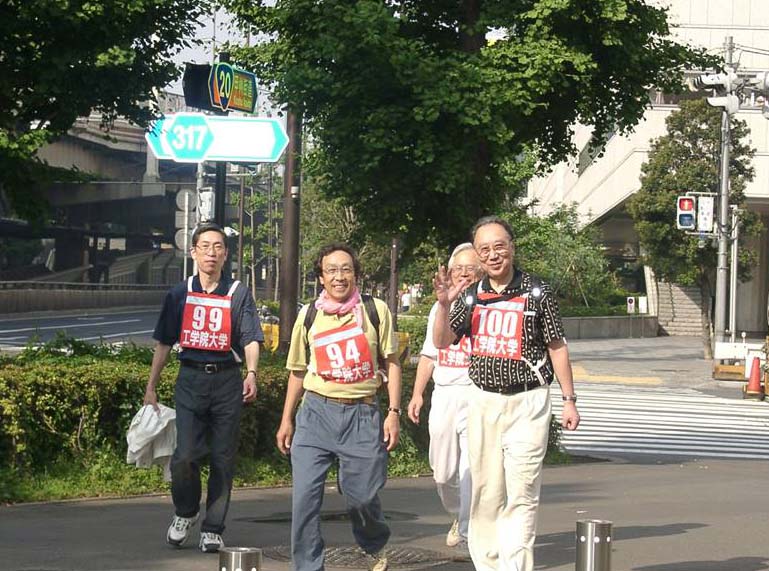
Student unions of Kogakuin University organize “Let’s Walk Festival” around late May every year. At zero o’clock of a Sunday, participants start walking from Hachioji Campus of the university for Shinjuku Campus 42.9 km apart eastward along the Koshu Boulevard. Among ca. 400 participants students are the majority but dozens of teaching and administrative staff join to boost the Festival. Participants walk always on the sidewalk following traffic signals. Waiting at a red right, stepping up and down across a footbridge, supplying water at a convenience store, there are lots of reasons to waste time. Time record is almost nonsense. Deepening communication and sense of unity is the main harvest of this event.
When I reached 70 years old while serving as the president of the university, I got an idea. How about to join Let’s Walk Festival as the landmark of the memorable age? Age Shoot is a credential challenged by aged golfers. Age Walk can be also a target of challenge for walking lovers. I set own rule; Age Walk can be achieved when one walk the distance of Marathon race within hours that is one tenth of one’s age. I decided to join the Festival to challenge Age Walk since the walking distance is almost the same as that of Marathon. Students welcomed my participation.
It was the best season for walking. After the start students of athletic clubs soon disappeared since they run to win. I walked as brisk as possible and tried to follow the top group of walking people. The sun rose about half the way and the rising temperature accelerated tiredness and reduced speed. The picture atop shows the scene when I and my companies reached 2 km point to the goal. They still preserved energy to send smiles.
It took 7 hours and 41 minutes to reach the goal and the order of finish was 71st of all. If I were aware of the order beforehand, I could pay last effort to get ahead of the fore-walker. I missed to achieve Age Order! Problem is how to estimate net walking time. I decided arbitrarily that 41 minutes were unavoidable loss time like signal stop. Then the target was just hit. I conferred the honor of Age Walk on myself. Frankly speaking it was pretty tough to keep 6 km/h speed for successive 7 hours.
This became the first and the last opportunity to join the Festival. I am sorry I have no guts more to challenge for the second time.
"Memorable Scenes" Series 5: Waiting room of Shanghai Station
Memorable scene can be recorded not only by a photograph but also by a sketch. I got to know the joy of sketching when I was over 60 years old. Once I was pretty hooked on sketching. When I was travelling, I remember, I continuously looked for a good target for sketch like a hunter sought a prey. Joy of sketching became gradually a burden of travel and the passion faded away in about 10 years. Sketching starts with drawing contour lines of objects with black pencil or felt pen and finishes with coloring partially by watercolors. Since memos and comments can be added freely, sketch has a character of picture diary.
The above sketch was drawn in the waiting room of Shanghai central station. In October, 1993 I travelled to Suzhou to attend Asian Conference of Fluid Machinery. I flew for Shanghai AP and then moved to the central station to catch a train for Suzhou. Shanghai was still before her metamorphosis to a super modern city 25 years ago and the central station looked quite traditional Chinese. There were two waiting rooms, one for first-class passengers and the other for second-class. Though second-class waiting room was so crowded, there were only a few guests in first-class waiting room as you see from the sketch. On the left wall of the room lots of Chinese paintings were displayed for sale. It recalls me that handwritten Chinese paintings were most popular souvenir from China in those days.
Photograph completes just by one click, if once composition or framing of the target has been determined. We are hardly aware of details of the objects in the target. Sketching is completely different. It takes time since we have to observe and reproduce details of every objects one after another. Value of sketching does exist in this elaborate process, the source of long lasting memories. Sketch can’t be completed instantly. Reasonable sketch requests sufficient time and relaxed mind. I am sorry I was too busy in my sixties to continue the hobby.
Today’s modern Shanghai central station keeps no vestige of the one a quarter of a Century ago. China’s speed of modernization of cities exceeds far more than Japanese case we experience during our high-growth period. Chinese people may feel nostalgia for station landscape painted above.
"Memorable Scenes" Series 4: Sumo-stamping
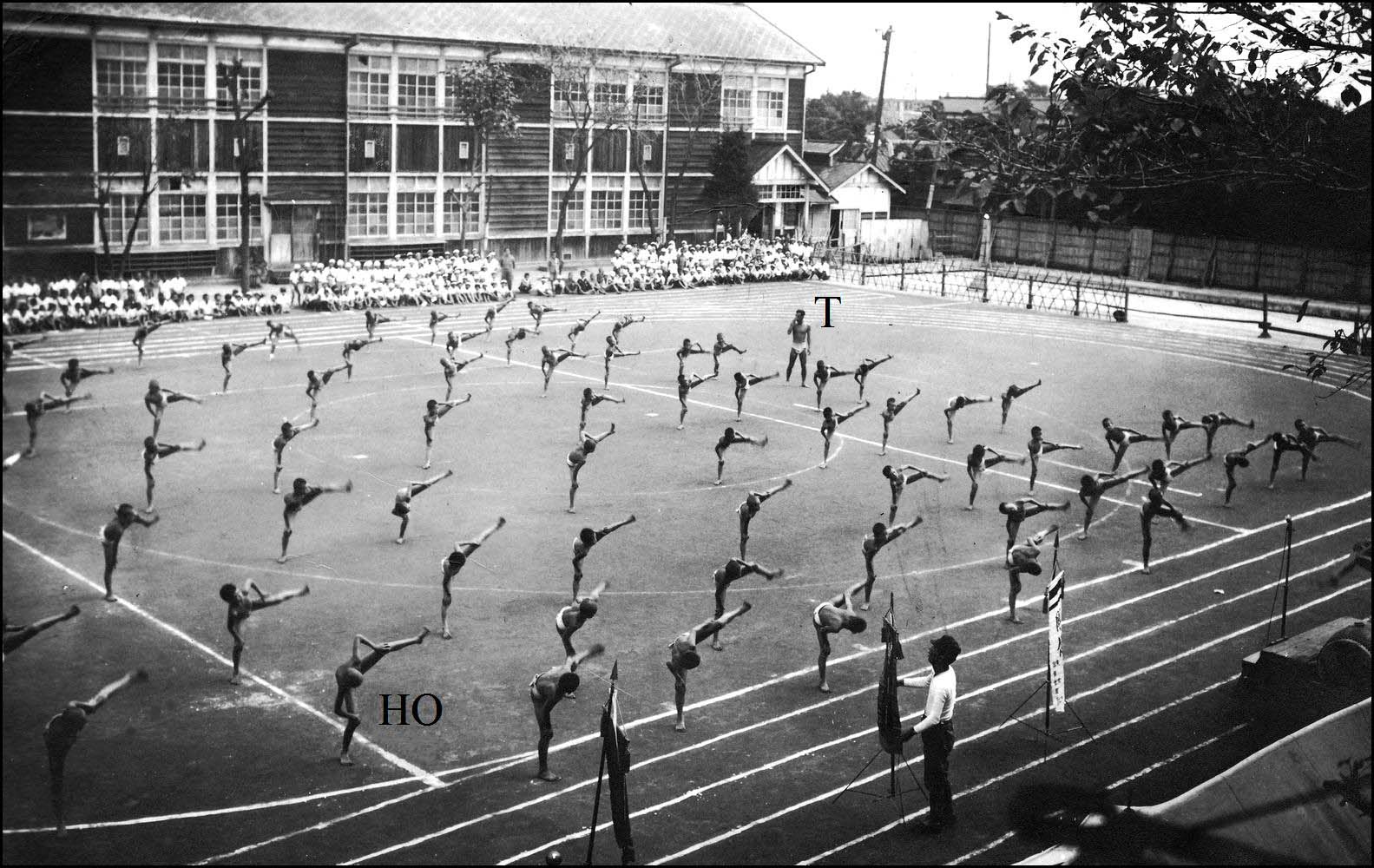
Though my house in Tokyo incurred no damage due to air raids during the last war, we experienced total burning down after we evacuated to country side, Muramatsu, Niigata Prefecture. In spring 1946, Murmatsu suffered a big fire and majority of the town was burnt away. We lost everything. Family pictures before the fire were very precious because they were all recollected from the albums of relatives and friends.
The Picture atop is one of such ones and is the only one that reminds my life in primary school age. It shows mass performance of Sumo-stamping by all classmates of 6th grade at an occasion of athletic meeting of Suginami No.4 Primary School. Sumo wrestlers perform stamping as a symbolic motion of warming-up. The time was just midst of the Pacific War and the whole nation was dyed by militarism. Sumo, an authentic national sport, was almost compulsory subject of boys.
In the picture, class teacher T (Mr. K. Taira) was whistling to conduct rhythms behind boys. Ideal form of stamping is to raise feet high with stretched knee. The form of HO, myself, was far from the ideal. It looks like a mosquito, alas! I remember I was strictly coached by my teacher.
I have never attended the alumni party of the primary school and have no list of names of my former class mates. Intimate playmates of primary school age have all passed away. The school stands today where it has been, but keeps no image of old days. The school song “The school was founded in 1925, in the expanding suburb named Suginami, …..” is stuck still in my head. In the past 90 years from the foundation, teachers have been overlapping generations and sending out boys and girls adapting to ever changing stream of eras.
"Memorable Scenes" Series 3: A young man from the Orient

In Autumn 1956, I set foot on foreign soil for the first time. I, 25 years old then, started doctoral study at Technical University of Braunschweig with the support of scholarship from German Government. Braunschweig, locating some 150 km south of Hamburg, was known as an ancient and academic city. When I arrived, there was no Japanese else among 250 thousand population.
I knew only one lady with whom I had private connection beforehand. Ms. Tori Tanaka, my teacher of German conversation, sent a letter of introduction to her former class mate of primary school living in Braunschweig. Mrs. Grete Krämer-Zschäbitz was the name, and was active as an artist of sculpture and painting. Later I found that her works were set up in many parks and squares of the city as mascot statues.
She lost her husband long before and had no children. She welcomed my visits as if she expected the visit of her son. She knew my favorite food well; her home-made potato salad was especially superb! Her home became my oasis to cure and recharge. When my day of home coming got closer, she proposed me to sit as a model, and started to make head statue by clay. I played model two or three times and left Braunschweig after observing clay head that was almost complete.
About one year after returning home I received by ship the bronze head shown atop. After completing clay model, she ordered bronze casting and submitted the work to an exhibition with the title “A young man from the Orient”. Finally the statue was presented to the model himself. Everybody may get peculiar feeling and become uneasy, when one scrutinizes own face on bronze sculpture. It’s not fun to display in room while the model is still alive. As the result the bronze head has been stored in closet.
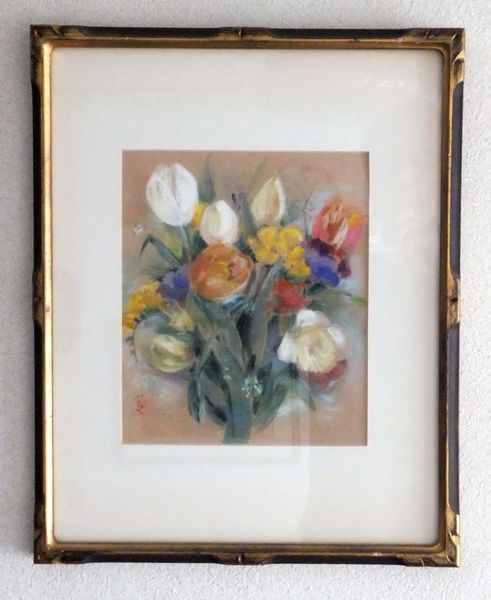 Sixty years have passed since the bronze head was born, and almost twenty
years since the dear lady artist passed away. It is doubtless that the
young man from the Orient is myself in younger days. I would like to utilize
the present Series for spotlighting the monumental bronze head again.
Sixty years have passed since the bronze head was born, and almost twenty
years since the dear lady artist passed away. It is doubtless that the
young man from the Orient is myself in younger days. I would like to utilize
the present Series for spotlighting the monumental bronze head again.
The lady, Aunt Grete, had been so kind to send her works of oil and pastel painting, wood prints and small figures on such occasion as our birthdays, etc. till her last days. Our home looks like Mini-Art Museum of her works. As to keeping memories of past days, the power of art is unprecedented.
"Memorable Scenes" Series 2: Calligraphy in a frame

My father was borne in a village located at the border of mountains and
flatlands in the northern part of Niigata Prefecture. His native house
remains still almost as it was a Century ago. The village extends at the
foot of White Mountain (1012m high). After my father passed away, I had
opportunity to live in the house when I was 12 to 16 years old. I used
to commute by foot to a middle school in the nearby town some 4 km apart.
In the morning on the way to school, White Mountain looked me down behind
me. In the evening on the way home, I walked looking up the mountain coming
gradually closer. The figure of the mountain was printed firmly on my eyes
and is ready to recall clearly still today.
There is a small shrine called Kumanoza in the village, so-called tutelary shrine. It came out about 20 years ago that
a new communication center of the village was to be built in the grounds.
Then I received the offer to present a calligraphy in a frame that was
to be shown in the meeting hall. I was quite embarrassed since I had no
experience of writing calligraphy with a brush, but accepted the offer
to ensure the ties with the village over generations.
Writing large Chinese characters with a brush requires special training. I had no confidence to do well. So, I first drew the silhouette line of White Mountain on the upper half and wrote five Chinese characters beneath the line as you see in the top figure. They mean from right to left; (being), (distant), (think), (home), (village). I wanted to convey my emotion when I think back on home village from far away.
 20 years have passed since I presented the calligraphy. The ties with the birth place of my father have been gradually fading. I wrote the calligraphy as a representative of those who live away from native place. I wish to know whether the calligraphy is still transmitting the nostalgia to native folk. Let’s visit there again and assure it by myself.
20 years have passed since I presented the calligraphy. The ties with the birth place of my father have been gradually fading. I wrote the calligraphy as a representative of those who live away from native place. I wish to know whether the calligraphy is still transmitting the nostalgia to native folk. Let’s visit there again and assure it by myself.
"Memorable Scenes" Series 1: Parade with Doctor hat on the head
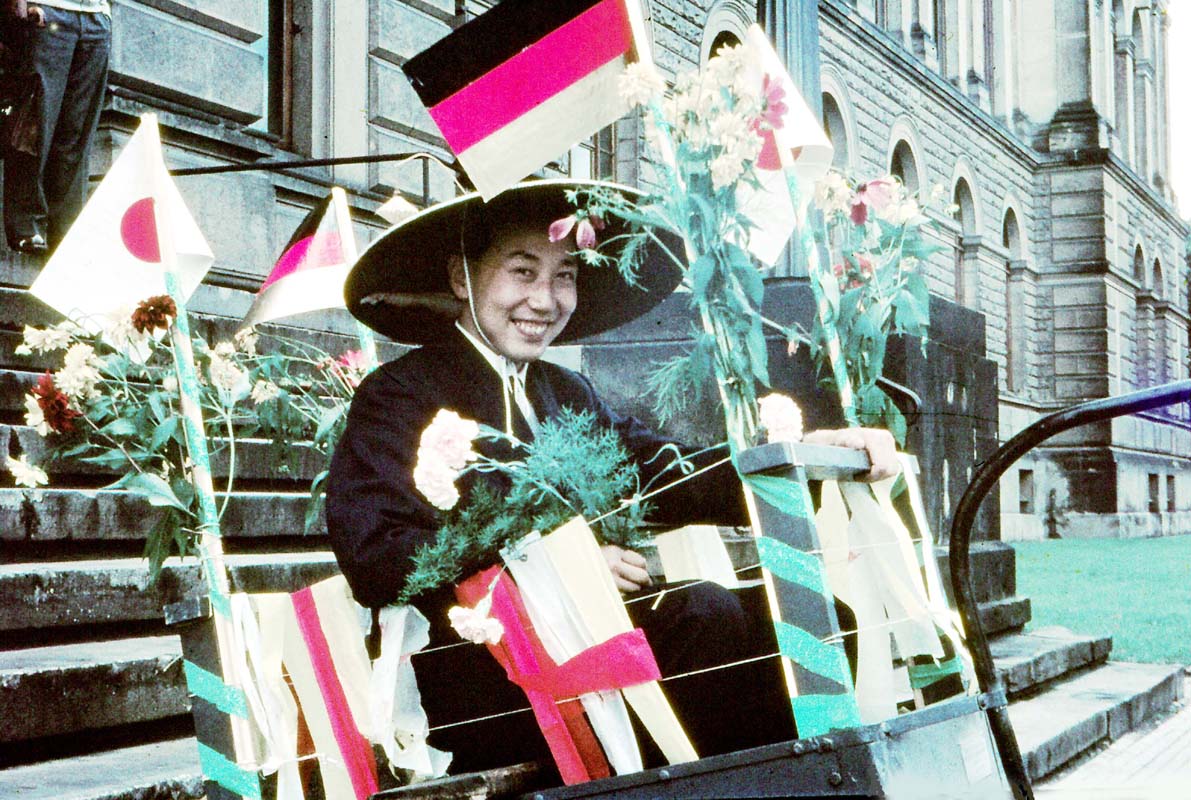
Following “Treasure Box of Words” Series with somewhat serious topics, new “Memorable Scenes” Series is to introduce photos that tell unforgettable events and happenings in the past. The first Series intoduces the snapshot taken just after the oral examination of doctoral dissertation in Germany almost 60 years ago.
After accepting application for doctorate, German universities nominate a few examiners who review thesis work and carry final oral examination within two or three months. I submitted my thesis to Technical University Braunschweig in June, 1958 and three professors including my boss, Prof. Schlichting, started judgment. The day of oral examination, of course in German, came in August. I went to the interview room in main building of the university with formal dress and greeted three professors with shake hand.
Question and answer on the thesis work itself was no problem since every detail was done by myself. Problems were the questions on related fields to check general knowledge and understanding. I was quite lucky to withstand the arrows of questions without serious damage.
After examination I waited the result out of the room. The moment of judgement came soon when the most senior examiner, Prof. Pfleiderer, appeared. He shook my hand and said;
“Congratulations! You passed with Summa Cum Laude.”
That was the most delightful moment in my life. Colleagues of Prof. Schlichting’s Institute gathered instantly around me and put on my head a Doctor Hat in oriental sedge-hat style, that they had handmade secretly to me. They prepared also two-wheel rikisha decorated with Japanese and German flags as shown in the top photo. They started parade by pulling me on the rikisha along the streets near the University.
 After they lost power to pull by hands, a scooter took the role as alternative
locomotive. People of university city Braunschweig were accustomed to such
scenes and sent ale without special surprise. It was an unforgettable day
when I was 27 years old.
After they lost power to pull by hands, a scooter took the role as alternative
locomotive. People of university city Braunschweig were accustomed to such
scenes and sent ale without special surprise. It was an unforgettable day
when I was 27 years old.
"Treasure Box of Words" Series 10: Today is the first day of my life

“Today is the first day of the rest of your life” is a famous phrase of Charles Dederich and is well known in English-speaking countries. I would like to remove “the rest of” from the phrase and modify it as “Today is the first day of my life”. This simple expression is my own statement especially given to myself.
We may not change the past. Past days are only the object of reminiscence. What we can change is only the future to which we may apply our will. Today is the entrance to the future, and is the very first day when we may create life as we wish.
As age proceeds, we recognize the significance of the above words deeper
and deeper. The days of the retired elderly are often quite monotonous
since they have little interaction with society and have rare opportunity
to accomplish something meaningful. If such days continue one after another,
people are easily thrown into the delusion that life is useless.
Wait, something is wrong! Today’s life is the most precious gift from
Heaven! Look forward and do the best to accomplish what we can do today.
One day after another, we should keep the same mind till the last day comes.
This mental attitude is just overlapping with the phrase “Today is the
first day of my life”.
"Treasure Box of Words" Series comes to the end, after dedicating above words to myself.
"Treasure Box of Words" Series 9: Challenge is the privilage of the young

When I look back over my life, it seems that the latter half of twenties is the most dynamic and eventful period. The years till I graduated from university and started as a rookie engineer. were also pretty dynamic and even harsh due to repeated wars, evacuation, surrender, reform of school system, etc., but the circumstances were not specific to me but the same to all the people.
After about a year since I started to work in gas turbine design section of a company, questions about the status quo grew gradually. How to overcome large technology gap behind advanced nations? That was the starting motive. Then, plan to go abroad to know and learn more, apply to scholarship of German government, carry PhD study at a German technical university, return to home company and engage in R&D , transfer to University of Tokyo as teaching staff. Such chain of events took place within the latter half of my twenties. The result was the career switch from industry to academia.
I am proud of my devotion to engineering education for fifty years in academia. If I kept working at the same company till retirement, my life could be also interesting in different way. Which career choice would have been better? It’s unknown forever. Life is interesting because we may not try and compare. There is no way but to make the best of selected choice.
When a branch into two roads appears, one is almost an extension of the past and the other is unsure but challenging, I advise to choose the latter especially to younger generation with less restriction. Challenge is the privilege of the young!
"Treasure Box of Words" Series 8: We see only what we want to see

Isaac Newton got the idea of gravitation when he saw such a scene that an apple left the branch and started to fall down. Everybody knows this famous anecdote. It’s sure that numerous people saw the same scene before but nobody reached the same idea.
Everything in front of our eyes is continuously projected on the retinas, however, to be projected and to be seen are completely different matter. The way of viewing that an apple is pulled apart by invisible string of downward gravity, is only possible after years-long struggle to find natural law that governs universe. Picking up an image from projected pattern and thinking of its implication; to see must be backed up by such a process.
As to hearing, situation is the same. Our eardrums catch external sound continuously, but nothing remains in mind unless we intend to pick up a voice and pay attention. Great inventions that will come in future, may be hiding in scenes and sounds that we all see and hear. Before our eyes and ears, nature presents herself as it is and conceals nothing.
We see only what we want to see, and hear only what we want to hear. What we haven’t seen or haven’t heard, is almost the same as what we didn’t want to see or didn’t want to hear.
"Treasure Box of Words" Series 7: Atop a summit, and another becomes visible

Standing atop the summit of a mountain, after crawling up on steep slopes for hours. Joy bursts and shout for cheers! Similar scenes are numerous from passing difficult schools to winning Gold Medal at the Olympics. The joys at the moment of achieving big targets are so large that they remain unforgettable for lifetime.
Such moment of joy comes only after days or years of hard training and learning with strong motivation. However, the burst of joy cools down soon, and the moment becomes just one flame of the past pictures. Is the success itself the substance of a life, and the process toward it merely a sacrifice? If the answer is yes, majority of a life is spent as sacrifice, alas!
I think in another way. Target is not a substance but a placard to be thrown away after accomplishment. The days of devotion toward targets are the valuable substance of a life. Even after joys and excitement cooled down, the virtue of the devotion, that is, enhanced ability in planning, physical and mental power, experience and confidence, remains and will never disappear. The virtue is not affected even by the result, success or failure. Target is a placard to enhance self and the days for accomplishment are the substance.
When climbing a mountain, standing atop is, of course, most desirable, since breathtaking panorama of surrounding mountains is only visible from the summit. Higher mountains, steeper mountains, they appeal their existence with own attractiveness. After standing atop a summit, another summit to be the next target may become visible. That is the start of the next devotion.
The above way of thinking seems to belong to that of saints. Hard days of devotion may pass away quickly! That’s a common desire. I myself summarize the past in the way that an agreeable life is the repetition of patience embroidered with sweet and bitter memories.
"Treasure Box of Words" Series 6: Optimism is a will, pessimism a mood

Countless books have been published that deal with the essence of happiness. Those written by Alain, C. Hilty, B. Russell, T. Fukuda, etc. are especially popular and found today in large bookstores. Happiness and good luck are somehow overlapping, like unhappiness and bad luck are. Happiness is pretty dependent on luck that can’t be controlled by one’s will. We have no way but praying to gods for good luck.
What is the difference between “I am enjoying life” and “I am happy” The former statement is based on a perfectly subjective judgment, but the latter is influenced more or less by the comparison with other people. I rather expect books on “Theory of enjoyable life” added to ”Theory of happiness”.
There are various pairs of words, antonyms, that express human character, temperament, and feeling, for example, optimistic <> pessimistic, satisfaction <> discontent, positive <> negative, laughter <> anger, tolerance <> intolerance, etc. Left and right are so opposite like plus and minus.
My experience tells that people are divided into two groups, that is, one principally with left side attributes and the other with right side. Some way of holding mind may determine the tendency to the left or right side. What might be the deepest factor to go left or right? My opinion is the difference; to be subjective or subordinate on action, and to impose responsibility to oneself or else on result.
In order to enjoy life, the left side attributes seem inevitable. To be subjective on action and admit own responsibility on result, is the necessary premise to enjoy life!
The following words are found in the Alain’s book “On Happiness”; “Pessimism belongs to a mood, but optimism to a will. Those who leave the matter to others are all in depressed sprit” The title of the present Series, “Optimism is a will, pessimism a mood” is the shortened expression of Alain’s phrase. Theories to enjoy life and to be happy are closely connected.
"Treasure Box of Words" Series 5: Start with two humans

In the present series a Chinese character plays a central role since the word is taken from the teachings of Confucius. We Japanese, especially elderly people, have been taught that Confucius is the one who stands at the source of human ethics. Before the inflow of western knowledge, study of Confucianism written in classic books had been the main stream of learning. My knowledge on Confucianism was, however, obtained not by learning such books but reading a historical novel written by Yasushi Inoue (1907-1991) titled “Confucius”.
Chinese characters indicating loyalty, filial piety, benevolence、justice、courtesy、wisdom and sincerity have been thought to show the core virtue of Confucianism. Each character has so deep meaning and implication that numerous notes and articles on interpretation are left. After reading Inoue’s novel, I thought which character may be the one that represents the Confucius’ thought. My conclusion is, Chinese character ![]() meaning benevolence is the one.
meaning benevolence is the one.
![]() is composed of two elements. The left half means a human and the right two. Every one lives in a society communicating and interacting with other humans. The most fundamental scene in the human society is that two humans stand facing and communicating each other. The ideal ties that connect these two humans, are the essential meaning of character
is composed of two elements. The left half means a human and the right two. Every one lives in a society communicating and interacting with other humans. The most fundamental scene in the human society is that two humans stand facing and communicating each other. The ideal ties that connect these two humans, are the essential meaning of character ![]() .
.
When we face with a human, regardless of known or unknown, what shall we keep in mind? Confucius' answer may be to admit that the facing human is an irreplaceably precious being as everybody feels oneself. If I wish to be treated with care, my facing partner wishes also in the same way. Reciprocity is the core of ![]() .
.
There remain the words of Confucius: “Let’s think standing on your partner’s side. If he is in sorrow, console him! If he feels lonely, cheer up!” These tender words convey the essence of ![]() better than thousands of remarks.
better than thousands of remarks.
The present society is so complicated and filled with conflict of interests everywhere. If we keep in mind to start with reciprocity, the core of ![]() , when we face our partner, more tender society will come closer to us.
, when we face our partner, more tender society will come closer to us.
"Treasure Box of Words" Series 4: Words are selected metaphors

“He is an eccentric!”, “No, he isn’t!” This was the beginning of a quarrel. Mathematically the problem was simply to judge whether the equation “He=Eccentric” is true or fault. The split of opinions comes from the fact that dictionaries do indicate the meaning of “eccentric” but don’t give the definite boundary between eccentric and normal. This kind of quarrel occurs often but used to be cooled down gradually because an agreeable boundary becomes visible during repeated exchange of counterarguments.
“Babies’ cheek is like an apple.” It is clear that apple is used as an example, or a metaphor. Even we say definitely “He is an eccentric!”, the content can’t claim more than “He is like an eccentric.” in realty. After seeking an appropriate expression to describe his character, the word “eccentric” was selected as a metaphor.
The word we use to express something can be only a metaphor selected from examples as close as possible. If you refer to a dictionary to know the meaning of a word, you will find several representative meanings and usages. The contents itself are not fixed but are deleted or added year by year. Words are living and changing.
Academic papers often contain a section in which definitions of words are listed. It is necessary to avoid useless disputes caused by misunderstanding of wording. If we do the same thing during daily conversation, people will lose the joy of talking. Occasional misunderstanding activates, derails and revolves conversation.
When we hear a talk, it is easy to understand as the chain of known words, but is difficult to guess what the talk really wanted to express, since we have only metaphors as the clue for the imagination. Mutual understanding without misunderstanding is extremely difficult.
In politics and elections people are apt to be moved by simple and definite words, that is, slogans, like “Make America great again” shouted repeatedly by Mr. Trump during his presidential campaign. What is behind the slogan is far complex than the chain of four simple words.
Excellent speakers and writers are especially talented in choosing proper metaphors, so that hearers and readers pay less effort to imagine what is really meant.
"Treasure Box of Words" Series 3: Catch the symptoms

Our daily life is supported by numerous kinds of machines, such as house appliances, automobiles, trains, and so on. Some are visible and tangible, but majorities are out of sight since they are working in off-limits places like factory and power station. As one of mechanical engineers, I am quite confident that every machine is designed and manufactured with utmost care based on best available knowledge. Albeit in reality, machines are not perfectly free from troubles and accidents. Our experiences are limited and we can’t deny unexpected events that are beyond design consideration. Perfect machines are only in our dream.
I have several records to serve as a member of investigation committee on accidents that took place in important machines like nuclear recirculating pump. My experience tells that accident-stricken machines give off signals like screams in most cases. If maintenance men could catch the signals, mostly in the form of unfamiliar noise, vibration, smell, etc., during regular inspection of the machine, any possible accident could be avoided beforehand. The ability to catch those signals is determinant to avoid severe accidents.
The situation is the same as to human bodies. It could happen that someone falls down suddenly without sign, however, premonitory symptoms appear before fatal disease in many cases. If one could catch any symptom and visit doctors to get diagnosis, eventual sickness could be found in early stage and be treated properly. One may say minor symptoms could be felt frequently. If one is too nervous to such symptoms, a pile of diagnoses may be built in vain. It’s better to ignore minor symptoms.
Whether a minor symptom is temporary or precursory of any illness, the
answer could be known only by diagnosis. If the diagnosis is in vain, that
is a happy result. If once the diagnosis hits the cause of illness, it
could save your life. The most important is; you don’t ignore symptoms.
What danger is waiting us tomorrow? Only gods know tomorrow and send us kindly symptoms in various forms. Listen to and catch the symptoms sent from Heaven! Over-confidence and over-optimism paralyze the sensitivity to the symptoms.
"Treasure Box of Words" Series 2: Wait for a ripe moment

Life is like a long journey tracing an unforeseeable way with a lot of junctions scattered around. You must choose a branch at every junction but may not retry by rewinding the time. You would remind past experiences when you were so worried and distressed by selecting a branch at such major junctions as school admission, job application, marriage, job transfer, etc. There are also uncountable minor junctions in the course of ordinary daily life. What would be today’s lunch? It is also a junction to choose, though it’s trivial and easy to decide.
I have had several experiences to face with difficult decisions in my life, such as the one when I decided to shift my job from industry to academia. Even in academia, I recall difficult days when I faced the delay of promotion because of some circumstances. One senior professor kindly arranged a professor-chair at one of leading universities and recommended me to transfer. The other senior professor handed me a sheet of white paper on which a single Chinese character “![]() “ was written. After thinking and worrying several months I decided to
choose the advice that “
“ was written. After thinking and worrying several months I decided to
choose the advice that “![]() “ meant. It would be unknown forever which decision made my life more interesting.
It is at least clear that the Chinese character cooled down my brain from
over excitation and sentiment. “
“ meant. It would be unknown forever which decision made my life more interesting.
It is at least clear that the Chinese character cooled down my brain from
over excitation and sentiment. “![]() ” became a very valuable character in my life.
” became a very valuable character in my life.
“![]() “ (nin) means to hide away, to withstand difficulties and occasionally
to be brutal; all are the potential Nin-jas are trained for. The meanings
are rather dark and negative. However, I would like to give more positive
meaning to this character, that is, to “wait for a ripe moment!” with patience.
Then, “
“ (nin) means to hide away, to withstand difficulties and occasionally
to be brutal; all are the potential Nin-jas are trained for. The meanings
are rather dark and negative. However, I would like to give more positive
meaning to this character, that is, to “wait for a ripe moment!” with patience.
Then, “![]() ” would be one of the most advisable choices when you come to a crucial
junction.
” would be one of the most advisable choices when you come to a crucial
junction.
"Treasure Box of Words" Series 1: Virtue brings profit

A few words may guide you to a right path in utter bewilderment, give hope and courage in hardship or even save your life from despair. Power of words is unmeasurably strong! “Treasure Box of Words” is the title of new Series just to be introduced. Precious and unforgettable words have been collected and stored in my Treasure Box in the past. The words released every time from the Treasure Box, I hope, will be also precious to you with full resonance.
The first choice is quite pragmatic and not sophistic at all, that is, “Virtue brings profit.”
Virtue or moral or ethics, they are thought to be given a priori, like oracles of gods, teachings of Confucius or even laws and rules. However, it is hard to imagine that cognition of moral or ethics existed in the primitive age. What is moral or considered virtue, the concept has grown and become mature throughout the long history of human society. The decisive factor to be handed over to the next generation must be the tangible result that virtue really makes sense in every phase of human life. Moral is in reality a collection of know-hows to live cleverly. “Virtue brings profit.” is the short expression of what is told above.
(Supposedly similar sayings might be known in English, though I am not aware.)
Engineer Series 9: Revised proposal for the classification of engineers

How to classify engineering practitioners, and how to enhance their professional development. These problems are the central issues of the present Engineer Series. In the previous Series 8, I explained my opinion and introduced a private proposal. This proposal contains, however, a week point that both Engineering Practitioners and Engineers are expressed by the same Japanese word "技術者Gijutsusya".
The revised proposal shown in the above picture looks almost the same as the previous one as far as English expression is concerned. The essential difference is that Engineering Practitioners are no more called "Gijutsusya" but "技術従事者Gijutsujujisya" in Japanese.
I sustain from adding further words since this discussion is only meaningful among Japanese-speaking people.
Engineer Series 8: Proposal for the classification of engineers

How to classify engineering practitioners, and how to enhance their professional development. These problems are the central themes of the present Engineer Series. Proper choice of rules and procedures will enhance the pride and responsibility of engineers, improve social understanding, and finally help young generation decide their career path.
As explained in the present Series 6, International Engineering Alliance (IEA) decided to classify engineering practitioners to three categories, that is, Engineer, Technologist and Technician. I see some vulnerable points of this classification such that Technologist is too much intermediate and lacks independent character, and also that there remains still the impression of grading from upper to lower class.
Following is my personal proposal for the classification of engineers that matches specifically Japanese circumstances, while basic accordance with IEA rules is maintained.
Tasks of engineers are so diverse that we better think objectively by imaging industries that manufacture products. Now we divide them to three groups as shown in the above figure. The first group carries research and development that incubate a new idea and develop the idea up to production-ready prototype. Following group is responsible to design, build and operate manufacturing system that assures desired quality and costs. The last group bears manufacturing itself applying human skills of various kinds. Character of the tasks of the three groups varies from complex to broadly- and to well-defined similar to the concept of IEA. Now we give the engineers of each group the title of R&D Engineer, Engineer and Technician, respectively. Professional registration and corresponding Accord for mutual recognition are listed also in the above figure.
The above proposal has two distinct features compared to the IEA rules. First, Technologist disappeared from the list, since its character is too intermediate and lacks appeal to be involved. Nowadays, majority of engineering graduates from major universities proceed to Master programs, and partly further to Doctorate. Second feature is to introduce a new group titled R&D Engineer. The importance of R&D in engineering has been growing and will grow further in the future. By introducing new category, R&D Engineer, education and training in this field will be significantly enforced. R&D Engineer in this proposal is included in the category of Engineer by IEA rules.
The above proposal seems still too rough and needs further refinement. Since there are few persons interested in the classification of engineers, I wish to ignite fire to collect attention by this proposal.
Engineer Series 7: Science, technology and related professionals

As introduced in the previous Series, International Engineering Alliance
(IEA) classified engineering practitioners to three titles, i.e., Engineer,
Technologist and Technician. Among them “Technologist” is especially unfamiliar
and seems uneasy to be acknowledged widely in society. On this occasion
I would like to summarize the wording used in the discussion over science
and technology. As indicated in the above picture, there are two independent
regions, Science and Technology. Science is knowledge, while Technology
is profession.
Science in this case means natural science that was born in 16th Century and is based exactly on verifiable facts. Its history is rather new. On the other hand, Technology has been created, accumulated and handed down over generations together with the development of human civilization. Pyramid and Great Wall are the symbols of ancient technology. Since modern science was born, Technology has been accelerating by absorbing new findings of scientific development. Science-based technology is nowadays the essential part of Technology and is called Engineering. The rest of Technology consists of traditional technology (handed down orally or by secret document on a specific profession) or indigenous technology (told down by local events). There is no definite word to express technology except engineering, so we use Traditional Technology as in the abovepicture.
Now, let’s list up the titles of specialists who work for Science and Technology. Those who work for Science are called Scientist, quite simple and direct. In the same way, are those who work for Technology called Technologist? This naming may be theoretically wright, but is not used commonly since it includes too diverse roles. Engineering is carried by Engineering Practitioners who are classified further to Engineer, Technologist and Technician by IEA. There are a variety of titles of those who work for Traditional Technology; Master, Craftsman, etc.
Technologist indicated by red in the above picture, is the most ambiguous naming. IEA must have had a lot of discussion to decide the title between Engineer and Technician. Associate Engineer or Incorporated Engineer was the candidate in the initial stage but not adopted, since it implies a nuance of "subordinated" like Associate Professor. Technologist was the final candidate.
In the discussion of an international agreement, English-speaking stakeholders are most influential and seize the initiative to settle documents in English. Non-English-speaking stakeholders must follow the decision. How we translate Engineer, Technologist and Technician into Japanese; we have to start the discussion.
Engineer Series 6: Classification of Engineering Practitioners by IEA
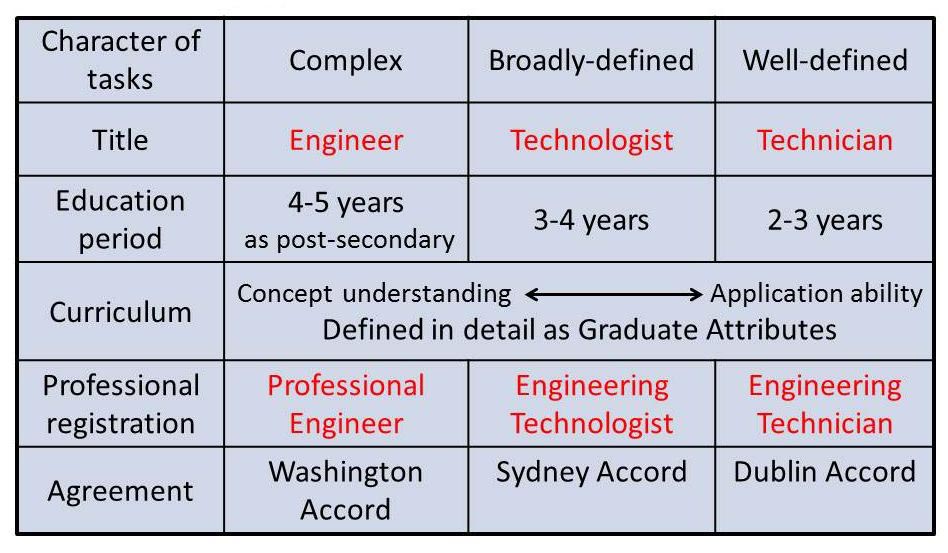
How to classify engineering practitioners according to their professional competency? The answer is the major interest of this Engineering Series. International Engineering Alliance (IEA) is the organization that is responsible to organize global rules in this respect. The Institute of Professional Engineers, Japan and Japan Accreditation Board for Engineering Education (JABEE) are representing Japanese interests in IEA.
As introduced in Series 4, professionals in music are classified to composer, conductor and player according to their character of tasks, i.e., Complex, Broadly-defined or Well-defined. This concept of classification was first adopted by IEA for classifying engineering practitioners. Engineering tasks are so divers and their character changes continuously as explained in the previous Series. IEA classifies titles and registers of engineering practitioners into three definite categories as indicated in the above picture.
According to the character of tasks there are three titles, Engineer, Technologist and Technician; and corresponding titles of professional register are Professional Engineer, Engineering Technologist and Engineering Technician.
In order to assure the quality of education and professional competency of each category, period of post-secondary education, curriculum (defined as Graduate Attributes) , requirement for professional register (defined as Professional Competency Profiles), basis of international agreement are precisely documented by IEA.
IEA has succeeded to introduce rules and procedures to define titles and professional registers in engineering, however, the goal is still far away until the system is globally accepted and acknowledged. Followings are obstacles that we have to break through;
1. Engineer is different from engineering practitioner general. Changing social common sense is so difficult!
2. Technologist is socially almost unknown. Its character is somewhat halfway and lacks attraction.
3. The definition and concept cannot dispel the impression of upper, middle and lower class. The appeal that each category has irreplaceable value and mission is insufficient.
Japanese engineering system must be fundamentally consistent with global rules set by IEA, but should have distinctive features that match our culture and mentality. My lifetime dream is to introduce Japan-specific classification in which every engineering practitioner makes the most of own inherent talent and works with confidence and pride!
Engineer Series 5: Various tasks in engineering
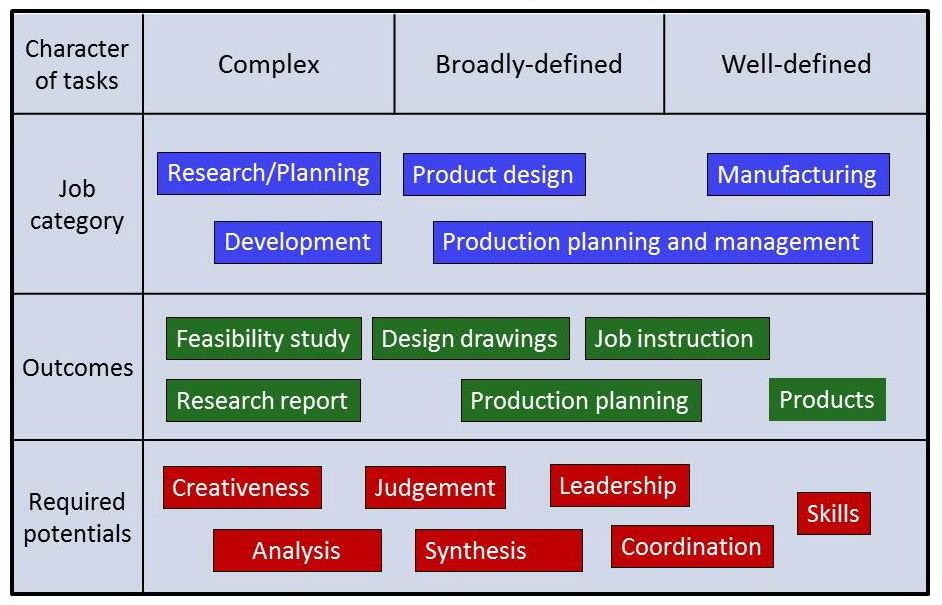
In the previous Series 4, tasks of professionals in music were classified into three categories, namely, Complex, Broadly-defined and Well-defined, represented by composer, conductor and player respectively. Tasks of professionals in engineering are far diverse than in music, but it may be possible to apply the same classification to engineering. To make the discussion simpler, the case of manufacturing industries producing hardware like automobile is selected.
Let’s think the categories of jobs necessary in such industries. The development of business depends on how new competitive products are innovated one after another. Research planning and Research itself are the most upstream job and its character is typically Complex. If once feasibility becomes positive, Development starts. After completing prototype development, Product design follows. Then Production planning and management establish procedures and sequences of every manufacturing process. Finally Manufacturing is carried in factories. The last Manufacturing is composed of jobs that are well-defined. All relevant jobs are arranged from upstream toward downstream as shown in the above picture and their character changes from Complex toward Well-defined.
The outcomes of necessary jobs are either in the form of documents, drawings or in products. They are Feasibility study, Research report, Design drawings, Production planning, Job instruction and finally Products. They can be also arranged like in the above figure according to their character.
The human potentials required to perform each job are also multilateral. Corresponding to the nature of jobs, the required potentials like Creativeness, Analysis, Synthesis, Judgement, Leadership, Coordination and Skills are assigned to the adequate location shown in the figure.
In the case of music it is quite simple because three categories correspond to three titles, i.e., composer, conductor and player. It is not so simple in engineering because there are so many job categories. If we call them all engineer, nothing will change from the present situation. We have to try to introduce new definition of titles corresponding to the three types of task characters. This effort is now ongoing under close cooperation with international engineering societies. The progress will be reported next time.
Engineer Series 4: Professionals in three categories
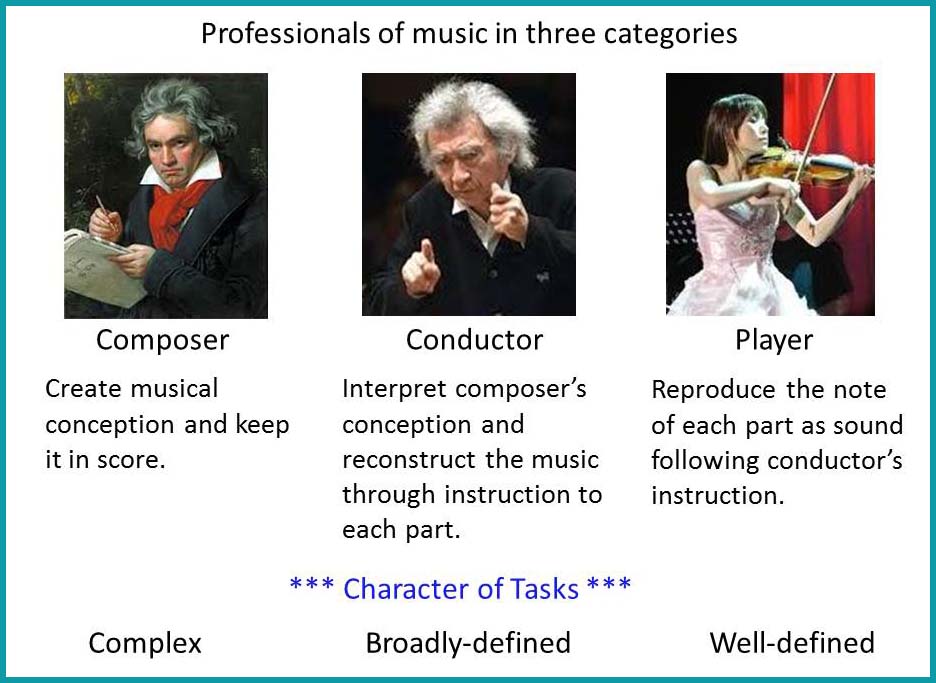
There are a variety of works that depend mostly on brain thinking, face to face communication, skilled handling, and so on. We live every day by combining such works unconsciously. Hereafter we think only work as an occupation, or preferably as a profession.
The field, in which professionals are well accepted and established, may be music. In order to enjoy the performance of an orchestra, three categories of professionals are indispensable, that is, composer, conductor and payer (performer). Their tasks are essentially different.
・ Composer: First create musical conception and keep it in a form of score that remain forever. Composition may take a moment or years to be completed. Musical conceptions are born from completely free imagination.
・Conductor: Interpret composer’s conception and faithfully reconstruct the music through instruction to each part. Communication and harmonization with members are essential.
・Player: Reproduce the music note of each part as sound following conductor’s instruction. Highest performance is always expected.
The character of tasks to be accomplished by these three categories is essentially different. Let’s characterize the task of composer, who is free from every constraint, as “Complex”, that of conductor, who is given a gross constraint such as score book, as “Broadly-defined”, and lastly that of player, who is given a precise constraint such as part note, as “Well-defined”.
When we classify the character of tasks into three categories as mentioned above, we find that this classification can apply to other fields in which professionals are distinctly visible. It could give impression that there exists a hierarchy like Complex>Broadly-defined>Well-defined, but it’s wrong. As there is no difference in value among composer, conductor and player, three categories are free from any hierarchy at all. Each role is indispensable and can’t be replaced by others.
Engineer Series 3: From Nobel Prize to Gold Medal of World Skills Competition
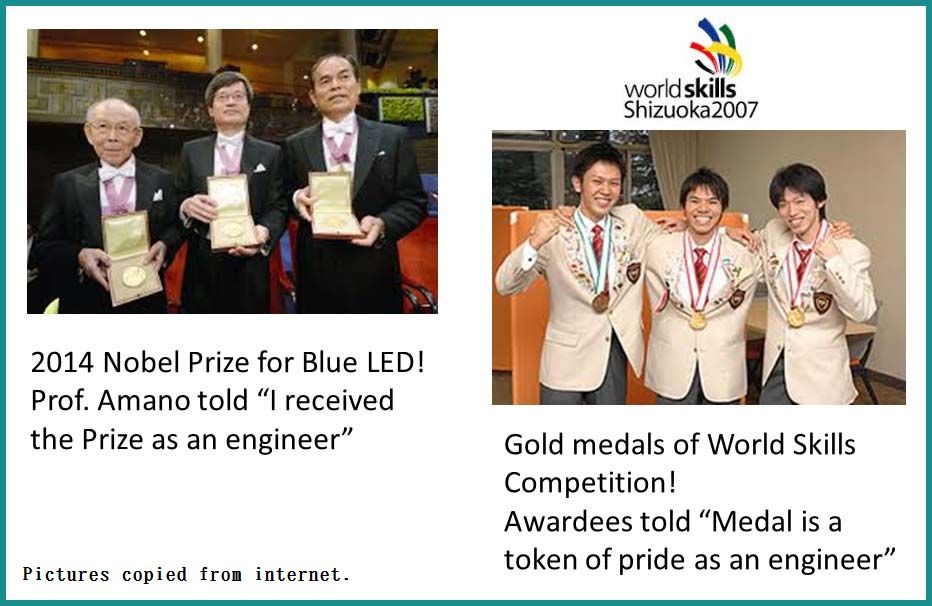
Japanese word corresponding to engineer is Gijyutsu-sya which means engineering practitioner performing every sort of tasks from research and development to manufacturing. The following engineer is used in place of Gijyutsu-sya. The reality that engineering schools of every stage declare “We raise engineers”, was the previous topics of this Series. This time, awarding, the proof of success, is selected to emphasize the diversity of engineers.
Nobel Prize is in all truth the highest honor of the world. Nobel Prize in physics, in chemistry and in physiology/medicine are thought to be given to scientific findings, but are given occasionally to technology development such as invention of new materials, etc. Alfred Nobel himself was a great inventor of dynamite that changed the world.
2014 Nobel Prize in physics was awarded to Drs. Akasaki, Amano and Nakamura for their invention and application of Blue LED as shown in the above picture. Not only Dr. Nakamura, originally a research engineer in a company, but also Prof. Amano, an academic in a university, told “I received the Prize as an engineer”.
There are a variety of engineering tasks. If we sort them according to the nature of required knowledge and skill, the task of research and development may locate on the leftmost end. Researchers working at this end have chance to get Nobel Prize. To perform this task, creativeness based on scientific knowledge, planning ability and endless pursuit mind are required. Nobody can foresee the result, success or retreat. Those who catch serendipity smile, while others continue struggling in a dark tunnel of search.
The task on the rightmost end may be manufacturing that needs various skills. The medalists of World Skills Competition shown above may stand at this end. World Skills Competition is held every two year at various cities of the world. Since the age of competitors is mostly limited under 22, this competition is called Skills Olympic for youth. Three awardees of Hitachi team, medalists of 2007 Competition in lathe, milling and drawing, told “Medal is a token of pride as an engineer”. To obtain skills of top levels, inherent physical aptitude, diligence to overcome long term training and concentration power are inevitable. We can’t compare the value of Nobel Prize and Gold Medal of Skills Competition, because the target of achievement is completely different. Both are common, however, in the fact that awardees are World Number 1.
Tasks for engineers distribute widely between the leftmost and rightmost ends shown above. The core competence required to perm each task is substantially different. In order to make the most of own ability, each engineer should choose a task that is most suitable to given character and talent. The most effective way to maintain industrial competitiveness in the headwind of decreasing population is to enhance the power and output of individuals. Engineering education must be, therefore, not uniform but correspondingly diverse.
Engineer Series 2: Chorus of "We raise engineers!"

Japanese word "Gijutsu-sya" is usually translated to engineer but the meaning is not exactly the same. The following engineer is used in place of Gijyutsu-sya.
What are engineers to do? The majority may answer they are engaged in whatever engineering is concerned with. Such persons are called, to be exact, engineering practitioner (EP) in English. There are a variety of educational institutions aimed to raise EPs such as Technical High Schools (3 years), Vocational Schools (2 y.), Colleges of Technology (5 y.), Junior Colleges (2 y.), Universities (undergraduate 4 y.) and Graduate Schools (2+3 y.). The graduates of these schools must finish 3 to 12 (PhD) years study after 9 years duty education.
I surveyed how these educational institutions describe their mission. The representative and typical phrases that contain keyword “engineer” were picked up and summarized in the above picture. All institutions declare that they raise “engineers”, though a variety of adjectives and prepositions are added to.
People working in medical fields are called medical practitioner (MP). Doctors (MD) are the core of MPs and work together with licensed specialists such as nurses, therapists, clinical engineers, pharmacists and so on. As MDs are educated only in Medical Department of Medical Schools, other licensed specialists are educated in respective educational institutions.
Compared to the education system of medicine, that of engineering is quite primitive! “All educational institutions in medicine unanimously claim that they raise MPs.” Such incredible situation is still prevailing in engineering.
Is it not necessary to introduce a proper specialization in the education and training of engineering? Some may point out that there exists already a specialization such as civil, mechanical, electrical, etc. However, this corresponds to the classification of medical treatment such as internal, external and surgical, and is not a specialization due to the difference of core competence to be requested.
Compare the role of doctors and nurses. There is a distinct difference of core competence. This is the case also in engineering. There is an essential difference of core competence between a research/development engineer and a skilled technician!
In engineering, all relevant educational institutions declare we raise “engineers” that mean merely a group name and are indifferent from any qualification. Is this acceptable? The ideal is that everybody makes the most of own talent and carries the most adaptive work role with pride and responsibility. If we introduce specialization due to core competence like the case of medicine, it will inevitably happen that a kind of hierarchy is generated among EPs. “We love all are even!” This is surely a Japanese sentiment and is also welcome by Japanese enterprises that hire new graduates once a year with the same starting salary. It appears still no sign of change.
Engineer Series 1: Who's engineer, juveniles' answer
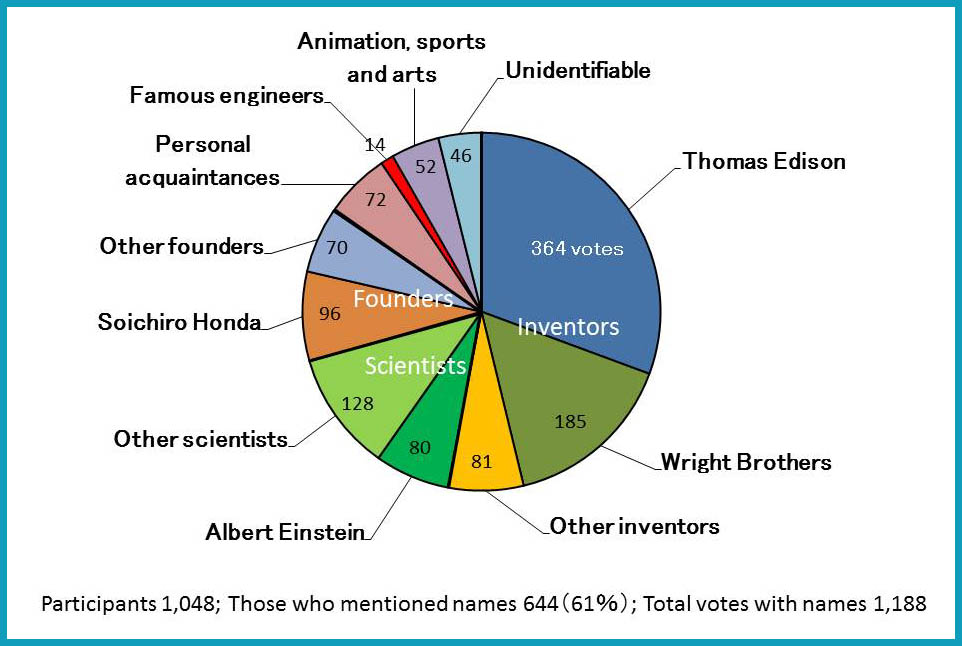
Applicants to universities must choose specific faculty and department of their interest. It means necessarily that they have to focus their future career to some extent. Since engineering related faculties and schools offer principally education for engineers, it is desirable that students start their study with sufficient understanding on the role and mission of engineers in society.
How do juveniles before university admission understand and image engineers? In order to find out the reality, I conducted a survey by questionnaire in 2007 with full support of Middle and High Schools attached to Kogakuin University. All pupils of two schools (12-17 years old) received a questionnaire that requested simply “Please mention names of three representative engineers you know.”
Total 1,048 pupils participated in this survey. After checking collected questionnaires, it came out that 644 pupils (61%) could mention at least one name of engineers (39% submitted blank sheets) and wrote total 1,188 names of a variety of persons (wrote 1.6 names on average). Then numbers of votes to each mentioned engineer were summed up for ranking. Since the difference of ranking between age groups seemed not essential, whole participated pupils were treated as a single group in the analysis.
The above pie graph indicates the distribution of votes to specific persons or groups. First, famous inventors like Thomas Edison, Wright Brothers, Graham Bell, Alfred Nobel, etc. collected 630 votes (53% of total). Edison and Wright Brothers showed a superb popularity. Then scientists like Albert Einstein, Isaac Newton, etc. followed with 208 votes (18%). Since no prior explanation on engineer and scientist was given to pupils, it’s natural that they hardly distinguished them. Next, famous founders of big enterprises like Soichiro Honda, Bill Gates, etc. collected 166 votes (14%). Further, personal acquaintances like teachers and relatives, famous engineers like astronauts and architects, and famous persons in animation, sports and arts field collected 72, 14, and 52 votes respectively. Votes with unidentifiable description reached 46.
The result of the above survey gave me a great shock! Answers were collected from pupils of schools that were attached to an engineering university. Even under this favorable situation juveniles had quite poor image on engineers. Persons in traditional engineering career collected only 1 % of total votes. If an engineering graduate gets a great success as an inventor, a scientist or an artist, it is quite a welcome surprise, but the success can’t be attributed to the direct outcomes of engineering education.
“People know well what engineers are performing in society.” That was merely an illusion. Juveniles participated in this survey revealed the reality. Who is responsible to this dilute presence of engineers in society? The answer is engineers themselves.
Cartoon Series 12: Oriental subconsciousness
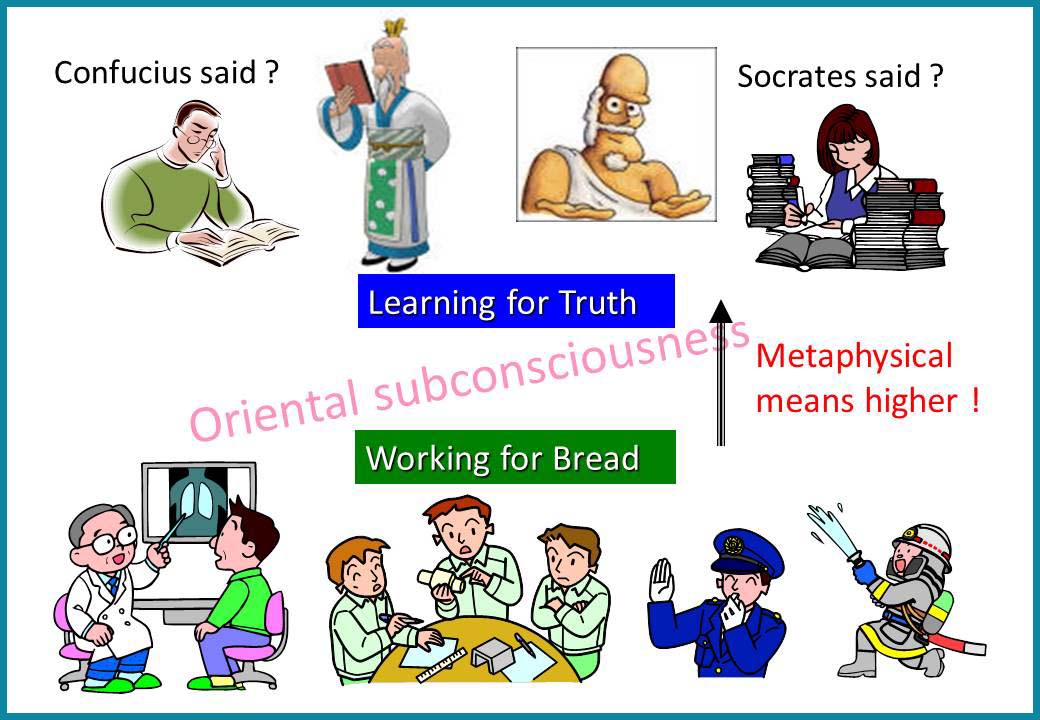
The ultimate goal of a human life is to reach a spiritually enlightened status (Buddhahood) after learning truth about life and death. It is a common dream to join to those who are called saints or sages. East Asian people who were raised under strong influence of traditional oriental thoughts like Confucianism were used to bear such subconscious wishes as stated in the beginning sentences.
Learning books of ancient saints like Confucius and Mencius was the entrance leading to truth. After European culture was introduced, learning thoughts of philosophers like Socrates became also a must. What was enthusiastically learnt, is Metaphysics, that perceives invisible disciplines beyond (meta) existing matters (physics).
Humans can’t survive without eating food. Approach to truth is enabled only by sound body (physics) nourished by food. One must work to get food. People work as fireman, policeman, engineer, doctor, etc. as illustrated at the bottom of the above picture. They get food in price of their specific service to society and the service is called occupation or profession. To perform their service satisfactorily, they need knowledge and training of respective field. Such knowledge is called practical science and has been discriminated from noble science, metaphysics
Social grading of humans surely exists. Those who seem indifferent from working are usually graded noble like royalty and nobility. To the contrary, those who sweat and work whole day are graded humble. In spite of such social prejudice, working, or performing professional role, is absolutely not humble but is a sole deed in which one can assure one’s raison d'etre, the meaning of existence. So-called practical sciences are urgently needed by society and are never subordinated under metaphysics.
The above picture intends to contrast two important human deeds, i.e.,
learning for truth and working for bread. Orientals often bear such subconsciousness
that the former is superior to the latter. I would like to propose that
people turn the picture upside down. Stable and assured life brought by
steady working does inspire the challenging will to approach truth.
Cartoon Series 11: Structure of human relations
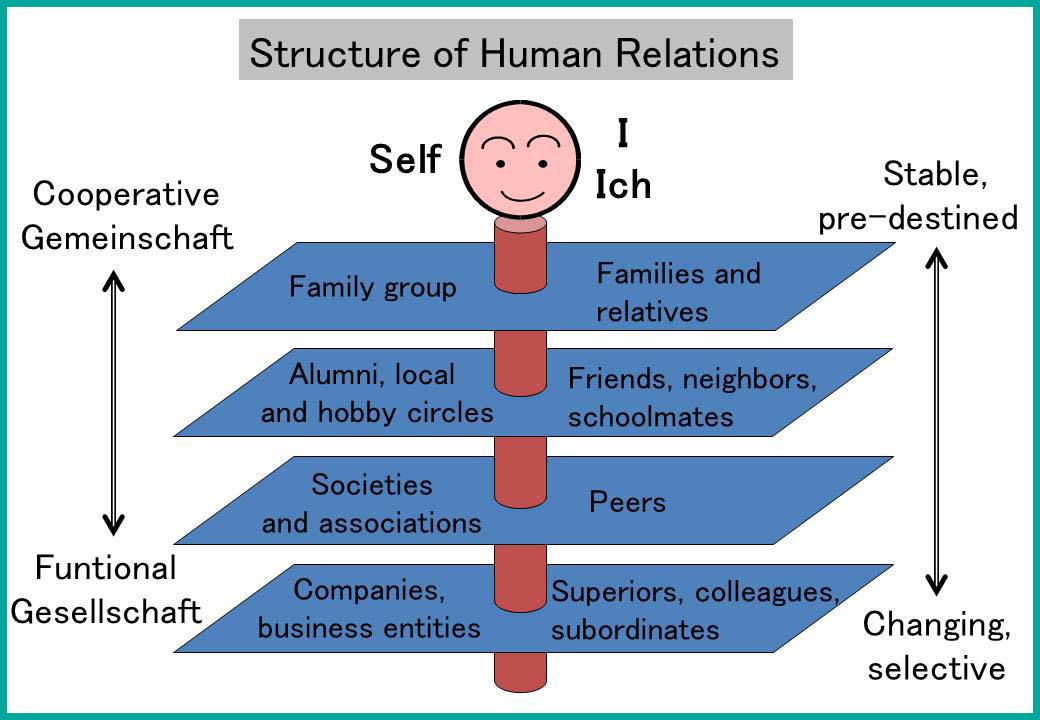
Homo sapiens sapiens is the taxonomic name of contemporary human species. Repeated sapiens stresses how humans are wise. Chinese character corresponding to a human is “人” but we Japanese use frequently “人間” instead of “人”. The second character “間” means “in between” and, therefore, “人間” indicates a human who lives between multiple relations to other humans in a society. English word “human” has also similar nuance that it is more than an isolated sample of human species.
Humans live in a society and their relation to other humans is quite divers in motivation and character. The above picture tries to describe the structure of human relations using four planes of relationship.
Self, that is I, is always at the center of all relations. The first and inherent relationship is the connection introduced by marriages, that is, family group. Parents, brothers and sisters and all relatives are in this plane. This relationship is ever lasting.
The second relationship is those with friends from childhood, schoolmates, neighbors, members of hobby circles and clubs, etc. Hopefully the relationship between teachers and students may be added to this group. This relationship is indifferent from profits and losses and tends to last for a long period.
There are a variety of learned societies aimed to improve members’ knowledge and skill in specific specialties. The third relationship is created among members, called peer, of such societies. Those who are engaged in research and development have quite a number of peers and keep substantial and lasting relation.
The fourth and last relationship is those with superiors, colleagues and subordinates in the workplace. For the majority of working time people are confined in this relationship.
The nature of the above four relationship planes changes downwards from cooperation-based group (German; Gemeinschaft) to mission-oriented organization (Gesellschaft). Companies are the representative model of the latter. The character of human relations changes also downwards from stable and inherent to changing and selective. Human relations with people in the same workplace evaporates immediately after one leaves the company.
As long as one works, one pays the largest attention to keep good situation in the fourth relationship. It happens easily that people win in the fourth plane in price of the first plane. Is this an inevitable sacrifice to get breads?
As age proceeds and people retire, the third and fourth planes gradually get thinner and disappear. The lasting planes are the first and second. Anyhow, self and its heart keep the same identity for the whole life and can’t be replaced.
Cartoon Series 10: Science and Non-science
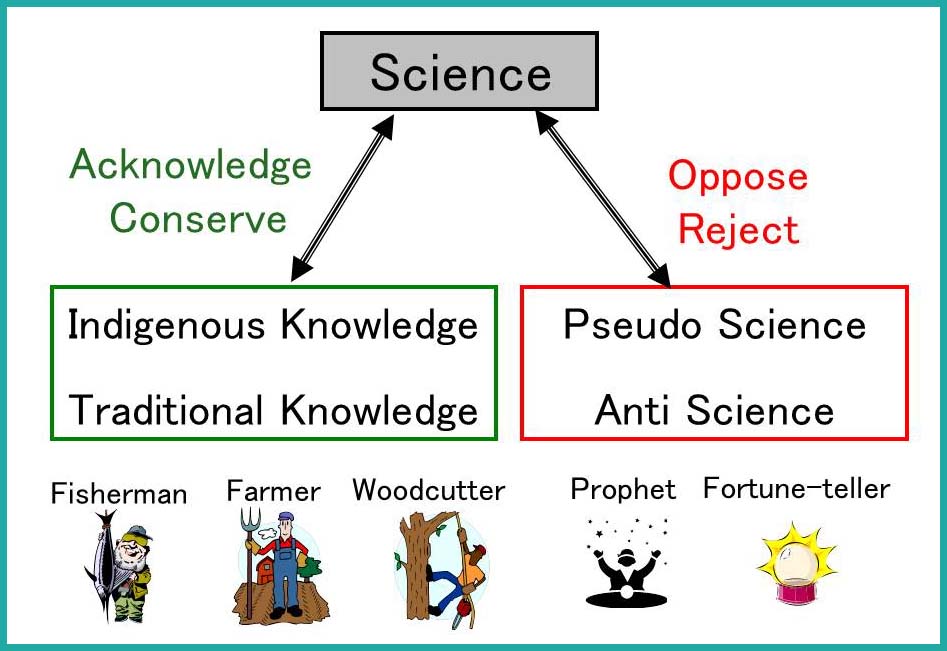
In order to redefine the role of science in the coming 21st Century, UNESCO and International Council of Science organized “World Conference on Science” at Budapest in 1999. As the consequence “Declaration on Science and the Use of Scientific Knowledge” was adopted to underscore the tight correlation between science and society with the catchphrase “From Science-for-Science to Science-for-Society”. I attended the Conference as a member of the Science Council of Japan and could join the discussion over “what is science”. The above picture is the summary of the conclusion.
Science is the collection of knowledge that could be verified to be true by anybody. Problem is the knowledge such as Indigenous Knowledge that has been kept as local sayings and Traditional Knowledge that has been transferred generation to generation among farmers, fishermen, woodcutters, etc. Both knowledge is not recognized as science today but is worth to be acknowledged and conserved to the next generation as the possible source of new findings.
On the other hand, there is knowledge labeled as Pseudo Science such as alchemy and astrology that were once believed to be true. There is also knowledge that denies to be verified, that is, Anti Science. Such knowledge is perfectly outside of Science, i.e. Non-science, and should be opposed and rejected. The above picture illustrates the mutual relation of three kinds of knowledge.
There could be some truth in what prophets and fortune-tellers say. This expectation is still strong in our psychology and allows flourishing oracles in shrines and temples. Even top scientists can’t verify that there is absolutely no truth in those predictions. This may be an eternal limit of scientific approach.
Cartoon Series 9: Scientist and Engineer
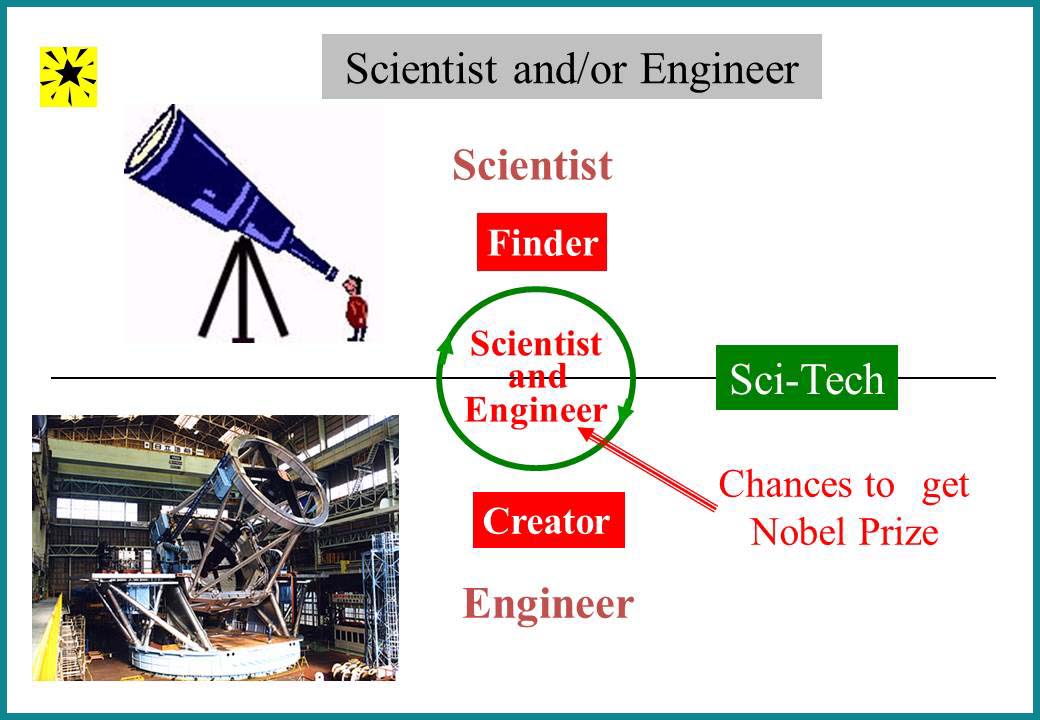
Scientists are finders who disclose new knowledge. If the knowledge concerns with nature, it must be verifiable by everybody. Isaac Newton disclosed the law of universal gravitation. Apples fall down in front of everybody. The credentials of scientists are discovery.
Engineers are creators who provide artifacts to realize people’s wishes. They work based on scientific knowledge but need ingenuity and ardor to create something new. The credentials of engineers are invention. Getting an instrument to look distant objects, telescope, had been long people’s wish. In old days telescopes were assembled by skilled craftsmen using hand polished lenses. Now, telescopes belong to most advanced optical instruments that are manufactured and assembled in modern factories.
As seen in the above picture, upper scientist and lower engineer have different mission and attributes. Nicolaus Copernicus and Galileo Galilei are scientist known as the originator of the heliocentric theory. The key that enabled the big discovery was telescope that had then so advanced as to recognize satellites of Saturn. Scientists find new knowledge with the aid of engineers. Engineers create advanced products by utilizing knowledge found by scientists. Science and technology are independent, but closely interactive. A single word "Science-technology" or "Sci-tech" is an expression to emphasize the inseparable character of science and technology.
Scientist and engineer are also independent, but a person can perform both roles side by side. If G. Galilei were gifted with the skill of lens polishing, he could have found more stars. In modern age, the highest possibility of discovery is given to the scientist who succeeded to get the instrument that has broken the past record of sensitivity.
Among recent Nobel Prize Laureates there are considerable number of engineers who made big invention like Mr. K. Tanaka of Mass-spectrometer, and Mr. H. Amano and S. Nakamura of blue-ray LED. They prove that those who feature side by side science/engineer have the largest chance to win Nobel Prize.
Cartoon Series 8: Two Sciences

The word “science” reminds usually “natural science” that searches laws out of all the phenomena in front of our eyes. Natural laws allow us to understand how everything works, and even to predict what will happen in the future. Laws are absolutely honest and betray nobody.
Let’s consider an experiment. First, prepare each a dozen of small white and black stones and mix randomly. Then, lay these stones on a hollow plate and leave in the open air. These stones will stay randomly scattered as long as they exist, even after a century or a millennium. Imagine a scene that a three-year old boy comes to the place and starts to sort the stones to black and white for fun. He accomplishes quite easily what Mother Nature has never done. Human being can change nature by means of their will.
Look at the above picture. Two astronomers were observing stars through large telescopes with the expectation to find something new. The left one cried suddenly “I found a huge supernova that nobody has ever seen. That's a Hypernova!”. The right one also cried “I found a mysterious star on which number 7 shines. That’s “Seven Star!”. (Seven Stars is a representative Japanese brand of cigarettes.)
Which finding is more attractive to you? The left finding revealed that gigantic supernova exists that is far beyond past observation. That is an extension of the past knowledge. The right finding is essentially different. Nature can’t create symbols or characters like 7. There must be highly developed living creatures on the star. They changed their star to a universe-scale advertising tower for selling cigarettes. What are the living creatures and how do they organize their society? Puzzles are endless. As the target of research, the right finding may be more revolutionary.
In contrast to natural science, social and human sciences are created by human thought and will, and they may be called “man-made science”. How is engineering science? I believe it belongs to man-made science. Nature can neither design nor control. The ability to create what nature can’t, is the true value of engineering. Engineering is not a subordinated natural science.
Cartoon Series 7: Why do you learn? - 2
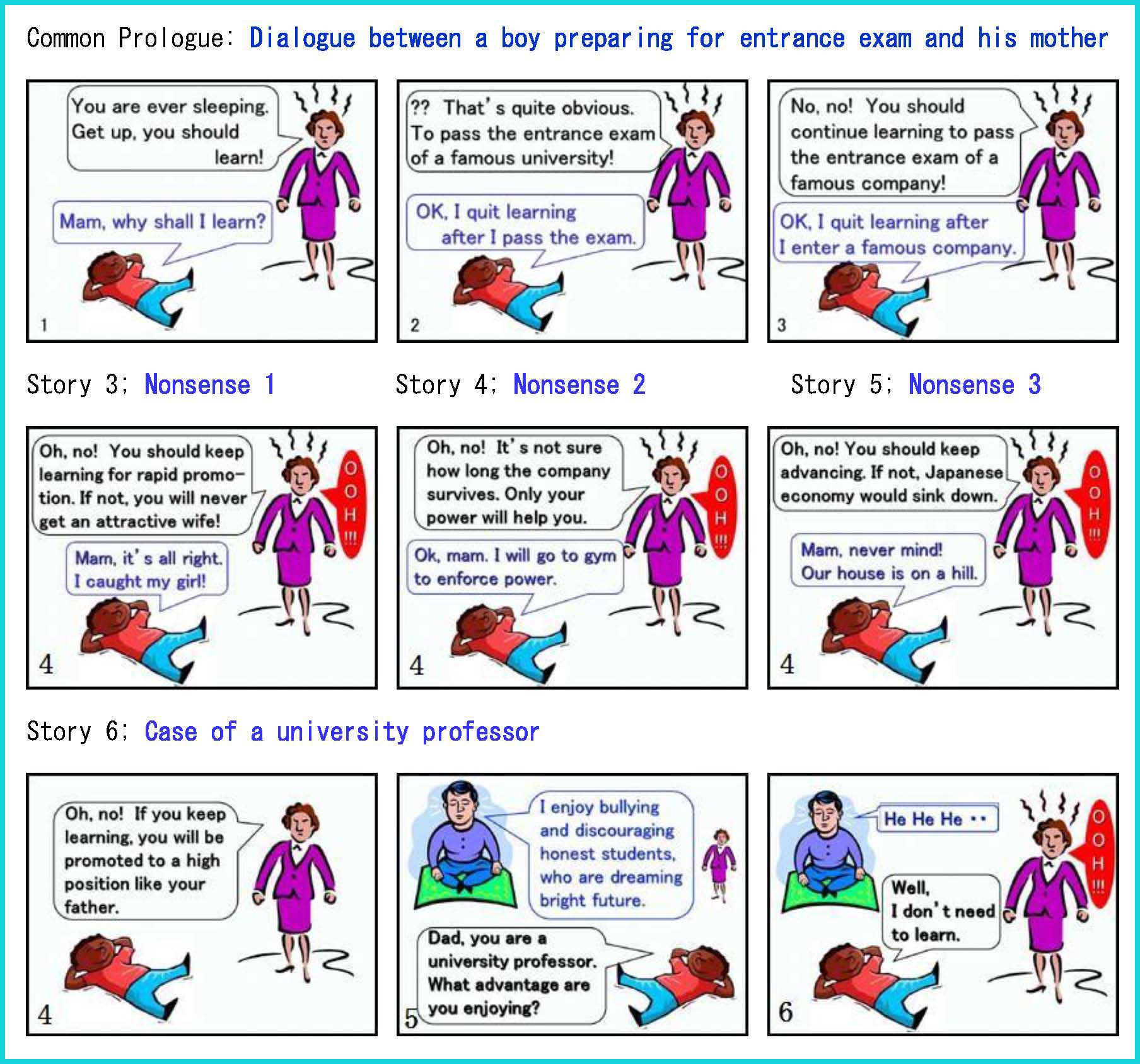
This series is the part two of the previous series 6. The first 3 frames, the common prologue, are the same as in the previous case, and succeeding stories were proposed by my colleagues. Stories 3, 4, 5 reach settlement by adding a single frame and constitute a standard 4-frame cartoon. Story 6 has additional three frames and discloses a masochistic confession of a university professor.
In cartoon series 6 and 7 we tried to answer a serious question “Why do you learn?”, but failed completely to give a direct answer. All six stories introduced resulted only in giving a nonsense laugh by out-of-focus conversation. It seems that a teacher with a negative model is more easily caricatured than an honest teacher.
In all six cartoons, only three figures, father, mother and the son collected from available clip arts, appear. It is fun to prove that everyone may create a cartoon without a taste of painting thanks to widespread digital tools.
Cartoon Series 6: Why do you learn? - 1
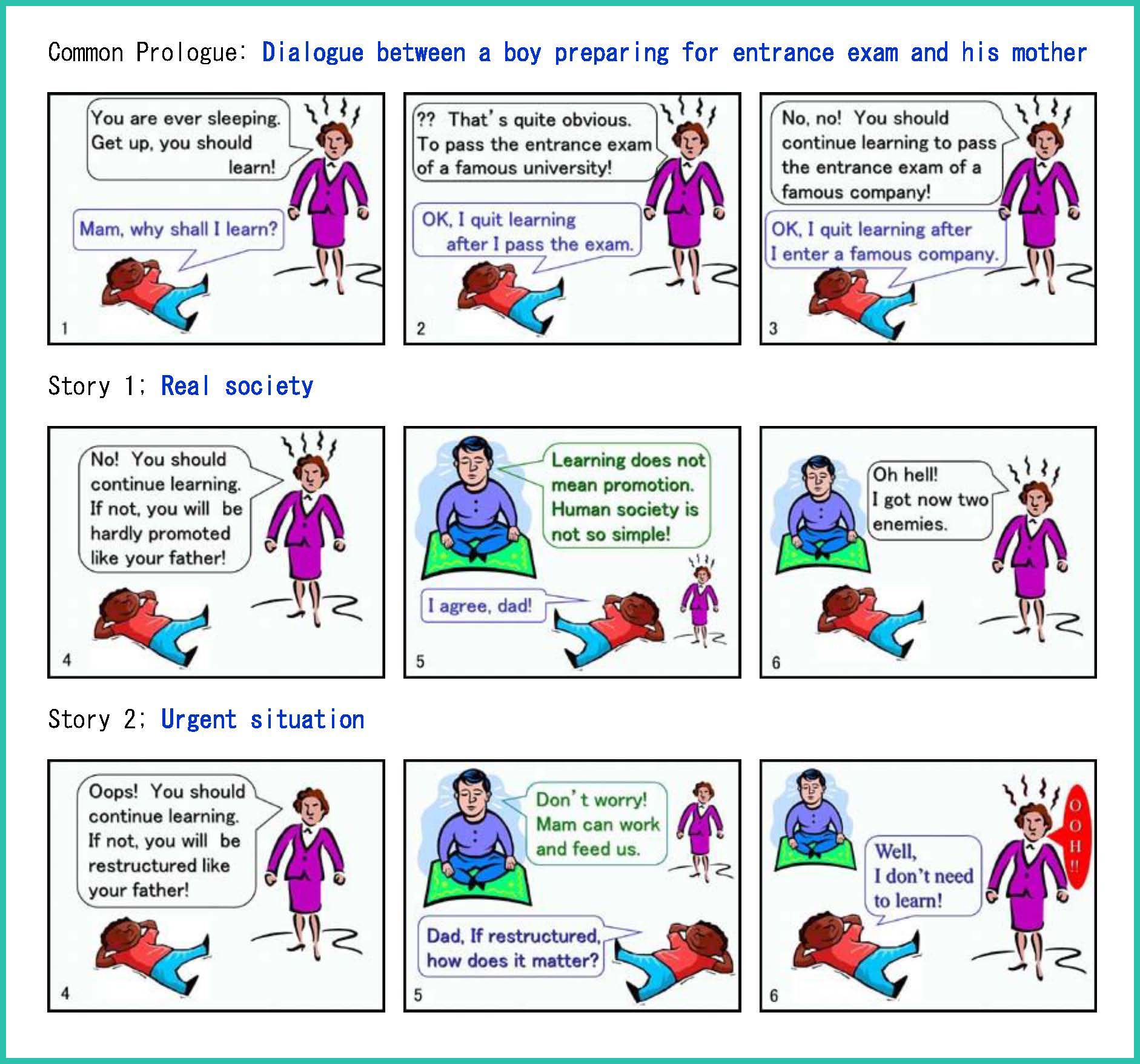
About 10 years ago I had an opportunity to talk to students of middle and high schools at the Science and Technology Forum for Juniors. Since I had been sensing crisis over the fact that new entrants to universities hardly could answer the question “Why do you learn?”, I decided to talk to juniors on the same subject. The cartoons above were prepared then to start my talk with somewhat relaxed atmosphere.
The result was miserable. During the rest between previous and my talk, more than a half of audients left seats and disappeared. To those whose minds were fully occupied by coming entrance exams to universities, the subject of my talk itself might seem to be nonsense. My talk was rather appreciated by adults who had shared the same sense of crisis with me.
The cartoons start with a common prologue of three frames that describe a scene of dialogue between a boy preparing entrance exam of a university and his worrying mother. They agree that the object of learning is to enter a famous university and then a famous company.
I asked my colleagues to succeed the story and come to an interesting settlement using frame 4 and further. Many funny and unexpected stories were proposed, but I introduce only two stories above, one by me and the other by Dr. O. All cartoons were constructed by arranging ready-made clip arts
You may follow stories by yourself. The subject “Why do you learn?” is pretty heavy to handle, though poking fun at it is rather easy. I published a book titled “Engineers in coming days” in 2005 and whole the first chapter was dedicated to this subject. I concluded in short that the object of learning is; 1) to grow to a self-sustaining individual who can think by oneself and act on own judgment. 2) to perform a reliable role in society through one’s profession. Is this sufficient?
Cartoon Series 5: From hand-drawn picture to ready-made clip art

For showing figures and tables during a presentation, slide projectors were used before OHP (Over Head Projector) came in around 1960. As personal computers became popular, Microsoft’s PowerPoint established its position as de facto standard tool for presentation. I started to use PowerPoint for presentation from the latter half of 1990’s. The change from OHP to PowerPoint was a big jump, and it meant also that preparation and storage of contents shifted from paper- to digital-base.
Cartoon, theme of the present Series, has changed correspondingly. Hand-drawn cartoons became rather rare and precious, and clip arts selected from available database became the majority, similar to the shift from order-made to ready-made suits. The above picture is a frame of PowerPoint I made and is selected to show such changeover to clip art.
In order to characterize the difference of engineering education between Japan and other countries, I once used the metaphor of grasshopper and pupa as introduced in the previous Series 4. I changed this metaphor to that of egg and chick of chicken since around 2000. New metaphor is more persuasive and also easy to find suitable pictures from clip art database.
The following explanation is attached to this metaphor. “Educators, who produce and deliver eggs before incubation, are now expected to deliver chicks that are bred to walk, to look around and to find foods by themselves. Such education is the target of JABEE.”
Educators of engineering faculties are urged to change their mind from egg producers to chick breeders.
Cartoon Series 4: Skinny grasshopper and fat pupa
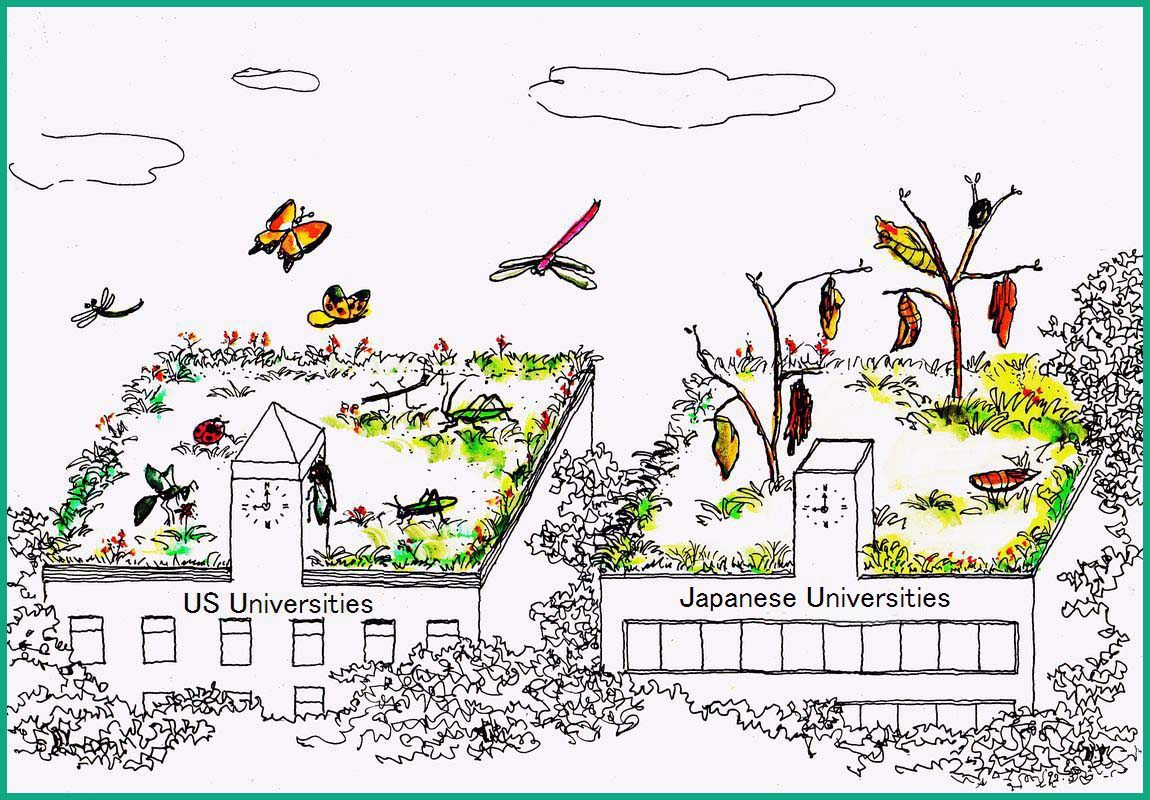
The above cartoon was introduced in the “Last Lecture” given prior to my retirement from UTokyo in 1992. Based on longtime experience as a university teacher, I intended to characterize the difference of graduates from US and Japanese universities. It was drawn by Ms. Y, an architect, following my concept design.
“Be lean Socrates than to be fat pigs” This is a famous phrase cited in the address of Commencement Ceremony by the President of UTokyo, Prof. K. Ookochi, 50 years ago. “Be fat pupa, than to emerge as skinny grasshopper, butterfly, dragonfly, etc.” The second phrase was made by me. I used to consider that Japanese universities had been adjusting themselves to yield their graduates matched to the second phrase. Who instructed this phrase? Employers of recruiting companies? Most fundamentally, that is the demand of Japan-specific Management System.
US companies recruit new graduates according to their demands how many grasshoppers, butterflies, dragonflies, etc. they need, though recruiters know well these insects are still skinny and immature. To the contrary, Japanese companies decide only number of pupas they need. Companies select principally fat pupas with the expectation that they emerge as any kind of insects after long-sighted in-house training. Japanese students know well this fact and try to appeal their soundness in job hunting. Consequently, students are not eager to deepen their specialty but try to enhance their physical and communication capability. The above cartoon characterizes the attribute of US and Japanese graduate by using metaphor of insects.
Japan-specific Management System features life-time employment and seniority-based promotion. It is understandable that the possibility for long-term development is the most appreciated at the entrance examination.
This cartoon was drawn more than 20 years ago. The globalization of business environment has progressed considerably in between. Big companies now hire quite a number of foreign students and select them by western practice. Recruiting procedure for Japanese graduates has, however, changed little since our Management System is almost intact. The change will gradually expand under the strong pressure of globalization.
Cartoon Series 3: Commuter packer and enthalpy

The third cartoon was picked up from my book "Fluid Mechanics 1" published in 1982. It was drawn by the younger sister of Mr. E, one of my former students working at National Railways as a rolling stock engineer. She was then working as illustrator in a design company.
Fluid flow in a pipe transports its mass and energy into downstream when it crosses a section of the pipe. Energy transported by a unit mass is called total enthalpy, which is defined as the sum of kinetic, potential, internal energies and also a definite energy corresponding to pv (p; pressure, v; volume). When there is no energy input or output across the pipe wall, total enthalpy is kept constant throughout the pipe in accordance with the conservation law of energy.
It is easily understandable that kinetic, potential and internal energies are transported with moving mass together. But, why does pv constitute a part of transported energy? The reason seems rather difficult for students. Energy, pv, is necessary to occupy volume v against external pressure p, and may be compared to the price to exist there.
The above cartoon describes a familiar scene observed at platform of commuter trains during rush hour. A passenger is trying to get into a jam-packed train. Since he is too powerless to occupy his space v against strong resistance p of packed passengers by himself, he must get the help of a packer or pusher. In order to cross the door opening to inside, a definite energy pv must be paid by the passenger or by the substitute, packer. This is obviously a part of transported energy. When I saw this scene, I got an inspiration "This is enthalpy made visible!"
When the door opens at the next stop, packed passengers are pushed out by internal pressure and get initial waking speed without labor. The work done for getting in is refunded as the work to accelerate the body.
In old days scenes like the cartoon were quite common in the morning of every workday at large urban stations. Commuter packers were valuable supporter to keep train schedule on time by preventing disorder. Packers occasionally changed their mission to unpackers when getting in seemed hopeless. A lot of students got part time job as packers. Today, such scenes are rather unusual, since jam-packing of commuter trains during rush hour has been considerably improved.
It is not clear whether the cartoon helped readers understand the concept of enthalpy, but it surely served to relax their brains tackling with new knowledge.
Cartoon Series 2: Mechanism of loss generation

The second cartoon of this Series is selected from my book Fluid Mechanics
2” and was drawn by the same painter as in the case of the first one.
Imagine an experiment that you stir water in a cup quickly with a stick. The water starts whirling and develops strong turbulence, but its motion gradually attenuates and finally becomes standstill after you stop stirring. The question is; where the kinetic energy of the water has gone?
If you measure the temperature of the water precisely after the experiment, you will find that the temperature has increased about by one-thousandth degree Celsius. The initial macroscopic kinetic energy of the water has been transferred to every water molecule and stored as the internal energy (heat) of water. This phenomenon is unidirectional and the reverse phenomenon, that is, water in a standstill starts moving and becomes cooler, does not occur. When this kind of irreversible phenomena occur, the entropy of the system increases inevitably.
There are a variety of fluid flows. When a part of macroscopic kinetic energy of fluids is converted to heat, it is called losses. Energy is, of course, conservative and does not disappear. Losses may be compared to energy thrown to trash box that can’t be utilized again. Themes of fluid mechanics researches are mostly associated with the object; how to decrease flow losses. Understanding of the mechanism of losses is very important.
When stirring stopped, water in the cup had a whirling turbulent flow with many vortices inside. Initial large vortices gradually split to smaller ones and transferred own energy to the descendants. This chain of vortex breakup and energy transfer continued from macroscopic to microscopic scale and finally distributed energy to each molecule as heat. This is a rough story of loss generation.
In the above cartoon, a father vortex pulls three baby vortices each in a carriage. Each carriage draws further three chains of iron balls that scratch and rub the earth’s surface. The work done by the father is transferred to babies and then to iron balls, and is all consumed by the friction of balls that merely warms the earth. The physics of turbulent flow is so complex that new findings appear still today. The analogy of loss generation expressed by the above cartoon is too much simplified and somewhat frustrating for me. However, I am quite satisfactory with the drawing that expresses the gestures of father and baby vortices vividly.
******************August, 2014*****************
Cartoon Series 1: Mechanism of viscosity
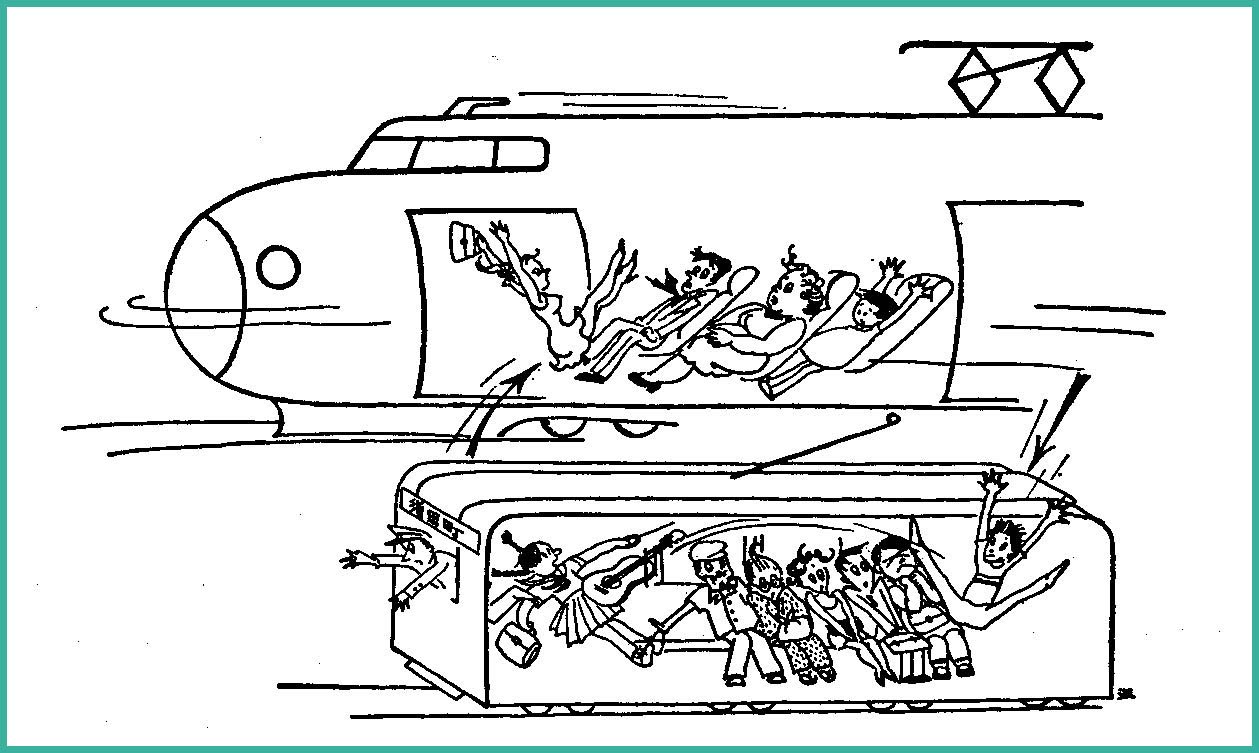
Previous themes of this page, Nostalgia Series, continued 10 times. This is the start of a new series called Cartoon Series. This series introduces cartoons or comics that appeared in books and articles that I wrote in the past.
Today’s bookstores are filled with comic books. Even in old days comics
were common in children’s books and cartoons in newspapers, except in serious
books for university students and specialists. The first book I wrote was
“Fluid Mechanics 2” published in 1969. Its target readers were students
who start learning fluid mechanics in universities. In this book I tried
to introduce cartoons to explain fluids phenomena for easy and intuitive
understanding. That was quite a unique trial at that time. The picture
shown above is one of such cartoons.
In the flow of fluids such as air and water, faster part pulls nearby slower part forward, and vice versa slower drags faster backward, thus the velocity tends to be uniform. This character is called viscosity. How viscosity takes place? The case of gas like air is chosen for explanation.
In gas, molecules are freely travelling in vacuum, and fly straight till they collide with another molecule. The mean distance between successive collisions is called mean free path. In the atmospheric air at normal temperature, the path is about 60 nm (size of flu-virus), and is as long as over 100 times of molecular diameter.
Now, consider two fluid layers that flow parallel with a distance equivalent to mean free path. The one moves faster than the other. A molecule of faster layer may fly to slower keeping its faster velocity, and vice versa slower to faster keeping slower velocity. This situation is simulated by the one in which faster and slower trains run parallel. .
In the cartoon, a boy jumps from faster train (Shin-kansen) to slower (tram) and a girl from slower to faster. The boy pushes the passengers forward and accelerates the tram, and the girl pushes backward and retards the train, thus reducing velocity difference of two trains. This is the intuitive mechanism of viscosity.
I made the concept design of this cartoon, but the drawing was made by my sister in law who was talented in sketch and drawing. A retrospective atmosphere fills the picture and it deserves to be a pioneer of this kind of scientific cartoons. She passed away long ago. But the book that contains her work is still reprinted even 45 years after the first edition.
Nostalgia Series 10: Story of passport
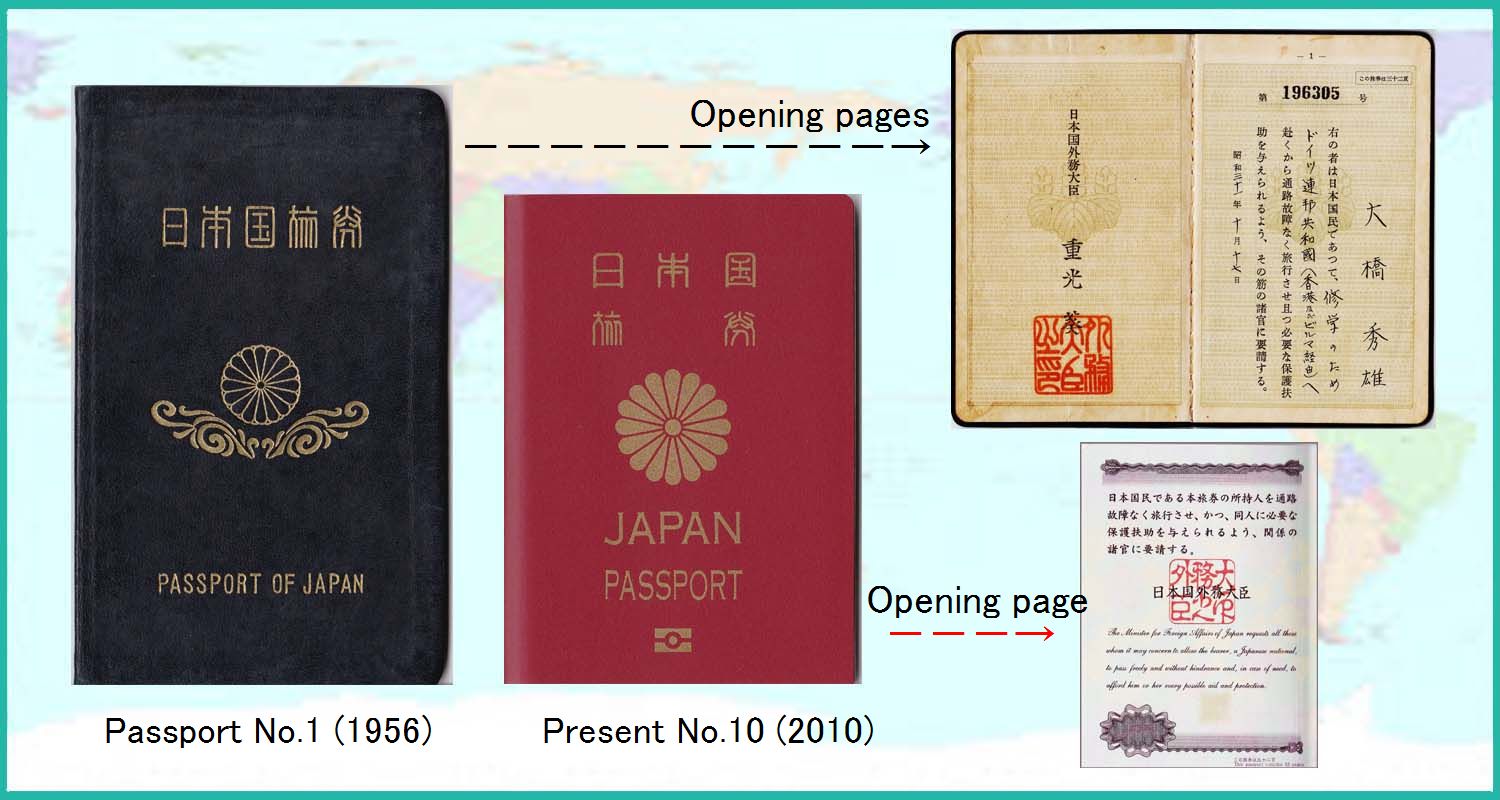
It’s getting hard to find attention-worthy topics of Nostalgia Series. This time a story of passport is picked up. The first passport of my life was issued when I went to West Germany in 1956 as a DAAD stipend. Though it's not clearly seen from the picture (upper left), the passport is covered by black leather with letters and emblem impressed by gold leaf. The cover keeps a pleasant touch feel still today. When I went to the USA in 1965, passport cover was substituted by vinyl-leather. The passport I got in 1994 was smaller in height than ever, may be for better portability. From the passport issued in 2010, IC memory tip for IT processing was inserted. Consequently it became much thicker.
In the early days, a passport expired when the holder came back home, that is, valid only for once. In 1978 I obtained the first passport with multiple re-entry permission for five years. Later the duration was expanded to 10 years. Along with the change that countries with VISA-waiver agreement have been steadily increasing, Japanese people almost forgot how the arrangement for passport and VISA was troublesome every time before a foreign trip. What shall be done before a takeoff to overseas, is only to buy an air ticket. It’s like a dream!
The inside of leather-covered passport was correspondingly very solemn. The opening two pages are shown in the upper right of the above figure. On the left page, name of the issuer, that is, Foreign Minister Mamoru SHIGEMITSU is printed with a red seal. On the right, name of the bearer, object of the trip and the country of destination are hand-written, along with Foreign Minister’s request to assure free trip and necessary support to the bearer. It is surely an order-made passport. In recent passports, Foreign Minister’s request is expressed in a single page as shown in lower right. There are no personal names of the Minister and the bearer. They are all-purpose passports.
When I open past passports and follow VISAs and stamps of departure/arrival at airports, memories of journeys come back. Among around 70 times overseas trips, 10 were accompanied by my family. Otherwise I used to a lonely traveler. Since I became a retired elderly three years ago, my passport has been waiting for the next turn in vain.
Nostalgia Series 9: Change of photograph

Historic development of photograph can be traced by observing pictures attached on past photo-albums. Around up to 1960, I find only black and white pictures in old albums. Pictures taken at my wedding ceremony in 1960 were all B&W. The first color picture in my family albums appeared two years later when the first child was borne. The new baby deserved to debut on color picture, though it was pretty expensive.
Before color pictures printed from negative color films became popular, positive color films played a very important role. Slide projector (above left) was the key player. People gathered at a party or a meeting could enjoy beautiful color pictures projected on a large screen. When I went to Germany in 1956, I started to use positive color films for recording events and sightseeing. Making slides by hand was time consuming work. I bought thin glass plates of 50x50 mm, and sandwiched a frame of 35 mm film by glass plates. After sealing the periphery of glass plates by paper tape, a slide became finally complete. As seen from the above picture (right), glass slides are very stable and durable. Later, self-adhesive cardboard frame or one-click plastic frame for easy mounting became on market. In those days slide projection party was almost a duty for travelers returned from abroad.
In 1960’s color printing was still expensive. Finished films were taken to DPE shops for development and returned with film-size color prints (contact exposure). Magnifying glass was necessary to select frames worthy of expensive enlargement. Later it became standard that films were returned with printouts of every frame regardless worthy or not worthy.
Digital camera changed the history of photograph revolutionarily. Nowadays, portable phones, smart phones, tablets, note books; they are all equipped with high performance digital cameras. The problem now is how to manage huge amount of visual information and to transfer only worthy photos to the next generation.
Nostalgia Series 8: Sentimental journey to Nordkapp
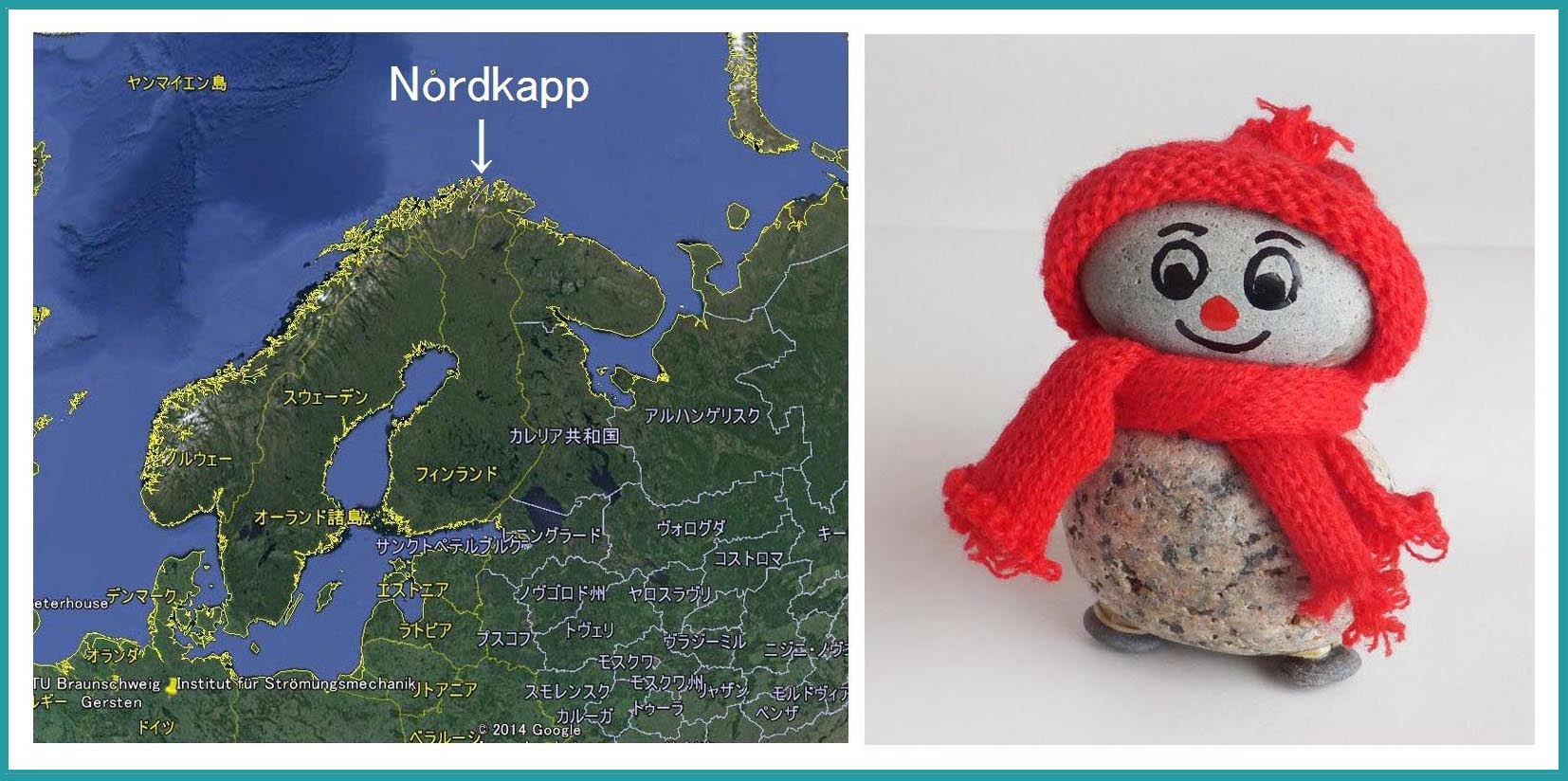
Northern, remotest, harbor, cape; they are customary words used to describe scenes of sad and lost loves in traditional Japanese ballads called Enka. Hokkaido is the most popular place to offer such scenes of Enkas. The corresponding place in Europe may be Nordkapp, a cape in a small Norwegian island located at the northernmost top of Scandinavian Peninsula. My long wish to stand on the cape was finally materialized in June, 1988, when I participated in the Conference of International Association of Hydraulic Research held in Trondheim, Norway. I could luckily join the Post-Conference Tour that included the visit to Nordkapp.
After flying by a small plane to Alta, an omnibus carried us to the island some 180 km apart northwards. The bus traced a single route through tundra of Lapland with occasional detours around small fjords. Finally the bus crossed a narrow strait by a ferry and landed on the island. The cape on the north-side cliff was our destination, Nordkapp. I kept gazing at the midnight sun on the horizon in cold wind blowing from the Arctic Ocean. Feeling of remoteness, helplessness and loneliness, my sentiment was amplified as anticipated.
The excitement of standing at the remotest spot of Europe did not last
long, since there were quite a number of visitors around with the same
wish as I had. Souvenir shops stood side by side. I bought a fist-size
doll made of two round stones collected from the seashore under the cliff.
The doll looks quite free from any worry as seen from the above picture.
I had opportunity to talk with fishermen at the harbor and was surprised
to know that they were earning quite well by selling red-skin fishes they
caught to Japan. The remotest island of Europe had a trade connection with
Japan. Everywhere of the world must have some connection to elsewhere of
the world. June is the white night season in Lapland. Fields are covered
by carpets of pretty flowers. There is no place like home. The natural
features of anyplace are associated with inherent attraction.
Nostalgia Series 7: The first home computer
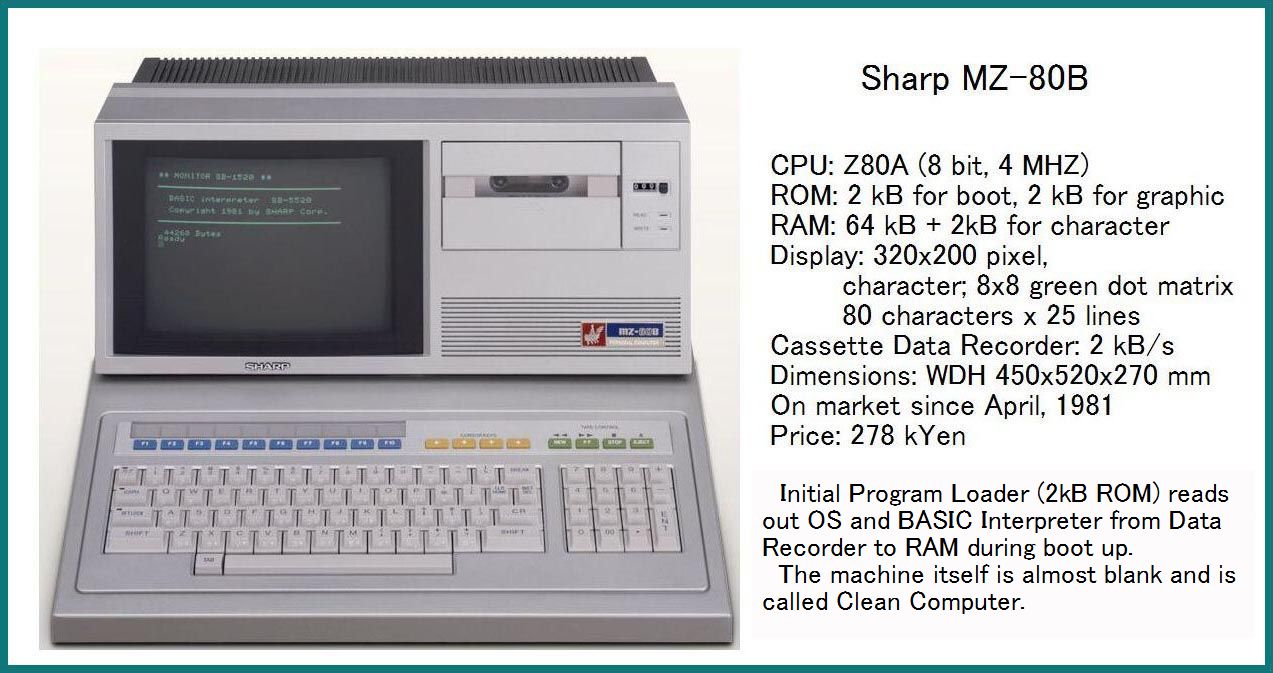
The utilization of electronic computers in universities gradually expanded since 1965 when the Uni. Tokyo established a new computing center and provided university staff with opportunities to use mainframe computers for research and education.
Electronic computers for personal use appeared in the latter half of the 1970’s. Four-bit machines were the first runner and then eight-bit machines ignited the progress of personal computers. NEC’s PC8001 (on sale since 1979), Sharp’s MZ-80B (1981), Fujitsu’s FM-7, Tandy’s TSR-80, etc. were the main competitors. I bought MZ-80B immediately after its debut and it became my first home computer. I was then fifty years old and the nostalgia to this MZ has been equivalent to the one to my first owned car, Volkswagen.
As the above picture shows, MZ featured its compactness by installing display, keyboard and cassette data recorder in a single body. That was a sales advantage over other separate type machines like PC and FM. As the above specification indicates, personal computers in those days were unbelievably simple but, on the other hand, easy to understand in every nook and corner. The standard language, BASIC, was very friendly. When the interpreter stalls due to some error, one may correct the cause and restart operation with the same parameters stored before the interruption. Remove bugs while programming; that ability was a wonderful gift to beginners. If a part of computing process was too time consuming, one may replace the part by machine languages, then the speeding up was amazing. I used my MZ mainly as word processor for writing papers in English. Because softwares like WardStar were then nonexistent, I wrote by myself and completed a program that enabled justification of lines and printing out by IBM’s Selectric Typewriter with type ball. The program took, however, hundreds of hours to complete. My lesson was “Buy a software with an established reputation. That is the best solution to improve business efficiency!”
After making the most of the MZ for three and a half years, I transferred to the second home computer, NEC’s PC-9801, a 16-bit machine that went on sale in 1982. That was a switchover from a maniac to a best-selling machine. I gave the MZ to a student from China as a gift, when he went home. How it performed in China, that was a question. Since then I have been changing home computers every three or four years and the present 64-bit machine with 8 GB memory is the 8th generation. The computing power has increased more than a million times but the price decreased to a half in the meanwhile. Besides desk-top home computers, I use lap-top computers and tablets simultaneously. As the number of computers for daily use increases, the impression to each of them becomes dilute inevitably. In that sense, my impression and memory to the MZ keeps ever fresh as those to the first lover.
Bachelor; is it a degree or a title?
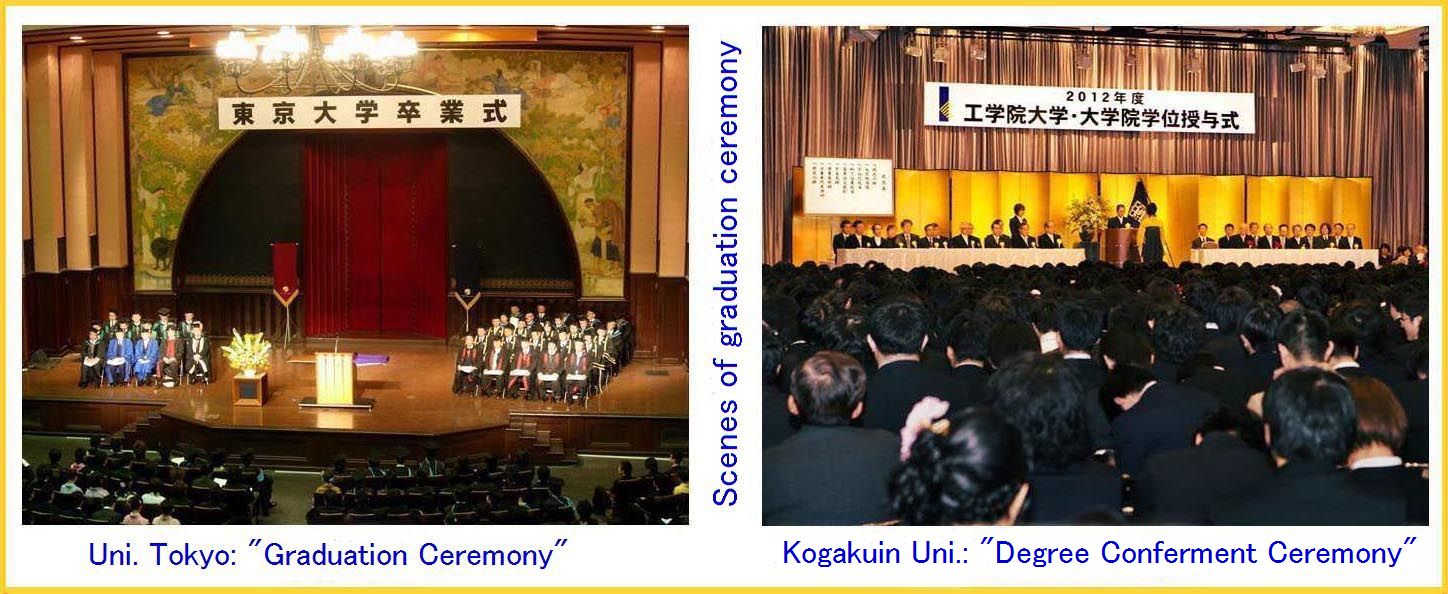
March is the season of graduation ceremonies. Immediately after the start of March, high schools send out their new graduates and then middle schools and universities follow. We witness often on streets formally dressed new graduates attending ceremonies throughout March. This custom is, however, only for Japanese. The season is February for Korean and June for Chinese.
From kindergartens to high schools, the ceremonies of graduation are called exclusively “Graduation Ceremony”. Universities and colleges are somewhat different. Ceremonies for undergraduate students are called “Graduation Ceremony” or “Degree Conferment Ceremony” half-and-half. Ceremonies for graduate students are called degree conferment ceremony everywhere.
Undergraduate students who graduate from Japanese universities and colleges are awarded “Gakushi” that corresponds to Bachelor. Is Gakushi an academic degree or a title? The answer is not straight. In the beginning period of our higher education around 1880, Gakushi was recognized as a degree. Rules for academic degrees enforced in 1887 changed this understanding and recognized only Doctor as a degree but Gakushi as a title. This situation continued over a century until 1991 when School Education Law was revised. Now Gakushi is again a degree. Traditional universities call their commencement still “graduation ceremony”, but others, welcoming new situation, call it “degree conferment ceremony”.
Those who are now over 45 years old have only a title but no degree. Don’t be discouraged, dear fellows! What has changed is only wording in laws but not the substance. Look name cards of university professors. Professor Dr. So-and-so is common but Dr. Professor is hardly to find. The title appears prior to the degree.
Nostalgia Series 6: The three sacred calculators
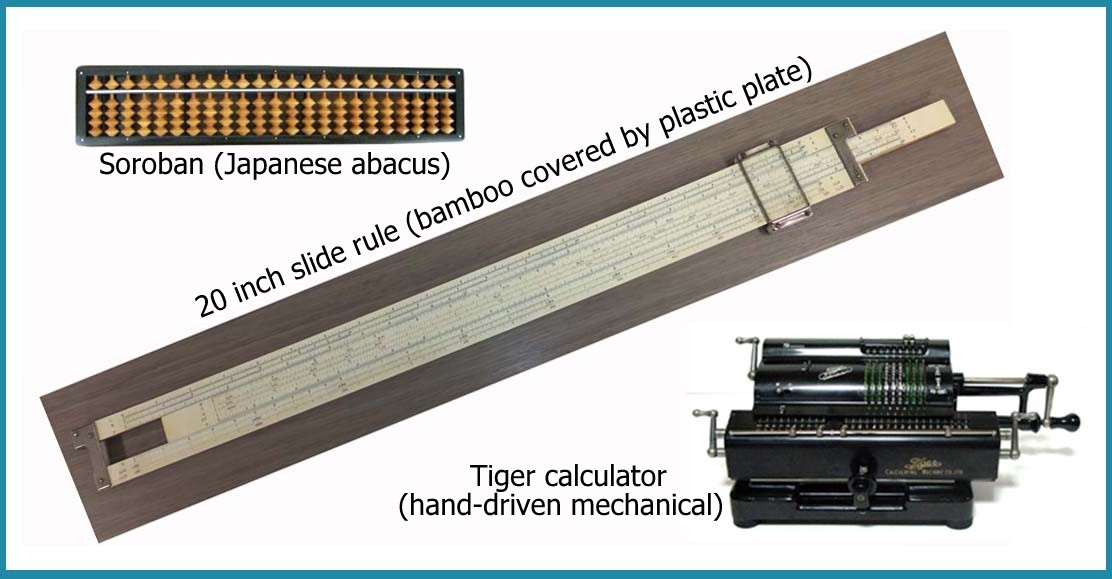
Prior to complete a sheet of design drawing, tremendous hours of calculation are required for determining shape, dimension and materials of the object. Before electric and electronic computers became commonly available, the three sacred calculators, i.e. Soroban (Japanese abacus), slide rule and hand-driven mechanical calculator, were the savior of designers. Common practice was “add and subtract” by Sorobans and “multiply and divide” by slide rules. The accuracy of slide rules is around 3 digits. For most of design purposes, the accuracy is sufficient. Only when more digits are necessary, hand-driven mechanical calculators are used. This machine is an assembly of several tens of gears and is heavy like an iron box. Tiger calculator was the leading brand in Japan.
Soroban is a universal digital counter. All four arithmetic calculations can be performed on a board, but only by skilled users. Slide rule applies the principle that multiplication means addition on logarithmic scale. Slide rule is quite a versatile device with hidden potentials. It is a pity that slide rules have been driven away by easy-handling pocket calculators.
I have a special nostalgia for Tiger calculator. When I was a university student 60 years ago, my main source of income was the part-time contract to solve simultaneous linear equations of more than ten unknown variables. I turned a borrowed Tiger calculator day after day and got pay with the rate of one Yen a minute. Several years after the end of the War, motor-driven mechanical calculators named Monroe calculator were imported from USA and penetrated gradually. The price was, however, far beyond the reach of most users. When I went to Germany and started research in 1956, I was shocked by the scene that several girls were operating noisy Monroe calculators simultaneously in a calculator room of the research institute. Both nations were defeated and destructed, but the difference was so distinct.
Usual slide rules were 10 inch long, but large 20 inch ones were used for design calculations. There were a variety of slide rules for special purposes, for example, analyses of aerial view pictures, planning of water turbines, etc. They proved their merit especially in field works.
World famous ZERO fighters and Battleship YAMAO, they were designed by slide rules. To determine optimum length and thickness of an object, 3-digits accuracy of calculation is sufficient. Numbers with superfluous digits disperse human attention and make the sense of harmony dull. In those days people ask computers to judge harmony. Humans change environment that changes humans. Nobody can stop this link of evolution.
Nostalgia Series 5: Tachometer used 60 years ago
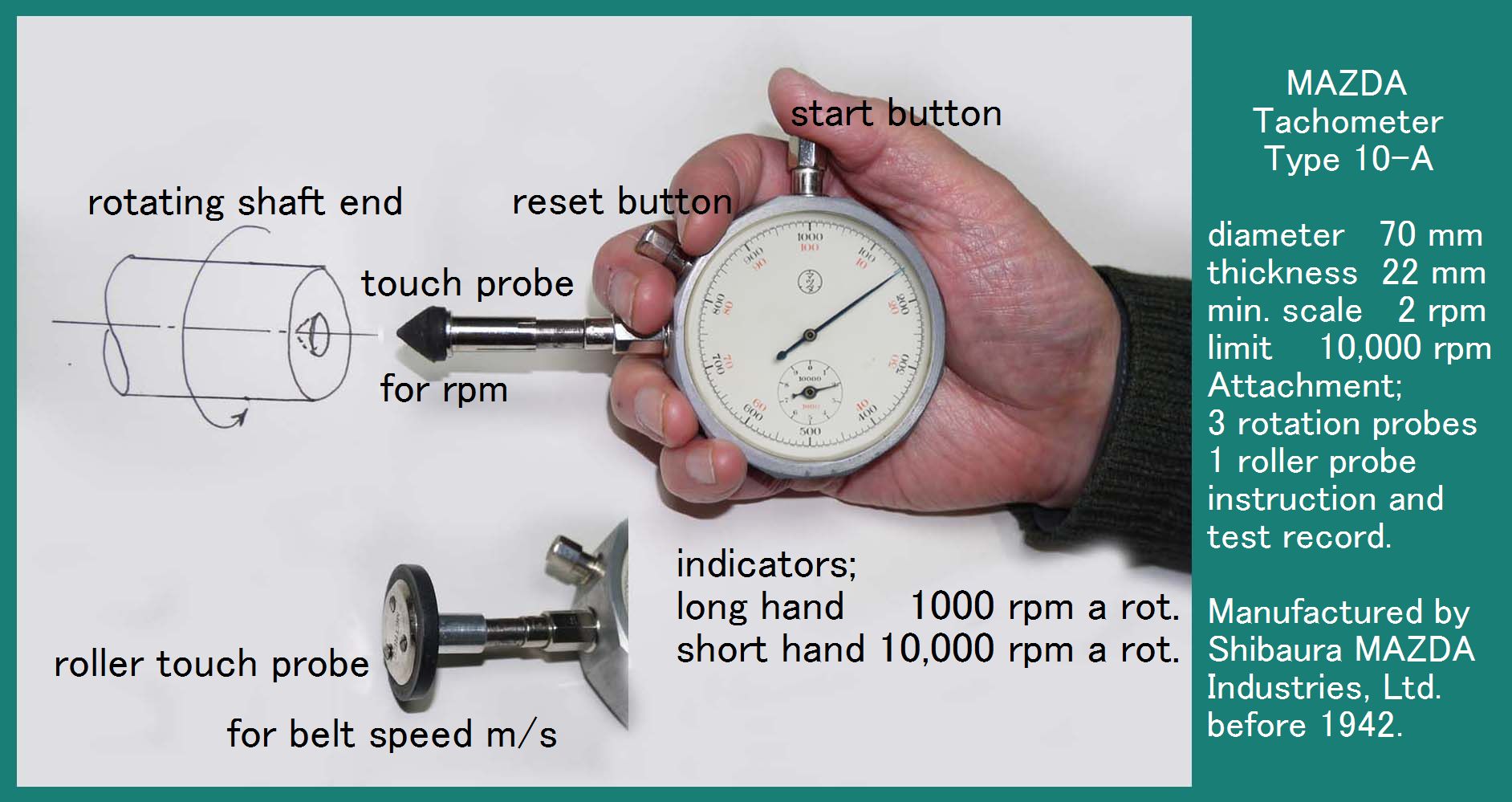
Experimental research needs various devices to measure physical properties. My research field has been turbo-machinery, that is, fluid-handling rotating machines like pumps, turbines, etc. My first engagement in this field was experimental study on the performance of a centrifugal pump carried in 1954 as graduation theses of the U-Tokyo. The study was to measure quantity of discharged water and pressure rise through the pump at various rotational speeds. Water quantity was measured by weir, pressure rise by mercury-filled glass U tube, and rotational speed by Hasler-type tachometer of MAZDA brand shown in the above figure. The hand-held tachometer was easy to use. Just press the touch probe to the center hole of rotating shaft end and click start button. After 4-5 seconds the number of rotations per minute (rpm) can be read by scales of long and short hands. The principle is quite simple. The probe shaft is connected to the long hand shaft via 1/50 reduction gear and a clutch that closes exactly for three seconds immediately after the start button is clicked. In those days this tachometer was almost a monopolistic make and widely used for motors, engines, and even for running belts to measure line speed with roller touch probe. Today electronic digital counter is used as tachometer that counts pulses generated by gear tooth attached to rotating shaft.
When I was student, electronic measuring devices were almost nonexistent and measurement meant to read scales by naked eyes. Conversion to electronic devices started around 1960 and evolved rapidly. Today's students may use their eyes only to look data printed out from computers. However, there are a lot of black boxes between physical properties and the processed output data.
When I hold this tachometer in right hand, scenes of old days play back. Similar sentiments may be felt when we encounter mechanical watches and steam locomotives.
The sun sets and rises again... A new cycle, 2014, has begun.

The first sun of 2014 rose to cloudless sky and Mount Fuji shined in the morning-red. That was the first debut of Mt. Fuji on New Year's Day after he was listed as the World Natural Heritage of UNESCO in June last year. Hopefully days as peaceful and lively as the first one continue throughout the year!
*********************December, 2013*********************Nostalgia Series 4: The first air travel

The first opportunity to fly came in October, 1956 when I left Tokyo for Braunschweig, Germany as a student on the DAAD scholarship. Most of other students chose a sea trip, but I was instructed to fly by the company I belonged, of course, for saving time. After exchanging farewell with relatives and friends gathered at Haneda Airport for the send-off, I boarded on DC-6B, a four-engine propeller machine, operated by SAS. The plane took off with tremendous engine sound high to the dark sky and started long flight via south-bound rout for Europe. Before arriving at Hamburg Airport, the plane made stopovers at Manila, Bangkok, Calcutta, Karachi, Abadan, Athens, Rome, Zurich and Dusseldorf for refueling and inspection, as seen in the above picture. The stewardesses were so kind, thick beefsteak for dinner was so delicious, views from the window were so exciting; the cabin stared as a leisure land. As time proceeded, muscle pains of the body fastened to the seat grew gradually intolerable; the cabin ended as a prison. Total flight took 48 hours. I was just waiting for the final release.
Hamburg was in cold rain. It was also in Braunschweig, where I arrived
by train next day. The tops of tall towers of churches were all hidden
in thick rain cloud. Cold wet weather, only one Japanese among 250 thousand
population of the city, doubtful communication in German, there were abundant
reasons to be depressed. However, transition to the new environment was
relatively smooth, may be, thanks to my dull sensitivity. By the way, one-way
ticket for Tokyo-Hamburg flight cost 250 thousand Yen, when the starting
salary of a university graduate was around 10 thousand a month. Overseas
travel was permitted only to officially authorized individuals half a century
ago.
Nostalgia Series 3: Comparison of German and Japanese diploma

In 1958 I received my first doctorate from the Technische Hochschule Braunschweig (presently Technische Universitaet), Germany. The title was Doktor-Ingenur that meant Doctor-class engineer. Corresponding Japanese title is Doctor of Engineering and is equivalent to Ph.D. in Engineering, a certificate of deep knowledge in a branch of science. This difference was caused by the sorrow history until 19th Century that engineering was not considered as a part of science. Technische Hochschule (Technical Colleges) were subordinated to universities where science was exclusively taught and studied. The past history leaves still traces in academic degrees in Europe.
The official diploma of German doctorate is shown on upper right of the above picture. It is printed in two colors on A4 format and looks quite ordinary. In addition to this diploma, another version in classic style may be also ordered for an extra charge. That is shown on the left of the picture. Letters are all hand written by craftsmen on a large simulated parchment, with authentic signs of the Dean and President. In German diploma, the record of examination is indicated in four grades (excellent, very good, good, satisfactory). I was lucky to obtain the highest grade, mit Auszeichnung or suma cum laude.
Japanese Dr. Engineering diploma received from the University of Tokyo in 1963 is also shown for comparison on lower right of the picture. It is written by brush with black ink on A3 format and looks decently formal. Though letters are only black, two red seals make fine contrast. There is no grading of doctorate in Japanese system.
Nostalgia Series 2: The first driver's license

In 1957 I obtained my first driver's license in Braunschweig, Germany.
I had a strong desire to drive on Autobahns before coming home. The driving
school had only a small office in downtown but no own training field. Driving
lessons were taken on public roads from the beginning. The instructor took
me to a park with scarce traffic and said “Let's drive!” The engine had
stalled several times before I got the trick of gear shift, that is, maneuvering
clutch- and accel-pedals in a coordinated way. Driving technique could
be learnt pretty quickly, but more difficult was to master traffic rules,
especially the right of way. About a month later I applied to license test.
The test was done in downtown. The examiner sat on the rear seat and ordered
to go straight or to turn. He watched the movement of my eyes through the
back sight mirror and checked whether necessary precautions for traffic
safety were taken before every action. No check was done for backward parking
or turning. Such driving skill seems to be a private preference.
German driver's license was life-time effective. License document was passport size, folded four-page formt made of cloth. (The above photo shows page 1 and 3.) As time proceeds, document becomes worn out and must be treated carefully. German license is effective also in European countries and USA. I frequently used this license when I rented a car abroad. The photo on my license was taken when I was 26 years old. It is so generous that the photo may identify the licensee even after half a century. When I applied to rewrite German license to domestic one after I came back home, I got Japanese license not only for middle-size cars but also large-size motorcycles. The dream to be a senior rider on a heavy machine is still alive.
Nostalgia Series 1: The first own car
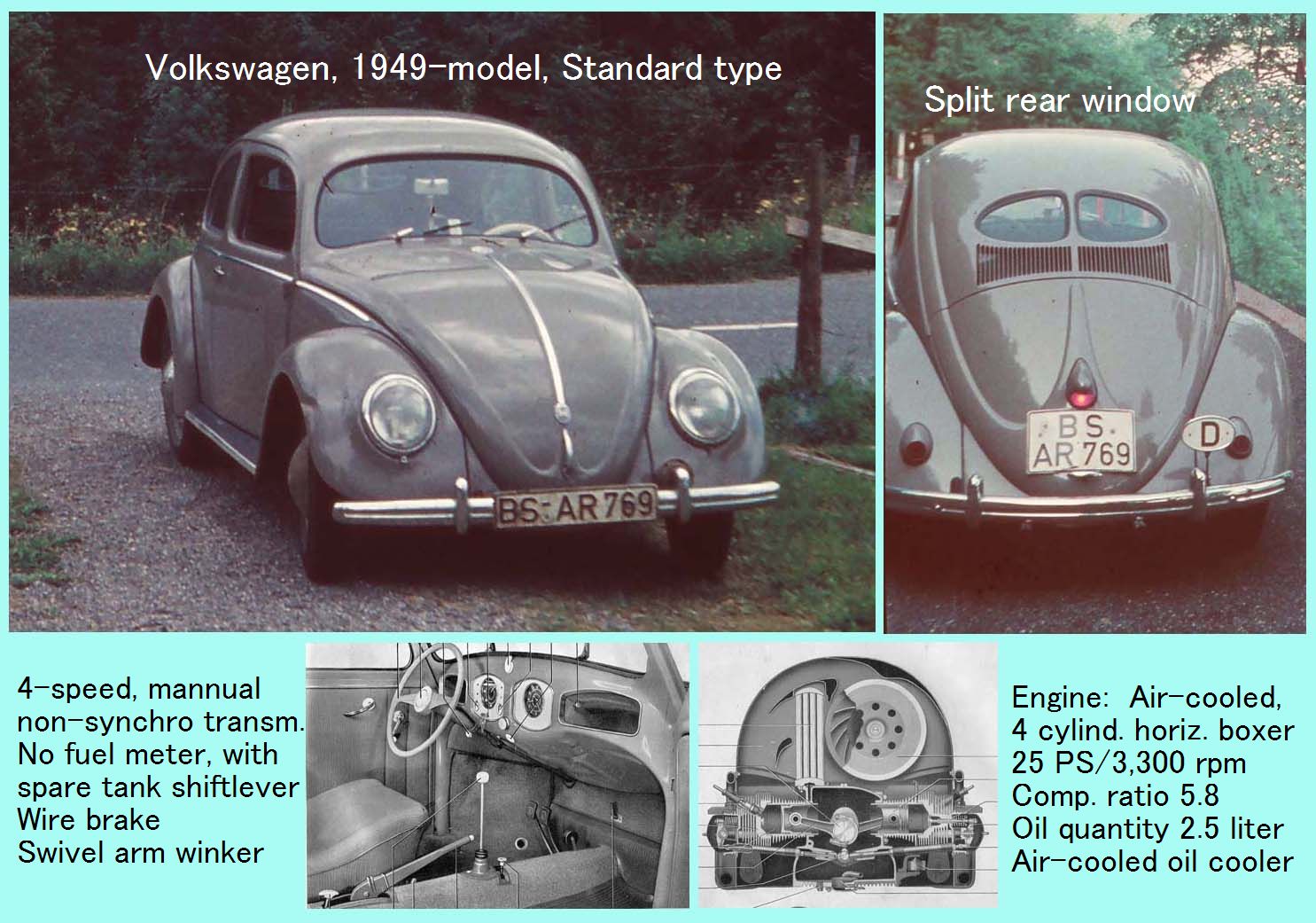
In 1957 I owned my first car just after I got driver's license in Braunschweig,
Germany. That was a used Volkswagen of 1949-model, Standard type. Wolkswagen that was originally designed by Dr. F. Porsche
and used as military car during the War, came on the world market around
1948 as the symbol of the restoration of German industries. The car I owned
was a very early year model and had been used for 8 years. Odometer indicated
40 thousand km, but nobody knew whether 140 or 240 thousand in reality.
It run without serious troubles.
Volkswagen featured air-cooled engine with R-R power train. Standard type
was equipped with the simplest mechanism; non-synchro manual transmission
and wire brake (hydraulic for Export type). Air-cooled engine was quite
reliable but enough only for 110 km/h on Autobahns with full throttle.
Maintenance; lubrication, cleanup of electric contacts, etc., was very
labor consuming.
In 9 months till returning to Japan, I drove 20 thousand km, including
in Switzerland, France and the Netherlands. Average fuel consumption was
14.9 km/liter. Bought and sold for 1550/1600 Mark. The first car is still
the source of pleasant memories of young days in Germany more than half
a Century ago. The present own car is No. 11.
Schoolgate that bridges my two Alma Maters

The main gate of Muramatsu High School, my first Alma Mater in Niigata
Pref., was built in 1903 and is now registered as National Tangible Cultural
Property. Gate posts are all stacked brick with a cornice on the top. Characteristic
is that the main posts are in English bond but side post in French (Flemish).
The gate has been demonstrating the significance of specifically two nations,
England and France.
Who decided to build this gate?
Possible answer was found when I examined the career of five first graduates
of my second Alma Mater, that is, Mechanical Engineering Department of
the University of Tokyo. Mr. S. Arakawa was one of the five. After graduating
from Imperial College of Engineering in 1878, he went to England to master
spinning technology. After returning home, he tried hard to encourage and
develop domestic spinning industries. Two leading nations in spinning technology
were then England and France. Most of spinning machines were imported from
there.
When Arakawa became the founding principal of my first Alma Mater in 1903,
he wanted to express his gratitude to two nations in a visible way. The
gate is transmitting his will still today.
This may be a roman, but I love this roman.
Cherry Blossom in Three Styles
Blooming in Masses Blooming in Loneliness
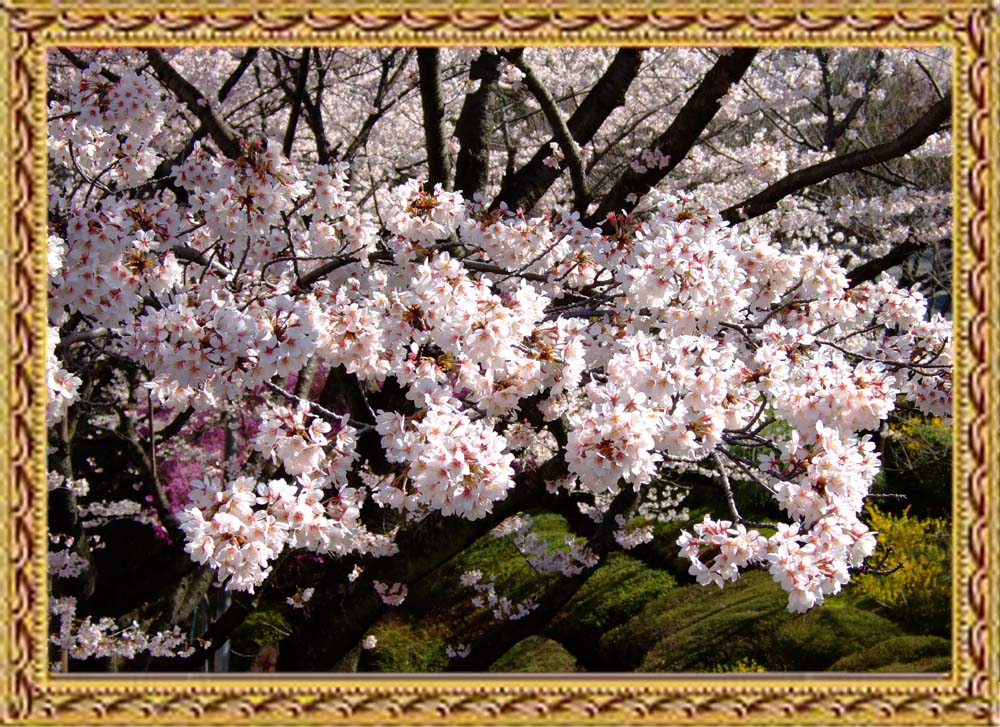
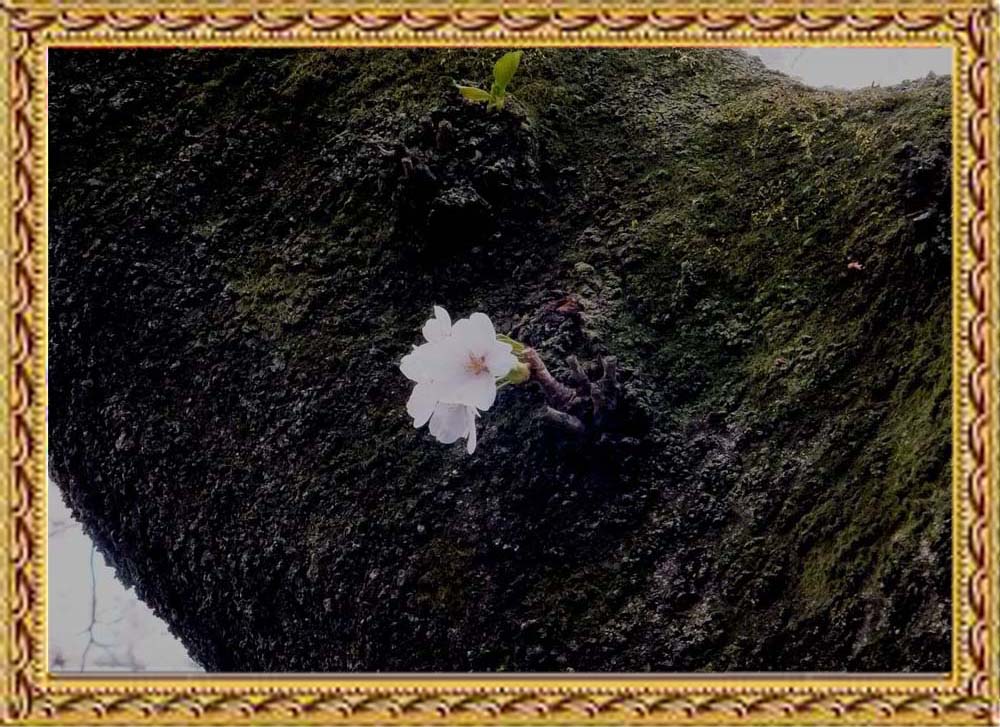
Blooming like Wild Grasses
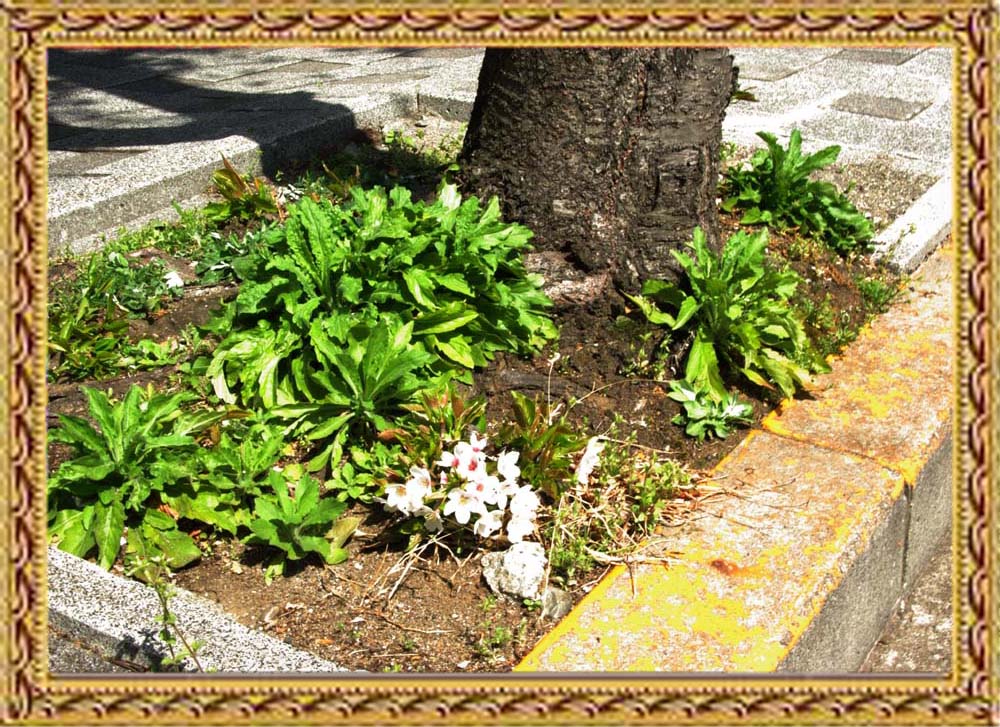
Season of cherry blossom started. The flower front proceeds northwards till it reaches northern end of Hokkaido late in May. Cherry flowers are the most gorgeous when they bloom in masses; millions of flowers on twigs and branches. However, a single flower that blooms directly on an old dark trunk or branch attracts minds of lonesome persons. Flowers that sprout out from roots creeping on ground look like wild grasses and transmit strong will to bloom.
********************Dec., 2012-March, 2013*********************West High, East Low; Typical atmospheric pressure pattern in winter
Mt. Fuji after sunrise
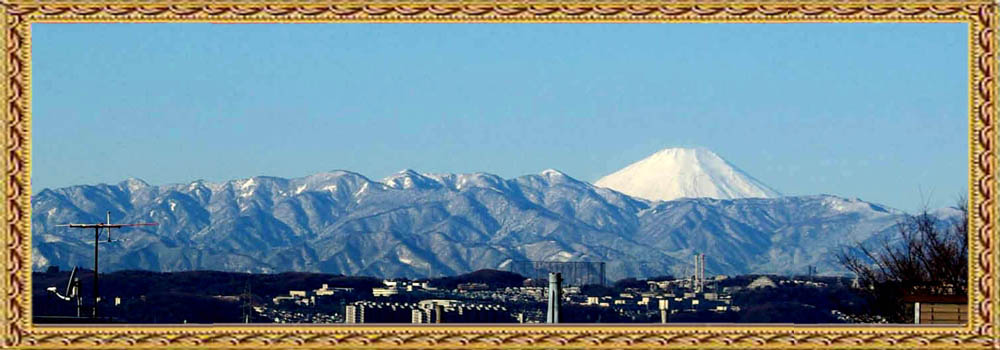
After sunset

High atmospheric pressure over Siberia (west) and low over the Pacific (east) is a typical meteorological pattern in winter, from middle December through early March. This causes continuous fine weather in Tokyo and Mt. Fuji shows his graceful figure morning and evening.
************************************************